Inbox and environment News: Issue 597
September 3 - 9, 2023: Issue 597
Trafalgar Park Newport: Playground Renewal - Feedback Invited
- completing the comment form here
- emailing council@northernbeaches.nsw.gov.au
- writing to council marked 'Playground renewal - Trafalgar Park, Newport’ to Northern Beaches Council, PO Box 82, Manly NSW 1655.
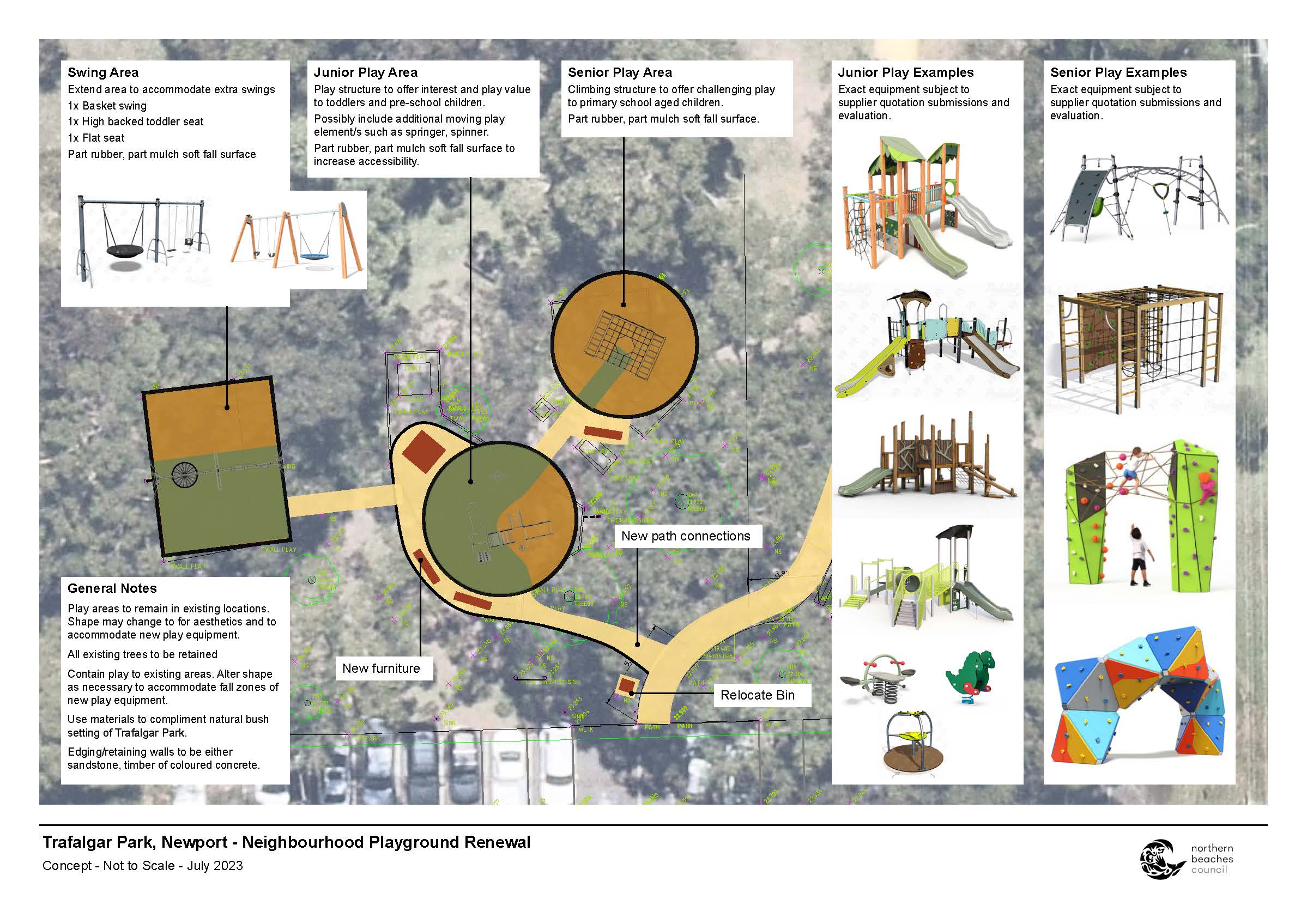
New Planting Along Careel Creek
September Is Biodiversity Month: Time To Repair, Restore, Respect Our Plants And Wildlife
- go on a Bush walk in your area,
- look out for and after our wildlife and plants
- keep a nature journal or connect with nature,
- share your observations with the iNaturalistAU community.
The Powerful Owl Project: It’s Fledging Time!
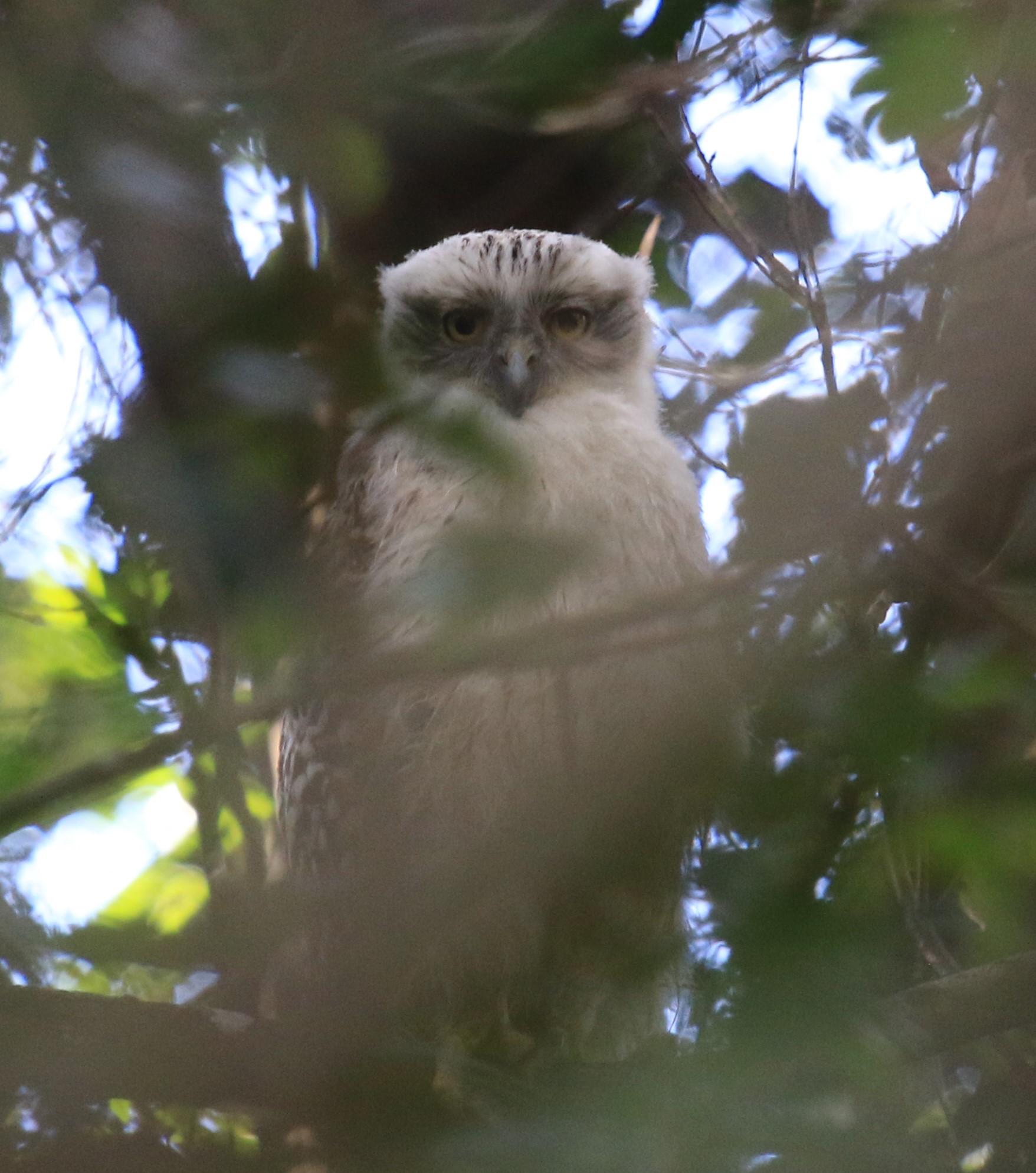
Northern Beaches Clean Up Crew: Newport Beach Clean Up - Sunday September 24
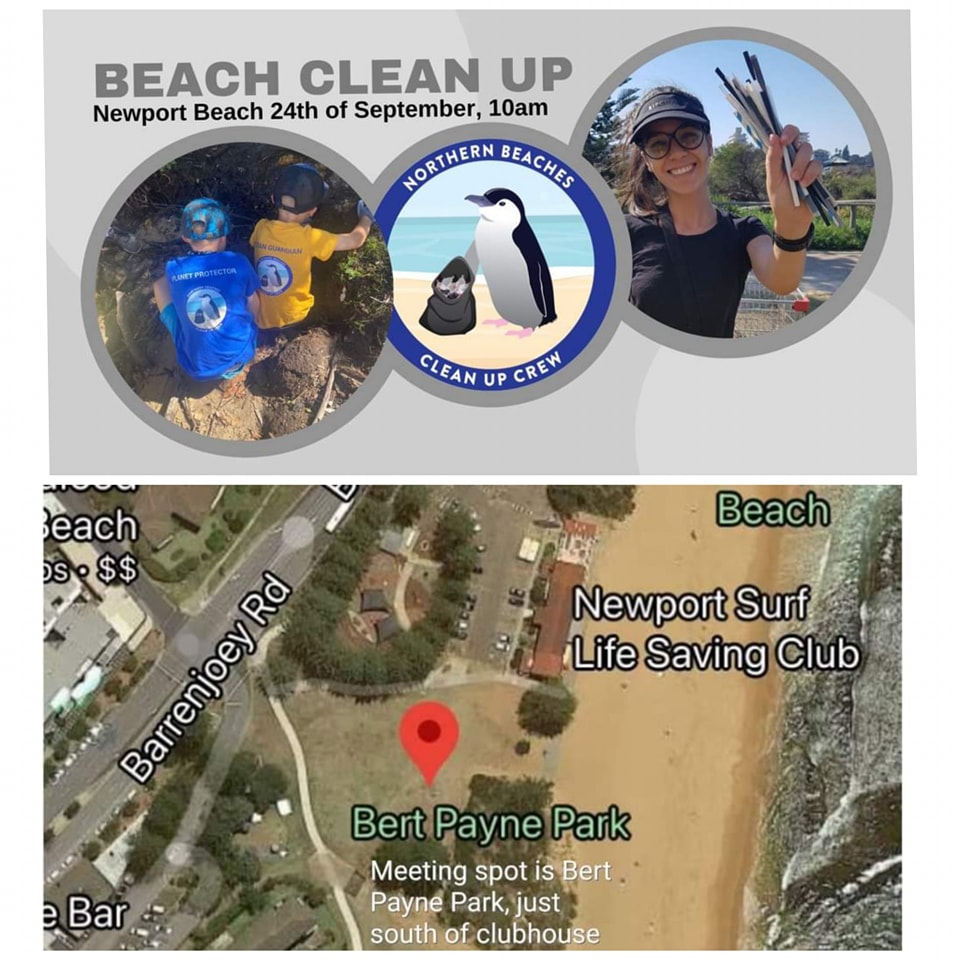
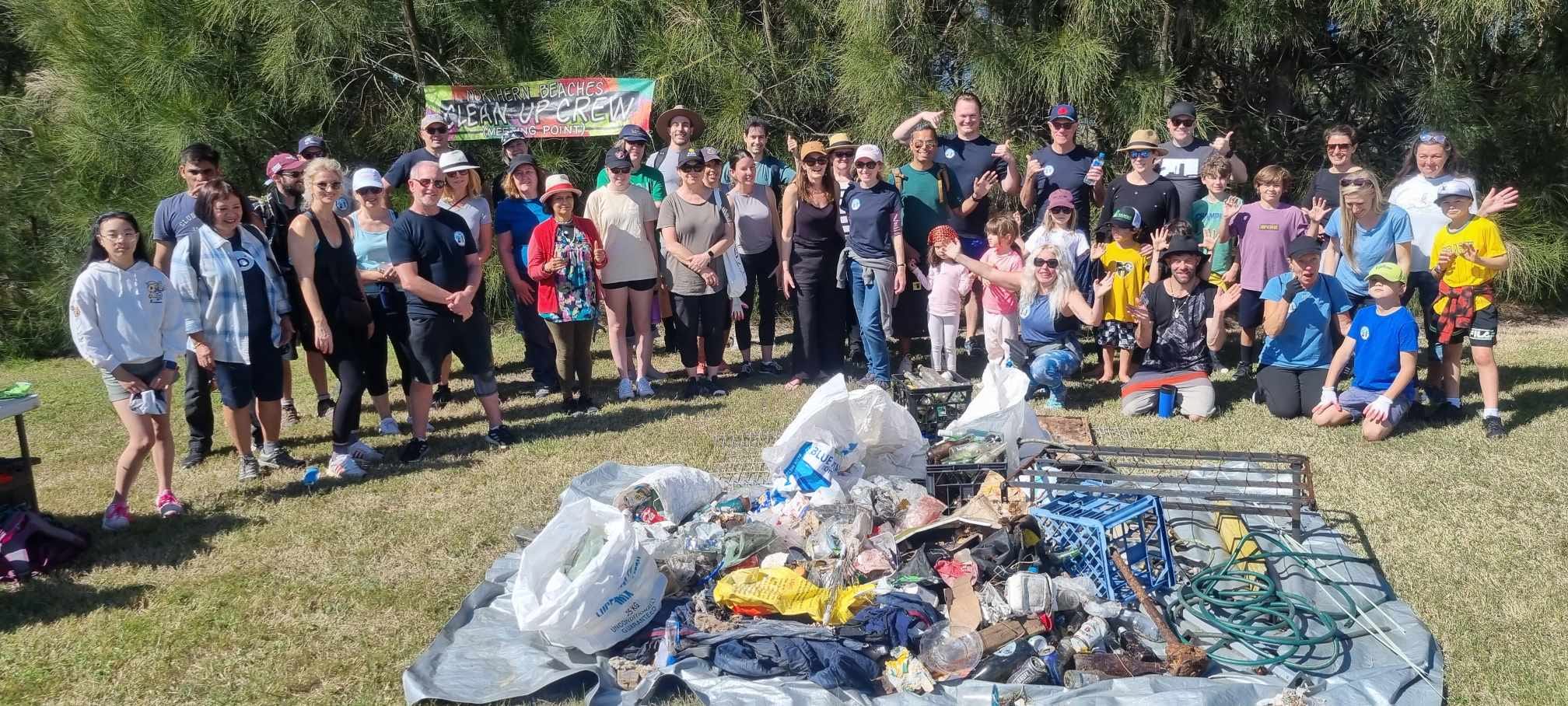
Chief Scientist Report On Mass Fish Deaths At Darling-Baaka River Near Menindee
- Explicit environmental protections in existing water management legislation are neither enforced nor reflected in current policy and operations. Water policy and operations focus largely on water volume, not water quality. This failure in policy implementation is the root cause of the decline in the river ecosystem and the consequent fish deaths.
- Low dissolved oxygen in the water column was driven by a confluence of factors, including high biomass (particularly carp and algae), poor water quality, reduced inflows and high temperature. The area around the Menindee Lakes is particularly susceptible to fish deaths events.
- Hypoxia – resulting from low dissolved oxygen in the water column - was the most likely proximate cause of fish death.
- While limited, observations and monitoring data indicated compromised water quality and potential for fish deaths prior to the March 2023 event. However, the scale of any potential event was underestimated.
- continuing our active management of flows from the Menindee Lakes to maintain dissolved oxygen at good levels for fish;
- upgrading water quality monitoring including additional remote dissolved oxygen sensors;
- exploring funding options with the Commonwealth for fish passage projects;
- improving river connectivity through actions identified in the Western Regional Water Strategy;
- updated water sharing plans and
- established an Expert Panel on connectivity in the Barwon Darling River (see below)
Video posted on FB by Graeme McCrabb, who stated; ''Unbelievable!! Menindee NSW! 17/03/2023. Nearly all native dead fish. - Bonnie Bream, Golden perch, Silver Perch, Carp but not many.
EPA Issues Stop Work Order On Forestry Operations In Tallaganda State Forest
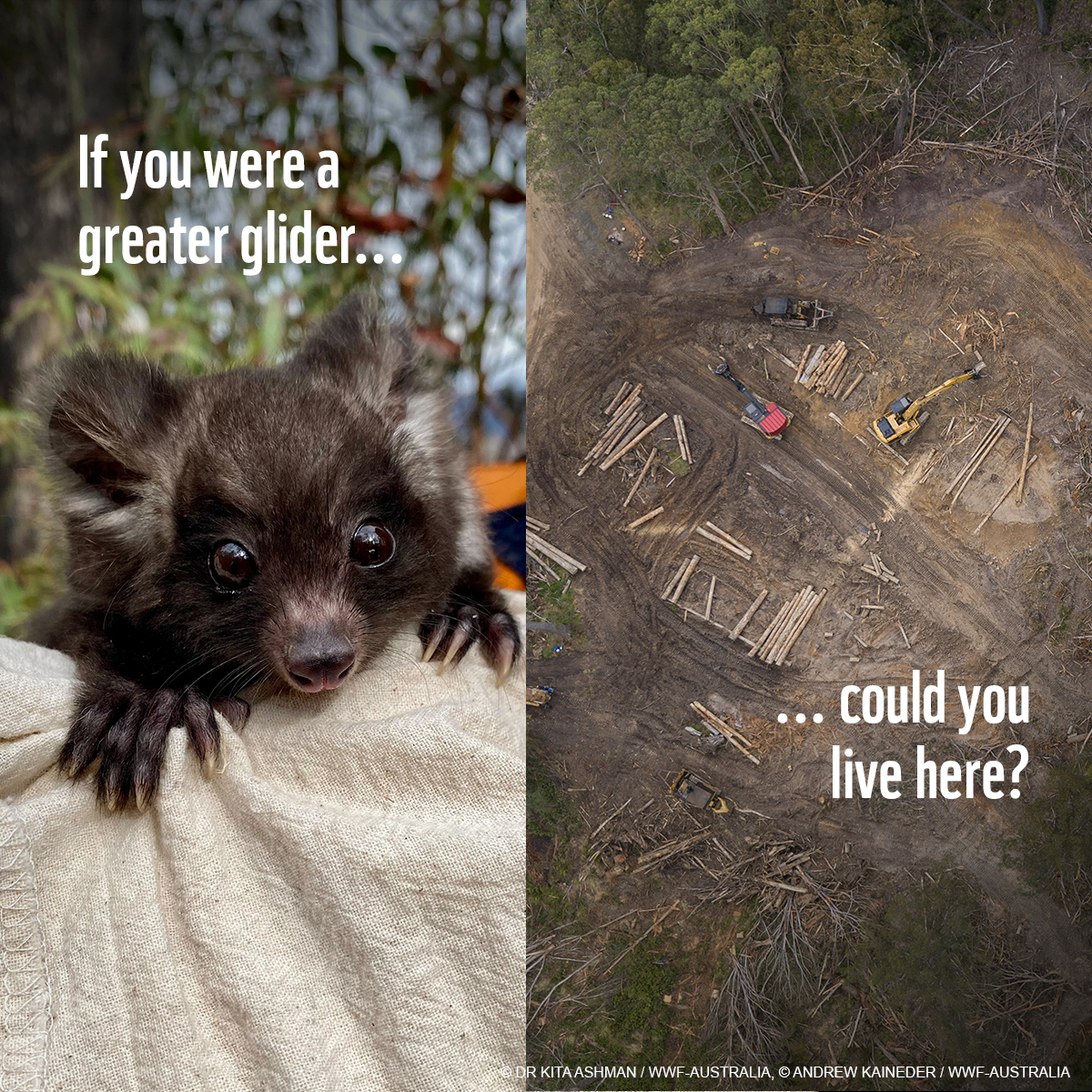
'The Environment Protection Authority has issued Forestry Corporation a Stop Work Order for forestry operations in Tallaganda State Forest.Protecting Greater Glider habitat is crucial, and Forestry Corporation has spent many months preparing for these operations through intensive pre-harvest surveys to identify and map sensitive habitat and ecological features.During the harvesting operation Forestry Corporation ensures the habitat for gliders such as hollow bearing trees and retention clumps are protected.Forestry Corporation is fully complying with the Stop Work Order and its compliance team is on site investigating.We are fully committed to investigating what has occurred and finding out what the circumstances are around the greater glider found dead in the forest.Forestry Corporation monitors Greater Glider populations in Tallaganda State Forest and has completed over 40 kilometres of spotlight transects and identified almost 400 greater gliders across the whole forest.The Greater Gliders are occupying the range of forest landscapes across Tallaganda - areas affected by the 2019-20 bushfires and the unburnt forest, plus areas of forest which are unharvested and areas which have previously been harvested for timber.'
Logging Continues Within So-Called 'Great Koala Park' - 20% To Be Destroyed Before Koala Park Even Established Under RFA's That Run Until 2048 In NSW: Local MP's Visit, Call For Ban On Logging In NSW Forests

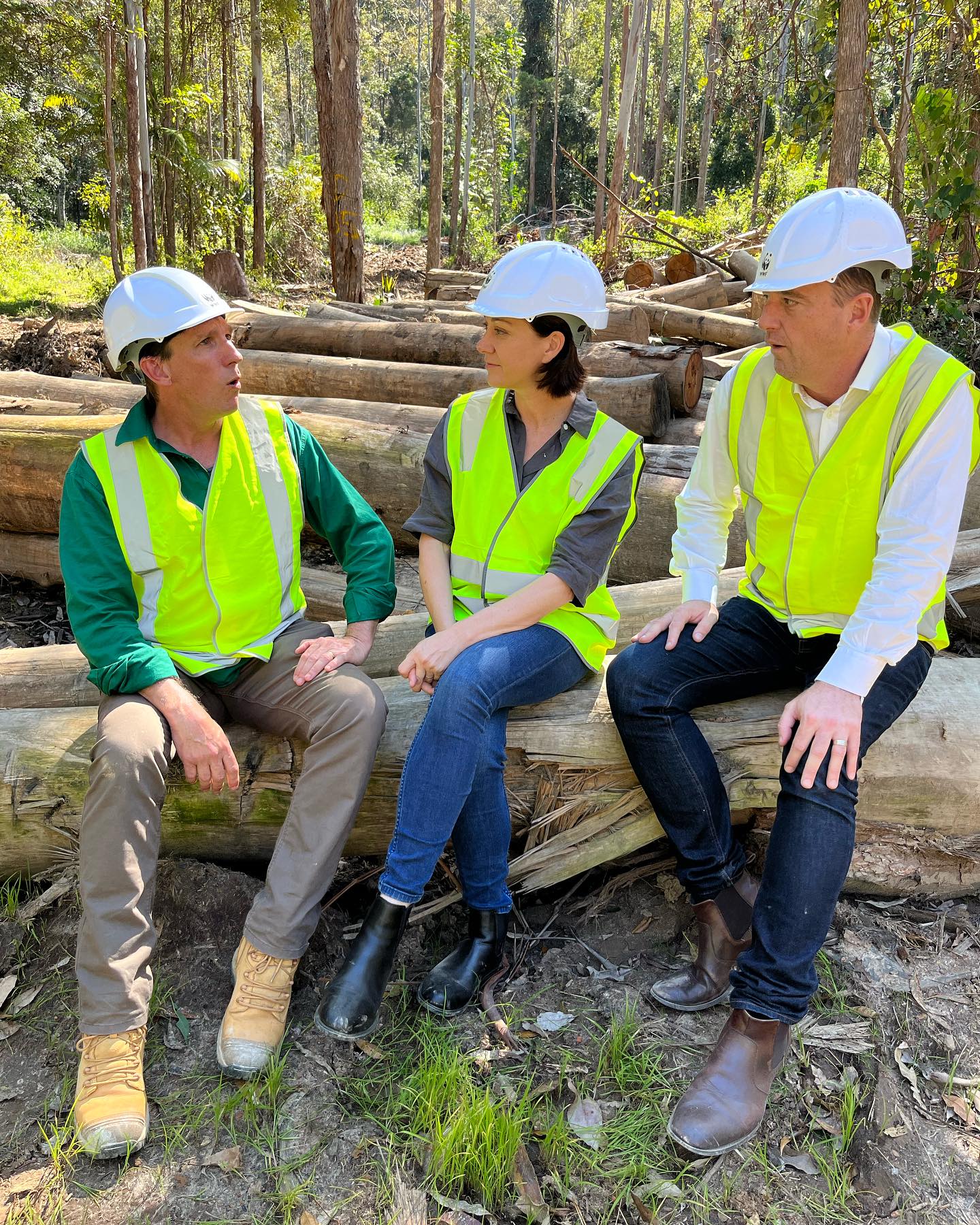
From 'Proposed multi-scale landscape approach – download the Multi Scale Approach Factsheet here' Doc.;COASTAL IFOA SCALE• Includes all public coastal forests in NSW and consists of over 5.2 million hectares.• Across this area of public forests is a patchwork of State Forests and forest protected in National Parks and State Flora Reserves.• State Forests make up around 30% of the public forests in the Coastal IFOA area. Native timber production forests cover around 16% of this area.Environmental protections include:• An established network of protected public land conserving important habitat and ecosystems across coastal NSW.• The broad landscape-based habitat protection network includes National parks, Flora Reserves and special management zones.• Annual timber volume caps are also set to ensure a long term ecologically sustainable supply of timber.• Reporting requirements apply and monitoring to evaluate and ensure environmental outcomes are being achieved.
MANAGEMENT ZONE SCALE• A defined geographic region with an average size of 50,000 hectares.• Multiple timber production forests occur within each management area.• These areas will be fixed and mapped at the commencement of the proposed IFOA.• On average 50% of the management zone of state forests is protected.Environmental protections include:• Annual limits on the amount of harvesting in each management area to distribute harvesting across the landscape.• A maximum of 10% of a management area can be harvested per year.• If the management area is zoned for intensive harvesting, then a maximum of only 5% of that management area can be intensively harvested per year
LOCAL LANDSCAPE AREA SCALE• A defined area of timber production forests no larger than 1500 hectares.• On average there are four local landscape areas in each State Forest.• These areas will be mapped out progressively over time.• An average of 38% is protected before the new wildlife habitat clump requirements are considered. This will increase to an average of 41%.Environmental protections include:• A minimum of 5% of the harvest area to be permanently protected as a wildlife habitat clump to maintain habitat diversity and connectivity.• Rainforest, high conservation value old growth, habitat corridors and owl habitat will continue to be protected.• Threatened ecological communities have been mapped and will be excluded from harvesting.• Streams are more accurately mapped and exclusion zones apply to provide landscape connectivity and protect waterways.• Distributes intensive harvesting across the landscape and over a minimum 21 year period.• Improved koala mapping to retain koala browse trees to support movement between areas and food resources.
SITE• A site is the area where harvesting is taking place. Sites vary in size from about 45 to 250 hectares.• There are many sites, called coupes or compartments, within each local landscape area.• An average of 41% of State Forests at a site scale will be protected, increasing to 45% with added tree retention clumps.
Environmental protections include:• Areas will be permanently protected to provide short term refuge, maintain forest structure, and protect important habitat features.• Additional areas no less than 5 – 8% of the harvest area will be permanently set aside as new tree retention clumps.• Hollow-bearing trees, nest and roost trees and giant trees will be permanently protected to provide ongoing shelter and food resources.• Some target surveys will be retained for unique species of plants and animals that require protection.• Sites will now be measured, mapped and monitored with mobile and desktop devices.
Visit: Proposed changes to timber harvesting in NSW's coastal forests - NSW Government; 'Once approved, the new Coastal IFOA will set the rules for how we use and harvest these forests so it’s important that you have your say.'In November 2018 the National Parks Association stated Freedom of information documents reveal damning assessment of Berejiklian government’s proposed new logging laws.''As the NSW and federal governments are poised to sign off on 20-year extensions to controversial Regional Forest Agreements, documents acquired by the North East Forest Alliance under freedom of information show deep concerns within the Office of Environment and Heritage (OEH) about the impact of new logging laws on protected old-growth, rainforest and koalas.'' NPA stated
''OEH’s concerns echo those of environment groups and illustrate clearly that the laws will destroy the natural values of our forests. Reminiscent of when Environment Minister Upton signed off on new land clearing laws despite departmental advice that 99% of koala habitat was at risk from clearing, the government is again ignoring OEH advice that koala deaths will increase and habitat quality decrease as a result of the new laws.
''Further, the documents reveal that the recommendation by the Natural Resources Commission to allow logging of forest protected as oldgrowth forest, rainforest and stream buffers for the past 20 years was contrary to the recommendations of the Expert Fauna Panel and that the Panel’s considerations of required protections were based on the erroneous assumption that all these important fauna habitats would be protected. OEH recommends many of the panel’s recommendations for threatened species need to be revisited in light of the new logging proposals..
On top of recent revelations about the deep unpopularity of native forest logging in the broader community, the National Parks Association (NPA) and North East Forest Alliance (NEFA) are calling for the government to scrap the new laws (called Integrated Forestry Operations Approvals) and chart an exit out of native forest logging.
“The documents show that a keystone of Premier Berejiklian’s draconian changes to the logging rules for public forests is that some 58,600 ha of High Conservation Value Oldgrowth and 50,600 ha of rainforest in north-east NSW may be made available for logging”, said Dailan Pugh of the North East Forest Alliance.
“These forests were protected over 20 years ago as part of NSW’s reserve system because they are the best and most intact forest remnants left on state forests. As logging intensity has increased around them their environmental importance has escalated.
“North East NSW’s forests are one of the world’s centres of biodiversity and now Premier Berejiklian wants to extend her increased logging intensity into the jewels that the community saved.”
Dr Oisín Sweeney, Senior Ecologist with the National Parks Association of NSW (NPA) said: “It’s no wonder the public is sick of native forest logging and that it has lost its social license.
“Here we have clear warnings from OEH that more koalas will die and more koala habitat will be lost. Yet the government’s determined to plough on regardless.
“It’s past time the federal government intervened to stop NSW knowingly driving koalas further towards extinction.”
________________
Extracts from NSW Office of Environment and Heritage Conservation and Regional Delivery Division North East Branch (NEB) ‘Submission to the NSW Environmental Protection Agency on the Draft Coastal Integrated Forestry Operations Approval remake’ obtained through freedom of information
The Draft Coastal IFOA appears to enable boundaries separating the CAR reserve system and the harvest area to be amended by inter‐agency agreement with no public consultation. Further, amendments to the boundaries could occur at the scale of the local landscape or even individual compartment. Areas would be assessed in isolation, rather than at a regional scale, and thereby be susceptible to the incremental ecological impact that regional assessments were originally introduced to prevent. This is expected to significantly compromise the CAR reserve system over time.…
The NEB therefore reiterates the recommendation from the Expert Fauna Panel for the ‘permanent protection of current exclusion zones’ (State of NSW and the Environmental Protection Agency 2018, p.8) and recommends that the Draft Coastal IFOA include specific provisions that protect all areas that have been protected by the FA, RFA and current IFOA over the last 20 years.
Intensive and selective harvest areas
The CAR reserve system was established in conjunction with selective logging regimes that maintained structurally diverse forest throughout the harvest area. The Draft Coastal IFOA appears to increase the area of public forests on the north coast that would be legally available for intensive harvest, with the risk that large areas of forest will be reduced to a uniform young age class that would take many decades for full ecological function to be restored.
In the intensive harvesting zone (the Coastal Blackbutt forests of the north coast hinterland), the Draft Coastal IFOA proposes to allow coupes of up to 45 ha to be logged with no lower limits on the number of trees retained in the harvest area.
…
This proposed minimum basal area retention of trees in the harvest areas is below the minimum threshold required to maintain habitat values advised by the majority of the Expert Fauna Panel.
The Draft Coastal IFOA proposes removing the existing requirement to protect habitat ‘recruitment trees’. Over time, this will reduce the number of large habitat trees retained for ecological purposes in harvest areas, as trees die and are not replaced. Recruitment trees identified previously will now be available for harvesting, further reducing the persistent availability of larger trees as a critical habitat element for threatened and protected fauna.
High Conservation Value (HCV) Old Growth
HCV old growth was identified for protection as part of the CAR reserve in 1998. It was comprised of older forest (mapped as ‘candidate’ old growth) that also scored highly for irreplaceability (a measure of significance to biodiversity conservation) and threatened species habitat value. Under the Draft Coastal IFOA, biodiversity values of harvest area will be reduced as the area becomes progressively younger (potentially 21 years old or less). For threatened species, this places greater significance on adequately protecting existing HCV old growth areas.…
The NEB recommends that areas of HCV old growth that have been protected for at least 20 years (NRC 2018) are not made available for logging. This will minimise impacts on threatened species.
Rainforest
The concerns raised above in relation to the treatment of old growth under the Draft Coastal IFOA also apply to protected rainforest. Combined, HCV old growth and rainforest form the cornerstone of the CAR reserve system on State forest. Adequate retention of these vegetation types is considered particularly critical in the context of proposed increased logging intensities.
Specific threatened species conditions
Identifying the species that required species‐specific conditions was a major task for the Expert Fauna Panel. However, the Panel’s deliberations occurred prior to the proposals to allow logging access to HCV old growth and rainforest (NRC 2018). Therefore, many of the panel’s recommendations need to be revisited in light of the new logging proposals. For example, some of the old growth dependent species (such as those that require hollows) were considered not to require species‐specific conditions because the existing HCV old growth was protected. Similarly, for many rainforest‐dependent species, and those dependent upon riparian habitats, species‐specific conditions were not proposed on the assumption that the habitat of these species was considered sufficiently protected.
Koala protection
There appears to be a reduction in protections offered to koalas under the Draft Coastal IFOA. Koalas are selective both in their choice of food tree species and in their choice of individual trees. The scientific basis for proposed tree retention rates in the Draft Coastal IFOA is not clear, and the rates are less than half those originally proposed by the Expert Fauna Panel.
While Koalas will use small trees, research has shown that they selectively prefer larger trees. In our experience, the proposed minimum tree retention size of 20cm dbh will be inadequate to support koala populations and should be increased to a minimum of 30cm dbh. Many Koala food trees are also desired timber species, so there is a high likelihood that larger trees will be favoured for harvesting, leaving small retained trees subject to the elevated mortality rates experienced in exposed, intensively‐logged coupes.
Koalas require large areas of connected habitat for long‐term viability. The increased logging intensity proposed under the draft Coastal IFOA is expected to impact Koalas through diminished feed and shelter tree resources. Animals will need to spend more time traversing the ground as they move between suitable trees that remain, which is likely to increase koala mortality.
At the same time this video was released:
''As the NSW and federal governments are poised to sign off on 20-year extensions to controversial Regional Forest Agreements, documents acquired by the North East Forest Alliance under freedom of information show deep concerns within the Office of Environment and Heritage (OEH) about the impact of new logging laws on protected old-growth, rainforest and koalas.'' NPA stated
''OEH’s concerns echo those of environment groups and illustrate clearly that the laws will destroy the natural values of our forests. Reminiscent of when Environment Minister Upton signed off on new land clearing laws despite departmental advice that 99% of koala habitat was at risk from clearing, the government is again ignoring OEH advice that koala deaths will increase and habitat quality decrease as a result of the new laws.
''Further, the documents reveal that the recommendation by the Natural Resources Commission to allow logging of forest protected as oldgrowth forest, rainforest and stream buffers for the past 20 years was contrary to the recommendations of the Expert Fauna Panel and that the Panel’s considerations of required protections were based on the erroneous assumption that all these important fauna habitats would be protected. OEH recommends many of the panel’s recommendations for threatened species need to be revisited in light of the new logging proposals..
On top of recent revelations about the deep unpopularity of native forest logging in the broader community, the National Parks Association (NPA) and North East Forest Alliance (NEFA) are calling for the government to scrap the new laws (called Integrated Forestry Operations Approvals) and chart an exit out of native forest logging.
“The documents show that a keystone of Premier Berejiklian’s draconian changes to the logging rules for public forests is that some 58,600 ha of High Conservation Value Oldgrowth and 50,600 ha of rainforest in north-east NSW may be made available for logging”, said Dailan Pugh of the North East Forest Alliance.
“These forests were protected over 20 years ago as part of NSW’s reserve system because they are the best and most intact forest remnants left on state forests. As logging intensity has increased around them their environmental importance has escalated.
“North East NSW’s forests are one of the world’s centres of biodiversity and now Premier Berejiklian wants to extend her increased logging intensity into the jewels that the community saved.”
Dr Oisín Sweeney, Senior Ecologist with the National Parks Association of NSW (NPA) said: “It’s no wonder the public is sick of native forest logging and that it has lost its social license.
“Here we have clear warnings from OEH that more koalas will die and more koala habitat will be lost. Yet the government’s determined to plough on regardless.
“It’s past time the federal government intervened to stop NSW knowingly driving koalas further towards extinction.”
________________
Extracts from NSW Office of Environment and Heritage Conservation and Regional Delivery Division North East Branch (NEB) ‘Submission to the NSW Environmental Protection Agency on the Draft Coastal Integrated Forestry Operations Approval remake’ obtained through freedom of information
The Draft Coastal IFOA appears to enable boundaries separating the CAR reserve system and the harvest area to be amended by inter‐agency agreement with no public consultation. Further, amendments to the boundaries could occur at the scale of the local landscape or even individual compartment. Areas would be assessed in isolation, rather than at a regional scale, and thereby be susceptible to the incremental ecological impact that regional assessments were originally introduced to prevent. This is expected to significantly compromise the CAR reserve system over time.…
The NEB therefore reiterates the recommendation from the Expert Fauna Panel for the ‘permanent protection of current exclusion zones’ (State of NSW and the Environmental Protection Agency 2018, p.8) and recommends that the Draft Coastal IFOA include specific provisions that protect all areas that have been protected by the FA, RFA and current IFOA over the last 20 years.
Intensive and selective harvest areas
The CAR reserve system was established in conjunction with selective logging regimes that maintained structurally diverse forest throughout the harvest area. The Draft Coastal IFOA appears to increase the area of public forests on the north coast that would be legally available for intensive harvest, with the risk that large areas of forest will be reduced to a uniform young age class that would take many decades for full ecological function to be restored.
In the intensive harvesting zone (the Coastal Blackbutt forests of the north coast hinterland), the Draft Coastal IFOA proposes to allow coupes of up to 45 ha to be logged with no lower limits on the number of trees retained in the harvest area.
…
This proposed minimum basal area retention of trees in the harvest areas is below the minimum threshold required to maintain habitat values advised by the majority of the Expert Fauna Panel.
The Draft Coastal IFOA proposes removing the existing requirement to protect habitat ‘recruitment trees’. Over time, this will reduce the number of large habitat trees retained for ecological purposes in harvest areas, as trees die and are not replaced. Recruitment trees identified previously will now be available for harvesting, further reducing the persistent availability of larger trees as a critical habitat element for threatened and protected fauna.
High Conservation Value (HCV) Old Growth
HCV old growth was identified for protection as part of the CAR reserve in 1998. It was comprised of older forest (mapped as ‘candidate’ old growth) that also scored highly for irreplaceability (a measure of significance to biodiversity conservation) and threatened species habitat value. Under the Draft Coastal IFOA, biodiversity values of harvest area will be reduced as the area becomes progressively younger (potentially 21 years old or less). For threatened species, this places greater significance on adequately protecting existing HCV old growth areas.…
The NEB recommends that areas of HCV old growth that have been protected for at least 20 years (NRC 2018) are not made available for logging. This will minimise impacts on threatened species.
Rainforest
The concerns raised above in relation to the treatment of old growth under the Draft Coastal IFOA also apply to protected rainforest. Combined, HCV old growth and rainforest form the cornerstone of the CAR reserve system on State forest. Adequate retention of these vegetation types is considered particularly critical in the context of proposed increased logging intensities.
Specific threatened species conditions
Identifying the species that required species‐specific conditions was a major task for the Expert Fauna Panel. However, the Panel’s deliberations occurred prior to the proposals to allow logging access to HCV old growth and rainforest (NRC 2018). Therefore, many of the panel’s recommendations need to be revisited in light of the new logging proposals. For example, some of the old growth dependent species (such as those that require hollows) were considered not to require species‐specific conditions because the existing HCV old growth was protected. Similarly, for many rainforest‐dependent species, and those dependent upon riparian habitats, species‐specific conditions were not proposed on the assumption that the habitat of these species was considered sufficiently protected.
Koala protection
There appears to be a reduction in protections offered to koalas under the Draft Coastal IFOA. Koalas are selective both in their choice of food tree species and in their choice of individual trees. The scientific basis for proposed tree retention rates in the Draft Coastal IFOA is not clear, and the rates are less than half those originally proposed by the Expert Fauna Panel.
While Koalas will use small trees, research has shown that they selectively prefer larger trees. In our experience, the proposed minimum tree retention size of 20cm dbh will be inadequate to support koala populations and should be increased to a minimum of 30cm dbh. Many Koala food trees are also desired timber species, so there is a high likelihood that larger trees will be favoured for harvesting, leaving small retained trees subject to the elevated mortality rates experienced in exposed, intensively‐logged coupes.
Koalas require large areas of connected habitat for long‐term viability. The increased logging intensity proposed under the draft Coastal IFOA is expected to impact Koalas through diminished feed and shelter tree resources. Animals will need to spend more time traversing the ground as they move between suitable trees that remain, which is likely to increase koala mortality.
At the same time this video was released:
These Two Koalas Lost Their Mothers To Deforestation
The 20 year extension was approved months before the July 2019 bushfires which, by January 2020, had consumed thousands of hectares of bushland and killed an estimated 2 billion native animals.
The licence to persist in logging habitat, until 2048, is now viewed as a licence for extinction.
However the new and current State Government has already signalled it has no intention of making any changes to logging practices in the state.
Forestry Corporation NSW plans show that over the next 12 months it intends to log 30,813 hectares of a total 175,000 hectares of state forests that fall within the boundaries of the proposed Great Koala National Park, home to one in five of the state’s surviving koalas.
This would include areas identified by the government as the most important koala habitat in the state at Wild Cattle Creek, Clouds Creek, Pine Creek and in the Boambee State Forests.
“[Forestry Corporation NSW] knows this national park is coming, and they are deliberately ramping up operations within its boundaries to extract as much timber from it as possible,” NSW Nature Conservation Council chief executive Jacqui Mumford said earlier this year.
“The NSW government committed to protecting koalas by creating the [Great Koala National Park], but before the assessment process even begins, Forestry Corporation plans to log nearly 20 per cent of the park.”
The calls for a moratorium on logging by the state-owned enterprise come as Victoria announced it will bring forward an end to all logging in its state forests to 2024 from 2030, bringing that state into line with Western Australia.
“Victoria and Western Australia are now both ending native forest logging by 2024, while Queensland is stopping logging south of Noosa by next year. NSW is now the laggard in this space, and it’s time for the NSW government to step up,” Mumford said.
Both major parties in NSW have long resisted calls to end logging in native forests despite the industry running at a loss.
The proposed national park would link together and protect existing national parks and state forests and add other critical habitats from South West Rocks, north of Coffs Harbour, to Woy Woy, in the south, and areas inland over parts of the Great Dividing Range.
Responding to questions from the Sydney Morning Herald, NSW Environment Minister Penny Sharpe did not address calls for a moratorium but reiterated her government’s commitment to create the Great Koala National Park during its first term.
“We were very clear at the election that the process to establish the park will involve seeking scientific advice, consulting with all stakeholders, and will include an independent economic assessment of the park’s impact on local jobs and communities,” she said.
“The park will include 140,000ha of existing reserves and the assessment of 176,000ha of state forest for inclusion in the park.”
Mumford said it was “ridiculous” that the government was spending $29 million of taxpayers’ money to log koala habitat at a loss while spending additional taxpayer funds to protect the koala.
During the 2021-22 financial year, the hardwood division of Forestry Corporation NSW, which is responsible for native forest logging, ran at a loss of $9 million, following a loss of $20 million the previous year, according to an analysis by the Nature Conservation Council.
A report published in April by conservative think tank The Blueprint Institute also found native forest logging in NSW ran at a loss and said the government would save taxpayers $45 million by shutting down that sector of the industry in the forthcoming year rather than when current forestry agreements expire, or whenever there is no single tree left standing - whichever comes first.
It is a requirement of the NSW Regional Forest Agreements (RFAs) that its performance is reviewed every five years.
On 23 November 2022, officials from the Australian and New South Wales governments held their fourth annual meeting since the signing of the 20-year extension to the NSW RFAs. The governments issued the following communique:- Officials discussed the Long-term Ecologically Sustainable Yield review in response to the 2019-20 bushfires, the impact on wood supply, and the upcoming Sustainable Yield review due in 2024.
- Officials discussed research priorities and recent developments for forest-related monitoring, evaluation and reporting in NSW. An update was provided by the NSW Natural Resources Commission on the progress of the NSW Forest Monitoring and Improvement Program – 2019 – 2024. An update was also provided by NSW officials on the Monitoring, Evaluation and Reporting (MER) Plan as required under the RFAs, as well as the development of a MER framework for PNF. Officials also discussed identifying future research gaps for RFA 5-yearly review reporting.
- Officials discussed conservation advice and recovery plans, particularly for species listed as Matters of National Environmental Significance and an update was provided on federal koala conservation programs. Officials discussed compliance activities for a range of forest management matters including for the Integrated Forestry Operations Approvals and for the PNF Codes.
- Officials considered preparations for the five yearly review in 2024, as required by clauses 8A and 8B of the NSW RFAs. This included a proposed structure for the outcomes focused Progress Report, arrangements to finalise the draft Scoping Agreement, a draft Joint Communications Plan and a proposed timeline for the review through to the end of 2024.
- Officials noted that the next annual meeting is required to be held no later than 28 November 2023 and agreed to meet before that date.
- Officials discussed the Long-term Ecologically Sustainable Yield review in response to the 2019-20 bushfires, the impact on wood supply, and the upcoming Sustainable Yield review due in 2024.
- Officials discussed research priorities and recent developments for forest-related monitoring, evaluation and reporting in NSW. An update was provided by the NSW Natural Resources Commission on the progress of the NSW Forest Monitoring and Improvement Program – 2019 – 2024. An update was also provided by NSW officials on the Monitoring, Evaluation and Reporting (MER) Plan as required under the RFAs, as well as the development of a MER framework for PNF. Officials also discussed identifying future research gaps for RFA 5-yearly review reporting.
- Officials discussed conservation advice and recovery plans, particularly for species listed as Matters of National Environmental Significance and an update was provided on federal koala conservation programs. Officials discussed compliance activities for a range of forest management matters including for the Integrated Forestry Operations Approvals and for the PNF Codes.
- Officials considered preparations for the five yearly review in 2024, as required by clauses 8A and 8B of the NSW RFAs. This included a proposed structure for the outcomes focused Progress Report, arrangements to finalise the draft Scoping Agreement, a draft Joint Communications Plan and a proposed timeline for the review through to the end of 2024.
- Officials noted that the next annual meeting is required to be held no later than 28 November 2023 and agreed to meet before that date.
Investigation Underway Into Vandalism At Pelican Island Nature Reserve: Brisbane Water
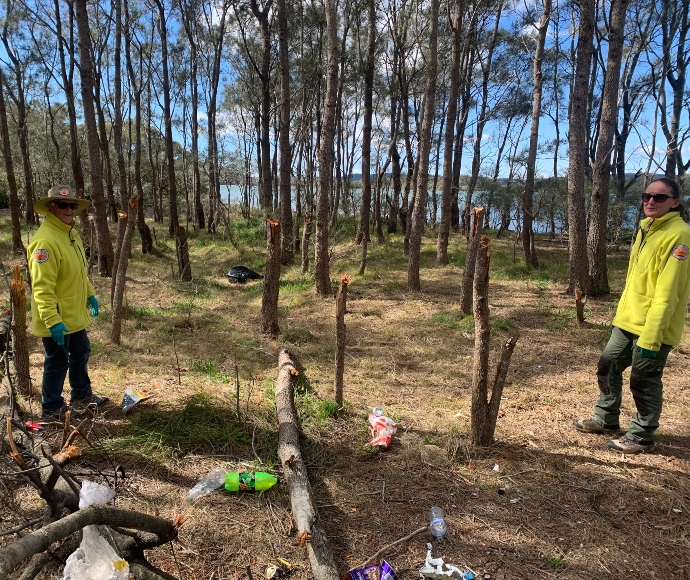
$6.7 Million Tomaree Coastal Walk To Showcase Port Stephens' Natural Beauty And Boost Regional Tourism
 September 1, 2023
September 1, 2023Water Careers Showcase To Lure Bright Minds
Panel To Review Barwon Darling Connectivity
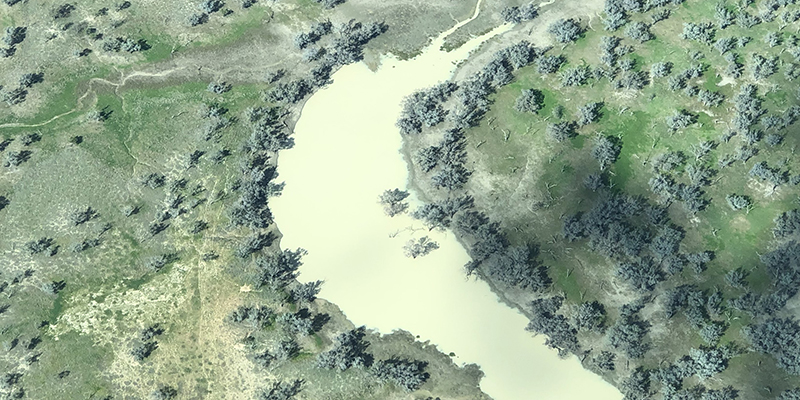 The NSW Government has set up an independent expert panel to provide feedback on work being carried out to improve connectivity and flows in the Barwon Darling.
The NSW Government has set up an independent expert panel to provide feedback on work being carried out to improve connectivity and flows in the Barwon Darling.- Ms Amy Dula - Chair (Director of Programs Natural Resources Commission)
- Professor Phil Duncan (First Nations representative, Galambany Professional Fellow, Acting CEO, EPIC CRC)
- Dr Mark Southwell (Principal River Scientist, 2rog Consulting)
- Dr Phil Townsend (Senior Economic Analyst)
- Mr Cameron Smith (Principal Water Engineer, Cleah Consulting)
- Professor Fran Sheldon (Head of the School of Environment and Science at Griffith University).
Smoke In Air-On Horizon - Red Sunsets Already: August 23-24, 2023
- Keep doors and windows closed to prevent smoke entering homes
- Keep outdoor furniture under cover to prevent ember burns
- Retract pool covers to prevent ember damage
- Remove washing from clotheslines
- Ensure pets have a protected area
- Vehicles must slow down, keep windows up, turn headlights on
- Sightseers must keep away from burns for their own safety
- If you have asthma or a lung condition, reduce outdoor activities if smoke levels are high and if shortness of breath or coughing develops, take your reliever medicine or seek medical advice
Get Ready Weekend 2023: Know Your Risk This Bush Fire Season
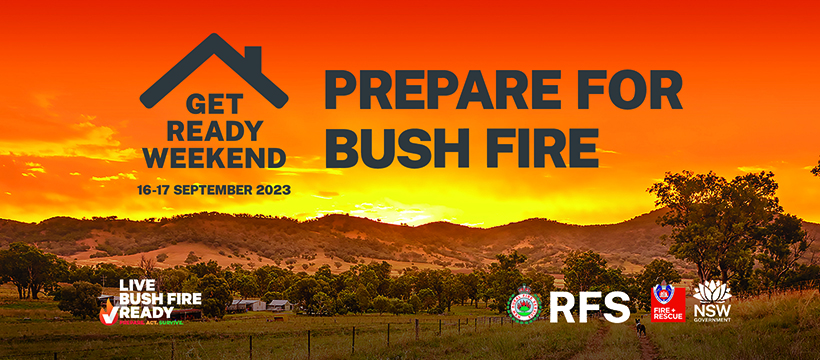
Murray Cod And Murray Crayfish Season Comes To A Close For 2023
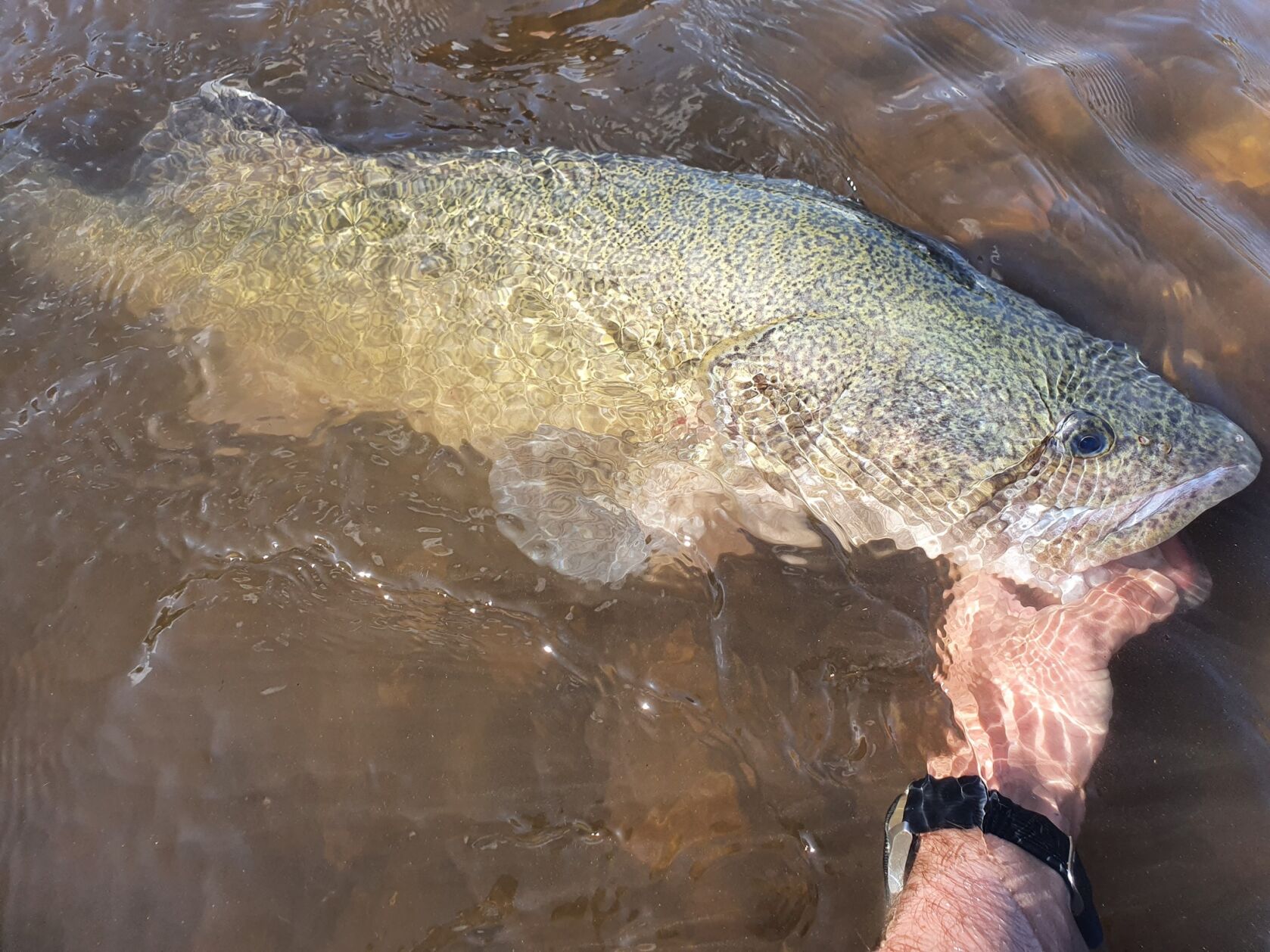
Australian Bass And Estuary Perch Open Season Now Officially Underway
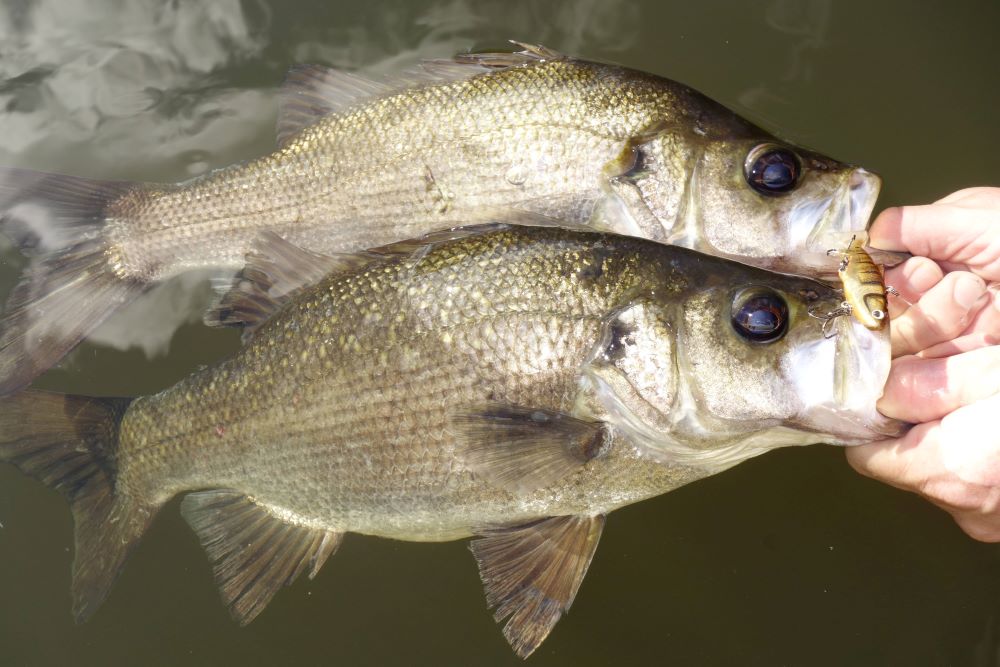
NSW EPA Invites Feedback On How Biosolids Are Managed
Sydney To Host World's First Global Nature Positive Summit
- transparency and reporting – you can’t manage what you don’t measure
- investment in nature – growing business demand
- partnerships and capacity development – increasing landholder participation
Integrating Displaced Populations Into National Climate Change Policy And Planning - Policy Brief
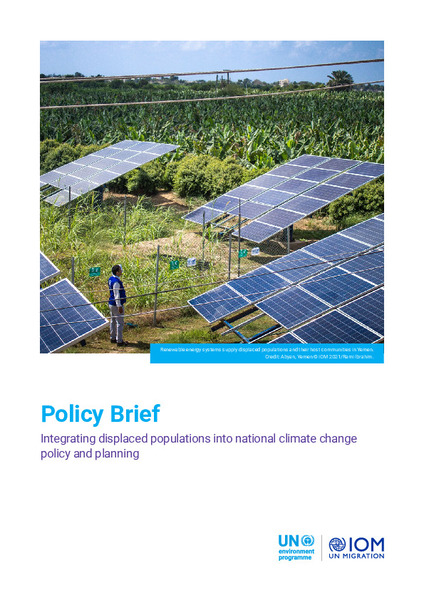 August 30, 2023: UN
August 30, 2023: UN- Integrating human mobility, including displacement, in the policies and plans of ministries and agencies responsible for climate, environment, energy and development.
- Integrating climate, environment and development, in human mobility and displacement policies, planning and implementation.
‘Coastal Residents United’ Launched: New Alliance Of Community Groups Fighting Inappropriate Development
- Bonny Hills Progress Association
- Broulee Mossy Point Community Association
- Burradise - Don’t go changin’
- Byron Bay Vision
- Byron Residents’ Group
- Callala Environmental Alliance
- Chinderah District Residents Association Inc
- Clarence Environment Centre
- Clearency Valley Conservation Coalition
- Clarence Valley Watch Inc
- Concerned Citizens of Harrington
- Culburra Residents and Ratepayers Action Group
- Dalmeny Matters
- Friends of CRUNCH
- Hallidays Point Community Action Group
- Iluka DA Have Your Say
- Keep Yamba Country
- Kingscliff Ratepayers and Progress Association Inc
- Lake Wollumboola Protection Association
- Manyana Matters
- Our Future Shoalhaven
- Protect Coila Lake’s fragile ecosystem
- Red Rock Preservation Society
- Red Rock Village Community Association
- Save Callala Beach
- Stop the Fill Yamba
- Tumbulgum Community Association Inc
- Tura Beach Biodiversity Group
- Tuross Head Progress Association
- Valla Beach Community Association
- Valley Watch - Yamba
- Voices of South West Rocks
- Yamba Community Action Network
- Save Myall Road Bushland
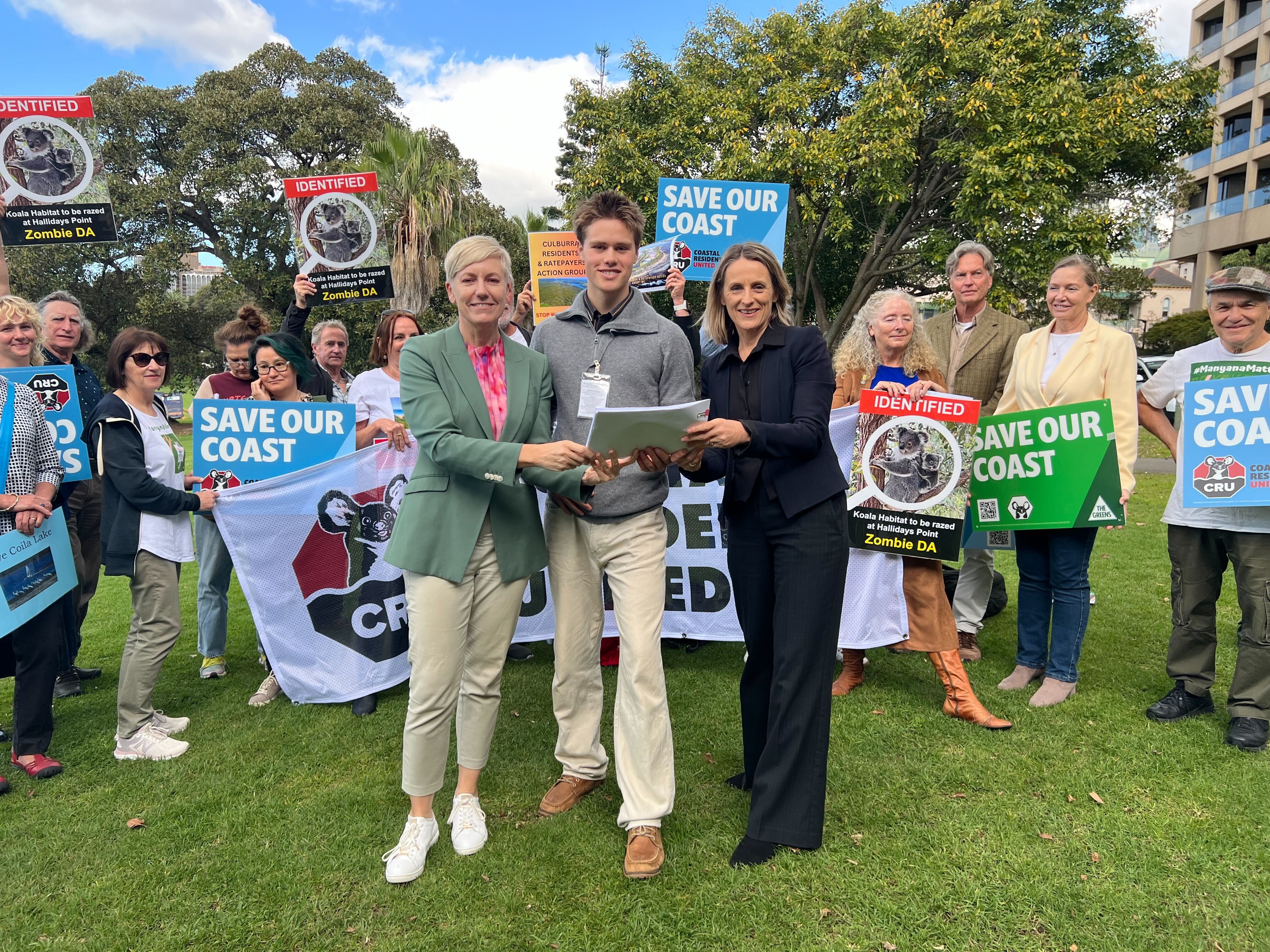
NSW Government Adds Additional Housing Supply In Former Bega TAFE Site
- Implemented planning reforms to expedite the delivery of more housing as building more homes is essential to reducing homelessness;
- Extended temporary accommodation from an initial period of two days to seven days;
- Removed the 28-day cap ensuring vulnerable people are able to access support when they need it most;
- Increased the cash assets limit from $1,000 to $5,000 when assessing eligibility for Temporary Accommodation;
- Removed the cash asset limit assessment entirely for people escaping domestic and family violence;
- Extended Specialist Homelessness Services contracts for two years, to 30 June 2026;
- Appointed a Rental Commissioner to work with us in designing and implementing changes that rebalance the rental market, making it fairer and more modern; and
- Put a 12-month freeze on the requirement for people in temporary accommodation to complete a Rental Diary, while the scheme is reviewed.
Have Your Say On Harbourside Redevelopment At Darling Harbour
- Widening and upgrades to the Waterfront Promenade;
- Embellishments to the building’s interface with Darling Drive;
- Fit-out and use of public elements of the building, including the Bunn Street Steps through- site link, Waterfront Steps, Pyrmont Bridge Steps, and Waterfront Garden;
- Embellishment of the North and South Walks;
- Construction and operation of the new Bunn Street pedestrian bridge, and embellishments to the existing Murray Street pedestrian bridge; and
- Opportunities for heritage interpretation and public art.
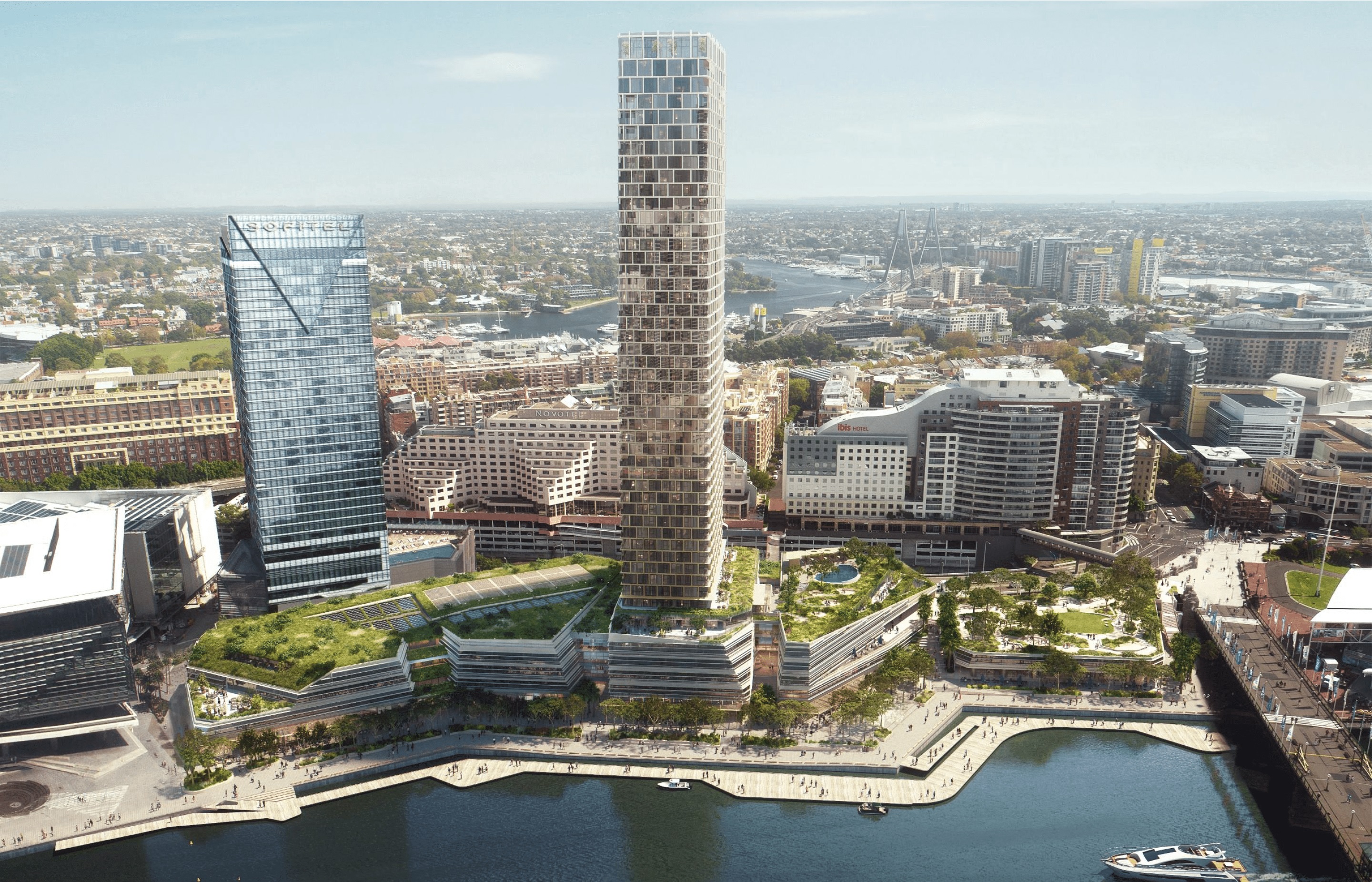
New Immersive 'Digital Doorway' Makes The Border Ranges Accessible From Home
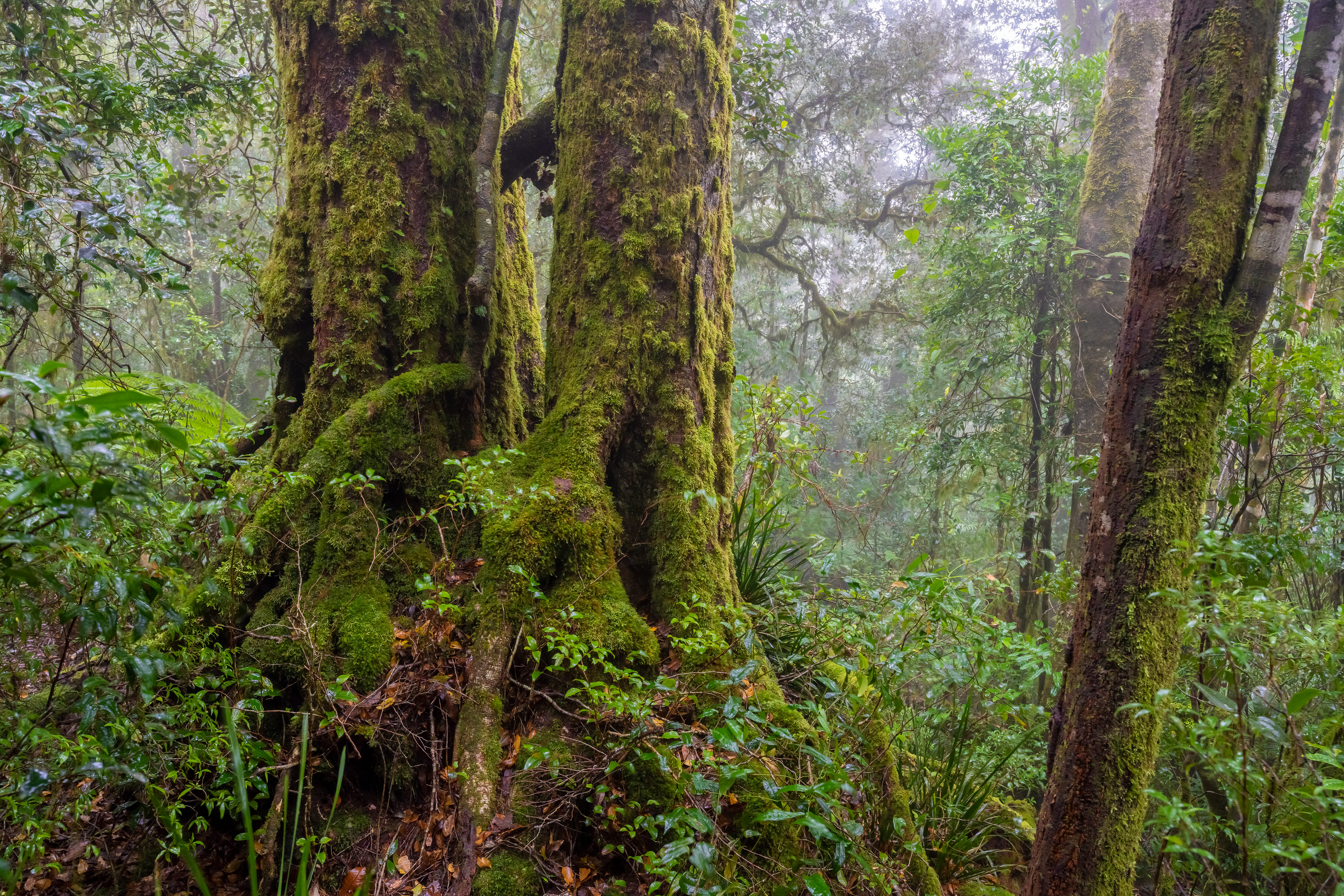
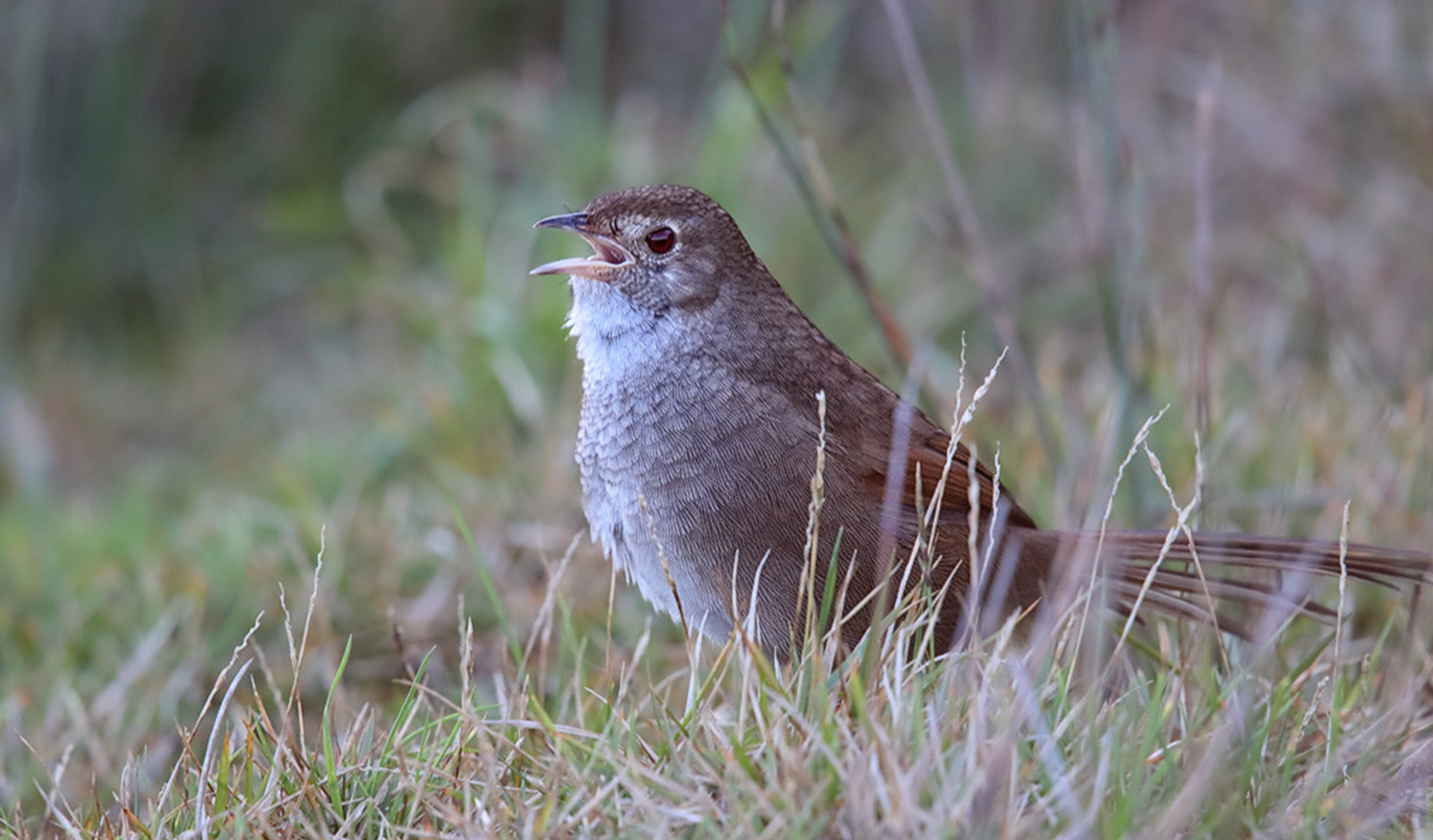
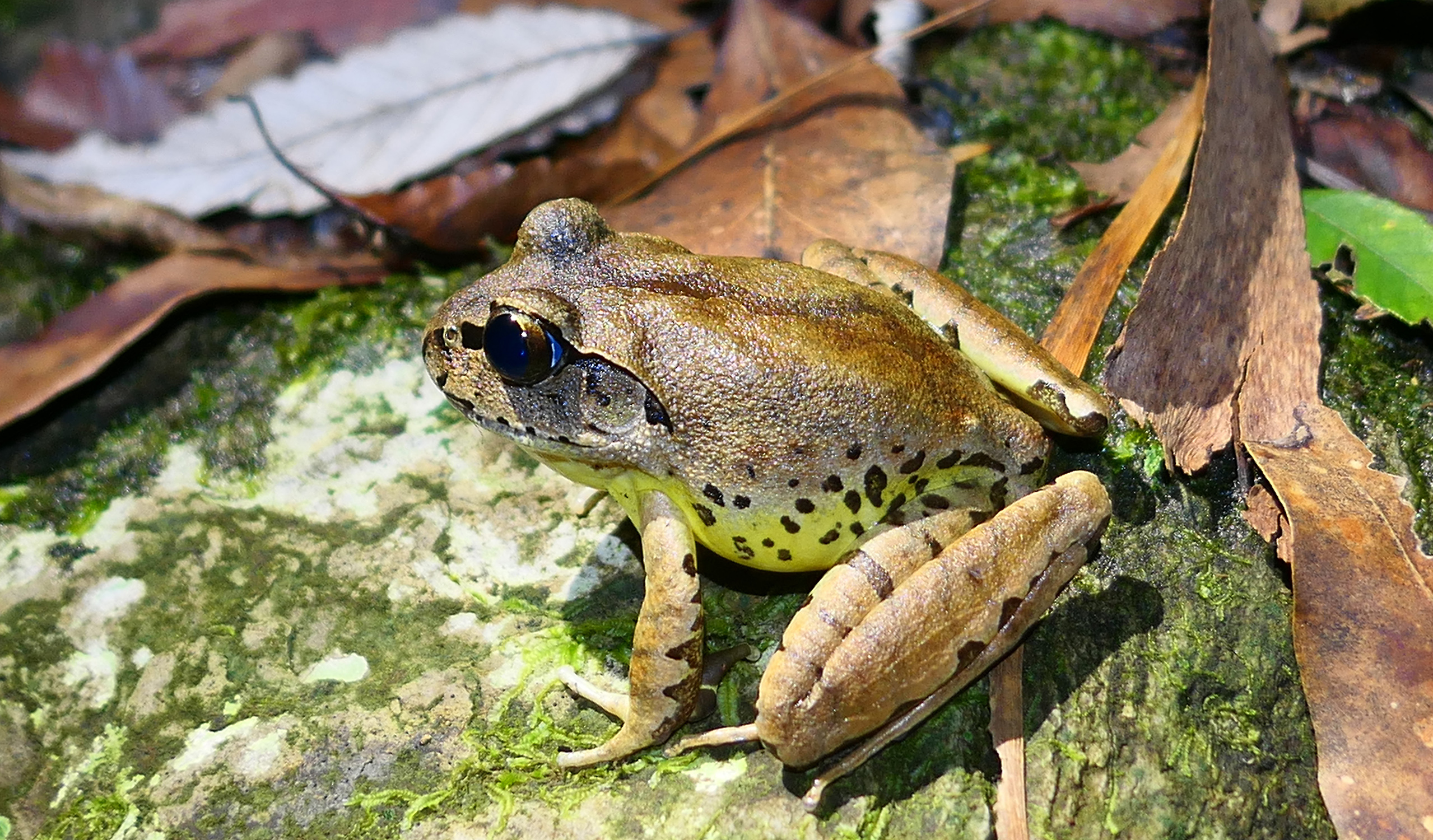
One-Year Ban For Bulk Coal Carrier For Appalling Treatment Of Seafarers
Saving Native Species Grants
- 22 Birds
- 21 Mammals
- 9 Fish
- 6 Frogs
- 11 Reptiles
- 11 Invertebrates
- 30 Plants
Bushcare Training Day At North Narrabeen
- Weed identification and best practice removal techniques
- Native plant identification and weed species including lookalikes
- Hands-on weed removal
- Bring along your unknown plant species for identification
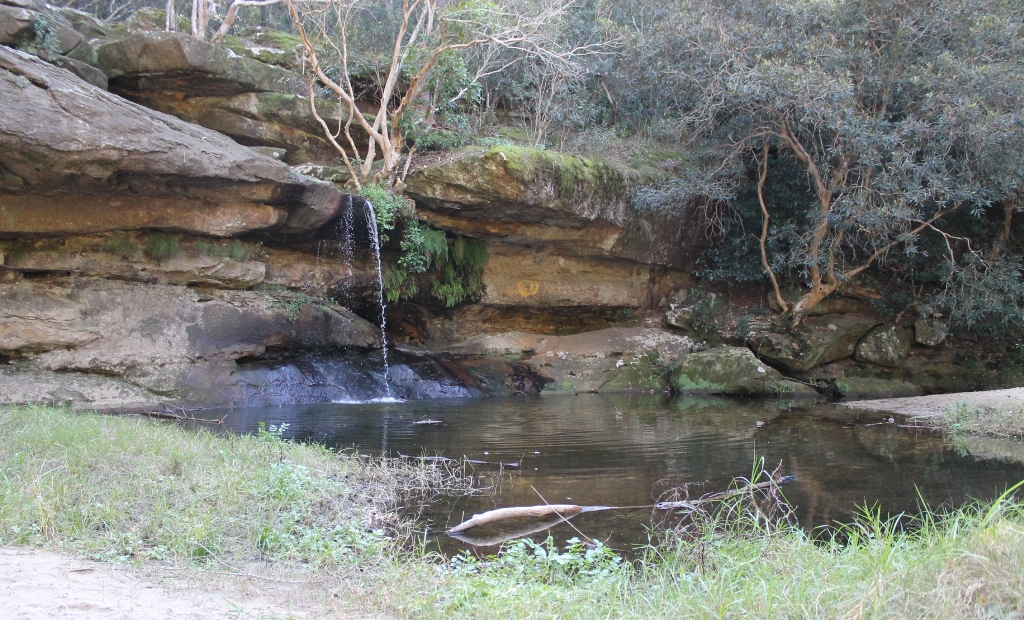
Palmgrove Park Avalon: New Bushcare Group Begins
 Palmgrove Park Avalon is a remnant of the Spotted Gum forest that was once widespread on the lower slopes of the Pittwater peninsula. This bushland’s official name and forest type is Pittwater and Wagstaffe Endangered Ecological Community, endangered because so much has been cleared for suburban development. Canopy trees, smaller trees and shrubs, and ground layer plants make up this community. Though scattered remnant Spotted Gums remain on private land, there is little chance of seedlings surviving in gardens and lawns. More information HERE
Palmgrove Park Avalon is a remnant of the Spotted Gum forest that was once widespread on the lower slopes of the Pittwater peninsula. This bushland’s official name and forest type is Pittwater and Wagstaffe Endangered Ecological Community, endangered because so much has been cleared for suburban development. Canopy trees, smaller trees and shrubs, and ground layer plants make up this community. Though scattered remnant Spotted Gums remain on private land, there is little chance of seedlings surviving in gardens and lawns. More information HERE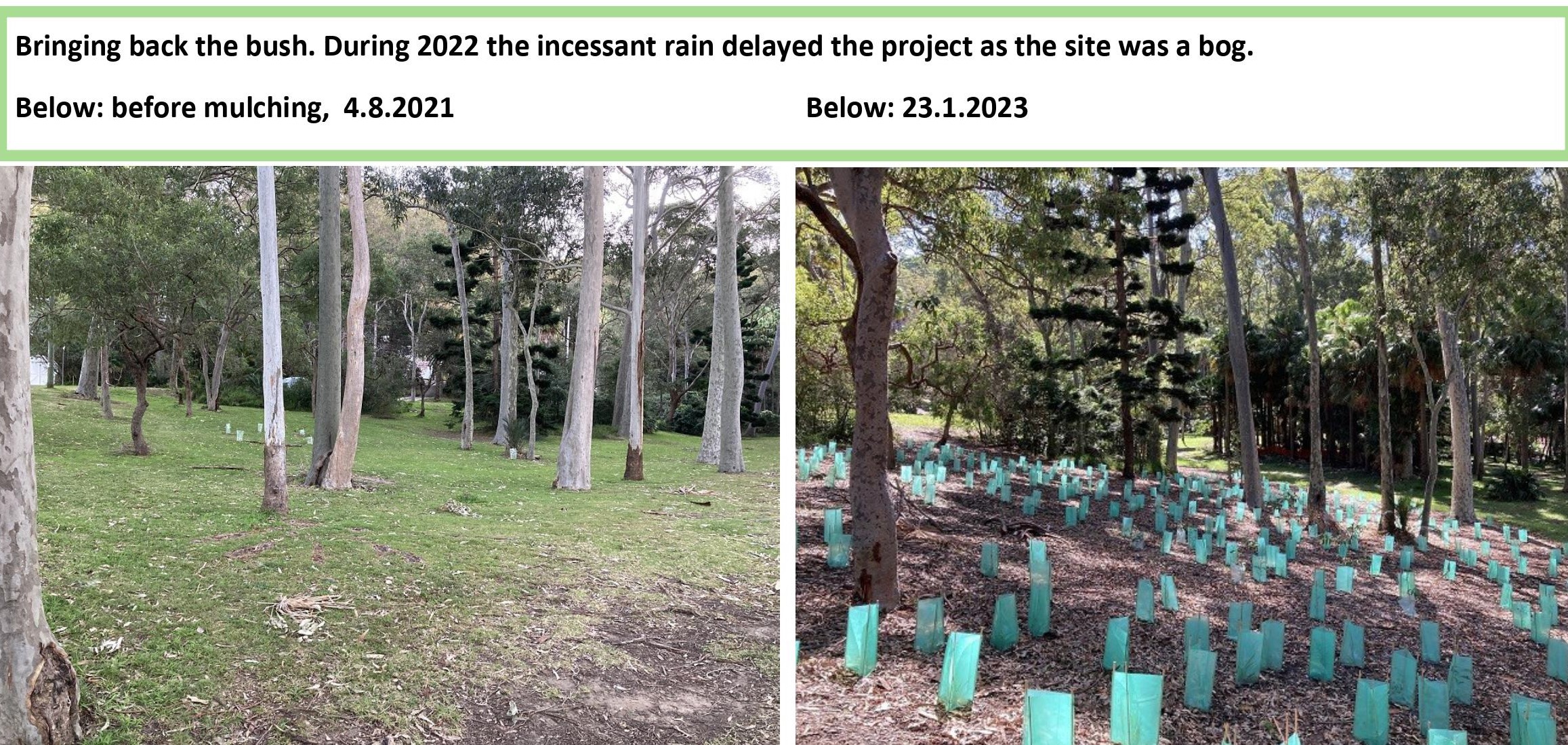
2023 Banksia Foundation NSW Sustainability Awards Open For Nominations
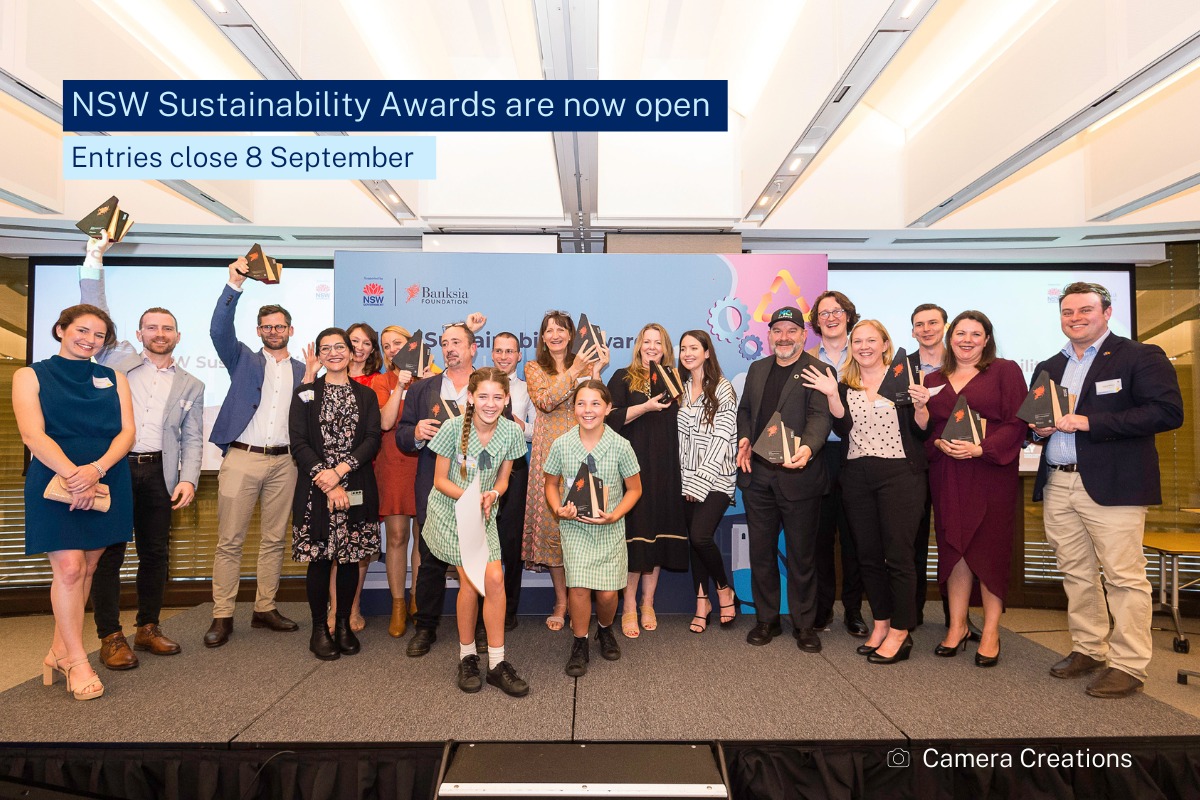
Stony Range Spring Festival 2023: Sunday September 10
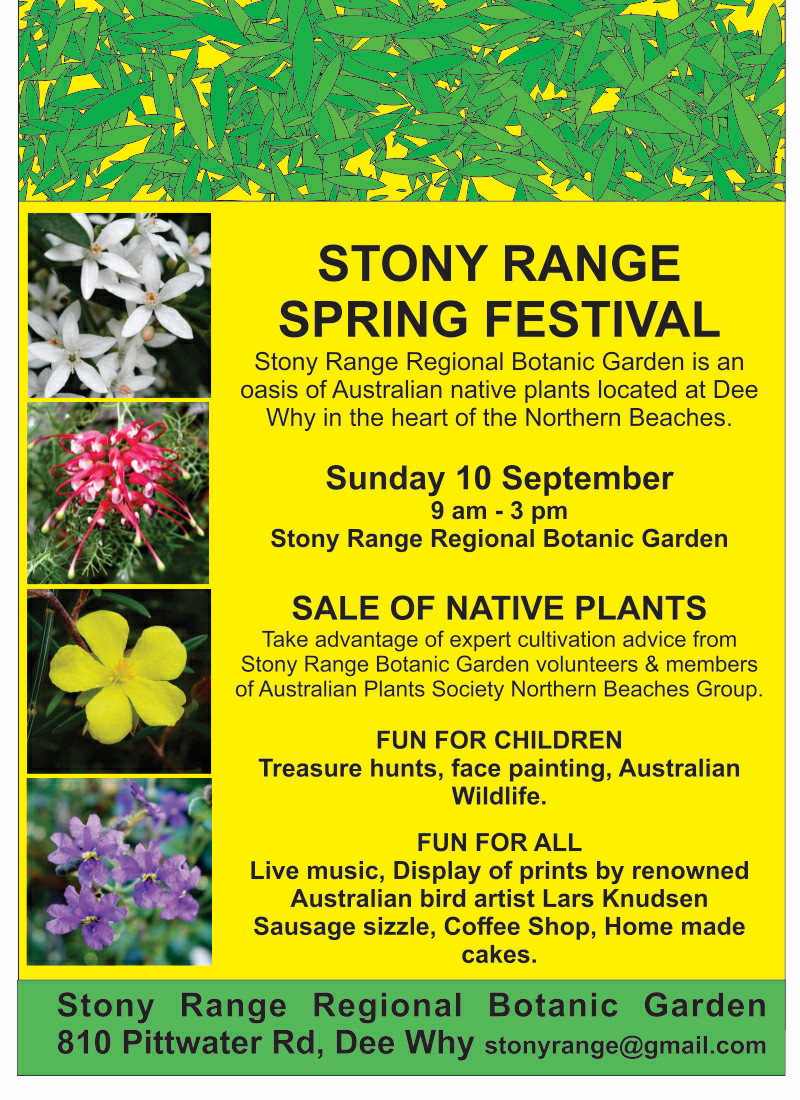
Seen Any Glossies Drinking Around Nambucca, Bellingen, Coffs Or Clarence? Want To Help?: Join The Glossy Squad
- a female bird (identifiable by yellow on her head) begging and/or being fed by a male (with plain black/brown head and body and unbarred red tail feathers)
- a lone adult male, or a male with a begging female, flying purposefully after drinking at the end of the day.

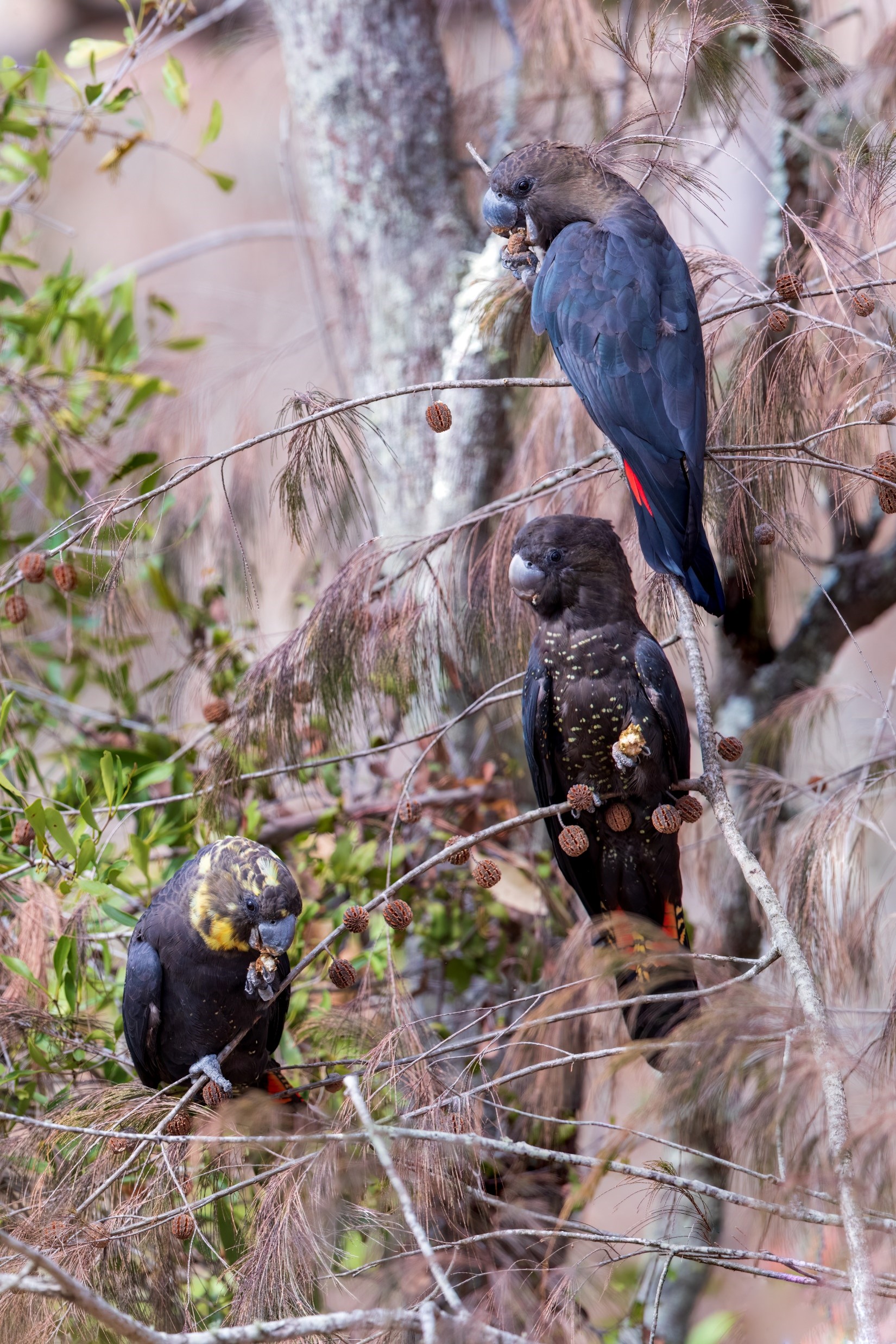
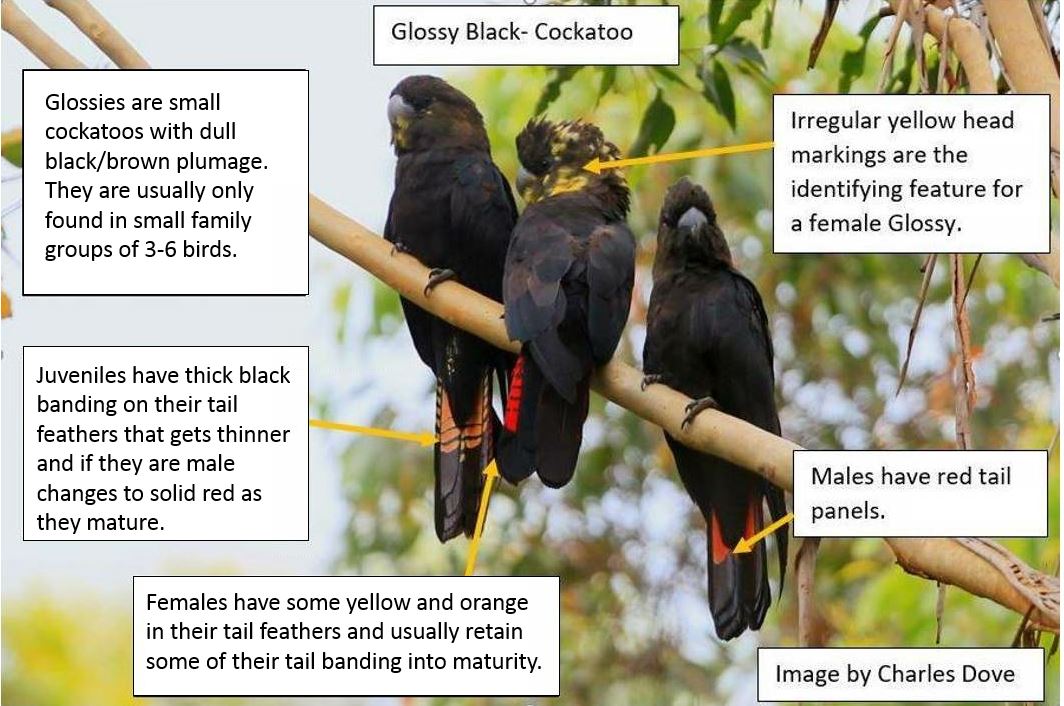
Loss Of Antarctic Sea Ice Causes Catastrophic Breeding Failure For Emperor Penguins: 'There Is No Time Left'
$850,000 In Funding Open To Improve Fish Habitat
- removal or modification of barriers to fish passage
- rehabilitation of riparian lands (riverbanks, wetlands, mangrove forests, saltmarsh)
- re-snagging waterways with timber structure
- the removal of exotic vegetation from waterways and replacement with native plants
- bank stabilisation works
- fencing to exclude livestock.
Blue Mountains National Park And Kanangra-Boyd National Park Draft Plan Of Management: Public Consultation
- improving recognition of the parks significant values, including World and National Heritage values, and providing for adaptive management to protect the values
- recognising and supporting the continuation of partnerships with Aboriginal communities
- providing outstanding nature-based experiences for visitors through improvements to visitor facilities - including:
- Opportunities for supported or serviced camping, where tents and services are provided by commercial tour operators, may be offered at some camping areas in the parks
- Jamison Creek, Jamison Valley Walk-in camping Potential new camping
- Leura Amphitheatre Jamison Valley Walk-in camping Potential new camping
- Mount Solitary Jamison Valley Walk-in camping Potential new camping
- Maxwell’s HuC Kedumba Valley Cabin/hut Potential new accommodation
- Kedumba Valley Maxwell’s Hut (historic slab hut) - Building restoration in progress; potential new Accommodation for bushwalkers
- Government Town Police station; courthouse - Potential new Visitor accommodation
- write clearly and be specific about the issues that are of concern to you
- note which part or section of the document your comments relate to
- give reasoning in support of your points - this makes it easier for us to consider your ideas and will help avoid misinterpretation
- tell us specifically what you agree/disagree with and why you agree or disagree
- suggest solutions or alternatives to managing the issue if you can.
Areas Closed For West Head Lookout Upgrades
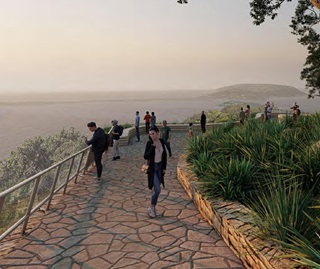 NPWS advise that the following areas are closed from Monday 22 May to Thursday 30 November 2023 while West Head lookout upgrades are underway:
NPWS advise that the following areas are closed from Monday 22 May to Thursday 30 November 2023 while West Head lookout upgrades are underway:
- West Head lookout
- The loop section of West Head Road
- West Head Army track.
Vehicles, cyclists and pedestrians will have access to the Resolute picnic area and public toilets. Access is restricted past this point.
The following walking tracks remain open:
- Red Hands track
- Aboriginal Heritage track
- Resolute track, including access to Resolute Beach and West Head Beach
- Mackeral Beach track
- Koolewong track.
The West Head lookout cannot be accessed from any of these tracks.
Image: Visualisation of upcoming works, looking east from the ramp towards Barrenjoey Head Credit: DPE
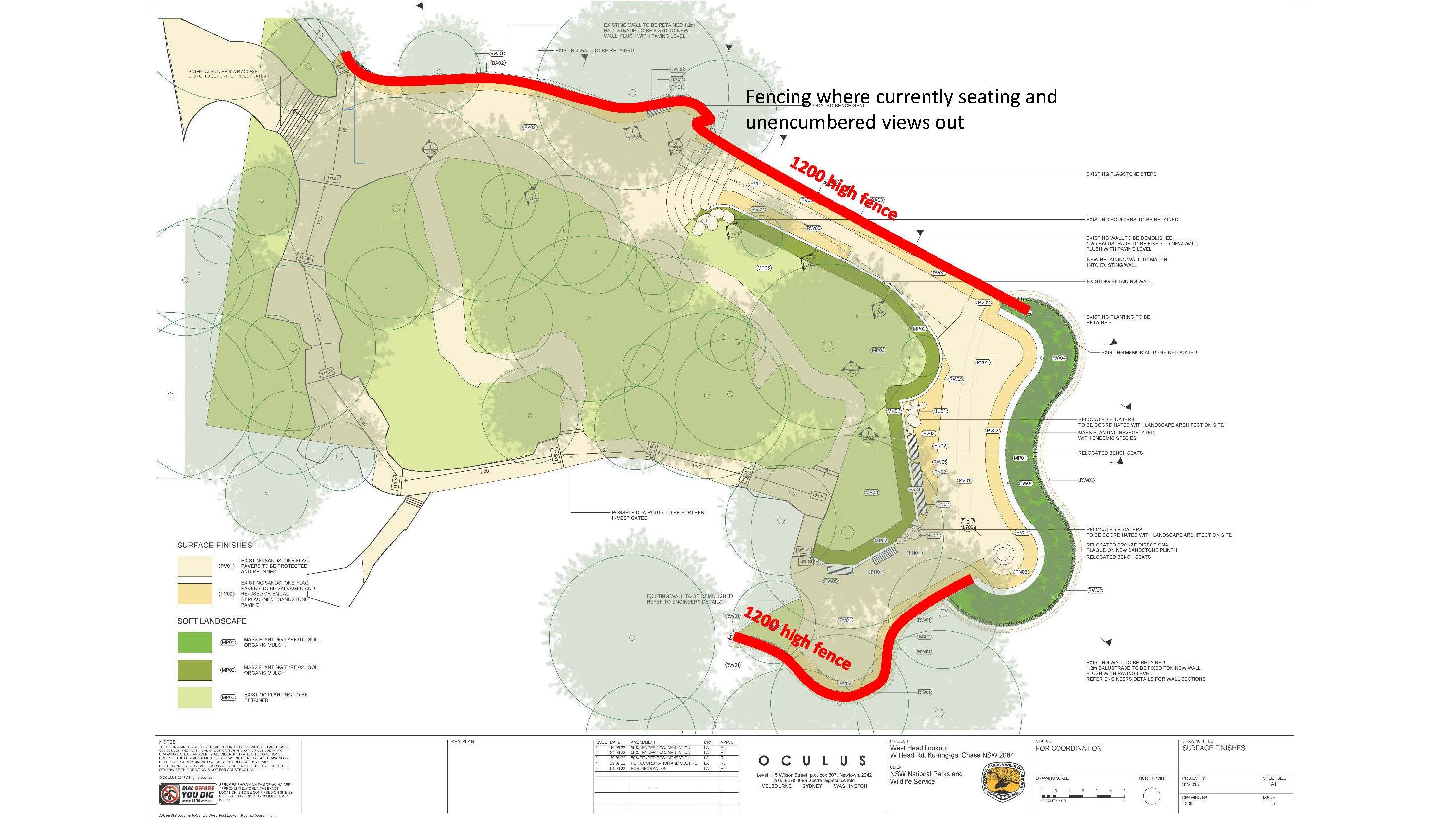
PNHA Guided Nature Walks 2023
Our walks are gentle strolls, enjoying and learning about the bush rather than aiming for destinations. Wear enclosed shoes. We welcome interested children over about 8 years old with carers. All Welcome.
So we know you’re coming please book by emailing: pnhainfo@gmail.com and include your phone number so we can contact you if weather is doubtful.
The whole PNHA 2023 Guided Nature Walks Program is available at: http://pnha.org.au/test-walks-and-talks/
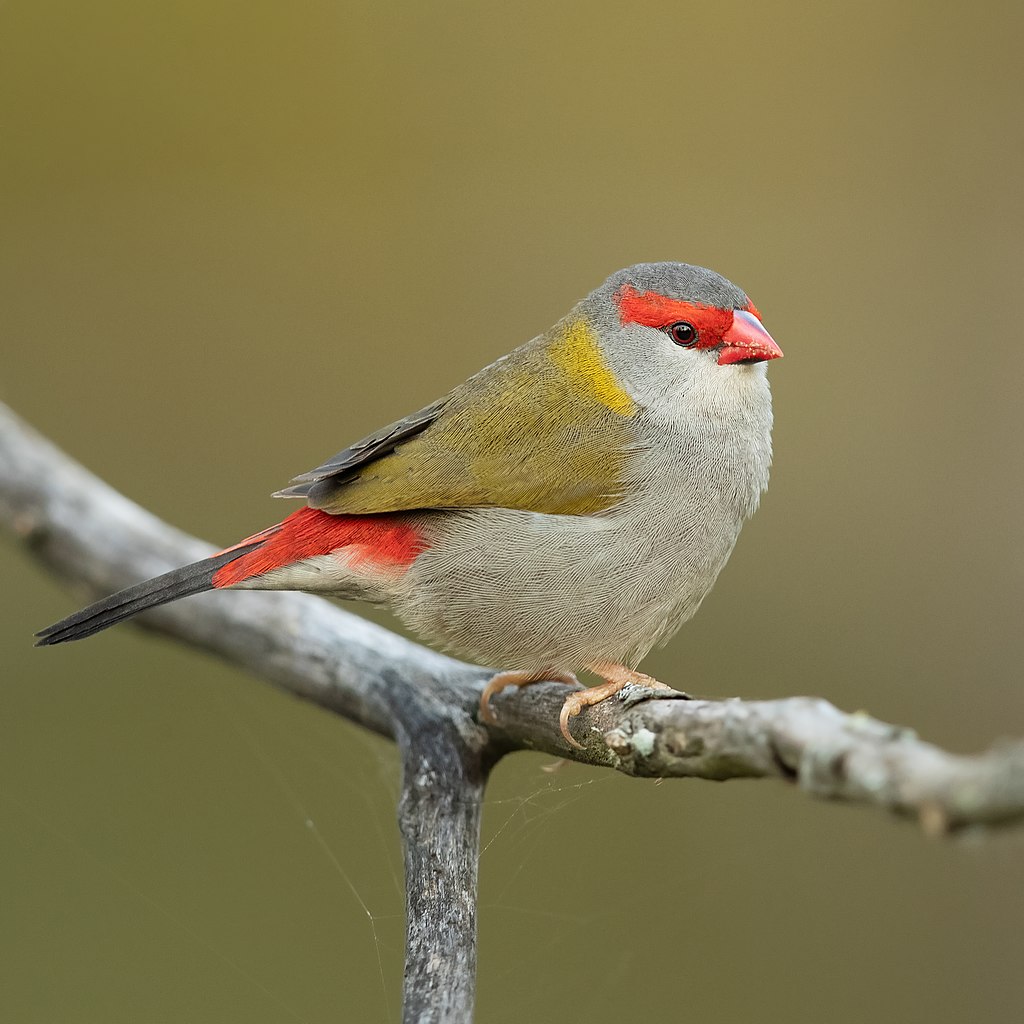
Red-browed finch (Neochmia temporalis). Photo: J J Harrison
Report Fox Sightings
%20(1).jpg?timestamp=1675893929686)
Marine Wildlife Rescue Group On The Central Coast
A new wildlife group was launched on the Central Coast on Saturday, December 10, 2022.
Marine Wildlife Rescue Central Coast (MWRCC) had its official launch at The Entrance Boat Shed at 10am.
The group comprises current and former members of ASTR, ORRCA, Sea Shepherd, Greenpeace, WIRES and Wildlife ARC, as well as vets, academics, and people from all walks of life.
Well known marine wildlife advocate and activist Cathy Gilmore is spearheading the organisation.
“We believe that it is time the Central Coast looked after its own marine wildlife, and not be under the control or directed by groups that aren’t based locally,” Gilmore said.
“We have the local knowledge and are set up to respond and help injured animals more quickly.
“This also means that donations and money fundraised will go directly into helping our local marine creatures, and not get tied up elsewhere in the state.”
The organisation plans to have rehabilitation facilities and rescue kits placed in strategic locations around the region.
MWRCC will also be in touch with Indigenous groups to learn the traditional importance of the local marine environment and its inhabitants.
“We want to work with these groups and share knowledge between us,” Gilmore said.
“This is an opportunity to help save and protect our local marine wildlife, so if you have passion and commitment, then you are more than welcome to join us.”
Marine Wildlife Rescue Central Coast has a Facebook page where you may contact members. Visit: https://www.facebook.com/profile.php?id=100076317431064
- Ph: 0478 439 965
- Email: marinewildlifecc@gmail.com
- Instagram: marinewildliferescuecc
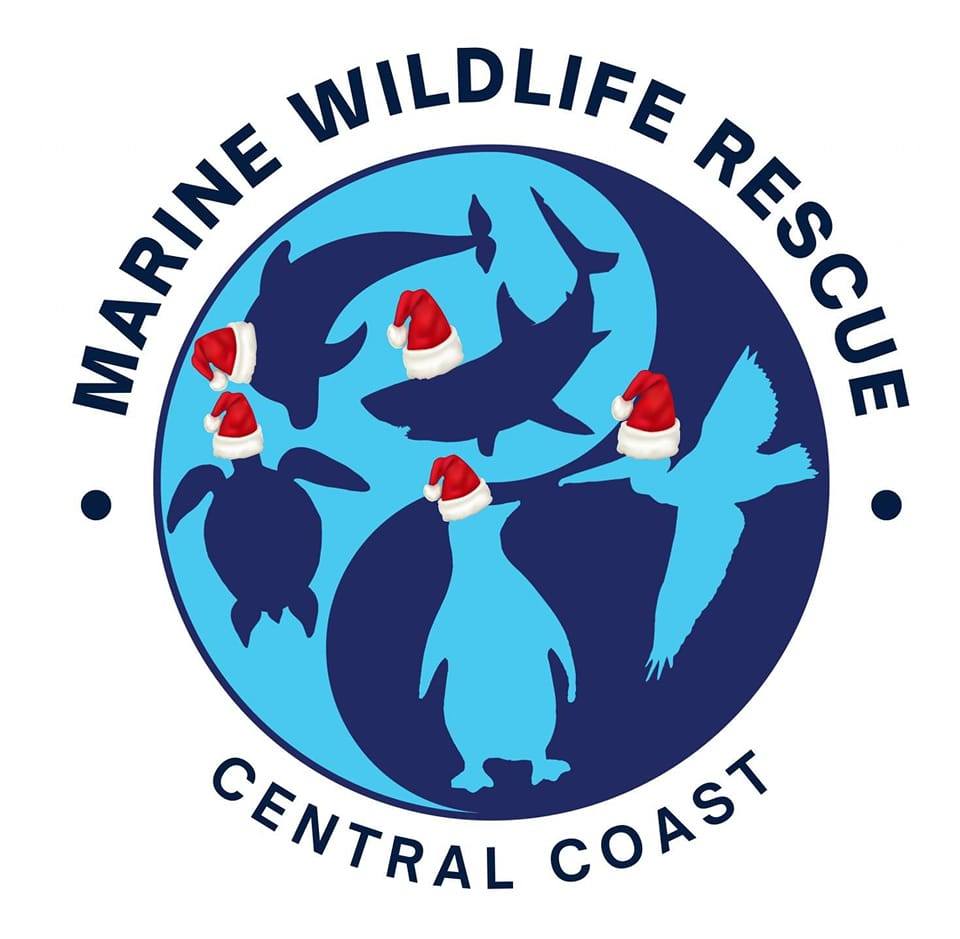
Watch Out - Shorebirds About
.JPG.opt1460x973o0,0s1460x973.jpg?timestamp=1663629195339)
Possums In Your Roof?: Do The Right Thing
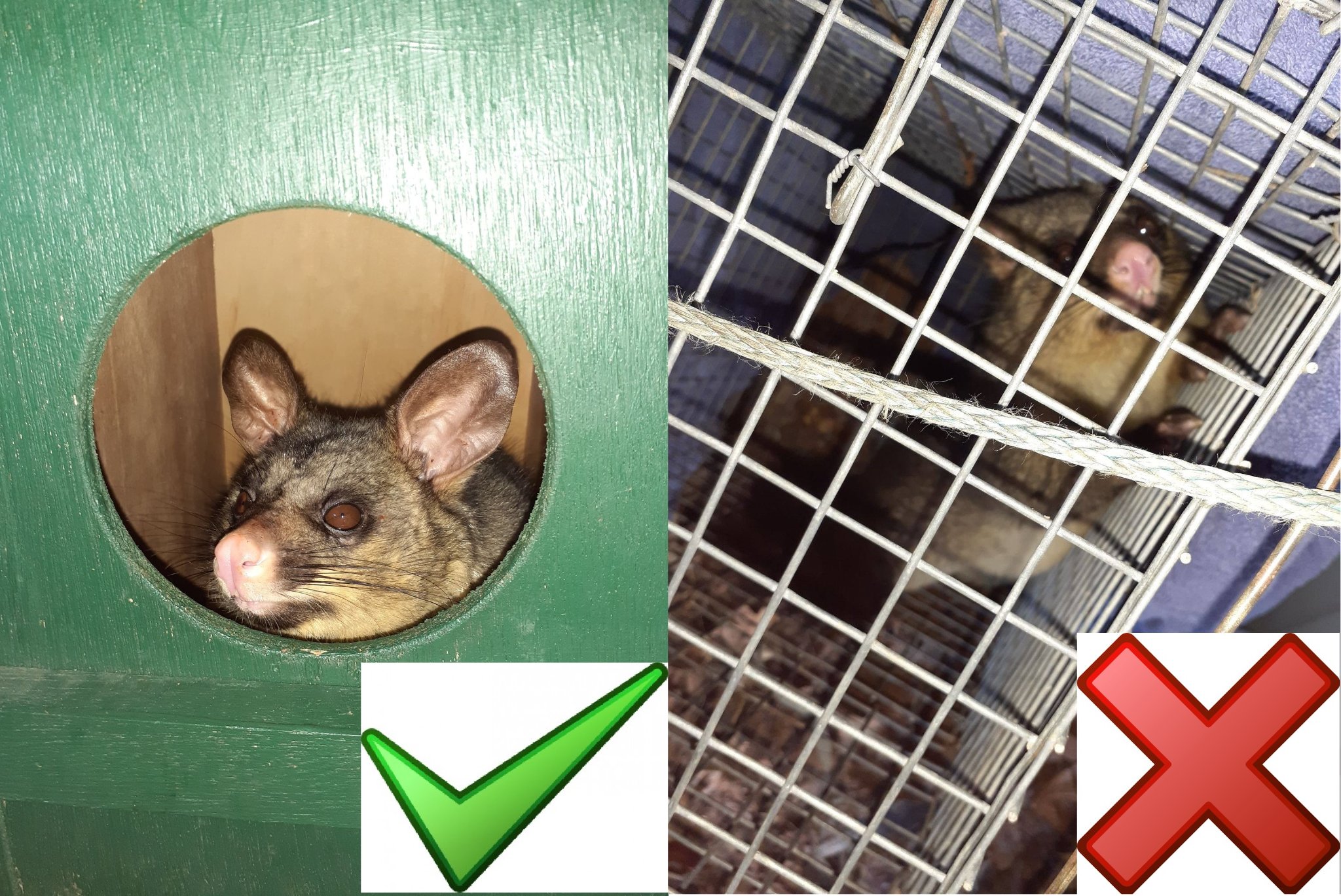
Aviaries + Possum Release Sites Needed

Bushcare In Pittwater
Where we work Which day What time
Avalon
Angophora Reserve 3rd Sunday 8:30 - 11:30am
Avalon Dunes 1st Sunday 8:30 - 11:30am
Avalon Golf Course 2nd Wednesday 3 - 5:30pm
Careel Creek 4th Saturday 8:30 - 11:30am
Toongari Reserve 3rd Saturday 9 - 12noon (8 - 11am in summer)
Bangalley Headland 2nd Sunday 9 to 12noon
Bayview
Winnererremy Bay 4th Sunday 9 to 12noon
Bilgola
North Bilgola Beach 3rd Monday 9 - 12noon
Algona Reserve 1st Saturday 9 - 12noon
Plateau Park 1st Friday 8:30 - 11:30am
Church Point
Browns Bay Reserve 1st Tuesday 9 - 12noon
McCarrs Creek Reserve Contact Bushcare Officer To be confirmed
Clareville
Old Wharf Reserve 3rd Saturday 8 - 11am
Elanora
Kundibah Reserve 4th Sunday 8:30 - 11:30am
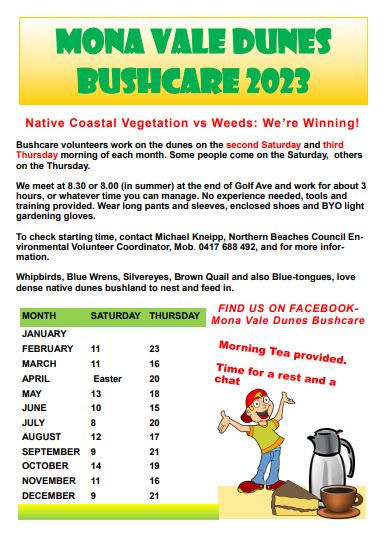 Mona Vale
Mona Vale Mona Vale Beach Basin 1st Saturday 8 - 11am
Mona Vale Dunes 2nd Saturday +3rd Thursday 8:30 - 11:30am
Newport
Bungan Beach 4th Sunday 9 - 12noon
Crescent Reserve 3rd Sunday 9 - 12noon
North Newport Beach 4th Saturday 8:30 - 11:30am
Porter Reserve 2nd Saturday 8 - 11am
North Narrabeen
Irrawong Reserve 2nd Saturday 2 - 5pm
Palm Beach
North Palm Beach Dunes 3rd Saturday 9 - 12noon
Scotland Island
Catherine Park 2nd Sunday 10 - 12:30pm
Elizabeth Park 1st Saturday 9 - 12noon
Pathilda Reserve 3rd Saturday 9 - 12noon
Warriewood
Warriewood Wetlands 1st Sunday 8:30 - 11:30am
Whale Beach
Norma Park 1st Friday 9 - 12noon
Western Foreshores
Coopers Point, Elvina Bay 2nd Sunday 10 - 1pm
Rocky Point, Elvina Bay 1st Monday 9 - 12noon
Friends Of Narrabeen Lagoon Catchment Activities

Gardens And Environment Groups And Organisations In Pittwater
We studied more than 1,500 coastal ecosystems - they will drown if we let the world warm above 2℃
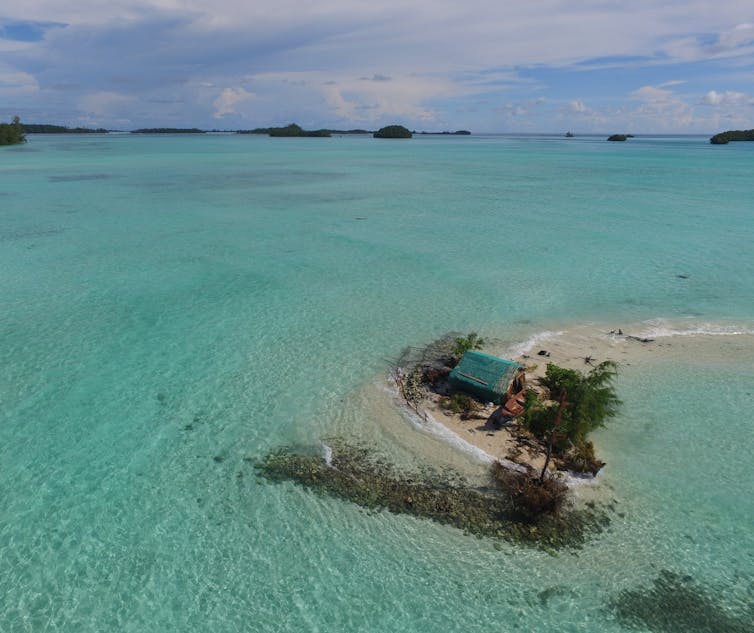
Much of the world’s natural coastline is protected by living habitats, most notably mangroves in warmer waters and tidal marshes closer to the poles. These ecosystems support fisheries and wildlife, absorb the impact of crashing waves and clean up pollutants. But these vital services are threatened by global warming and rising sea levels.
Recent research has shown wetlands can respond to sea level rise by building up their root systems, pulling carbon dioxide from the atmosphere in the process. Growing recognition of the potential for this “blue” carbon sequestration is driving mangrove and tidal marsh restoration projects.
While the resilience of these ecosystems is impressive, it is not without limits. Defining the upper limits to mangrove and marsh resilience under accelerating sea level rise is a topic of great interest and considerable debate.
Our new research, published today in the journal Nature, analyses the vulnerability and exposure of mangroves, marshes and coral islands to sea level rise. The results underscore the critical importance of keeping global warming within 2 degrees of the pre-industrial baseline.
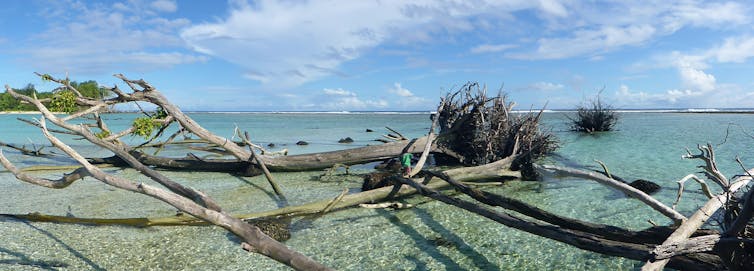
What We Did
We pulled together all the available evidence on how mangroves, tidal marshes and coral islands respond to sea level rise. That included:
delving into the geological record to study how coastal systems responded to past sea level rise, following the last Ice Age
tapping into a global network of survey benchmarks in mangroves and tidal marshes
analysing satellite imagery for changes in the extent of wetlands and coral islands at varying rates of sea level rise.
Altogether, our international team assessed 190 mangroves, 477 tidal marshes and 872 coral reef islands around the world.
We then used computer modelling to work out how much these coastal ecosystems would be exposed to rapid sea level rise under projected warming scenarios.
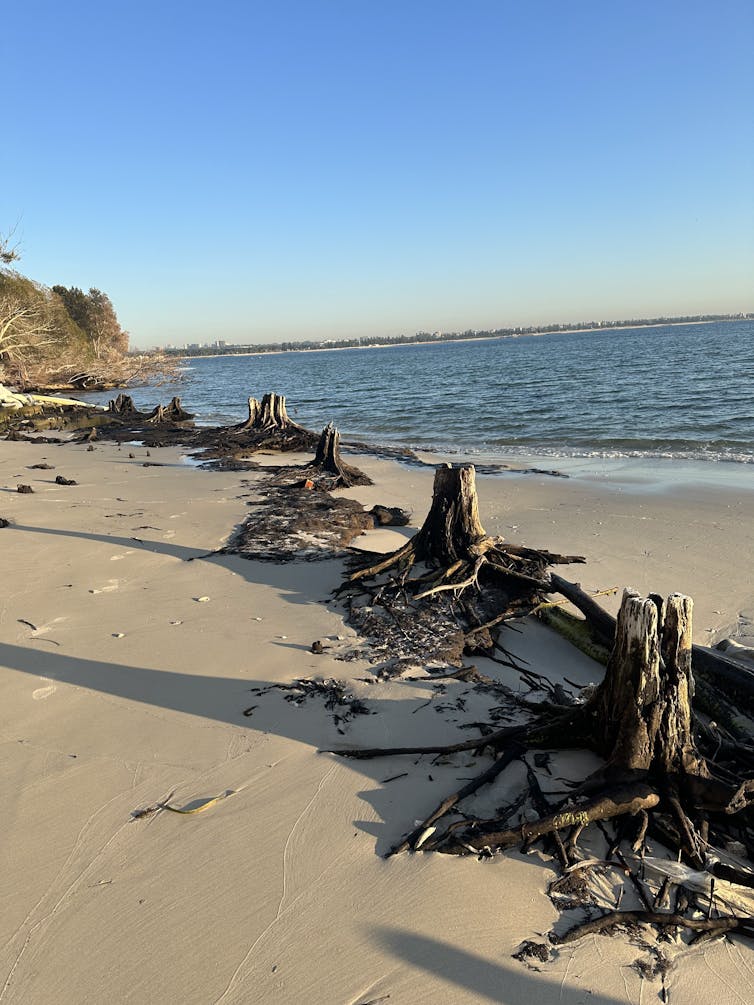
What We Found
Mangroves, tidal marshes and coral islands can cope with low rates of sea-level rise. They remain stable and healthy.
We found most tidal marshes and mangroves are keeping pace with current rates of sea level rise, around 2–4mm per year. Coral islands also appear stable under these conditions.
In some locations, land is sinking, so the relative rate of sea level rise is greater. It may be double this 2–4mm figure or more, comparable to rates expected under future climate change. In these situations, we found marshes failing to keep up with sea level rise. They are slowly drowning and in some cases, breaking up. What’s more, these are the same rates of sea level rise under which marshes and mangrove drown in the geological record.
These cases give us a glimpse of the future in a warming world.
So if the rate of sea level rise doubles to 7 or 8 millimetres a year, it becomes “very likely” (90% probability) mangroves and tidal marshes will no longer keep pace, and “likely” (about 67% probability) coral islands will undergo rapid changes. These rates will be reached when the 2.0℃ warming threshold is exceeded.
Even at the lower rates of sea level rise we would have between 1.5℃ and 2.0℃ of warming (4 or 5mm a year), extensive loss of mangrove and tidal marsh is likely.
Tidal marshes are less exposed to these rates of sea level rise than mangroves because they occur in regions where the land is rising, reducing the relative rate of sea level rise.
Let’s Give Coastal Ecosystems A Fighting Chance
We know mangroves and tidal marshes have survived rapid sea level rise before, at rates even higher than those projected under extreme climate change.
They won’t have long enough to build up root systems or trap sediment in order to stay in place, so they will seek higher ground by shifting landward into newly flooded coastal lowlands.
But this time, they will be competing with other land uses and increasingly trapped behind coastal levees and hard barriers such as roads and buildings.
If the global temperature rise is limited to 2℃, coastal ecosystems have a fighting chance. But if this threshold is exceeded, they will need more help.
Intervention is needed to enable the retreat of mangroves and tidal marshes across our coastal landscapes. There is a role for governments in designating retreat pathways, controlling coastal development, and expanding coastal nature reserves into higher ground.
The future of the world’s living coastlines is in our hands. If we work to restore mangroves and tidal marshes to their former extent, they can help us tackle climate change. ![]()
Neil Saintilan, Professor, School of Natural Sciences, Macquarie University
This article is republished from The Conversation under a Creative Commons license. Read the original article.
They sense electric fields, tolerate snow and have ‘mating trains’: 4 reasons echidnas really are remarkable
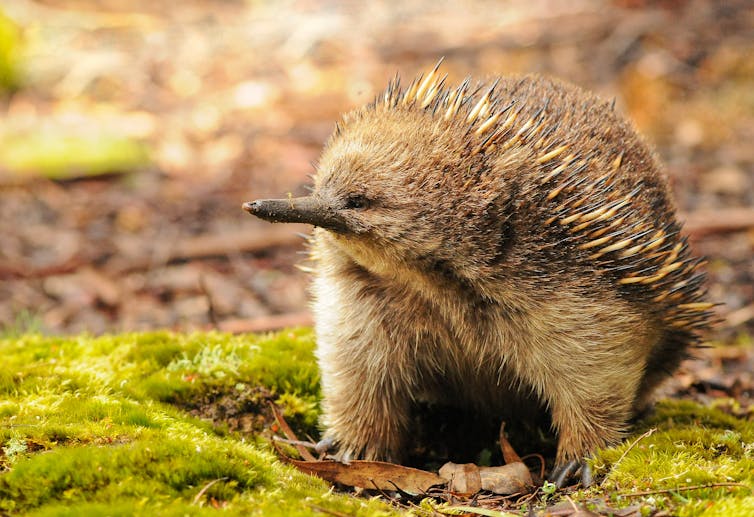
Many of us love seeing an echidna. Their shuffling walk, inquisitive gaze and protective spines are unmistakable, coupled with the coarse hair and stubby beak.
They look like a quirky blend of hedgehog and anteater. But they’re not related to these creatures at all. They’re even more mysterious and unusual than commonly assumed.
Australia has just one species, the short-beaked echidna (Tachyglossus aculeatus), which roams virtually the entire continent. But it has five subspecies, which are often markedly different. Tasmanian echidnas are much hairier and Kangaroo Island echidnas join long mating trains.
Here are four things that make echidnas remarkable.
1: They’re Ancient Egg-Laying Mammals
Short-beaked echidnas are one of just five species of monotreme surviving in the world, alongside the platypus and three worm-eating long-beaked echidna species found on the island of New Guinea.
Our familiar short-beaked echidnas can weigh up to six kilograms – but the Western long-beaked echidna can get much larger at up to 16kg.
These ancient mammals lay eggs through their cloacas (monotreme means one opening) and incubate them in a pouch-like skin fold, nurturing their tiny, jellybean-sized young after hatching.
Scientists believe echidnas began as platypuses who left the water and evolved spines. That’s because platypus fossils go back about 60 million years and echidnas only a quarter of that.
Remarkably, the echidna still has rudimentary electroreception. It makes sense the platypus relies on its ability to sense electric fields when it’s hunting at the bottom of dark rivers, given electric fields spread more easily through water. But on land? It’s likely echidnas use this ability to sense ants and termites moving through moist soil.
It probably got its English name in homage to the Greek mythological figure Echidna, who was half-woman, half-snake, and the mother of Cerberus and Sphinx. This was to denote the animal’s mix of half-reptilian, half-mammal traits. First Nations groups knew the echidna by many other names, such as bigibila (Gamilaraay) and yinarlingi (Warlpiri).
2: From Deserts To Snow, Echidnas Are Remarkably Adaptable
There are few other creatures able to tolerate climate ranges as broad. You can find echidnas on northern tropical savannah amid intense humidity, on coastal heaths and forests, in arid deserts and even on snowy mountains.
The five subspecies of short-beaked echidna have distinct geographic regions. The one most of us will be familiar with is Tachyglossus aculeatus aculeatus, widespread across Queensland, New South Wales, South Australia and Victoria. You can think of this as “echidna classic”.
Then there’s Kangaroo Island’s T. aculeatus multiaculeatus, Tasmania’s T. aculeatus setosus, the Northern Territory and Western Australia’s T. aculeatus acanthion and the tropical subspecies T. aculeatus lawesii found in Northern Queensland and Papua New Guinea.
You might think subspecies wouldn’t be too different – otherwise they’d be different species, right? In fact, subspecies can be markedly different, with variations to hairiness and the length and width of spines.
Kangaroo Island echidnas have longer, thinner, and paler spines – and more of them, compared to the mainland species. Tasmanian echidnas are well adapted to the cold, boasting a lushness of extra hair. Sometimes you can’t even see their spines amidst their hair.
3: Mating Trains And Hibernation Games
Remarkably, the subspecies have very different approaches to mating. You might have seen videos of Kangaroo Island mating trains, a spectacle where up to 11 males fervently pursue a single female during the breeding season. Other subspecies do this, but it’s most common on Kangaroo Island. Scientists believe this is due to population density.
Pregnancy usually lasts about three weeks after mating for Kangaroo Island echidnas, followed by a long lactation period of 30 weeks for the baby puggle.
But Tasmanian echidnas behave very differently. During the winter mating season, males seek out hibernating females and wake them up to mate. Intriguingly, females can put their pregnancy on hold and go back into hibernation. They also have a shorter lactation period, of only 21 weeks.
What about the echidna subspecies we’re most familiar with? T. aculeatus aculeatus has a similarly short lactation period (23 weeks), but rarely engages in mating train situations. After watching the pregnancies of 20 of these echidnas, my colleagues and I discovered this subspecies takes just 16–17 days to go from mating to egg laying.
4: What Do Marsupials And Monotremes Have In Common?
Marsupials bear live young when they’re very small and let them complete their development in a pouch. Despite this key difference with monotremes, there’s a fascinating similarity between Australia’s two most famous mammal families.
At 17 days after conception, the embryo of the tammar wallaby (Macropus eugenii) hits almost exactly the same developmental milestone as echidna embryos. Both are in the somite stage, where paired blocks of tissue form along the notochord, the temporary precursor to the spinal cord, and each have around 20 somites.
What’s remarkable about this? Monotremes branched off from other mammals early on, between 160 and 217 million years ago. Marsupials branched off later, at around 143–178 million years ago.
Yet despite millions of years of evolutionary pressure and change, these very different animals still hit a key embryo milestone at the same time. This striking parallel suggests the intricate process has been conserved for over 184 million years.
In echidnas, this milestone is tied to egg-laying – the embryo is packaged up in a leathery egg the size of a grape and laid into the mother’s pouch. The baby puggle hatches 10–11 days later. In tammar wallabies, the embryo continues to develop in-utero for another 9–10 days before being born.
So the next time you spot the humble echidna, take a moment to appreciate what a remarkable creature it is. ![]()
Kate Dutton-Regester, Lecturer, Veterinary Science, The University of Queensland
This article is republished from The Conversation under a Creative Commons license. Read the original article.
How a lethal fungus is shrinking living space for our frogs
Geoffrey Heard, The University of Queensland; Benjamin Scheele, Australian National University; Conrad Hoskin, James Cook University; Jarrod Sopniewski, The University of Western Australia, and Jodi Rowley, UNSW SydneyIn 1993, frogs were found dying en masse in Far North Queensland. When scientists analysed their bodies, they found something weird. Their small bodies were covered in spores.
It was an epidemic. An aquatic fungus had eaten the keratin in their skin, compromising its function and leading to cardiac arrest. And worse, the amphibian chytrid fungus (Batrachochytrium dendrobatidis) had been quietly spreading around the world, from South America to Europe, killing frogs wherever it went.

Likely native to the Korean Peninsula, it was first detected in Australia in the late 1970s. As it spread, it caused the extinction of at least four Australian frog species and probably three others.
This lethal pathogen is a selective killer. As our new research shows, it effectively makes some areas a no-go zone for susceptible frog species. The fungus doesn’t like hot conditions. But in cooler environments – such as in southern Australia and higher up in mountain ranges – it flourishes. Mortality rates in these environments can approach 100% for some frog species.
Pushed From The Highlands
Australia is rich in frogs, with 247 surviving species at last count. Most are endemic to the continent – and many are spectacularly beautiful or, like the turtle frog, bizarre.
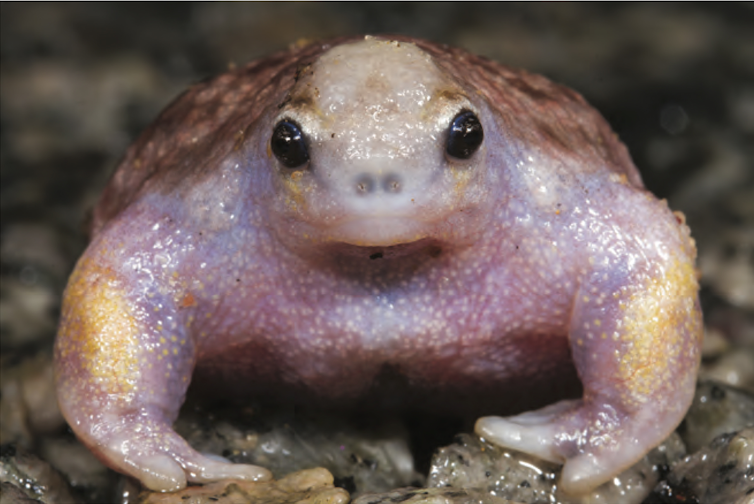
The gorgeous Australian lace-lid treefrog was once widespread across the rainforests of Queensland’s Wet Tropics, which run from Townsville to Cooktown, stretching from sea level up to Queensland’s highest mountain, the 1,622 metre Mt Bartle Frere.
Lace-lid treefrogs once lived throughout these forests, whether on mountains or down near sea level. But they have been driven from rainforests above 400 metres. Down lower, the heat makes it harder for chytrid to kill, and the frog’s higher breeding rate can outpace deaths from the disease.
No-Go Zones
Australians know full well about the damage introduced species can do. Cane toads kill native predators like quolls who aren’t used to their toxin. Cats and foxes have driven many small mammals to extinction.
But even when a species survives contact with an introduced species, it can be forever changed.
That’s because of less visible effects introduced species like chytrid fungus can have, such as shrinking the areas where native species can survive. When this happens, our species can be pushed into smaller parts of their original range, known as environmental refuges.
As our research shows, it’s not just geographic range that changes. It also changes their niche – the set of environmental conditions where species can survive. Introduced species can actually force much larger contractions to a native species’ niche than to its geographic range.
You might wonder how that can be. It’s because the damage done by introduced species can vary a lot depending on the environment. Introduced species have their own niche – climates and environments where they thrive, and areas where they don’t.
Frog species that survived the initial epidemics don’t just persist in random parts of their old range. Hotter, wetter areas or those with less temperature variability become refuges. Chytrid is still widespread here, but it’s less lethal.
Part of the puzzle is also the fact these refuge areas are naturally easier places for frogs to survive and reproduce. Where populations thrive, they have greater resilience and stand a better chance of surviving the fungus.
Pushed Into Refuges
The pattern we document isn’t just seen in frogs. Researchers suspect similar changes have been forced on many native species impacted by introduced species.
Consider the bush-stone curlew – a long-legged, endearing bird with eerie night cries. Many of us will have seen them haunting parks and beer gardens across northern Australia. But the same bird is now extinct or critically endangered in southern Australia, where it used to roam. Why?
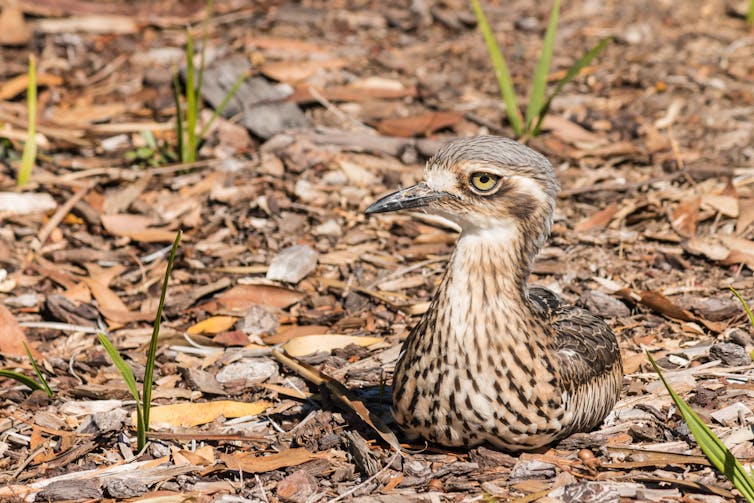
Habitat loss has played a role, but this species is highly susceptible to foxes. Foxes don’t much like the humidity of tropical and subtropical Australia. As a result, the curlew has been pushed out of the drier parts of its niche.
Niche contractions due to introduced species are likely to be widespread but little-studied.
If a species has a shrinking niche, it may change where conservationists direct their efforts. To give threatened species the best chance of survival, we might have to direct our energies to safeguarding them in their environmental refuges, safe from introduced predators or diseases.
When scientists assess how a species is going, we often look at changes in geographic range to gauge the level of risk to the species, from vulnerable through to extinct in the wild.
But this can have limitations. What our work has shown is that the survivable niche for species can shrink much more than its geographic range, reducing resilience to new environmental challenges. If frog species are forced out of upland areas, they may be at more risk from climate change, given higher elevations are likely to be most resilient to climate change.
There’s a silver lining here, though. Species can be more resilient than we assume in the face of new threats. Some populations may be hard hit, while others escape. Understanding why that is will be key to give our native species the best chance of surviving an uncertain future. ![]()
Geoffrey Heard, Research fellow, Australian National University and, The University of Queensland; Benjamin Scheele, Research Fellow in Ecology, Australian National University; Conrad Hoskin, Senior Lecturer, College of Science & Engineering, James Cook University; Jarrod Sopniewski, PhD student, The University of Western Australia, and Jodi Rowley, Curator, Amphibian & Reptile Conservation Biology, Australian Museum, UNSW Sydney
This article is republished from The Conversation under a Creative Commons license. Read the original article.
The humble spotted gum is a world class urban tree. Here’s why
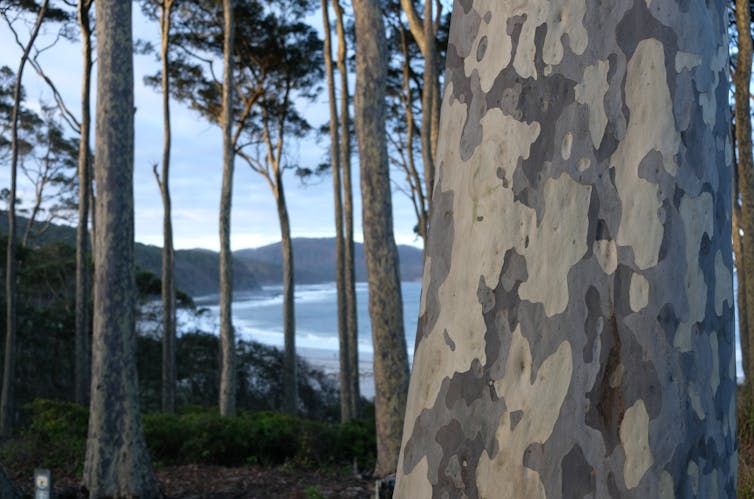
Most of us find it very difficult to identify different species of eucalypt. You often hear people say they all look the same.
Of course, they don’t. There are over 700 species of the iconic tree genus, and they can be very different in form, height, flowers and colours.
With all this variety, it’s nice to have a few species we can identify from metres away, just from looking at the colours and patterns of the bark on the trunk. The spotted gum is one of these instantly recognisable eucalypts.
You may well have seen a spotted gum growing happily on an urban street. These smooth-barked eucalypts have been planted up and down many suburban streets.
In fact, if the spotted gum has a secret superpower, it would be the ability to fit into our cities with a minimum of fuss. They’re big trees, and produce vast quantities of blossoms, attracting nectar-eaters like rainbow lorikeets in droves. They grow easily, grow straight and grow tall.
Why Are Spotted Gums Special?
Spotted gum used to be called Eucalyptus maculata. Now it’s officially Corymbia maculata after a name change about 25 years ago. Some people still debate this.
It was probably the trunk and bark of these trees which first caught your eye. These trees replace their bark seasonally, but not all at once. Instead, bits of the bark are shed and new bark grows at different rates. That leaves the famous spots on their trunks (maculatus is Latin for spotted).
Early in the growing season some of these spots can be a bright green before fading to tans and greys over the coming months. Many patterns can be stunningly beautiful.
These trees are loved by many. But there are sceptics. Some feel the trees can be a nuisance, and even dangerous because of the bark and branches they shed. There is some truth to it, as they can drop branches during droughts. Interestingly, these hardwood trees are actually considered fire resistant.
But there are very good reasons our city planners and councils turn to the spotted gum. Their wonderfully straight, light coloured and spotted trunks are impressive whether trees are planted singly, in avenues (meaning two rows of trees) or in boulevards (four rows of trees).
They often get to an impressive 30–45 metres in height. Old trees can get over 60m.
During profuse flowering, anthers (the pollen-bearing part of the stamen) shed from a single tree can cover the ground, paths, homes, roads and vehicles in a white snow-like frosting.
In nature, the spotted gum and close relatives, the lemon scented gum (C. citriodora) and large leafed spotted gum (C. henryii) grow along the east coast of Australia, from far eastern Victoria to southern Queensland. In New South Wales forests, you might be lucky enough to spot the pairing of spotted gums and native cycads (Macrozamia), ancient plants resembling palms.
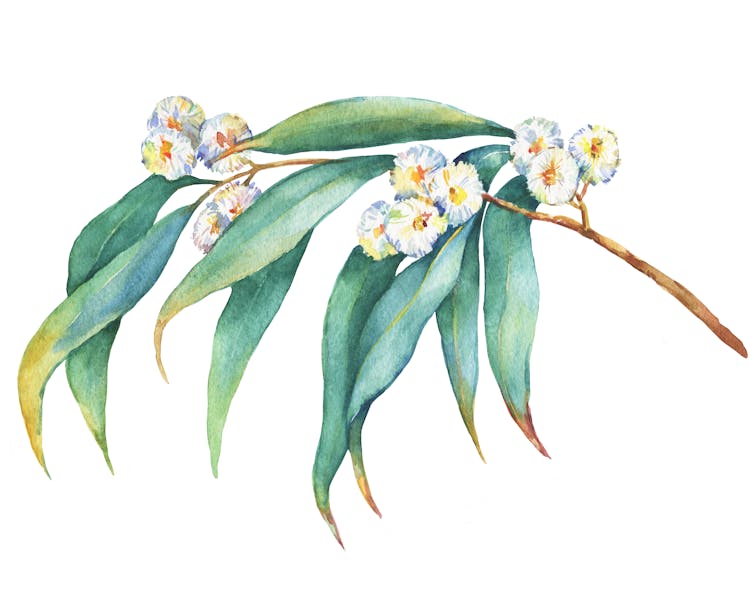
Spotted gums are quick growing and hardy, if a little frost-sensitive when young. They can tolerate periods of waterlogged soil. These traits make the species well suited to urban use, where disturbed and low-oxygen soils are common due to paving, compaction and waterlogging.
Urban trees have to be able to establish quickly and with relatively little care. They need to cope with environmental stresses and very poor quality urban soils. They need tall straight trunks so people and vehicles can pass under them, and so our cities keep their clear sight lines.
But we also want street trees to have broad, spreading canopies with a dense green foliage, to give shade, privacy and beauty.
As you can see, it’s a tough set of requirements. The spotted gum meets all of these. In fact, it has the potential to be one of the great urban tree species, not just in Australia but internationally.
Resilient Trees For The Future Climate
Spotted gums are tough. On urban streets in many parts of Australia, they will endure as the climate changes – possibly for decades or even centuries. They possess both lignotubers, the protective swelling at the base of the trunk, and epicormic buds, which lie dormant under the bark in readiness for fire and other stresses. These let the trees cope well with the abuses urban life can throw at them.
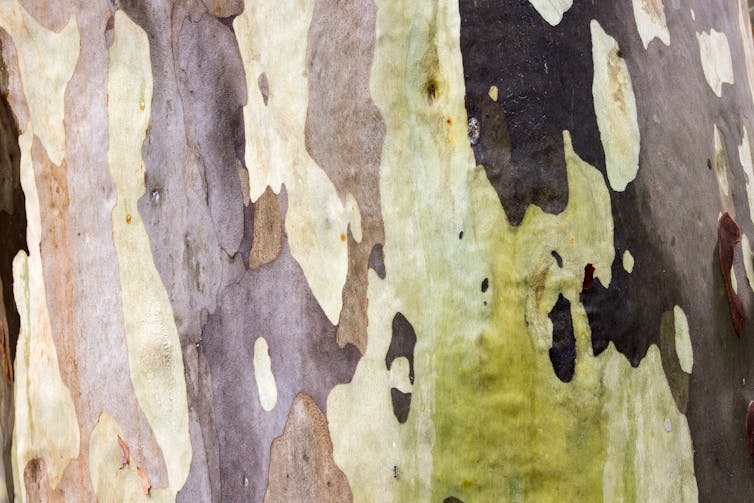
Horticulturalists have been working to make the tree even better suited to urban use. Careful selection has created spotted gum varieties geared towards dense, spreading canopies and with reduced risk of dropping branches.
But not all spotted gums you see are like this. These varieties were uncommon or didn’t exist 50 years ago, which means old urban trees might be more likely to shed limbs or have less attractive forms.
These trees are survivors. Near Batemans Bay in New South Wales lives Old Blotchy, the oldest known spotted gum. It’s estimated to be 500 years old.
Some urban trees are already 150 years old and in fine condition. Planting good quality spotted gums in a good position is a way to leave a lasting legacy.
As climate change intensifies, city planners are looking for resilient street trees able to provide cooling shade in a hotter climate. They could do a lot worse than choosing C. maculata.![]()
Gregory Moore, Senior Research Associate, School of Ecosystem and Forest Sciences, The University of Melbourne
This article is republished from The Conversation under a Creative Commons license. Read the original article.
Indigenous rangers are burning the desert the right way – to stop the wrong kind of intense fires from raging
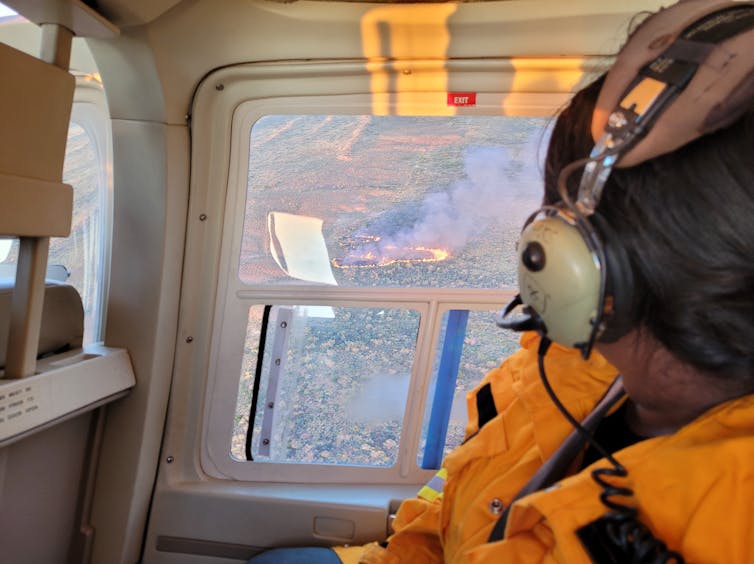
Even though it’s still winter, the fire season has already started in Australia’s arid centre. About half of the Tjoritja West MacDonnell National Park west of Alice Springs has burnt this year.
The spread of buffel grass (Cenchrus ciliaris) has been seen as a key factor. This invasive grass has been ranked the highest environmental threat to Indigenous cultures and communities because of the damage it can do to desert Country.
Widespread rains associated with the La Niña climate cycle trigger a boom in plant growth. When the dry times come again, plants and grasses dry out and become potential fuel for massive desert fires.
These fires often don’t get much notice because nearly all Australians live near the coast. But they can be huge. In 2011, over 400,000 square kilometres burnt – about half the size of New South Wales.
After three years of La Niña rains, we’re in a similar situation – or potentially worse. Fire authorities are warning up to 80% of the Northern Territory could burn this fire season.
That’s why dozens of Indigenous ranger groups across 12 Indigenous Protected Areas have been hard at work in an unprecedented collaboration, burning to reduce the fuel load before the summer’s heat. So far, they’ve burned 23,000 square kilometres across the Great Sandy, Tanami, Gibson and Great Victoria Deserts.
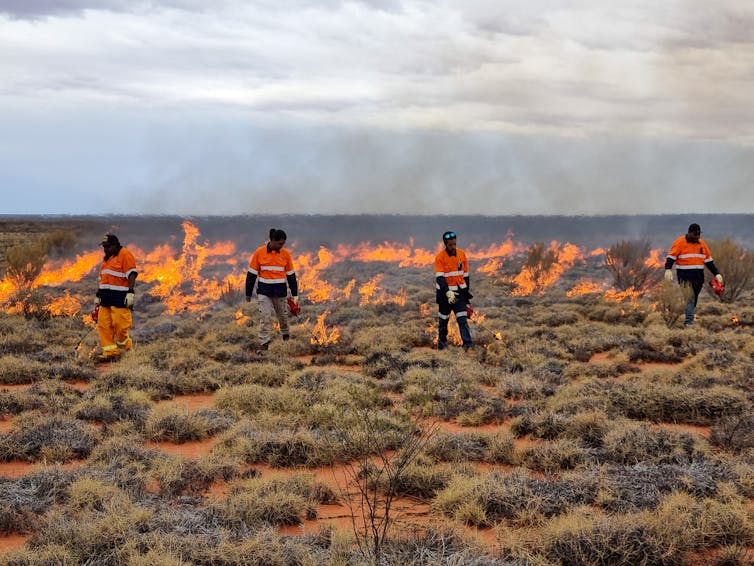
Burning The Arid Lands
Australia now has 82 Indigenous Protected Areas, covering over 87 million hectares of land. That’s half of the entire reserve of protected lands, and they’re growing fast as part of efforts to protect 30% of Australia’s lands and waters by 2030. These areas are managed by Indigenous groups – and fire is a vital part of management.
The goal is to protect against devastating summer bushfires, which are more destructive. Without Indigenous rangers expertly managing the deserts through landscape-scale fire management, these protected lands would be at risk of decline.
As Braeden Taylor, Karajarri Ranger Coordinator, says:
A big wildfire just destroys everything, it destroys Country. The first aim is to do a bit of ground burning and then aerial burning, that way we know everything is protected. Using the helicopter and plane, we can access Country that’s hard to get to in a vehicle. It might not have been burnt in a long time and we can break it up
It’s good working with other groups. Fires that start on their side might come over to us and fires on ours might go to them. Working together we protect each other, looking after neighbours.
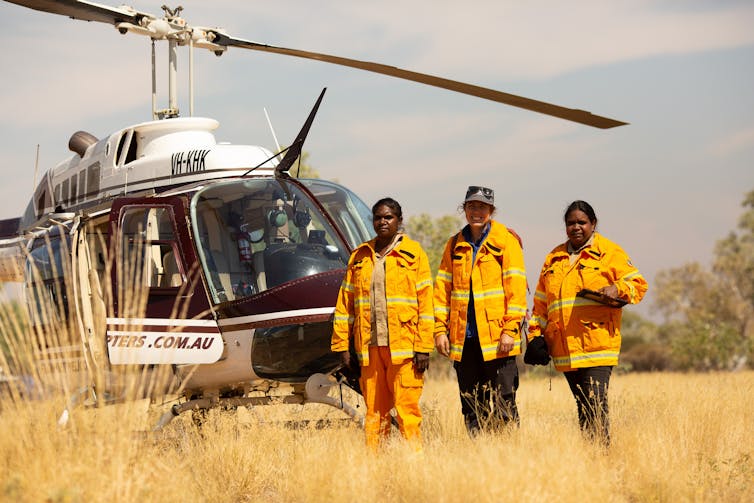
So how do the rangers cover such distances? These protected areas are extremely remote. There is often no or very limited road access. So rangers work from the sky – and, where possible, the ground. The ranger fire program relies on helicopters and incendiaries [fire starting devices]. This year, rangers have spent 448 hours in the air, covering 58,457 kilometres and dropping 299,059 incendiaries.
When the incendiaries hit the ground, they begin burning. Not every incendiary hits the right spot, so it takes time to guarantee a good burn is under way. These arid lands tend to have more grass than trees, so the fires move along the ground and don’t get too intense.
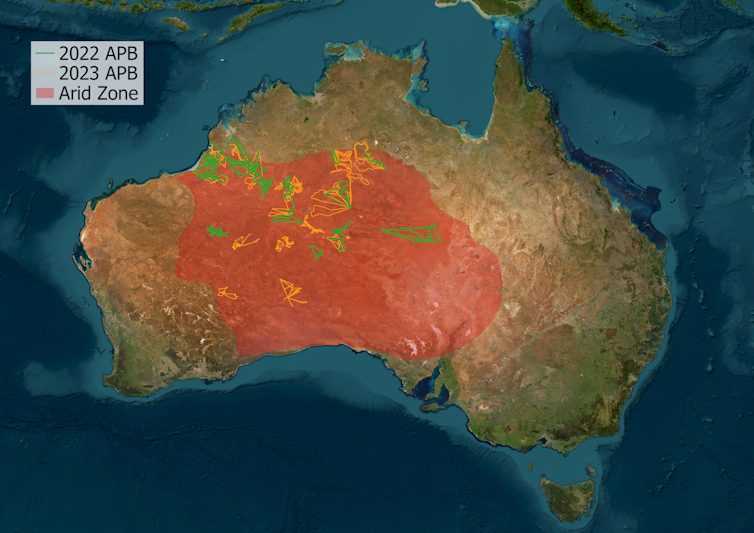
Rangers couple aerial burning with fine-scale ground burning using drip torches around sensitive areas. That’s to ensure protection of cultural sites and threatened species like the bilby, night parrot and great desert skink.
This is vitally important, given about 60% of desert mammal species have already gone extinct over the last 250 years, while many others have seen their range reduce. Changes to fire regimes are a major factor in these declines.
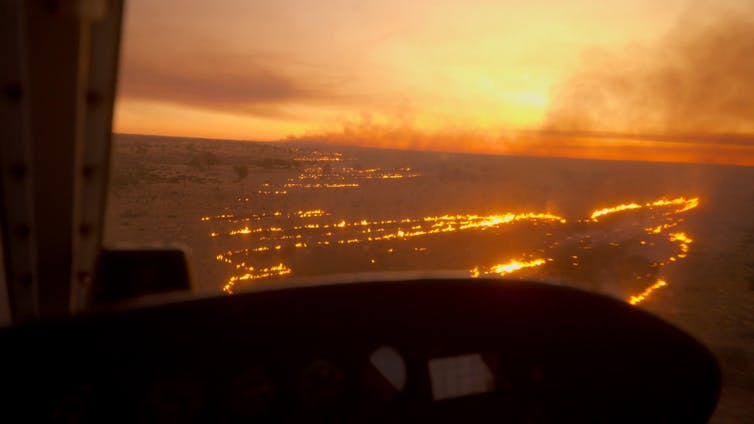
Fire Can Forge Community
These desert-spanning fire projects give Traditional Owners the ability to see remote Country, practice culture and transfer knowledge down the generations.
As Ronald Hunt, Ngaanyatjarra Ranger, says:
When we burn it cleans up all the spinifex grass and when the rain comes it all grows up fresh. It’s good for the animals, the bushfood and all. Its good using the helicopter, going places that it’s hard to get to. It’s good to work together with other groups, sharing stories and looking after the Country. They have their stories, and we have ours, and then we come together to work.
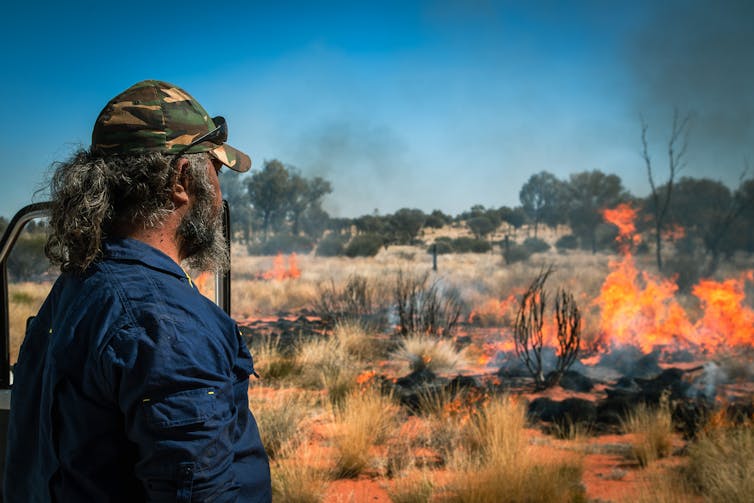
In recent years, there has been a surge of interest in Indigenous fire management – especially after the devastation of the Black Summer fires of 2019–2020.
The goal is to shift from wrong-way fire – where fuel builds up until large, damaging bushfires ignite – to right-way fire, culturally informed fire regimes led by Traditional Owners.
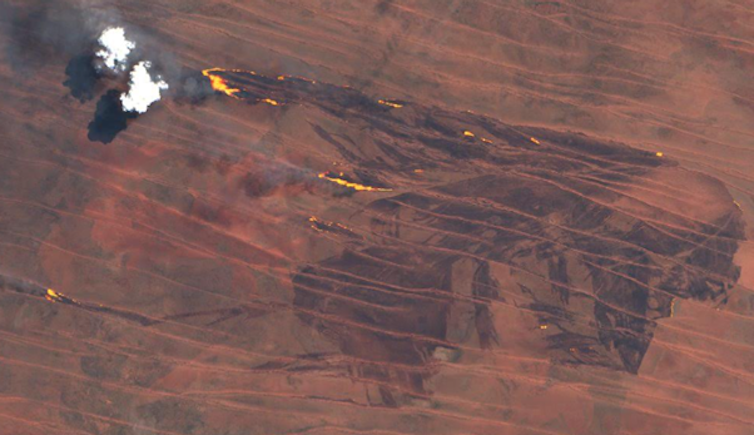
These fires are done regularly, with small fires of varying intensity producing a fine-scale mosaic of vegetation at different stages of recovery and maintaining long-unburned vegetation as safe harbours for wildlife and plants.
Recent research shows the return to these right-way fire regimes at a landscape scale is having a real effect. In areas where this is done, the desert landscape is returning to a complex, pre-colonisation pattern of mosaic burns.
These large-scale efforts should make Country healthier and bring reprieve from dangerous fire. ![]()
Rohan Fisher, Information Technology for Development Researcher, Charles Darwin University and Boyd Elston, Co-Chairperson of the Indigenous Desert Alliance and a Regional Land Management Coordinator at the Central Land Council, Indigenous Knowledge
This article is republished from The Conversation under a Creative Commons license. Read the original article.
Labor’s new Murray-Darling Basin Plan deal entrenches water injustice for First Nations
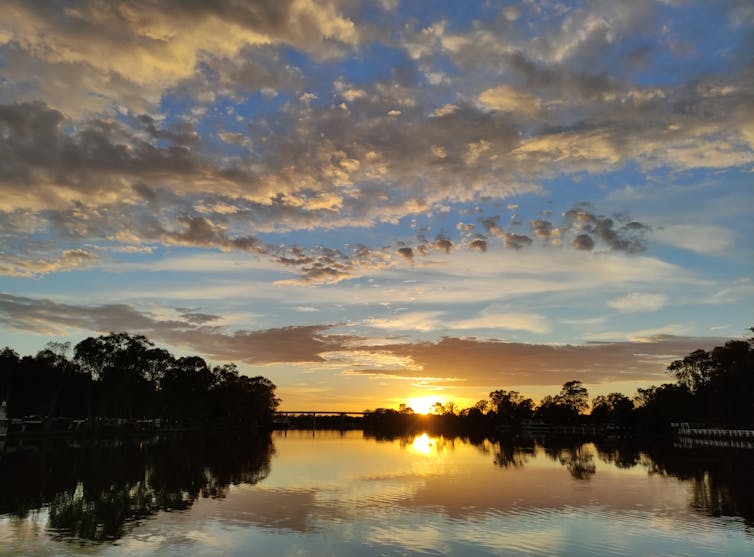
The federal government has struck a new deal with most of the states in the nation’s largest river system. The agreement, announced last week, extends the $13 billion 2012 Murray-Darling Basin Plan to rebalance water allocated to the environment, irrigators and other uses.
Environment and Water Minister Tanya Plibersek said the government has:
negotiated a way to ensure there is secure and reliable water for communities, agriculture, industry, First Nations and the environment.
But there is no mention of water for First Nations in the agreement. This follows a history of Indigenous peoples being shortchanged by Murray-Darling Basin planning. Yet again, this latest deal ignores First Nations’ interests, despite millennia of custodianship.
Shortchanged In Reforms
The Murray-Darling Basin Plan was agreed in 2012 to try and improve the health of the largest and most complex river system in Australia.
It was a historic compromise that sought to address the often conflicting demands of states, irrigators and the environment. But the plan overlooked First Nations rights to own, manage and control water on Country. The plan’s current provisions include only weak requirements for governments to “have regard to” First Nations values and uses.
In 2018 the Turnbull government put $40 million on the table for First Nations. This deal offered a glimmer of hope as it saw the then water minister David Littleproud and Labor water spokesperson Tony Burke commit the funds to support Basin First Nations’ investment in cultural and economic water entitlements.
But despite Labor renewing the commitment as part of its 2022 election platform, the money remains with government and has not been spent. Last week, Plibersek said that when Labor came into government there was “very little work done about how this might happen”, and that “it is proceeding”.
A commitment of $40 million is also a paltry amount in the context of the wider river basin. Water research firm Aither’s 2023 Water Market Report estimates the total value of water entitlements in the southern basin as $32.3 billion, so the government commitment of $40 million is only 0.1% of the total.
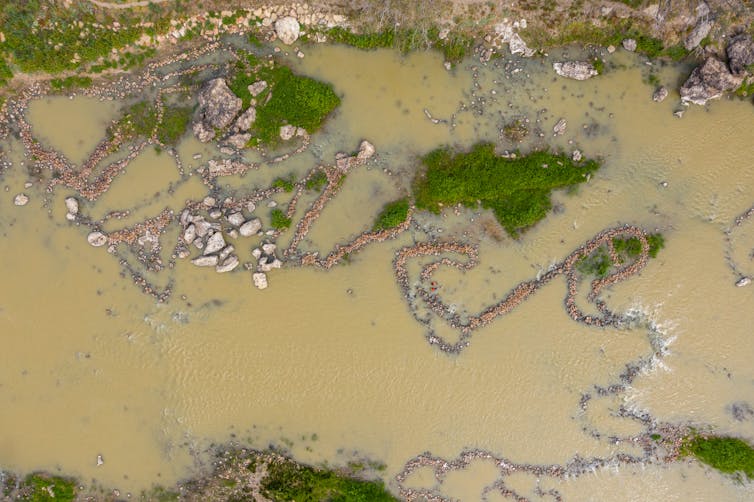
Shortchanged In The Market
First Nations organisations have maintained pressure on the federal government and attempted to hold successive ministers to account for unnecessary delays in delivering the funding.
These delays mean the committed funds are decreasing in value.
When Littleproud initially committed the $40 million, the money was equally split between the northern and southern regions of the basin. Aither analysis conducted for the Murray Lower Darling Rivers Indigenous Nations shows at today’s prices, the $20 million for Nations in the southern basin can only buy two-thirds of the water that could have been acquired in 2018. In 2023, buying the same volume of water that could have been purchased in 2018 will cost almost $11 million more.
A Fair Go: Investment And Reform Needed
Limited government investment from other sources has supported some Basin First Nations to develop plans that could guide water use, to nourish their Country, maintain culture, and generate sustainable livelihoods.
However, realising these opportunities means they need water. In an overallocated river system, amid water scarcity and rising prices, this requires genuine political will coupled with necessary reforms and adequate funding.
As another drought looms, and water entitlement prices remain high, more than 40 Basin Nations must share very limited funding that can only acquire a tiny – and diminishing – fraction of their water needs. These deals demonstrate sustained and systemic bipartisan political indifference to First Nations’ inherent rights.
If Plibersek is sincere about delivering “secure and reliable water” for First Nations, she must listen to First Nations people, and actually deliver tangible outcomes. Governments must urgently commit adequate funding for First Nations in the basin to secure water that meets our needs, before future generations are priced out of the market forever.
Funding for cultural flows must be coupled with reform to transform the foundations of water governance and implement the Echuca Declaration. This declaration establishes cultural flows as the “inherent rights” of all First Nations in the Basin.
As a start, the Water Act 2007 needs to be strengthened to enshrine Basin Nations’ authority and ensure their voices are heard.
As the terms of the basin plan implementation are being reassessed and renegotiated, governments have an opportunity not only to listen, but also to deal First Nations in.![]()
Grant Rigney, , Indigenous Knowledge; Erin O'Donnell, Senior Lecturer, Melbourne Law School, The University of Melbourne; Fred Hooper, Indigenous knowledge holder, Indigenous Knowledge, and Lana D. Hartwig, Adjunct Research Fellow, Australian Rivers Institute, Griffith University
This article is republished from The Conversation under a Creative Commons license. Read the original article.
Climate change threatens the rights of children. The UN just outlined the obligations states have to protect them
Noam Peleg, UNSW SydneyClimate change is not just an environmental crisis, it’s a human rights crisis. And the humans to be most affected by climate catastrophe are the youngest ones: children.
We have seen children directly impacted in the Northern Hemisphere’s unprecedented heatwaves this year. In Greece, 1,200 children were evacuated when a wildfire threatened their holiday camps.
In the United States, children were swept away by floodwaters in Kentucky after torrential rain, while an extreme heatwave swamped the West Coast. In Australia, this summer is expected to be hot, dry and dangerous but that’s nothing compared to what is to come.
So what are the responsibilities of governments to reduce the harm climate change will wreak on the lives of children?
A statement from the United Nations (UN) released today seeks to clarify this. It clearly stipulates why and how the rights of children are compromised by climate change – including the very basic right to life. It also details the steps necessary to mitigate this catastrophe.
A Practical Guide To Help Children
The statement comes from a UN body of 18 experts that monitors how national governments are implementing the UN Convention on the Rights of the Child. This is an international agreement on a broad range of human rights as they relate to children, including their health, education, development, best interests and living standards.
From time to time, UN human rights committees publish a new interpretation of the treaty they oversee. These are known as “general comments”.
General comments are significant because they provide authoritative guidance to the governments of the 196 countries that have ratified the convention, with Australia being one of them. They also provide a globally agreed standard against which governments and businesses can be assessed.
This new comment follows nearly two years of consultation with more than 7,000 children from 103 countries, as well as governments and relevant experts.
It’s not merely an aspirational statement. Rather, it’s a practical “how-to” guide to action. This document will help children, young people and their advocates hold governments and others accountable for their decisions.
So What Does The Document Say?
The general comment says governments have obligations to respect, protect and fulfil children’s rights. It states the “adverse effects of climate change” on the enjoyment of children’s rights “give rise to obligations of states to take actions to protect against those effects”. It adds the committee overseeing the convention aims to:
i) Emphasise the urgent need to address the adverse effects of environmental harm and climate change on children;
ii) Promote a holistic understanding of children’s rights as they apply to environmental protection;
iii) Clarify the obligations of States parties to the Convention and provide authoritative guidance on legislative, administrative and other appropriate measures to be undertaken with respect to environmental issues, with a special focus on climate change.
The general comment also identifies children as agents in their own lives. By extension, this means children have a right to participate in the drafting of environmental policies or laws that will affect them.
Here are the committee’s points that are most relevant to Australia.
1. Best Interests Of The Child
A key principle of the treaty is the best interests of the child should be a primary consideration when making decisions on their behalf. These decisions include laws, regulations, budgets and international agreements. The general comment expands on this, saying:
the best interests of the child shall be a primary consideration in the adoption and implementation of environmental decisions affecting children.
It says this process should take into account “the specific circumstances that make children uniquely vulnerable in the environmental context”.
This “best interests” approach stands in stark contrast to that taken by the full bench of the Federal Court in Australia. In 2022, the court accepted the federal government’s argument that it has no duty of care for children, and that the best interests principle is not something it ought to consider when making decisions about the environment.
2. Protecting Indigenous Children
Indigenous children and their communities are particularly vulnerable to climate change.
For example, a recent study found Indigenous communities in New South Wales were disproportionately exposed to a range of climate extremes such as heat, drought and flooding. They also experienced higher rates of climate-sensitive health conditions and socioeconomic disadvantages.
The comment says states are obliged to ensure the right to life, survival and development of Indigenous children. They are also expected to “engage with Indigenous children and their families in responding to climate change by integrating, as appropriate, Indigenous cultures and knowledge in mitigation and adaptation measures”.
In Australia, it means the state, territory and federal governments have the duty to listen to Indigenous communities – especially to their younger members – and to take their perspective into account when crafting any policy or law that might have an impact on their livelihood and culture.
3. Actions Of The Business Sector
The general comment says governments should require businesses to conduct “due diligence” to assess how their current and future actions might affect the climate and the rights of children.
Where the impacts of a business cross national boundaries, governments are expected to ensure businesses operate at “environmental standards aimed at protecting children’s rights from climate-related harm”.
The comment also expects governments to encourage investment in and use of zero-carbon technologies, particularly when the assets are publicly owned or funded. Governments should also protect the rights of children when implementing tax regimes and procuring goods and services from the private sector.
Facing Up To The Challenge
The general comment makes it clear states should no longer ignore the impacts of the climate crisis on children and future generations because they have legal duties to rectify it.
The UN committee articulates the responsibilities of states and details how children’s rights should be protected by all levels of government. Despite the fact the Convention on the Rights of the Child was adopted decades before environmental rights became a topic of discussion, the new general comment is a good reference for everyone from on-the-ground, grassroots local advocacy groups to international non-government organisations and UN organisations like UNICEF.
In this bold new statement, the committee has pushed the interpretation of the convention almost to the maximum, and like other international treaties, the real test will be in its implementation. ![]()
Noam Peleg, Senior Lecturer, Faculty of Law and Justice; Associate, the Australian Human Rights Institute, UNSW Sydney
This article is republished from The Conversation under a Creative Commons license. Read the original article.
Unsexy but vital: why warnings over grid reliability are really about building more transmission lines
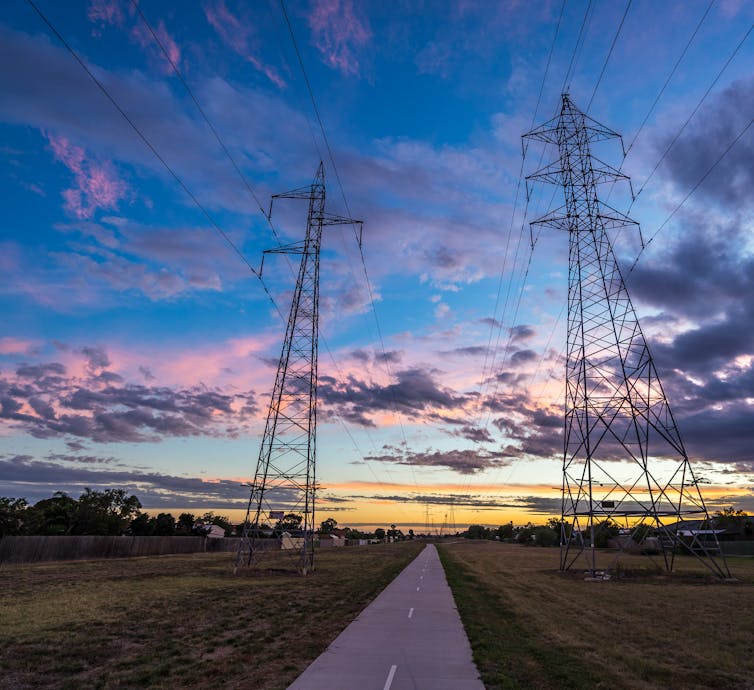
“To ensure Australian consumers continue to have access to reliable electricity supplies, it’s critical that planned investments in transmission, generation and storage projects are urgently delivered.”
This week, we heard one of the strongest warnings yet from Daniel Westerman, head of the Australian Energy Market Operator (AEMO).
So far, media coverage has framed his comments as a warning about the anticipated angry El Niño summer, which is likely to drive energy-intensive aircon use even as our coal plants become less and less reliable.
But this isn’t what the warning is really about. It’s about transmission lines and our sluggish pace of change. Australia’s emissions are falling much more slowly than we’d like to think, if we omit the sometimes controversial land use sector. We’re down just 1.6% below 2005 levels.
Solar and wind farm investment has slowed markedly. This is because we don’t have the right grid – yet. Building the transmission infrastructure needed to slash emissions by 2030 means acting much faster than government is used to.
These aren’t ordinary times. We can’t act as if they are.
The Grid Will Withstand Summer – But Bigger Threats Lie Ahead
It’s quite likely the grid will withstand this summer, as long as maintenance is done to keep the old coal clunkers running and to ensure gas peaking plants are ready for times of highest demand. We also have the reserve system, whereby big energy users can be paid not to consume electricity during the hottest days.
There’s no shortage of solar and wind resources in Australia. And there’s no shortage of solar and wind farm projects waiting to be built. But the great renewable build is stalling – not because there’s no demand for cheap power, but because regulatory approvals are too slow and there’s no way to get the power to the cities and heavy industries.
The real problem is we’re not moving fast enough to build the unsexy but vital infrastructure we need: new transmission lines. The old grid was built around big power stations, from hydro in the Snowy Mountains to coal plants near coal mines, with transmission lines connecting them to cities.
But renewable-rich zones are often in different places. What’s more, shifting to a grid full of renewables means building more interconnectors between states, so on a big day for Victoria’s mooted offshore wind farms, for instance, the surplus power can be sent to South Australia, New South Wales and Queensland too.
What’s the delay? After all, we were able to build transmission lines when the current grid was taking shape.
A big part of the issue is community pushback and process. Local farmers and communities are resisting many of the planned new transmission lines.
If we had the luxury of time, it might be possible to get strong community support. But we don’t. Our coal plants are on the way out and no one is going to build a new one. The barrier between us and a clean energy future is getting transmission and storage built, fast.
Labor went to the 2022 election with a $20 billion plan to build the transmission lines envisaged by AEMO in its latest integrated system plan.
Westerman last year listed the five most urgent transmission links:
HumeLink to bring Snowy 2.0 pumped hydro power to the grid
the Sydney Ring, designed to improve connections between New South Wales’ four largest population centres, Sydney, the Central Coast, Newcastle and Wollongong
transmission links from the New England renewable energy zone
the Marinus link to better connect Tasmania’s wealth of hydro with the mainland
the KerangLink interconnector between Victoria and New South Wales.
Most of these projects have had their own issues, ranging from lengthy approval processes, to heated community calls to put lines underground, to cost blowouts.
One problem is the range of government agencies involved. There’s no single body responsible for making these nation-building projects happen as quickly and happily as possible.
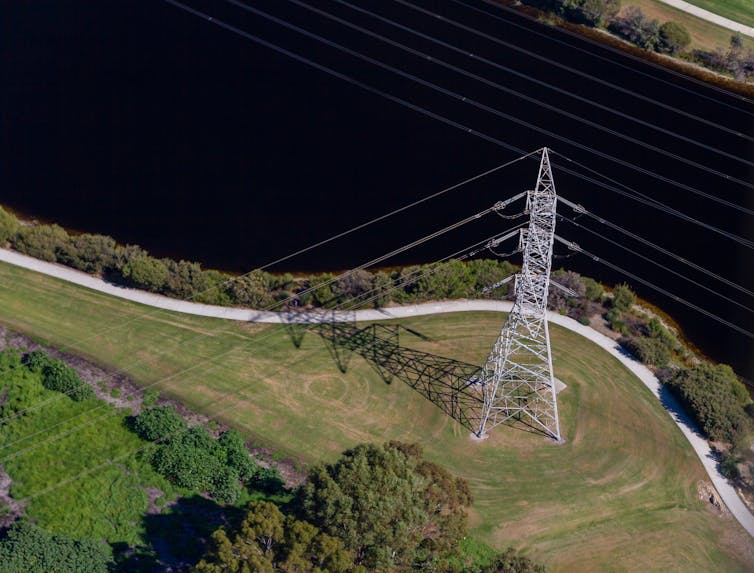
How Can We Speed Up These Vital Projects?
Here are a few ideas:
compensate affected landholders. Farmers who agree to host transmission towers get paid. To smooth the build, governments could bite the bullet and expand whom they compensate. Or, as with many other major infrastructure projects, as a last resort, they could compulsorily acquire the easements
give one agency the responsibility and authority for making these essential projects happen
ramp up regional training centres to produce the skilled electrical workers we’ll need.
We’ve come a fair way down the road in our efforts to wean ourselves off coal, and, eventually, gas-fired electricity. But it could all be for nought if we don’t get transmission sorted as soon as possible. ![]()
Tony Wood, Program Director, Energy, Grattan Institute
This article is republished from The Conversation under a Creative Commons license. Read the original article.
Flood protection based on historical records is flawed – we need a risk model fit for climate change
Xinyu Fu, University of Waikato; Iain White, University of Waikato; Rob Bell, University of Waikato, and Silvia Serrao-Neumann, University of WaikatoDespite countries pouring billions of dollars into “protecting” communities, flood-related disasters are becoming more frequent and are projected to become even more severe as the climate crisis worsens.
In fact, many areas that flooded during recent extreme weather events, from Auckland to Henan in China, were deemed to be relatively safe. This should raise an obvious question: to what extent is our existing approach fit for purpose in a changing climate?
Traditionally, managing flooding has relied heavily on building higher levees or increasing the capacity of drainage systems. But this can be a mixed blessing. While they contain water most of the time, when levees or drains exceed their original design capacity, we experience damaging floods.
These technical solutions have tended to operate on a flawed assumption that future flooding can be reliably predicted based on decades of historical flood data. They also create the “levee effect” – a false sense of security that encourages development in still risk-prone areas.
As climate change brings unpredictable rainfall patterns and higher intensities, these historic design assumptions are falling well short of the realities. And it means there remains a “residual risk”, even when infrastructure improvements have been made or planned for.
Red Tape And Risk
We can use the analogy of wearing a seat-belt to understand residual risk. The belt will reduce harm in case of an accident, but it does not mean you are entirely protected from injury.
Now imagine road conditions and weather are gradually worsening, and traffic volumes increasing. Some might look at the new risk and decide not to drive, but for those already on the road it is too late.
Most countries are still managing floods just like this: sometimes building higher levees or installing bigger pipes. But development often occurs incrementally, without the strategic investment needed or the room to safely store excess water volumes in urban areas when failure occurs.
Housing development is needed, but too often current (let alone future) flood risk is not adequately considered. Planning controls, or additional infrastructure costs, are routinely referred to as “red tape” that raises costs. As a result, recovery costs are ongoing and residual risk gradually rises.
Weather-related disasters in 2023, including Cyclone Gabrielle in New Zealand and wildfires in the northern hemisphere, have led to a new focus on understanding how residual risk is managed. But whether it is even acknowledged or incorporated in planning policy varies from country to country.
National Strategy Missing
Our research team from the University of Waikato recently undertook a survey with flood risk practitioners in New Zealand to shed some light on this.
New Zealand has little in the way of national-level guidance on managing flood risk. Despite this, survey responses suggest flood risk professionals are aware of the issue. They agree residual flood risk is increasing, mainly due to climate change and ongoing development in flood-prone areas currently designated as “protected”.
They also agree the current practice of flood risk management needs improving. But there are several barriers, with the lack of a clear national directive on managing flood risk being the most notable in our survey.
Several respondents noted that changing risk management practice is difficult, given the existing institutional framework. This includes the “build more levees” approach to flood planning.
Local governments also vary in their capacity and resources. Many small councils lack quality flood risk information, such as the likely impact of climate change, which is critical for making wise land-use decisions.
As a result, housing and other developments are continuing in risky places. And to keep development costs down, infrastructure is not being systematically upgraded.
Planning For Residual Risk
We expect the New Zealand experience reflects similar trends elsewhere. Practitioners are aware of the growing threat of residual risk and would like more power to manage it. But there is a lack of urgency and resources to upgrade infrastructure. And there is political pressure to enable more housing and reduce red tape.
If these patterns persist, not only will the impacts from future floods become more frequent and expensive, but the insurance sector will retreat further from offering flood policies.
This will eventually leave central governments as de facto insurers-of-last-resort for flooding events. And they will be picking up an increasingly big bill, as already evidenced by the US$20.5 billion deficit faced by the United States National Flood Insurance Program.
Internationally and in New Zealand, attention is shifting to the need to build “sponge cities” or create more “room for water” in flood risk management. But we argue that acknowledging and managing the growing residual risk from climate change is missing from the debate.
A better-informed approach would see stronger guidelines against ill-advised development in flood-prone areas unless the infrastructure investment reduces that residual risk. Development on floodplains can still happen. But land use and investment must account for an uncertain future and lower the overall risk profile, rather than increase it.
The reality of more frequent flooding demands a multi-faceted response that makes cities, towns and rural areas more resilient – and prepared for inevitable infrastructure failure. Residual risk needs to be central to planning if we are to avoid an endless cycle of mopping up, rebuilding and compensating for financial loss.![]()
Xinyu Fu, Senior Lecturer in Environmental Planning, University of Waikato; Iain White, Professor of Environmental Planning, University of Waikato; Rob Bell, Teaching Fellow, Environmental Planning Programme, University of Waikato, and Silvia Serrao-Neumann, Associate Professor of Environmental Planning, University of Waikato
This article is republished from The Conversation under a Creative Commons license. Read the original article.
‘Eco-friendly’ straws contain potentially toxic chemicals – posing a threat to people and wildlife

Drinking straws that are made from materials like paper and bamboo are often promoted as more eco-friendly than their plastic counterparts. However, a new study has found that these supposedly sustainable straws contain potentially toxic chemicals called polyfluoroalkyl and perfluoroalkyl substances (PFAS).
These substances, commonly known as “forever chemicals”, are a large group of over 4,000 synthetic chemicals that are used in a wide range of products due to their water- and fat-repellent properties. They can be found in everyday items such as non-stick cooking pans and fast-food packaging.
PFAS can linger in the environment for thousands of years, and exposure to certain levels of PFAS has been linked to ill health both in people and in animals.
The study, conducted by researchers in Belgium, analysed commercially available drinking straws of various types and recorded PFAS concentrations in 39 separate brands. PFAS were discovered in almost all of the paper and bamboo straws tested. They were detected in plastic and glass straws too, but at a lower frequency.
Perfluorooctanoic acid was the most common PFAS detected in the straws. The manufacture of perfluorooctanoic acid has been banned in the European Union since 2020 on safety grounds. However, it can be found in old or recycled consumer products and persists in the environment.
The presence of PFAS in plant-based straws could, at least in part, be due to factors like unintentional contamination from plants grown in soil polluted by PFAS and from the use of recycled paper containing PFAS in the production of straws.

Detecting Forever Chemicals
The researchers used two methods to detect PFAS in the straws. First, they measured whether 29 types of common PFAS were present and quantified their amounts in the straws using a sensitive method called liquid chromatography with tandem mass spectrometry. They found 16 of the 29 target PFAS at detectable concentrations.
A screening approach was then used to detect any other PFAS compounds in the straws. This revealed the presence of two additional PFAS compounds – trifluoroacetic acid (TFA) and trifluoromethanesulfonic acid (TFMS).
TFA occurred in five of the eight paper-based straw brands tested and TFMS in six of them. Both compounds were measured in one bamboo straw.
Given TFA’s limited industrial applications, the researchers suggest that its presence in straws potentially stems from the breakdown of halogenated hydrocarbons. These hydrocarbons are commonly used as industrial solvents, intermediates in synthesis and even as dry cleaning agents.
In contrast, the sources of the TFMS in straws are uncertain. However, they are known to be associated with sites where firefighting foams have been used.
Should We Be Concerned?
People could be directly exposed to PFAS in straws as they leach into our drinks during use. Discarded or recycled straws could also result in indirect exposure through contaminated soils, water, plants and other consumer products derived from recycled materials.
This is concerning. PFAS exposure poses considerable health risks to people, wildlife and the environment.
Research indicates that pregnant women who are exposed to these substances may experience reduced fertility and heightened blood pressure. Their children could face developmental effects like low birth weight, early puberty and even an increased risk of some cancers.
PFAS exposure has even been shown to compromise the immune system’s ability to fight infections. In 2020, research from Denmark found that the severity of COVID infections seemed to be aggravated by exposure to some PFAS.
Exposure to PFAS has also been linked to a reduced reproductive ability in birds, and the development of tumours and disrupted immune and kidney function in other species of animal.
For example, research on the Cape Fear river in North Carolina in 2022 revealed that all 75 American alligators (a protected species) tested had PFAS in their blood serum. The levels of PFAS in the alligators’ serum were associated with disrupted immune functions and autoimmune-type diseases.
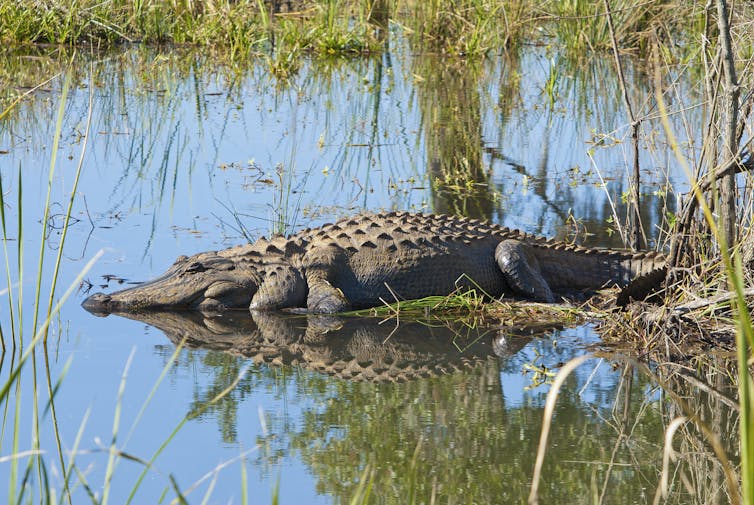
These chemicals are now so widespread in the environment that it is almost impossible for humans and wildlife to avoid exposure to them. Exposure to PFAS can occur in various ways, including breathing in contaminated air, to consuming tainted food and water, and even through skin contact with dust and particles.
However, using stainless steel straws might provide some protection from additional PFAS exposure. The Belgian study recorded no detectable amount of PFAS in this type of straw.
But it’s important to note that while stainless steel straws might reduce PFAS exposure, they could still expose people to other harmful substances like heavy metals. Some of these metals, including chromium and nickel, have been linked with serious health issues affecting the heart, lungs, digestive system, kidneys and liver.
Perhaps the best thing we can do for now is to avoid using straws altogether, where possible.
Don’t have time to read about climate change as much as you’d like?
Get a weekly roundup in your inbox instead. Every Wednesday, The Conversation’s environment editor writes Imagine, a short email that goes a little deeper into just one climate issue. Join the 20,000+ readers who’ve subscribed so far.![]()
Ovokeroye Abafe, Marie Curie Individual Fellow, University of Birmingham
This article is republished from The Conversation under a Creative Commons license. Read the original article.
Why the UK government is relaxing rules for river pollution

The UK government has announced plans to enable the delivery of 100,000 new homes by 2030 that are currently being held up by a controversial EU law designed to protect water bodies from pollution.
This move will undoubtedly benefit the housing sector, delivering an estimated £18 billion to the economy and also helping the government meet its housing targets. But will it lead to further water pollution at a time when just 36% of the UK’s surface water bodies are in “good” or better condition?
Since 2019, all new housing developments in the UK have been required by EU law to demonstrate that they would not add additional nutrients like nitrogen and phosphorus to water bodies as part of their planning applications.
Wastewater from new homes, as well as run-off from construction sites, can cause nutrients to seep into nearby waterways. This can lead to eutrophication – a process where excessive algae growth degrades water quality.
Developers must calculate how much nutrient pollution the planned accommodation would create and demonstrate how that pollution would be treated or offset. If developers cannot prove that new housing projects are going to be nutrient neutral, planning application is refused.
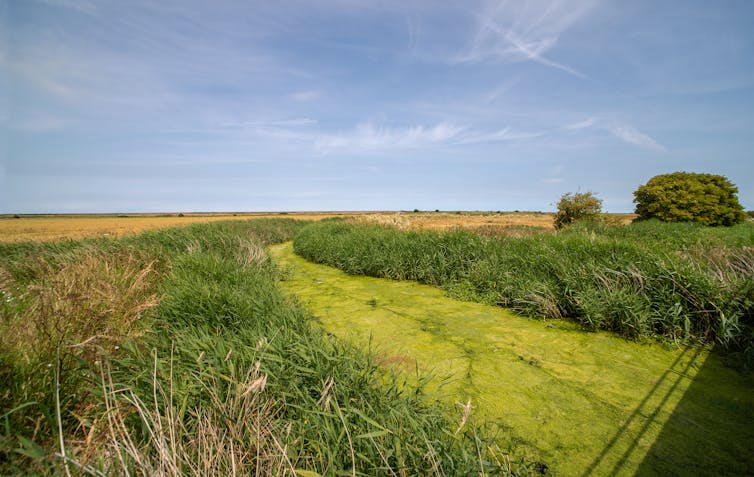
The main response has been “farmland offsetting” – a scheme where developers pay farmers for parts of their land, which are then rewilded to prevent future farming. The savings made by preventing future nutrient pollution on that farmland would offset the nutrients leaching into the environment from the new housing projects.
Natural England’s nutrient neutrality programme has expanded access to these offsetting schemes in recent years. Nonetheless, not all developers have access to offsetting schemes in their area. Thousands of applications – including many already in the system – have been suspended or rejected as a result.
To re-start many of those stalled applications, the government is proposing an amendment to the law, removing the requirement for developers to prove nutrient neutrality.
The government will instead take responsibility for nutrient offsetting itself – mainly by doubling funding for Natural England’s offsetting scheme. This would enable houses currently stuck in the planning system to be granted permission and begin building.
The government announced that it will also take additional measures to “tackle nutrient pollution at source” by upgrading wastewater treatment works and reducing nutrient pollution from farming.
The implementation of the nutrient neutrality guidelines, and the accompanying burden on developers, has attracted plenty of criticism. Hence, the change in approach in itself is not necessarily a bad thing. However, there is justified concern that the new plans may be less effective if not implemented properly.
Taking Control
At a glance, the government’s proposal certainly seems a short-term reaction to a political issue. The government is falling well behind its own housing targets and removing nutrient neutrality from planning applications will release the current deadlock.
But it could also have the potential to do genuine good. By offsetting nutrient pollution itself, the government could deliver more sensible schemes overall than the piecemeal approach delivered by thousands of small planning applications submitted at different times.
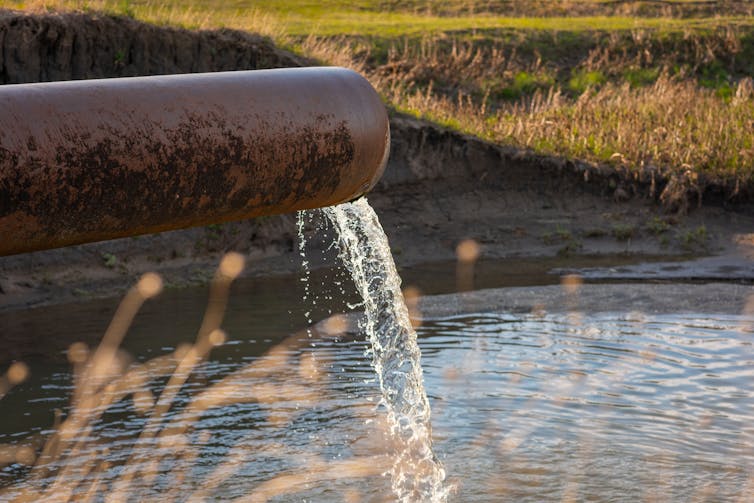
However, the long-term success of the offsetting schemes in genuinely achieving nutrient neutrality has been questioned. The calculations are based on a small scientific base. And even if these calculations are correct, offsetting schemes replace pollution that is spread across farmlands with pollution concentrated at the end of a wastewater pipe.
Questioning The New Approach
Any potential benefits of the new approach will also rely on it being delivered properly. There are already concerns that may not happen.
A lot of the new environmental measures mentioned in the government’s initial press release are already taking place. For instance, upgrading wastewater treatment works for nutrient removal was made a legal duty in 2022 and is already being planned and implemented by all water companies.
Another – looking at more sustainable drainage solutions – is part of existing planning policy.
Three of the eight actions identified by the government also target farming practices. Agriculture does cause more nutrient pollution than housing – in the Solent region of southern England the Environment Agency estimates that 50% of nutrient pollution can be attributed to agriculture and just 10% to wastewater releases.
However, the purpose of nutrient neutrality was to ensure housing developments dealt with their own pollution so they weren’t adding to the problems already caused by agriculture. Nutrient pollution caused by farming practices is already being addressed through initiatives such as catchment-sensitive farming – a scheme of training and funding to help farmers reduce nutrient pollution.

By taking nutrient neutrality off the “front lines” of the planning process, the concern is that the outcome – away from the same level of scrutiny and urgency – may not be as effective.
Building new homes is important. And it’s also true that new housing developments are not the largest contributor of nutrient pollution in the UK. So a more centralised plan to deal with nutrient pollution has potential benefits, if undertaken seriously.
However, the short-term benefits of building more homes must not overshadow the longer-term commitments the government will need to make in order to properly address the issue of nutrient pollution.![]()
Peter Cruddas, Senior Lecturer in Environmental Engineering, University of Portsmouth
This article is republished from The Conversation under a Creative Commons license. Read the original article.
What social change movements can learn from fly fishing: The value of a care-focused message
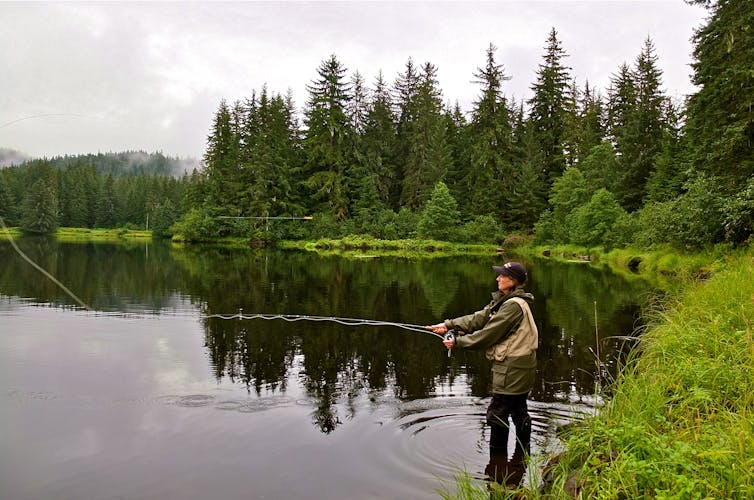
Summer and fall are prime times for getting outdoors across the U.S. According to an annual survey produced by the outdoor industry, 55% of Americans age 6 and up participated in some kind of outdoor recreation in 2022, and that number is on the rise.
However, the activities they choose are shifting. Over the past century, participation has declined in some activities, such as hunting, and increased in others, like bird-watching.
These shifts reflect many factors, including demographic trends and urbanization. But outdoor activities also have their own cultures, which can powerfully affect how participants think about nature.
As scholars who think about organizational theory, management and entrepreneurship, we are interested in understanding effective ways to promote social change. In a recent study, we analyzed the work of the nonprofit group Trout Unlimited, which centers on protecting rivers and streams across the U.S. that harbor wild and native trout and salmon.
We found that since its founding in 1959, Trout Unlimited has pursued a unique type of social change. Historically, people fished to obtain food – but Trout Unlimited has reframed the sport as a vehicle for environmental conservation. It did this by gradually shifting members from catch and keep practices to catch and release, with fish carefully returned to the water. In our view, this strategy offers a powerful example of energizing social change through care, rather than disruptive strategies that emphasize power, anger and fearmongering.
A Sport That Inspires Devotion
Fishing is very popular in the U.S.: As of 2016, more then 35 million Americans fished, mainly in fresh water. Trout Unlimited was founded in 1959 on the banks of Michigan’s Au Sable River with the aim of building a strong conservation ethic among anglers. Today, the group has more than 300,000 members spanning hundreds of local chapters across the U.S.
Many Trout Unlimited members prefer fly fishing, a technique that uses a rod, reel, specialized weighted fishing line and artificial flies designed to mimic trout’s natural food sources. Trout generally thrive in beautiful, fast-flowing, cold-water streams and rivers; to catch them, fly fishers repeatedly cast a line so that their lure moves like a flying insect landing and floating on the water. It’s a sport that combines deep knowledge of a specific location with time-honored techniques.
In the 1653 classic “The Compleat Angler,” English writer Izaak Walton called fly fishing “an art worthy the knowledge and practice of a wise man.” Norman Maclean’s 1976 book “A River Runs Through It,” which recounts the author’s childhood experiences fishing Montana’s Big Blackfoot River, declares, “In our family, there was no clear line between religion and fly fishing.” Changing the practices of devoted anglers is no small feat.
Fly-Fishing And Stewardship
The first stage of change that Trout Unlimited pursued in its interactions with members was what we call mending – fixing aspects of a practice that are seen as problematic or damaging. For Trout Unlimited, that meant subtly removing harvesting practice from images of fly fishing, while simultaneously reinforcing anglers’ deep connections to rivers.
This reframing began in the late 1960s and continues today, as we learned by analyzing cover images and editorials from “Trout,” the organization’s member magazine, and interviewing staffers at Trout Unlimited and others throughout the fly fishing industry. Editors of “Trout” scrubbed away images of harvesting gear, such as creels, stringers and spears. Instead, they featured photos of trout being safely released and of caught fish remaining underwater in their environment.
These changes did not directly speak to or challenge anglers’ practices. Instead, they worked more subtly. “Trout” editors also began to describe old harvesting artifacts like creels as “something of a curio” and “relics of the past.”
In another editorial shift, the magazine increasingly featured images of vast river landscapes rather than close-up photos of people fishing. This approach elevated the experience of being in nature above that of catching fish.
Editors included poetry and sermonettes in the magazine that modeled normative values of conservation and catch and release practices. Here’s one example:
Carefully I reach out, and lift him in my net,
But I make sure not to touch him, until my hands are wet.
For not doing so would damage him, and that would not be right,
For this indeed I owe him, for such a noble fight.
As gently as I can, I remove the hook and set him free …
Using words and images, the magazine sought to trigger positive emotions and a sense of deep connection and love for trout.
Caring For Fishing Grounds
As Trout Unlimited built momentum in the 1960s and ’70s, the organization made river and stream restoration a major priority. This period marked the birth of the modern environmental movement. Americans were recognizing that industrial development was harming precious natural resources, including fishing grounds.
Logging had ravaged wetlands and stream banks along river corridors. Dam construction, particularly in Western states, was blocking fish passage, preventing trout and salmon from swimming upstream to their spawning grounds. Acid drainage from mining operations was contaminating waterways. And recreational and commercial fishers were over-harvesting many important species.
Trout Unlimited chapters organized events that ranged from local river cleanups to advocating for federal Wild and Scenic designation for free-flowing rivers and streams. This status protects them from overuse and in-stream development, such as dams and irrigation diversions.
Members also campaigned for dam removal to open up fish spawning habitat and for creating “no-kill” zones along stretches of rivers, where catch and release was required. Trout Unlimited framed these efforts as supporting fly fishing through positive change.
An Inclusive Message
Today, Trout Unlimited centers conservation in its mission of protecting, reconnecting, restoring and sustaining coldwater fisheries. We see the organization as an important model in a world driven by social media algorithms that amplify negative emotions. In our view, driving change through actions that represent love and care, rather than anger and shame, could engage more people in tackling major social challenges.
This approach does have limitations. It is useful when a practice can be altered to be more sustainable, as was the case with catch and release. However, as recent research shows, recreational fishing still has major environmental impacts, especially on marine species. And sometimes social change requires ending widespread practices altogether. Nonetheless, the key takeaway for us from Trout Unlimited’s work is that social change doesn’t have to vilify in order to succeed.![]()
Brett Crawford, Associate Professor of Management, Grand Valley State University ; Erica Coslor, Senior Lecturer in Management, The University of Melbourne, and Madeline Toubiana, Associate Professor of Entrepreneurship and Organization, L’Université d’Ottawa/University of Ottawa
This article is republished from The Conversation under a Creative Commons license. Read the original article.
Montana kids win historic climate lawsuit – here’s why it could set a powerful precedent
Amber Polk, Florida International UniversitySixteen young Montanans who sued their state over climate change emerged victorious on Aug. 14, 2023, from a first-of-its-kind climate trial.
The case, Held v. State of Montana, was based on allegations that state energy policies violate the young plaintiffs’ constitutional right to “a clean and healthful environment” – a right that has been enshrined in the Montana Constitution since the 1970s. The plaintiffs claimed that state laws promoting fossil fuel extraction and forbidding the consideration of climate impacts during environmental review violate their constitutional environmental right.
Judge Kathy Seeley’s ruling in the youths’ favor sets a powerful precedent for the role of “green amendments” in climate litigation.
The lawsuit, heard in Montana district court, was the first in the U.S. to rely on a state’s constitutional right to a clean and healthful environment to challenge state policies that fuel climate change. In light of the success in Held, it won’t be the last.

What Is A Green Amendment?
The U.S. Constitution does not contain a green amendment, but several state constitutions do.
Pennsylvania, Montana, Hawaii, Massachusetts and Illinois all amended their state constitutions during the environmental movement of the 1970s to recognize the people’s right to a clean and healthful environment. Because these green amendments are constitutional provisions, they function as limits on what government can do.
Early cases in Pennsylvania and Illinois testing these newly recognized constitutional rights saw little success. By the 1990s, the Illinois Supreme Court had eviscerated Illinois’ green amendment, concluding that the environmental right did not provide a basis upon which a citizen could bring a lawsuit.
In 1999, however, when green amendments were all but forgotten, a single case in Montana quietly vindicated Montanans’ constitutional right to a clean and healthful environment.
It was brought by local environmental groups over water quality concerns at a proposed gold mine. At that time, Montana’s environmental laws allowed the state to issue permits for projects that would discharge pollutants into Montana waters without conducting any environmental review. The Montana Supreme Court determined that such a law violated Montanans’ fundamental right to a clean and healthful environment and was unconstitutional.
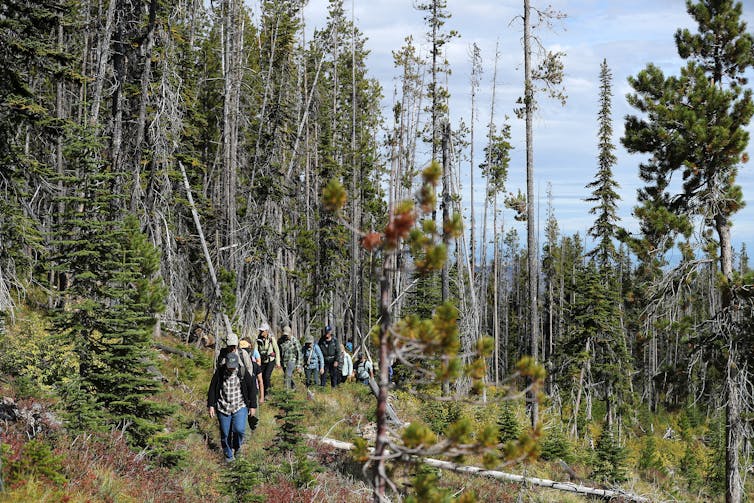
The next green amendment success took 14 years and occurred in Pennsylvania. In the early 2010s, Pennsylvania enacted a state law that gave the oil and gas industry the right to commence hydraulic fracturing, or fracking, anywhere in the state. This law prevented local governments from making land use decisions to restrict or limit fracking in their jurisdictions. The Pennsylvania Supreme Court struck down this state law as violating Pennsylvanians’ constitutional right to a clean and healthful environment.
That Pennsylvania decision ignited an explosion of interest in green amendments.
In Hawaii, public interest groups began challenging the state’s approval of carbon-intensive electricity generation on the ground that it violates Hawaiians’ right to a clean and healthful environment. The state now relies on its green amendment to reject new carbon-intensive electricity sources for powering Hawaii.
In 2022, New York became the first state since the 1970s to adopt a green amendment. Currently, Arizona, Connecticut, Iowa, Kentucky, Maine, Nevada, New Jersey, New Mexico, Tennessee, Texas, Vermont, Washington, and West Virginia are considering adopting green amendments.
Success In Montana
Based on the extensive scientific evidence presented at the trial in June, Judge Seeley found that the Montana youth are being harmed by climate change occurring in Montana and that those climate change effects can be attributed to the state law the plaintiffs challenged.
Seeley also determined that declaring the state law forbidding the consideration of climate impacts during environmental review unconstitutional would alleviate further harm to the youth. On these grounds, she struck down the state law as unconstitutional.
This result sets a groundbreaking precedent for climate litigation and demonstrates a new way in which green amendments can be invoked to elicit environmental change. It suggests that in other states with green amendments, state laws cannot forbid the consideration of greenhouse gas emissions and their climate impact during environmental review.
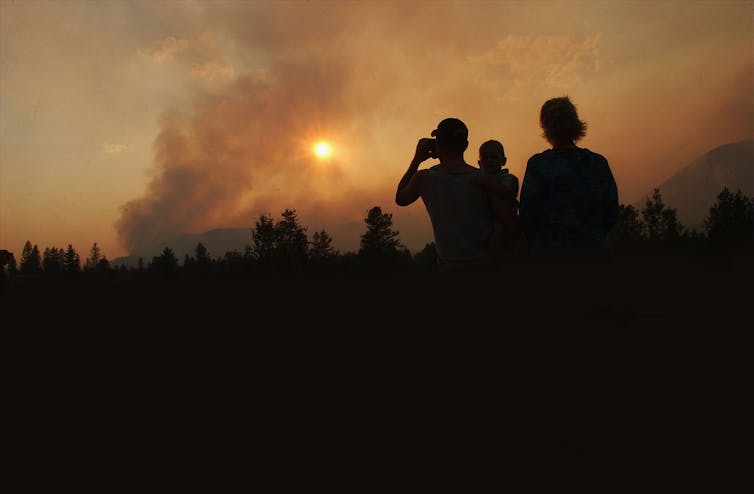
However, Seeley made it clear long before trial that she does not have the power to order the state to create a remedial plan to address climate change.
Further, the Montana legislature repealed the state policies promoting fossil fuel extraction just two months before the trial began, and a judge cannot generally rule on the constitutionality of a repealed law. So, whether state policies promoting fossil fuel extraction violate the people’s constitutional right to a clean and healthful environment is a question for another day and another case.
A spokeswoman for Montana’s attorney general said the state plans to appeal Seeley’s ruling.
Impact On Federal Climate Litigation
It is unclear how the Montana youths’ victory will influence federal climate litigation. The federal youth climate case Juliana v. United States, which was recently revived, relies on the Fifth and Ninth amendments to the U.S. Constitution, as well as the common law public trust doctrine. Neither the Fifth Amendment nor the Ninth Amendment is considered environmental rights akin to a green amendment. However, the public trust doctrine has been relevant in some states’ green amendment jurisprudence.
In the states that have green amendments, climate advocates will certainly rely on the Montana youth case as they challenge state laws that promote climate change.
In recent years, we have witnessed an erosion of our environmental laws through politics and the courts. That has fueled new legal claims of environmental rights in the U.S., Canada and other countries.
This phenomenon is the focus of my research, of which green amendments are just a part. I believe we will continue to see cases, like Held v. State of Montana, invoke rights-based approaches to tackle environmental problems in the future.![]()
Amber Polk, Assistant Professor of Law, Florida International University
This article is republished from The Conversation under a Creative Commons license. Read the original article.
Secrets of the Octopus Garden: Moms nest at thermal springs to give their young the best chance for survival

Two miles below the ocean surface off Monterey, California, warm water percolates from the seafloor at the base of an underwater mountain. It’s a magical place, especially if you’re an octopus.
In 2018, one of us, Amanda Kahn, was aboard the research vessel E/V Nautilus when scientists discovered the “Octopus Garden.” Thousands of pearl octopuses (Muusoctopus robustus) were curled up into individual balls in lines and clumps. As Nautilus Live streamed the expedition online, the world got to share the excitement of the discovery.
We now know why these amazing creatures gather at this and other underwater warm springs.
In a new study involving scientists from several fields, we explain why octopuses migrate to the Octopus Garden. It’s both a mating site and a nursery where newborn octopuses develop faster than expected, giving them the best shot at survival in the deep, cold sea.
Life In The Octopus Garden
Female octopuses seek out rocky cracks and crevices where warm water seeps from the rocks. There, they vigilantly guard their broods. Subsisting off their energy reserves alone, these mothers will never eat again. Like most cephalopods, they make the ultimate sacrifice for their offspring and die after their eggs hatch.
The Octopus Garden, at the base of Davidson Seamount about 80 miles (130 kilometers) southwest of Monterey, California, is the largest of a handful of octopus nurseries recently discovered in the Eastern Pacific. Many have been found near hydrothermal springs where warm water seeps from the seafloor.
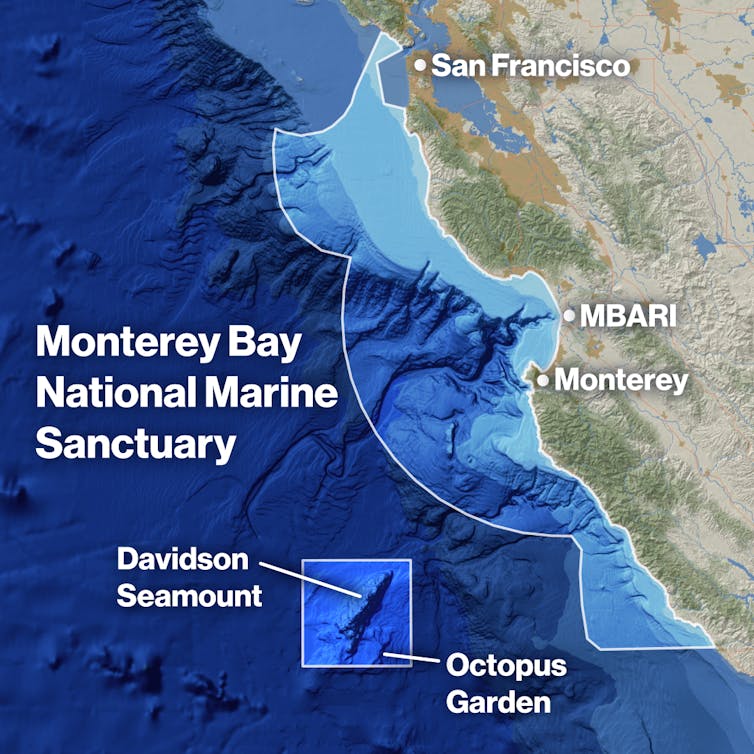
We wanted to know what makes these environments so appealing for nesting octopuses.
To solve this mystery, we assembled geologists, biologists and engineers. Using Monterey Bay Aquarium Research Institute’s deep-sea robots and sensors, we studied and mapped the Octopus Garden during several visits over three years to examine the links between thermal springs and breeding success for pearl octopuses. We found nearly 6,000 nests in a 6-acre (2.5-hectare) area, suggesting more than 20,000 octopuses occupy this site.
A time-lapse camera that kept watch over a group of nesting mothers for six months opened a window into the dynamic life in the Octopus Garden.
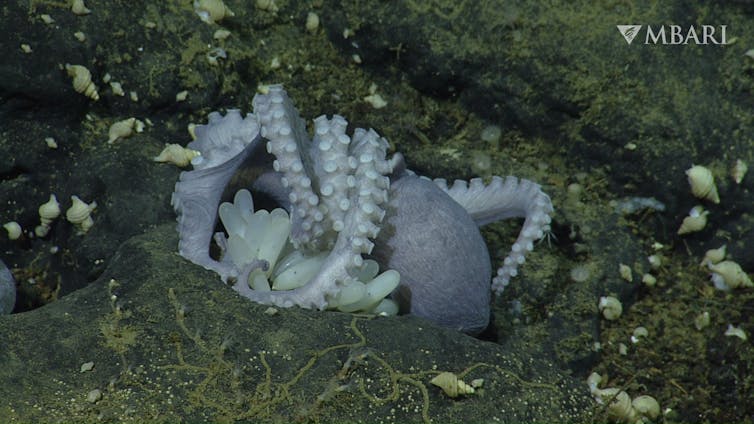
We witnessed male octopuses approaching and mating with females. We cheered for the successful emergence of hatchlings, which looked like translucent miniatures of their parents. And we mourned the deaths of mothers and their broods.
When a nest became empty, it was quickly filled by a different octopus mother. We saw that nothing went to waste at the Octopus Garden. Dead octopesus provided a vital food source for a host of scavengers, like sea anemones and snails.
Warmer Water Speeds Up Embryo Development
A new generation of octopuses must overcome at least two hurdles before hatching.
First, they must develop from egg to hatchling. They start as opaque, sausage-shaped eggs cemented to the rocks. Over time, tiny black eyes, then eight little arms grow visible through the egg capsule. Second, crucially, they must not succumb to external threats, including predators, injuries and infections. The longer the incubation period, the greater the risk that an embryo might not survive to hatch.
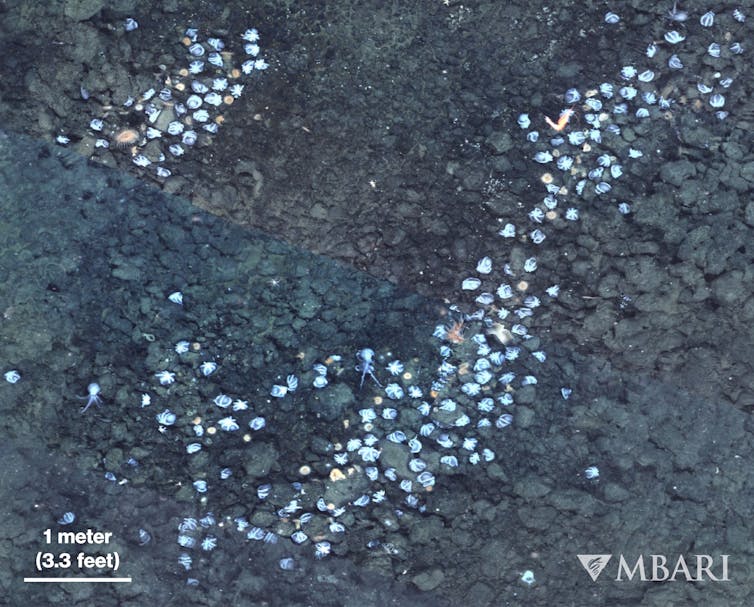
For octopus species living in warm, shallow waters, brood periods are only days to weeks long. But a very different scenario plays out in the abyss. Near-freezing temperatures dramatically slow metabolic processes in coldblooded animals like octopuses. The longest-known brood period for any animal actually comes from another deep-sea octopus species, Graneledone pacifica, with a mother tending her nest for a remarkable 4½ years. An octopus nursery for this species was recently discovered off the west coast of Canada.
At Davidson Seamount, where ambient water temperatures are 35 degrees Fahrenheit (1.6 degrees Celsius), we would expect pearl octopus embryos to take five to 10 years, or possibly longer, to develop. Such an extended brooding period would be the longest known for any animal, exposing an embryo to exceptional risks.
Instead, temperature and oxygen sensors we were able to slip inside octopus nests documented a much warmer microenvironment around the eggs. On average, the temperature inside octopus nests was about 41 F (5.1 C), considerably warmer than the surrounding waters. We predicted that octopus embryos would develop faster in this warmer water.

Distinctive marks and scars helped us identify individual mothers. Over repeat visits we tracked the development of their brood. Although we did expect faster growth in the warm water, we were stunned to find that eggs hatched in less than two years. Nesting in thermal springs clearly gives pearl octopuses a boost.
But nesting in thermal springs is a potentially risky strategy. Once eggs are laid, they’re cemented to the rock. We know little of the thermal tolerance of pearl octopuses or their embryos, but even a short exposure to overly warm waters could be lethal to developing embryos, wiping out any hope of successful reproduction for that mother. Indeed, one of the first recorded deep-sea octopus nurseries may have experienced unpredictable fluid flow.
Nurseries Highlight Risks To Seafloor Habitat
The thermal springs at the Octopus Garden are part of a ridge flank hydrothermal system. Here, water percolating beneath the seafloor picks up heat from Earth’s mantle before it’s channeled out from volcanic rock outcrops like Davidson Seamount. These systems have become an emerging focus in seafloor geology, though only a few have been discovered so far.
Unlike hydrothermal vents, which form at ridge crests and belch plumes of hot water that are detectable hundreds of meters above the bottom, thermal springs on ridge flanks are cryptic. These springs seep warm water that dissipates only meters above the bottom, making them exceedingly difficult to find and only visible by a slight shimmer in the water.
Our yearlong recordings from thermal springs at the Octopus Garden demonstrate these may be stable environments, with the potential to release warm fluids for thousands of years. Such stability benefits not only pearl octopus, but also the community of life that thrives alongside the nesting mothers.
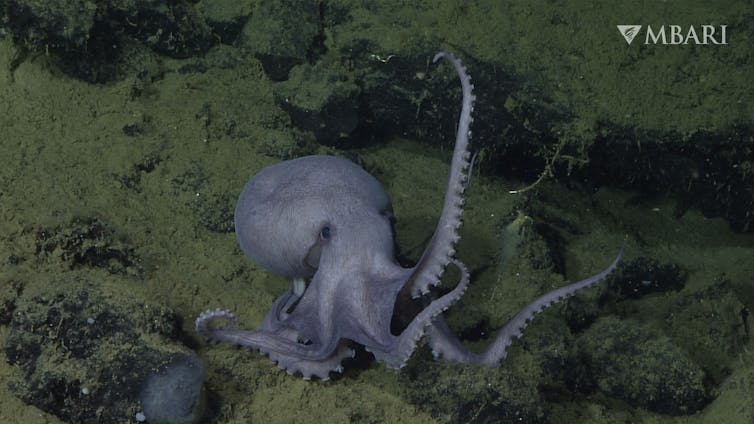
The recent discoveries of octopus nurseries off the Pacific coast of Costa Rica, also near hydrothermal springs, suggests these areas may be more common than previously thought. It also highlights that hydrothermal springs may be vital biological hot spots.
The deep sea is the largest living space on Earth, and that expansive size can hide the importance of localized hot spots like these. Davidson Seamount and its Octopus Garden are protected as part of Monterey Bay National Marine Sanctuary, but many more biological treasures like thermal springs may be at risk, especially as deep-seabed mining proposes to scrape large understudied swaths of seafloor. We hope the octopus mothers we’ve met at this nursery inspire everyone to rethink stewardship for the yet-undiscovered hidden gems that may be lost.![]()
Amanda Kahn, Assistant Professor of Invertebrate Ecology at Moss Landing Marine Laboratories, San José State University and Jim Barry, Marine Ecologist, MBARI, San José State University
This article is republished from The Conversation under a Creative Commons license. Read the original article.
To predict future sea level rise, we need accurate maps of the world’s most remote fjords
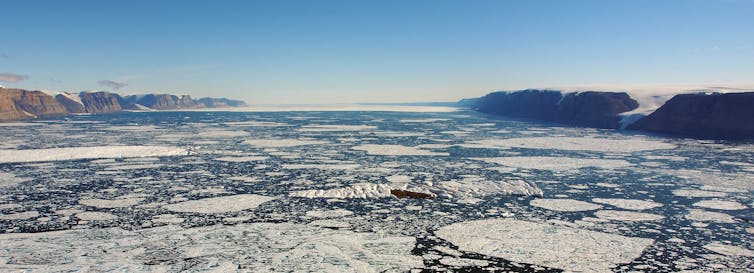
Understanding how glaciers interact with the ocean is akin to piecing together a colossal jigsaw puzzle. And on various icebreaker expeditions to some of the most remote fjords in northern Greenland, colleagues and I have showed that the shape of the seafloor is one of the key pieces of that puzzle.
To understand why the seabed is so important, we have to look at the glaciers themselves and what is causing them to retreat or even disappear. The large glaciers that meet the ocean in Greenland and Antarctica balance their mass over time largely in pace with the climate. When it snows or rains they accumulate ice, and they lose ice to melting and calving – the process where chunks of ice break off and eventually melt away into the sea.
But over the past few decades they are losing mass at an accelerated pace, with more icebergs calving into the ocean and more ice being melted from below by relatively warm seawater.
Estimating how much mass will be lost is often highlighted as glaciology’s grand challenge as it constitutes a large uncertainty in our predictions of future sea-level rise. To hone our predictions, it is crucial to find the areas where warmer ocean water reaches the these glaciers.
Most glaciers in Greenland drain into fjords in which the waters near the surface are very cold, heavily influenced by meltwater from the glaciers. Some fjords also allow in warmer water of Atlantic origin, which is saltier and therefore heavier so it enters the fjords at a greater depth.
The shape and depth (or “bathymetry”) of the seafloor determines whether this warmer water can reach the glaciers and cause them to melt. These fjords may have particularly complex bathymetry as they themselves were formed by glaciers which also eroded the seabed. While the inner parts can be a kilometre deep, a shallower “sill” at the entrance (formed when eroded materials accumulate or from resistant bedrock) can act as a shield against inflowing warmer water.
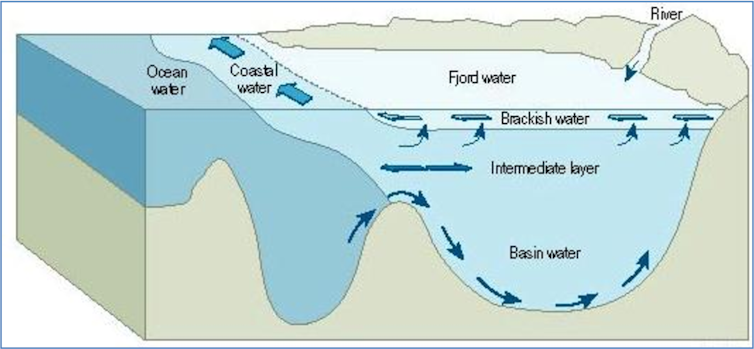
That’s why mapping these fjords is one of the most critical steps in assessing the future of the glaciers that flow into them. This is unfortunately easier said than done, since many of these glaciers flow into some of the most remote areas of the world.
Ireland-Sized Glacier, Manhattan-Sized Icebergs
The Petermann Glacier – the largest in the northern part of the Greenland ice sheet – drains an area of about 74,000 square kilometres, similar to the size of Ireland.
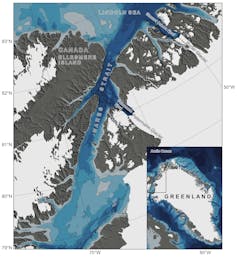
Petermann is one of a few glaciers around Greenland with a floating ice tongue extending tens of kilometres from where the glacier is grounded on the seafloor. These ice tongues may act as a brakes on the flow of ice into the sea, slowing down mass loss.
In 2010, Petermann made headlines when a huge chunk broke off and formed an iceberg four times the size of Manhattan island. This was followed by another huge calving two years later. While calving is a natural process, these unusually large events were likely influenced by warmer waters from the Atlantic melting the tongue from below, making it thinner and more prone to break.
In 2015 colleagues and I mapped the entire seabed of Petermann Fjord for the first time. We found the entrance was still very deep: 443 metres – as deep as the Empire State Building is tall. Deep enough for that warm, heavy, salty glacier-melting Atlantic water to enter.
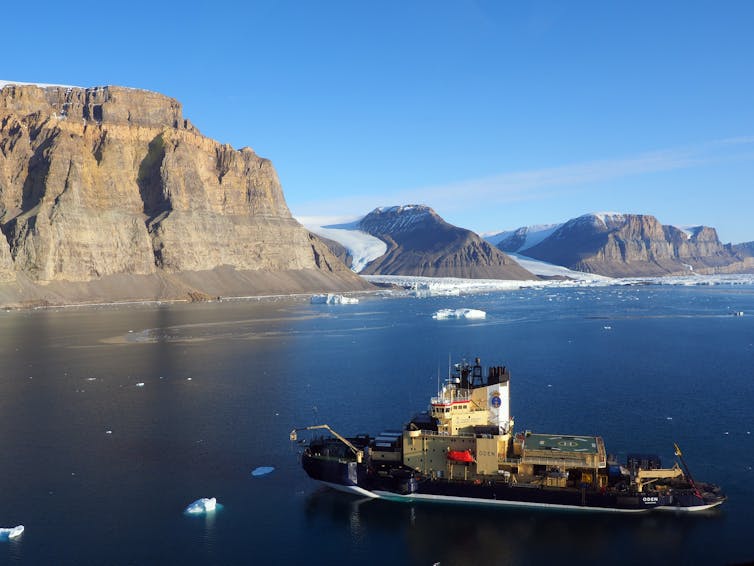
We next wanted to compare Petermann to the Ryder Glacier to its northeast, which has been more stable since at least the 1950s. Was it kept in place by a shallow fjord entrance keeping out warmer water?
At the time, no ship had ever entered Sherard Osborn Fjord where Ryder Glacier drains, because the sea ice in that region is the toughest in the entire Arctic Ocean. Therefore, nothing at all was known about the seafloor. Ryder Glacier became the target for our next expedition with icebreaker Oden in 2019.
Shielded From Warmer Water
Thick ice in the narrow passage separating Ellesmere Island from Greenland made it hard to even get to Sherard Osborn Fjord. And entering the fjord was a true challenge, as large icebergs that had calved from the ice tongue floated around and occasionally blocked the entire entrance.
It turned out the fjord has a prominent shallow sill in front of Ryder Glacier. This sill shields the glacier from warmer subsurface Atlantic water, which appears to explain why it has behaved very differently compared to Petermann.
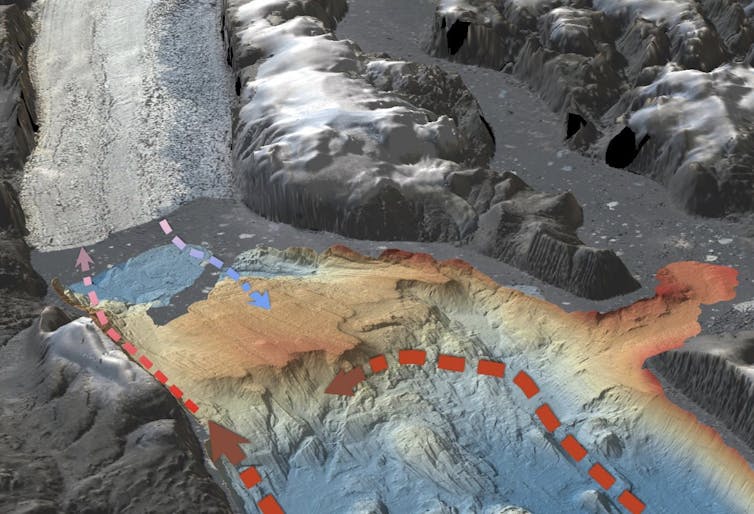
The bathymetry of both Petermann and Sherard Osborn fjords has now been incorporated into the Seabed 2030 Project, which aims to completely map the world’s ocean floor before the end of the decade. Knowing more about the seabed, and the glaciers that flow into the sea, will in turn help us to sustainably manage the ocean and, ultimately, the planet.
The are more completely unmapped areas in North Greenland. In 2024, we are planning another expedition with icebreaker Oden even further north to Victoria Fjord, where C.H. Ostenfeld Glacier drains. This glacier recently lost its floating ice tongue and whether or not Atlantic water makes into the fjord remains to be seen.![]()
Martin Jakobsson, Professor of Marine Geology and Geophysics, Stockholm University
This article is republished from The Conversation under a Creative Commons license. Read the original article.
How do coral reefs thrive in parts of the ocean that are low in nutrients? By eating their algal companions
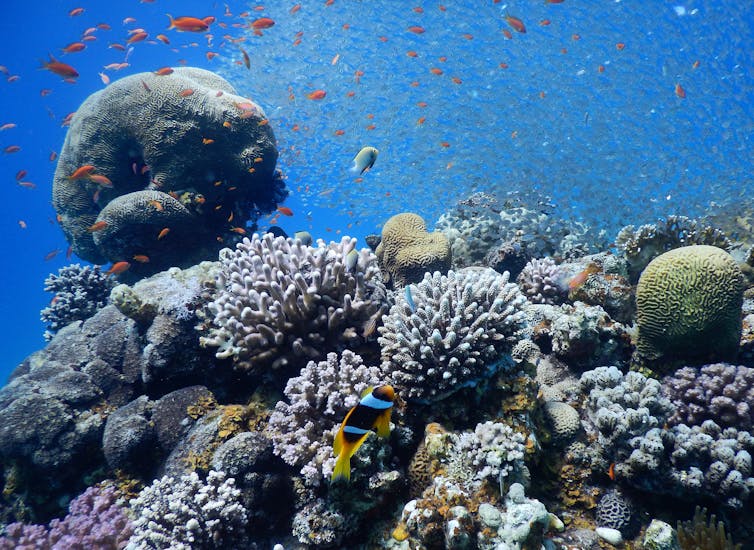
Coral reefs thrive in parts of the world’s oceans that are low in nutrients. This mystery has puzzled scientists for centuries and has become known as the “Darwin paradox of coral reefs”.
Our new study adds the missing piece of the puzzle. We found that many species of coral cultivate and feed on the microscopic algae that live inside their cells. This vegetarian diet allows the corals to tap into a large pool of nutrients that was previously considered unavailable to them.
Stony corals are soft-bodied animals made up of many individual polyps that live together as a colony. They secrete limestone skeletons that form the foundation of reefs. The coral polyps acquire nutritious compounds rich in nitrogen and phosphorus by catching prey like zooplankton with their tentacles.
Many coral animals are also dependent on a symbiosis – a mutually beneficial relationship – with the microscopic algae that live inside their cells. These photosynthetic algae produce large amounts of carbon-rich compounds, such as sugars, and transfer them to the host coral to generate energy. However, as most photosynthetic products are deficient in nitrogen and phosphorous, they cannot sustain the growth of the animals.
Our findings suggest that, while coral animals may survive brief periods of starvation by feeding on their symbionts, some coral reefs could face the risk of prolonged nutrient deficiency due to global warming. This is concerning. Coral reefs are important underwater ecosystems that provide a home and feeding ground for countless organisms, sustaining around 25% of the world’s ocean biodiversity.
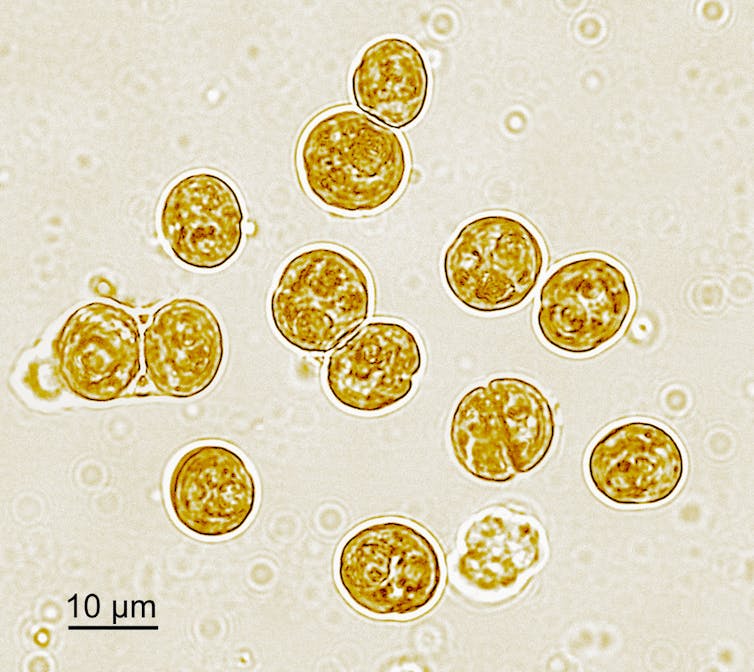
Vegetarian Diet
The symbiotic algae living within the corals are very efficient at taking up dissolved inorganic nutrients, like nitrate and phosphate, from the surrounding seawater. Even in nutrient-poor areas of the ocean, these compounds are present in considerable amounts as excretion products of organisms, such as sponges, that live close by. Ocean currents can also transport these nutrients to reefs.
The coral host, on the other hand, cannot absorb or use nitrate and phosphate directly. But, through a series of long-term laboratory experiments, we demonstrated that corals actually digest some of their symbiont population to access the nitrogen and phosphorus that these algae absorb from the water.
To provide evidence that the nutrients accumulated by the growing coral tissue originated from the symbionts, we supplied the corals with a chemical form of nitrogen that can only be absorbed from the water by the symbionts, not by the coral host.
This nutrient compound was marked by a technique called isotopic labelling, which uses nitrogen atoms that are heavier than normal. These “heavy” isotopes allowed us to track the movement of nitrogen between the partners of the symbiosis by ultrasensitive detection methods.
With this method, we could unambiguously demonstrate that the nitrogen atoms that sustained the growth of the coral tissue were derived from the dissolved inorganic nutrients that were fed to their symbiont algae.
Our data suggest that most species of symbiotic corals can supplement their nutrition through such a vegetarian diet.
From The Laboratory To The Ocean
Together with our colleagues, we also analysed corals growing around remote islands in the Indian Ocean, some with seabirds on them and some without. Our results show that corals have the potential to farm and feed on their symbiont algae in the wild too.
The reefs around some of these islands are supplied with substantial amounts of nutrients that come from “guano” – the excrement of seabirds nesting on the islands. On some of the other islands, seabird colonies have been decimated by invasive rats. The reefs surrounding these islands receive fewer nutrients.
We measured the growth of staghorn coral colonies both around islands with and without dense seabird populations and found that growth was more than twice as fast on reefs that were supplied with seabird nutrients. About half of the nitrogen molecules in the tissue of the coral animals from islands with seabirds could be traced back to uptake by the symbiont algae.
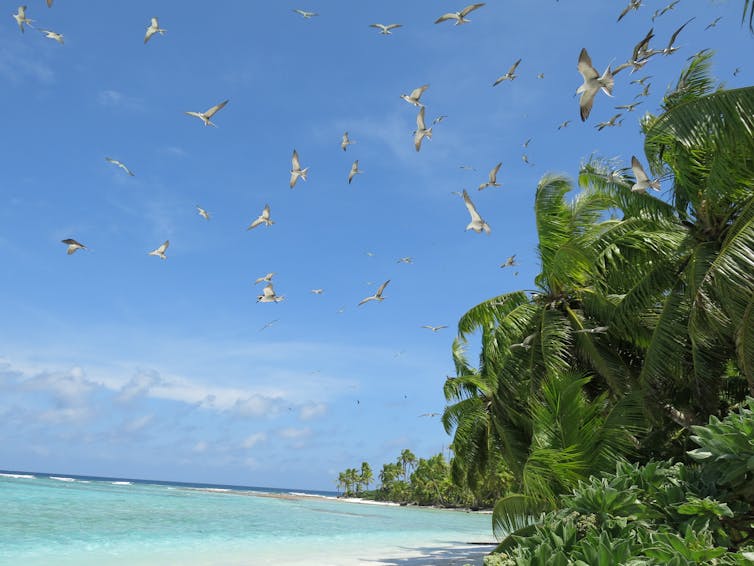
Global Warming Could Complicate Matters
In the future, some coral reefs could face a decrease in nutrient availability due to global warming. Research suggests that warming surface waters are less likely to receive nutrients from deeper water layers. The reduced water productivity could result in fewer nutrients for their symbionts and subsequently less food for the coral animals.
Our study indicates that some coral reefs might become vulnerable to starvation as ocean temperatures warm. When we moved corals from water with ample nutrients to water with fewer nutrients, they continued to eat their symbiont algae. This behaviour allowed them to sustain their growth for a few weeks, even in the absence of feeding.
But once they had exhausted their population of symbiotic algae, the coral underwent bleaching (referring to the white appearance of the corals with low symbiont numbers in their tissue), stopped growing – and in some cases eventually died.
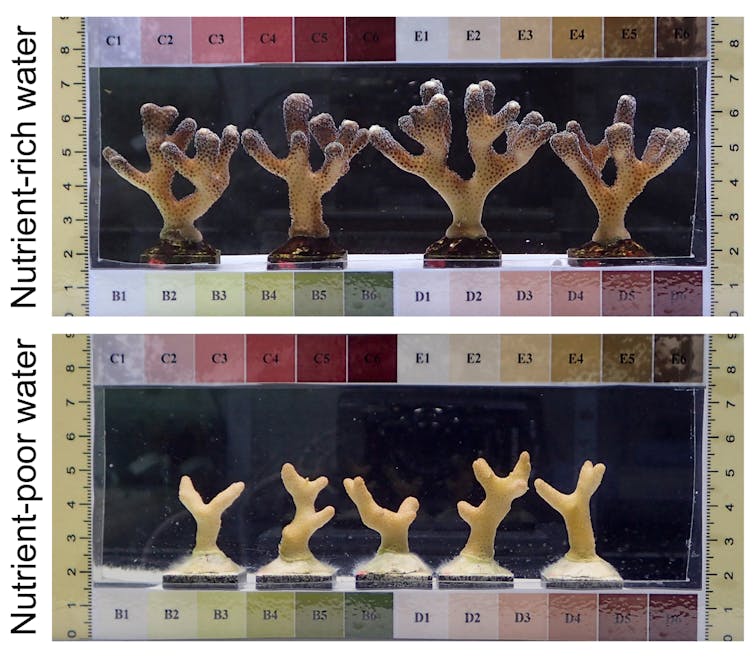
Our findings reveal that corals can not only acquire nitrogen and phosphorus by feeding on prey as other animals do. But, by eating parts of their symbiont stock, they can also efficiently tap into the pool of dissolved inorganic nitrogen and phosphorus that is otherwise only accessible to plants.
Through this process, symbiotic corals gain an advantage over other animals in environments that are low in nutrients, explaining their prominent role in the formation of reefs in nutrient-poor water.
However, increasingly severe nutrient depletion will add a further threat to some coral reefs already experiencing bleaching caused by heat stress.![]()
Jörg Wiedenmann, Head of the Coral Reef Laboratory, University of Southampton and Cecilia D'Angelo, Associate Professor, Coral Reef Laboratory, University of Southampton
This article is republished from The Conversation under a Creative Commons license. Read the original article.
‘Worthless’ forest carbon offsets risk exacerbating climate change
Julia P G Jones, Bangor University and Neal Hockley, Bangor UniversityIn early 2023, the Guardian published an article suggesting that more than 90% of rainforest carbon offsets are worthless. These credits are essentially a promise to protect forests and can be bought as a way to “offset” emissions elsewhere. Verra, the largest certifier of these offset credits, said the claims were “absolutely incorrect” but the story still shook confidence in the billion-dollar market. Soon after, Verra’s CEO stood down.
The claims in the Guardian article rested heavily on analysis which had been published as a preprint (before peer review). Now the research has been fully peer-reviewed and is published in the journal Science. It shows unequivocally that many projects which have sold what are known as REDD+ (reducing emissions from deforestation and degradation) credits have failed to reduce deforestation.
REDD+ projects aim to slow deforestation (for example, by supporting farmers to change their practices). They quantify the carbon saved through reducing deforestation relative to what would have happened without the project, and sell these emission reductions as credits.
Such REDD+ credits are widely used to “offset” (that is, cancel out) emissions from companies (who may use them to make claims that their operations are carbon neutral) or by people concerned about their carbon footprint. For example, if you were planning to fly from London to New York you might consider buying REDD+ credits that promise to conserve rainforest in the Congo Basin (with added benefits for forest elephants and bonobos). Offsetting your return flight would appear to cost a very affordable £16.44.
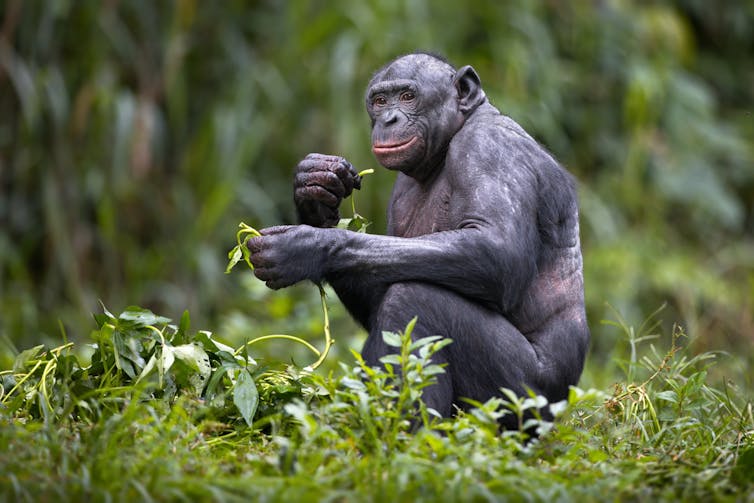
However, while previous analysis showed that some REDD+ projects have contributed to slowing deforestation and forest degradation, the central finding from the new study is that many projects have slowed deforestation much less than they have claimed and, consequently, have promised greater carbon savings than they have delivered. So that guilt-free flight to New York probably isn’t carbon neutral after all.
The finding that many REDD+ carbon credits have not delivered forest conservation is extremely worrying to anyone who cares about the future of tropical forests. We spoke to Sven Wunder, a forest economist and a co-author of the new study. He told us that: “To tackle climate change, tropical deforestation must be stopped. Forests also matter for other reasons: losing forests will result in loss of species, and will affect regional rainfall patterns. Despite the evidence that REDD+ has not been delivering additional conservation, we cannot afford to give up.”
Deforestation Could Simply Move Elsewhere
Carbon credits also face other challenges, one of the biggest being “leakage” or displacement of deforestation. Leakage may occur because the people who were cutting down the forest simply relocate to a different area. Alternatively, demand for food or timber that was fuelling deforestation in one place may be met by deforestation elsewhere – perhaps on the other side of the world. Another problem is ensuring that the forests are protected in perpetuity so that reduced deforestation represents permanent removal of carbon from the atmosphere.
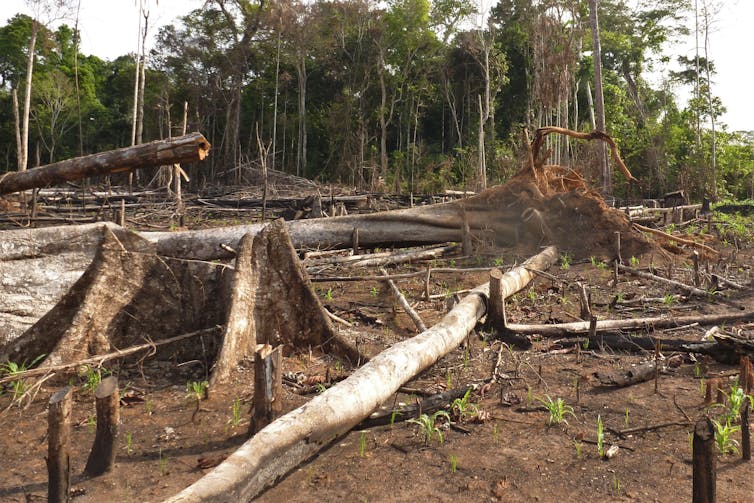
Addressing these challenges is vital because selling carbon credits is an important source of finance for forest conservation. It is not too dramatic to say that unreliable REDD+ credits directly threaten forests.
However, this is an active research area and new approaches are increasingly available. Andrew Balmford is a professor of conservation science at the University of Cambridge who is actively developing methods to improve the credibility of forest carbon markets. He says the new study raises some important concerns but that more robust and transparent methods have been developed. Deploying these new methods, he told us, is “an urgent priority”.
Change is also needed to how certification operates. At present, there are incentives for verifiers to inflate estimates of the amount of deforestation that would have happened without the project, and therefore the number of credits that can be issued. Sven Wunder explains: “We need to move beyond vested interest towards independent governance employing scientifically informed, cutting-edge methods.”
Reasons To Be Cautious
Even if these problems can be solved, there are still reasons to be cautious about the role of carbon offsets in combating climate change. First, there is the risk that offsetting actually increases emissions because people or companies might feel more comfortable emitting carbon if they believe they can undo any damage by simply buying carbon credits. For this reason, some argue that offsets must only ever be a last resort, after all non-essential emissions have been cut (the problem being of course: who decides which emissions are essential?).
Second, keeping warming within 2°C will require most deforestation to be stopped and major reductions in fossil fuel emissions. There is a limit to which one can be used to balance out the other.
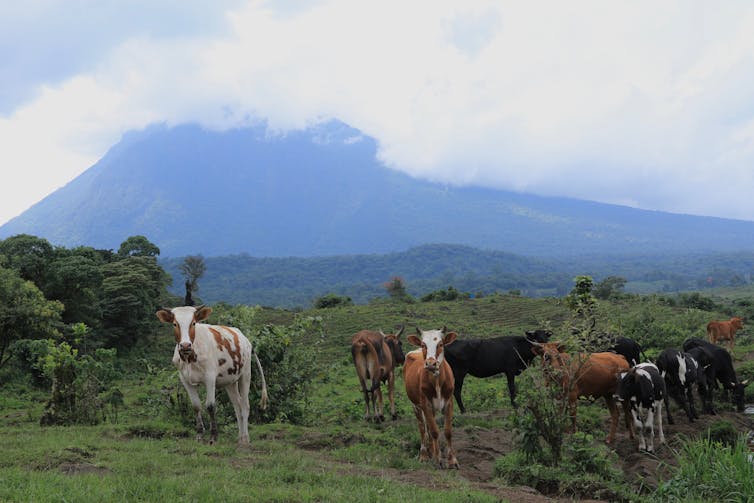
Finally, there are serious equity concerns with some forest carbon offsets. If forest conservation is achieved by stopping farmers in low-income countries from clearing land for agriculture, REDD+ may exacerbate poverty: your long haul flight would come at the expense of others being able to feed their families.
We don’t know how much it would cost to achieve genuinely additional offsets which avoid leakage and ensure equity but it is likely to be considerably more expensive than forest carbon credits currently sell for. A higher price would reduce the perception that offsetting is an easy option and should encourage more focus on reducing emissions.
So, should you buy those cheap forest carbon offsets when taking a flight? Unfortunately, there’s currently little evidence that doing so will really make your journey carbon neutral. If you want to contribute to tackling climate change, perhaps the only real option is to not take the flight.![]()
Julia P G Jones, Professor of Conservation Science, Bangor University and Neal Hockley, Senior Lecturer in Environmental Economics & Policy, Bangor University
This article is republished from The Conversation under a Creative Commons license. Read the original article.
Trees discovered at record-breaking altitudes highlight why we should restore Scotland’s mountain woodland
Sarah Watts, University of StirlingThe Scottish Highlands are celebrated for wide-open views of spectacular glens (valleys) and rugged peaks. After centuries of landscape change, particularly deforestation caused by humans, it is easy to forget how well trees can thrive there. But new discoveries of small trees atop Scottish summits are surpassing the expectations of plant scientists, and demonstrating opportunities for mountain woodland to make a comeback for the benefit of people, wildlife and fighting the climate crisis.
Forest clearance in Britain originally coincided with the introduction of agriculture. Since at least 3,000 years ago, trees and shrubs have been harvested for building materials, firewood and charcoal. Wildfire and controlled burning have also reduced their extent. However, the continuing decline of mountain woodland is mainly linked to overgrazing by domestic hill sheep (introduced in the 18th century) and increased numbers of red deer for sport shooting.
Woody plants, especially willows, are particularly appetising for these animals in the uplands where nutritious food can be harder to find. Overgrazing has caused an almost complete loss of the natural altitudinal treeline – the transition zone from the timberline, where trees grow upright and tall, to the upper boundary where they can establish in the harsh mountain climate.
A Perilous Decline
Some fragments have managed to cling on to inaccessible cliff ledges. The iconic Scots pine is a feature of remnant treelines, particularly in the Cairngorms. These refuges also include birch, rowan and juniper, as well as arctic-alpine willows which are rare and endangered or vulnerable to extinction. Their habitat, montane willow scrub, typically forms at 600-900m above sea level, but has been reduced to a total area of approximately 10 hectares (15 football pitches) across the entire country.
The Scottish situation can be contrasted to southwest Norway, which is now more wooded because there has been less grazing and burning since the 19th century.
Reaching New Heights
Nevertheless, citizen science has recently led us to 11 new altitudinal records for tree species in Britain, including a rowan at 1,150m in West Affric in Inverness-shire, and a birch at 1,026m on Ben Nevis – Britain’s highest mountain – near Fort William. Some observations were at least 200m above previous known altitudes. Our discoveries are attributed primarily to increased biological recording, which is valuable for expanding knowledge of the environmental tolerances of plants.
These record-breakers are pioneers, stunted from growing at the extreme limits of their ability to cope with low temperatures and high wind speeds. The trees are outliers existing far beyond where the treeline is expected to develop. They may only be knee- or even ankle-high, but their survival on our highest ground indicates huge potential for woodland and scrub to return across the slopes below.
Benefits For A Whole Ecosystem
Groundbreaking action in Scotland shows this aspiration is possible through tree planting, propagating rare species and protection from overgrazing. Once a large enough seed source exists, the trees will also emerge on their own via natural regeneration. Montane willow scrub now flourishes on the Ben Lawers range in the southern Highlands, while Caledonian pinewoods are reappearing on higher ground in the Cairngorms.
And it’s not just the trees that are to gain. Mountain woodland restoration supports vibrant flowers and a unique community of rare bumblebees, flies, butterflies and moths, as well as birds that are scarce or declining elsewhere in Britain, including ring ouzel, redpoll and grouse. Mammals such as hares, voles, deer and livestock also take advantage of the enhanced shelter and foliage.
Besides offering shade and a haven for wildlife, woodland and scrub stabilise steep slopes and give protection from the natural hazards of avalanches, rockfalls and landslides. Trees and shrubs also slow the flow of water over and within upland soils, holding moisture and facilitating a decrease in flooding downstream.
These benefits are called “nature-based solutions” because they are considered vitally important for reducing threats from escalating climate change, including warming temperatures, extreme weather and soil erosion.
Nature Recovery At Scale
For the rewards to be delivered nationally, we now need to be bold and ambitious, like the trees that broke the altitudinal records. Land managers, policymakers and funding bodies must move forward from focusing on small areas of mountain woodland held behind fences. Through wider collaboration we can aim to reinstate a much more connected treeline throughout our uplands.
Landscape-scale deer management for lower density populations is required to remove the pressure of overgrazing and enable a balance between sustainable numbers of animals and tree growth. Enhancing rural employment and retaining invaluable skills in deer stalking will be essential for meeting this goal. Those estates already taking such an approach are showing significant capacity for regeneration and nature recovery.
And the panoramic views for which Scotland is renowned? They will not be obscured by the return of our trees. Mountain woodland usually creates a patchwork mosaic together with open areas of grassland and moorland. Some soils are too wet and instead support peatlands and blanket bog.
Improving the health of all these habitats will allow our environment to nurture a high diversity of life and many associated benefits to people amidst the nature and climate emergency.![]()
Sarah Watts, PhD Researcher in Plant Ecology and Conservation, University of Stirling
This article is republished from The Conversation under a Creative Commons license. Read the original article.
Pulverised fuel ash: how we can recycle the dirty by-product from coal-fired power stations

The ash from burning coal in coal-fired power stations lies in thousands of landfills around the world. This waste material, generally considered a hazard, is now being put to good use in the construction industry.
More than 6,000 coal-fired power stations produce this powdery byproduct, which is properly known as “pulverised fuel ash” (PFA) or “fly ash”. Traditionally, it was released into the atmosphere from the smoke stack after the coal was burned, but, because of its effect on air quality, it is now captured and stored in landfills.
Our research focuses on how we can recycle and make best use of these types of dirty byproducts for the sake of the environment.
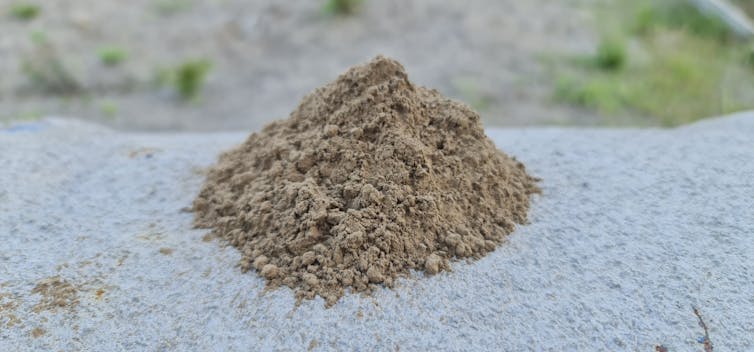
The current demand for concrete worldwide is around 14 billion cubic metres annually. This is projected to increase by 43% to 20 billion cubic metres by 2050. The impact of the carbon dioxide emissions (8% globally) that is associated with this increase, against the backdrop of the current environmental crisis, is immense.
There is a dire need for a change in lifestyle and for tighter environmental regulation of industrial operations and processes. This should include a serious mitigation of the worsening environmental landscape. Increasing the use of industrial waste and byproduct materials is one such strategy.
Some of the most abundant global waste streams result from the many years of coal mining, so the role that can be played by re-using coal waste, including PFA, is significant.
And this idea is based on old technology if you consider how the Romans used ash. The dome of the Pantheon in Rome, built in AD128, as well as the Colosseum, are examples of successful structures built with volcanic ash-based concrete.
Portland Cement
PFA can be blended with Portland cement to make concrete. That’s the most common type of cement in general use around the world and is a basic ingredient of concrete, but also mortar, stucco and some grout. Portland cement is a hydraulic cement, which means that it reacts with water to form a paste that binds sand and rock together, creating concrete. Around 3.5 billion tonnes of Portland cement are produced annually.
The problem, though, is that producing Portland cement uses a lot of energy and also precious natural resources. You must quarry the raw materials, which not only damages the landscape but also results in emissions of up to 622kg of carbon dioxide per tonne of cement.
Lessening the impact of Portland cement on the environment is therefore vital. PFA is the most attractive byproduct for this purpose, due to its abundance and low cost. Also, if it is properly used in combination with Portland cement, it can result in stronger and more durable concrete.
However, as more coal-fired power stations are decommissioned and fewer come into operation worldwide, stockpiles of PFA become depleted. This means we will need to use the material more efficiently in the future.
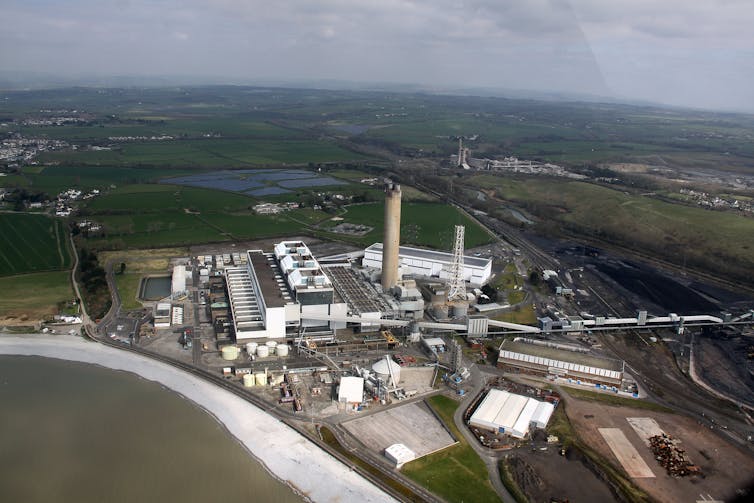
Attention will have to shift to different types of fly ash or unburnt colliery waste. But coal mining waste, either from current or past mining activities, will continue to feature in the construction industry for a long time.
And besides concrete, there are also other ways in which we can recycle PFA. This includes using it to improve the properties of soils, making abrasives such as sandpaper and grinding wheels, and using it in the manufacturing of a variety of products, such as plastics, paints and rubber.![]()
John Kinuthia, Professor and Manager of the Advanced Materials Testing Centre (AMTeC), University of South Wales and Jonathan Oti, Associate Professor at the Advanced Materials Testing Centre (AMTeC), University of South Wales
This article is republished from The Conversation under a Creative Commons license. Read the original article.
Pittwater Reserves: Histories + Notes + Pictorial Walks
A History Of The Campaign For Preservation Of The Warriewood Escarpment by David Palmer OAM and Angus Gordon OAM
A Stroll Through Warriewood Wetlands by Joe Mills February 2023
A Walk Around The Cromer Side Of Narrabeen Lake by Joe Mills
America Bay Track Walk - photos by Joe Mills
An Aquatic June: North Narrabeen - Turimetta - Collaroy photos by Joe Mills
Angophora Reserve Angophora Reserve Flowers Grand Old Tree Of Angophora Reserve Falls Back To The Earth - History page
Annie Wyatt Reserve - A Pictorial
Avalon's Village Green: Avalon Park Becomes Dunbar Park - Some History + Toongari Reserve and Catalpa Reserve
Bairne Walking Track Ku-Ring-Gai Chase NP by Kevin Murray
Bangalley Headland Bangalley Mid Winter
Banksias of Pittwater
Barrenjoey Boathouse In Governor Phillip Park Part Of Our Community For 75 Years: Photos From The Collection Of Russell Walton, Son Of Victor Walton
Barrenjoey Headland: Spring flowers
Barrenjoey Headland after fire
Bayview Baths
Bayview Wetlands
Beeby Park
Bilgola Beach
Botham Beach by Barbara Davies
Bungan Beach Bush Care
Careel Bay Saltmarsh plants
Careel Bay Birds
Careel Bay Clean Up day
Careel Bay Playing Fields History and Current
Careel Creek
Careel Creek - If you rebuild it they will come
Centre trail in Ku-ring-gai Chase National Park
Chiltern Track- Ingleside by Marita Macrae
Clareville Beach
Clareville/Long Beach Reserve + some History
Coastal Stability Series: Cabbage Tree Bay To Barrenjoey To Observation Point by John Illingsworth, Pittwater Pathways, and Dr. Peter Mitchell OAM
Cowan Track by Kevin Murray
Curl Curl To Freshwater Walk: October 2021 by Kevin Murray and Joe Mills
Currawong and Palm Beach Views - Winter 2018
Currawong-Mackerel-The Basin A Stroll In Early November 2021 - photos by Selena Griffith
Currawong State Park Currawong Beach + Currawong Creek
Deep Creek To Warriewood Walk photos by Joe Mills
Drone Gives A New View On Coastal Stability; Bungan: Bungan Headland To Newport Beach + Bilgola: North Newport Beach To Avalon + Bangalley: Avalon Headland To Palm Beach
Duck Holes: McCarrs Creek by Joe Mills
Dunbar Park - Some History + Toongari Reserve and Catalpa Reserve
Dundundra Falls Reserve: August 2020 photos by Selena Griffith - Listed in 1935
Elsie Track, Scotland Island
Elvina Track in Late Winter 2019 by Penny Gleen
Elvina Bay Walking Track: Spring 2020 photos by Joe Mills
Elvina Bay-Lovett Bay Loop Spring 2020 by Kevin Murray and Joe Mills
Fern Creek - Ingleside Escarpment To Warriewood Walk + Some History photos by Joe Mills
Iluka Park, Woorak Park, Pittwater Park, Sand Point Reserve, Snapperman Beach Reserve - Palm Beach: Some History
Ingleside
Ingleside Wildflowers August 2013
Irrawong - Ingleside Escarpment Trail Walk Spring 2020 photos by Joe Mills
Irrawong - Mullet Creek Restoration
Katandra Bushland Sanctuary - Ingleside
Lucinda Park, Palm Beach: Some History + 2022 Pictures
McCarrs Creek
McCarr's Creek to Church Point to Bayview Waterfront Path
McKay Reserve
Mona Vale Beach - A Stroll Along, Spring 2021 by Kevin Murray
Mona Vale Headland, Basin and Beach Restoration
Mona Vale Woolworths Front Entrance Gets Garden Upgrade: A Few Notes On The Site's History
Mount Murray Anderson Walking Track by Kevin Murray and Joe Mills
Mullet Creek
Narrabeen Creek
Narrabeen Lagoon Catchment: Past Notes Present Photos by Margaret Woods
Narrabeen Lagoon State Park
Narrabeen Lagoon State Park Expansion
Narrabeen Rockshelf Aquatic Reserve
Nerang Track, Terrey Hills by Bea Pierce
Newport Bushlink - the Crown of the Hill Linked Reserves
Newport Community Garden - Woolcott Reserve
Newport to Bilgola Bushlink 'From The Crown To The Sea' Paths: Founded In 1956 - A Tip and Quarry Becomes Green Space For People and Wildlife
Pittwater Reserves: The Green Ways; Bungan Beach and Bungan Head Reserves: A Headland Garden
Pittwater Reserves, The Green Ways: Clareville Wharf and Taylor's Point Jetty
Pittwater Reserves: The Green Ways; Hordern, Wilshire Parks, McKay Reserve: From Beach to Estuary
Pittwater Reserves - The Green Ways: Mona Vale's Village Greens a Map of the Historic Crown Lands Ethos Realised in The Village, Kitchener and Beeby Parks
Pittwater Reserves: The Green Ways Bilgola Beach - The Cabbage Tree Gardens and Camping Grounds - Includes Bilgola - The Story Of A Politician, A Pilot and An Epicure by Tony Dawson and Anne Spencer
Pittwater spring: waterbirds return to Wetlands
Pittwater's Lone Rangers - 120 Years of Ku-Ring-Gai Chase and the Men of Flowers Inspired by Eccleston Du Faur
Pittwater's Parallel Estuary - The Cowan 'Creek
Resolute Track at West Head by Kevin Murray
Resolute Track Stroll by Joe Mills
Riddle Reserve, Bayview
Salvation Loop Trail, Ku-Ring-Gai Chase National Park- Spring 2020 - by Selena Griffith
Seagull Pair At Turimetta Beach: Spring Is In The Air!
Stapleton Reserve
Stapleton Park Reserve In Spring 2020: An Urban Ark Of Plants Found Nowhere Else
Stony Range Regional Botanical Garden: Some History On How A Reserve Became An Australian Plant Park
The Chiltern Track
The Chiltern Trail On The Verge Of Spring 2023 by Kevin Murray and Joe Mills
The Resolute Beach Loop Track At West Head In Ku-Ring-Gai Chase National Park by Kevin Murray
Topham Track Ku-Ring-Gai Chase NP, August 2022 by Joe Mills and Kevin Murray
Towlers Bay Walking Track by Joe Mills
Trafalgar Square, Newport: A 'Commons' Park Dedicated By Private Landholders - The Green Heart Of This Community
Tranquil Turimetta Beach, April 2022 by Joe Mills
Turimetta Beach Reserve by Joe Mills, Bea Pierce and Lesley
Turimetta Beach Reserve: Old & New Images (by Kevin Murray) + Some History
Turimetta Headland
Warriewood Wetlands - Creeks Deteriorating: How To Report Construction Site Breaches, Weed Infestations + The Long Campaign To Save The Warriewood Wetlands & Ingleside Escarpment March 2023
Warriewood Wetlands and Irrawong Reserve
Whale Beach Ocean Reserve: 'The Strand' - Some History On Another Great Protected Pittwater Reserve
Wilshire Park Palm Beach: Some History + Photos From May 2022
Winji Jimmi - Water Maze

Write A Love Letter To The Land
Junior Landcare ambassador Costa Georgiadis is calling on kids to share what they love most about the environment – and the steps they’re taking to protect it.
To help celebrate Junior Landcare's 25 years of opening children’s hearts and hands to landcare, we are asking you to join in our letter writing campaign.
“The more you engage with nature, the more you appreciate it; and the more you appreciate it, the more likely you are to want to protect it,” shares Costa.
The campaign also features:
- * A curriculum-linked learning activity to help get you started
- * Special letter-writing templates for children of all ages
- * The chance to have your letters published in The Land
- * The chance to win a visit from Junior Landcare ambassador Costa himself (T&C's apply)!
Whether you write your letters as a class, school or youth group; individual, early learning centre or family – we want to hear from YOU!
Entries close October 20, 2023.
Visit: https://juniorlandcare.org.au/love-letters-to-the-land

Lily Poulett-Harris: The Tasmanian Who Started Australia's First Women's Cricket Team
Lily Poulett-Harris (2 September 1873 – 15 August 1897) was an Australian sportswoman and educationalist, notable for being the founder and captain of the first women's cricket team in Australia. Ms Poulett-Harris continued to play until forced to retire due to ill health from Tuberculosis that would eventually claim her life.
Born Harriet Lily Poulett-Harris (but referred to in all subsequent sources as Lily) on 2 September 1873 in Hobart Tasmania, she was the youngest daughter of Richard Deodatus Poulett-Harris and his second wife, Elizabeth Eleanor (née Milward). Her father was renowned for being the head of the Hobart Boys' High School and a founding father of the University of Tasmania, so it is no surprise that she and several of his other children followed him into careers in education.
Her mother was 31 and her father was 57 when Lily and her twin Violet were born. As a young child Lily grew up in Hobart, where her father taught. Lily's father was also a part-time rector at Holy Trinity Church of England, Hobart. Lily grew up in this devout, resolutely high church environment.
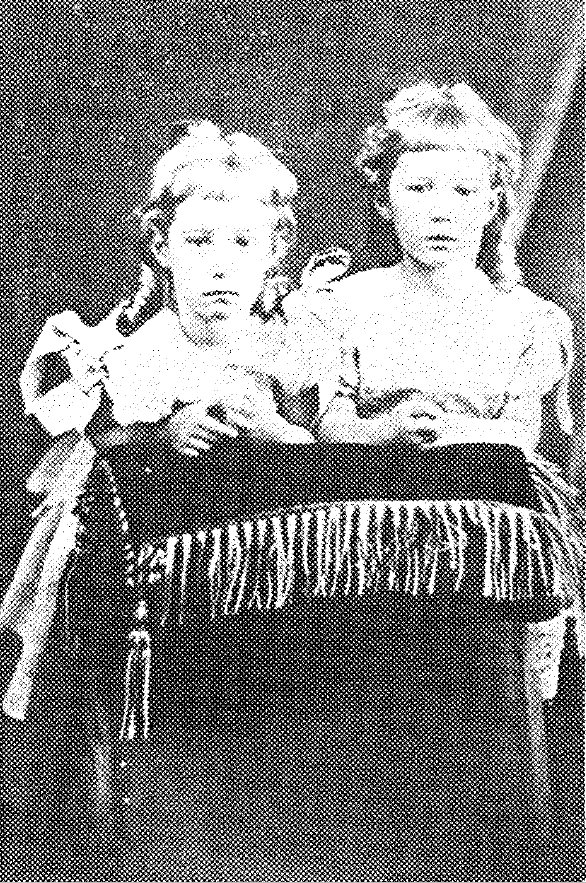
Lily Poulett-Harris (left) and her twin sister, Violet, as children.
A "a bright, inquisitive, adventurous and active child", Lily was schooled by her father and received a Level II mark prize in December 1882. Lily was allowed to sit the major exams as a "trial of strength" in 1884 even though she was not eligible for a scholarship. She came second.
Lily also played the violin at school. She would go on playing this instrument, and also the piano, all of her life, giving occasional public performances at Peppermint Bay and Hobart. For instance, she gave a recital at a church choir fundraising event at her home parish of All Saints in South Hobart less than a year before she died.
When her father retired in 1885, he purchased a hotel at Peppermint Bay (Woodbridge) and converted it into a house which he named "The Cliffs". Lily was to spend her adolescence and young adulthood here.
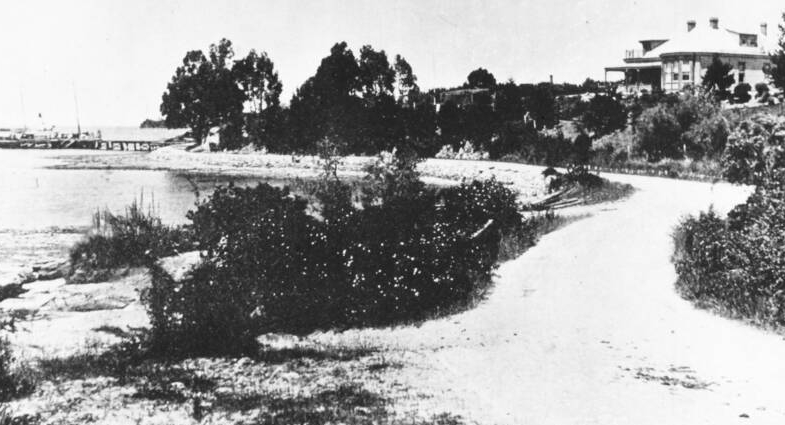
The house at Peppermint Bay where Lily Poulett-Harris grew up. It was formerly a hotel but was purchased by her father and converted into a homestead in 1885. Unknown - Photograph taken late 1880s - Tasmanian Archives
Lily's older brother, Henry Vere Poulett-Harris (1865–1933) was a gifted footballer, runner and cricketer, and represented both Tasmania and Western Australia in first-class cricket in a career spanning the 1883–84 to 1898–1899 seasons. (He later owned a Western Australian gold mine.) One early news report described him as a "sterling cricketer and footballer" whilst another described him as a "sterling batsman and good field."
His obituary states that he was "one of the outstanding athletes in the State, winning great success as a runner, cricketer and footballer. He played cricket for the Wellington Club and was regarded as one of the most graceful batsmen in the State. He was a member of the State team when a youth, and toured New Zealand with the Tasmanian team under the captaincy of the late Sir George Davies. Later he met with success as a batsman on the mainland. He was also a champion footballer and a member of the Cricketers' Football Club, some of his contemporaries being Messrs. W. H. Cundy, L. H. Macleod, K. E. Burn, A. Stuart and G. Watt. As a runner he defeated many of the recognised champions of his day." It was his interest in sport that appears to have spurred Lily on.
Another influence would have been her father who, in 1882, was elected a trustee of the Southern Tasmanian Cricket Association. Furthermore, he encouraged the boys at the high school to compete at sports.
As her own obituary notice states, Lily "was a great admirer of athletic exercises, firmly believing that it was very necessary to develop the physical as well as the mental part of our nature. Cricket had her warm sympathy and support... she was a good horsewoman and cyclist. Fear, it is said, was a thing unknown to her."
Lily's cricket aspirations led her to found a cricket team for local women, the Oyster Cove Ladies' Cricket Club, in 1894. This was, according to a contemporary news report, the first female cricket club in the Australian colonies. She was unanimously elected captain and "she was remarkably successful in piloting her team to many a victory." The other teams that were then established in the league included Atalanta (Hobart Quakers), Heather (Hobart) and North Bruny. The following year, Green Ponds, Ranelagh and Huonville would join the competition. As well as playing each other, the Ladies' team supported male cricketers by providing luncheons for them and playing music at concerts. These were most often held at Kettering's Selby Hall. By the December of the following year, the ladies' competition had become well-established, a Hobart sports journalist noting that "[interest in cricket] seems to be growing, and extending to the weaker sex, who often have a quiet match upon a romantic little plateau on the Domain immediately beyond the upper cricket ground."
Her sporting career is well-documented in the newspapers of the time. She was generally either the opening or third-order batswoman. The early sports journalism of the era consistently praised her performances, with such comments as a "prettily played innings" on one occasion and, on another, "The feature of the match was undoubtedly the fine not out innings of Miss L. Poulett-Harris, captain of the winning team, who, going in first, carried her bat right through the innings for 64 runs."
In May 1894, a Tasmanian correspondent for a Melbourne newspaper reported that "The ladies' cricketing season was concluded at Oyster Cove on 6 May, with a match between the Oyster Cove and North Bruni [sic] clubs, resulting in a win for the local team by an innings and 41 runs. The past season has been very successful, consequently, the outcome has been good cricket and high scoring. The captain of the Oyster Cove C. C., Miss L. Poulett-Harris, heads the batting list with the remarkably good average of 32.6; her batting throughout the season has been very good. She has also the honour of having put up the record for Tasmania, making 64 (not out) in an innings (which included five fours), and 78 in a match. Miss K. Denne, North Bruni C. C., comes next with an average of 18 runs."
In 1895, Lily was described in one match as having "batted in good style, her contribution being well earned for the winners."
She also bowled. On one occasion her bowling was described by the Hobart Mercury's sports journalist as "very good indeed" when she got two opponents out for a total of one run between them.
Lily's older sister, Eleanor (known as Nellie) had taught at the Hobart Ladies' College before teaching at her father's home and then founding the Ladies' Grammar School and Kindergarten at 26 Davey Street in 1894 (opposite Franklin Square). Lily and Violet were both to teach there.
Lily left Peppermint Bay to teach there in December 1894. At the time that she and her sister Nellie left, a newspaper correspondent reported they were presented with a dinner and tea service by local inhabitants, including members of the cricket club. The reporter went on to state "There is a general feeling of regret throughout the district at the Misses Poulett-Harris leaving, as they have always taken a deep interest in the Bay and its institutions and inhabitants, and they carry with them the sincerest wishes of all that they will prosper in the new school life on which they are entering in Hobart."
The teams did not adopt the "rational dress" that had become popular in some women's sports overseas by that time. Rather, "they all appear[ed] in prim summer dresses, and present[ed] a pretty picture."
A fire in October 1896 destroyed most of the Poulett-Harris homestead at Peppermint Bay, including the library. As a result, most of Richard Deodatus Poulett-Harris' papers were lost, including any references to his youngest daughter's life. However, from her obituary and a few other sources, some insights can be gained into her personality.
The obituary states that "Miss Lily was of a mirthful and happy disposition, ever endeavouring to make those with whom she came in contact – and those not a few – cheerful and happy also."
The obituary also contains the following anecdote: "One old man tells how she stopped and obliged by cutting up some tobacco for him, and by many of such little acts and kindnesses, Miss Lily endeared herself to the whole community."
It goes on to quote a member of her cricket team who said that "Fear... was a thing unknown to her."
A memorial plaque dedicated to Lily can be found on the rear wall of All Saints' Anglican Church in South Hobart. Donated by the teachers and students of the Ladies' Grammar School and Kindergarten, it describes Lily as "bright and lovable".
There is also a plaque dedicated to her memory at Saint Simon and Saint Jude Anglican Church in Woodbridge.
.jpg?timestamp=1693642089475) Lily Poulett-Harris died on the evening of 15 August 1897 at the school's 26 Davey Street address after what her obituary described as "a painful illness". Her death certificate indicates it was tubercular peritonitis.
Lily Poulett-Harris died on the evening of 15 August 1897 at the school's 26 Davey Street address after what her obituary described as "a painful illness". Her death certificate indicates it was tubercular peritonitis.
TB went on to claim lots of lives in Hobart during the following years and decades until a treatment was developed in 1937.
Lily was just 23 years and eleven months of age. She was buried at 3:00 pm on 17 August 1897 in an Anglican service at Plot J80, Cornelian Bay Cemetery, Hobart. (Her father and her sister Nellie were later buried in the same plot.)
Although the Oyster Cove Ladies' Cricket Club no longer exists, today Australia has a thriving women's cricket culture, including a national team. Inspired by the success of the Oyster Cove Ladies' Cricket Club and the southern Tasmanian competition, clubs were quickly formed in other parts of Tasmania, such as those at Swansea and Cranbrook on the east coast and Oatlands and York Plains in the midlands.
At the same time as these newer clubs were being created in Tasmania, a Rockhampton Ladies' Club was formed in Queensland. By the end of the 1890s, cricket and rowing two of the most popular competitive sports for women in Australia.
Visit: Rockley Was Cricket For Girls 130 Years Ago - They Visited Narrabeen Too!
Following this, the Victoria Women's Cricket Association was founded in 1905 and the Australian Women's Cricket Association in 1931. The current competition is run by the Women's National Cricket League.
The Ladies' Grammar School and Kindergarten moved to Albuera Street, Battery Point, in 1898 and was run by Nellie Poulett-Harris until her retirement in December 1919, whilst Lily's twin, Violet, went on to become a relatively well-known actress on the Australian theatre circuit, under the stage name 'Mary Milward'.
from TROVE and Wikipedia
Morning At Turimetta Beach
August 29, 2023 - photo by Joe Mills
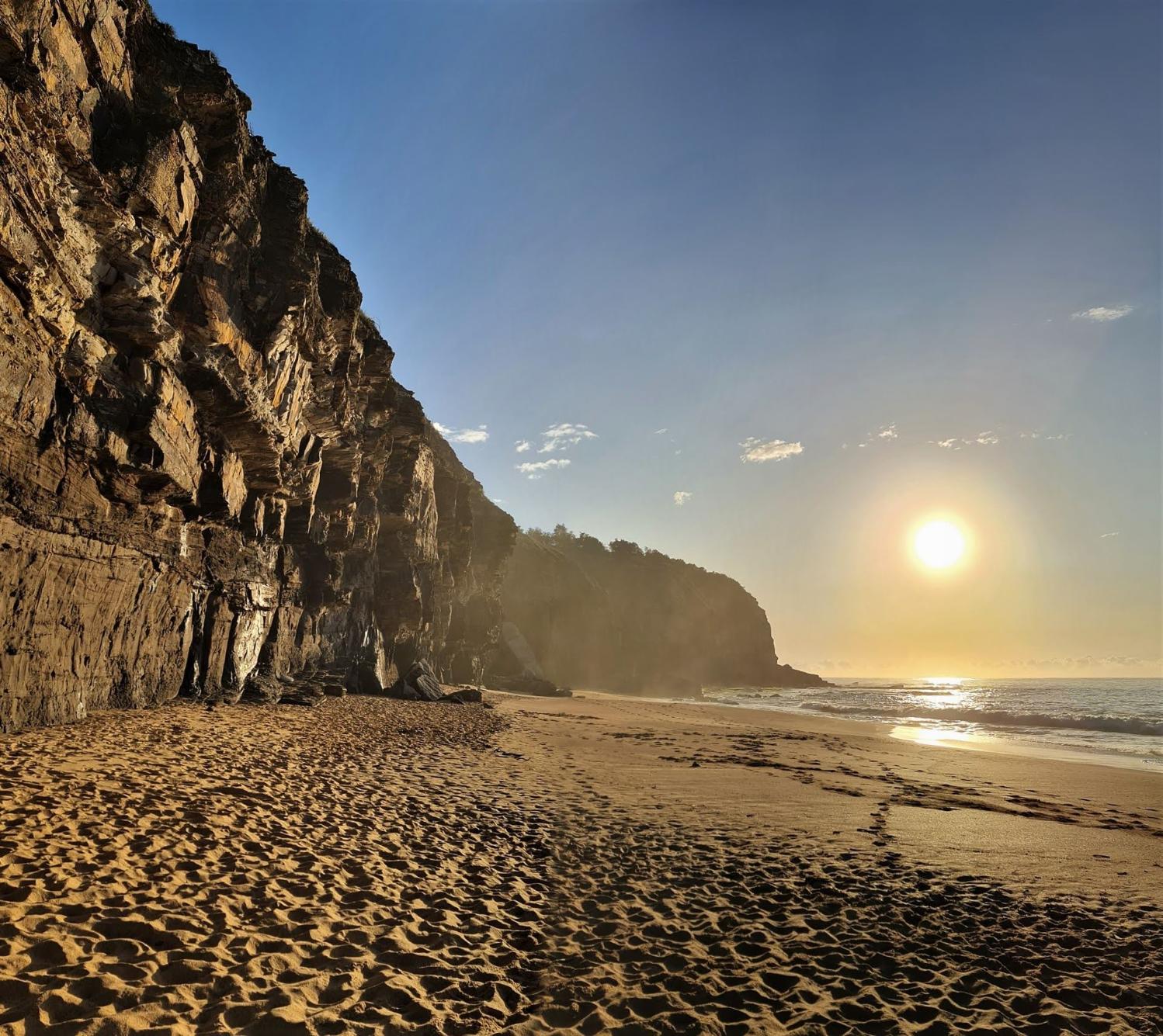
Narrabeen Stillness
August 29, 2023 - photo by Joe Mills
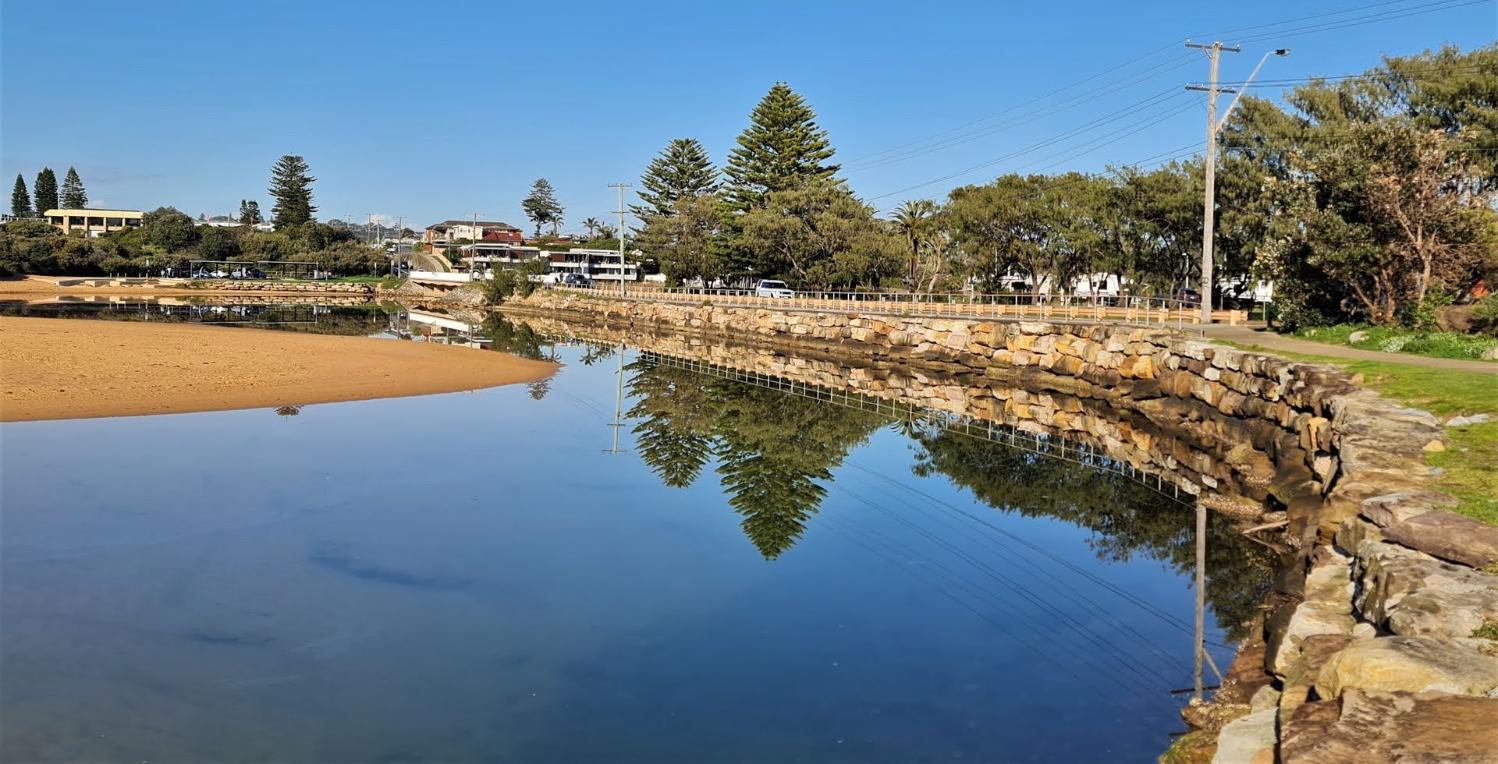
History Of The Harbord Beach Tramline
Royal Prince Alfred Yacht Club Youth Team In Germany
August 31, 2023
They have arrived! Our Youth Development Team are in Kiel, Germany and ready to compete in the SAILING Champions League Youth Final from 1-3 September.
Best of luck to Daniel K (skipper), Isabella H, Lachlan W, Louis T and Hayley F.
You can follow our RPAYC team and other competitors at the official event webpage: https://sailing-championsleague.com/events/youth-final-kiel/
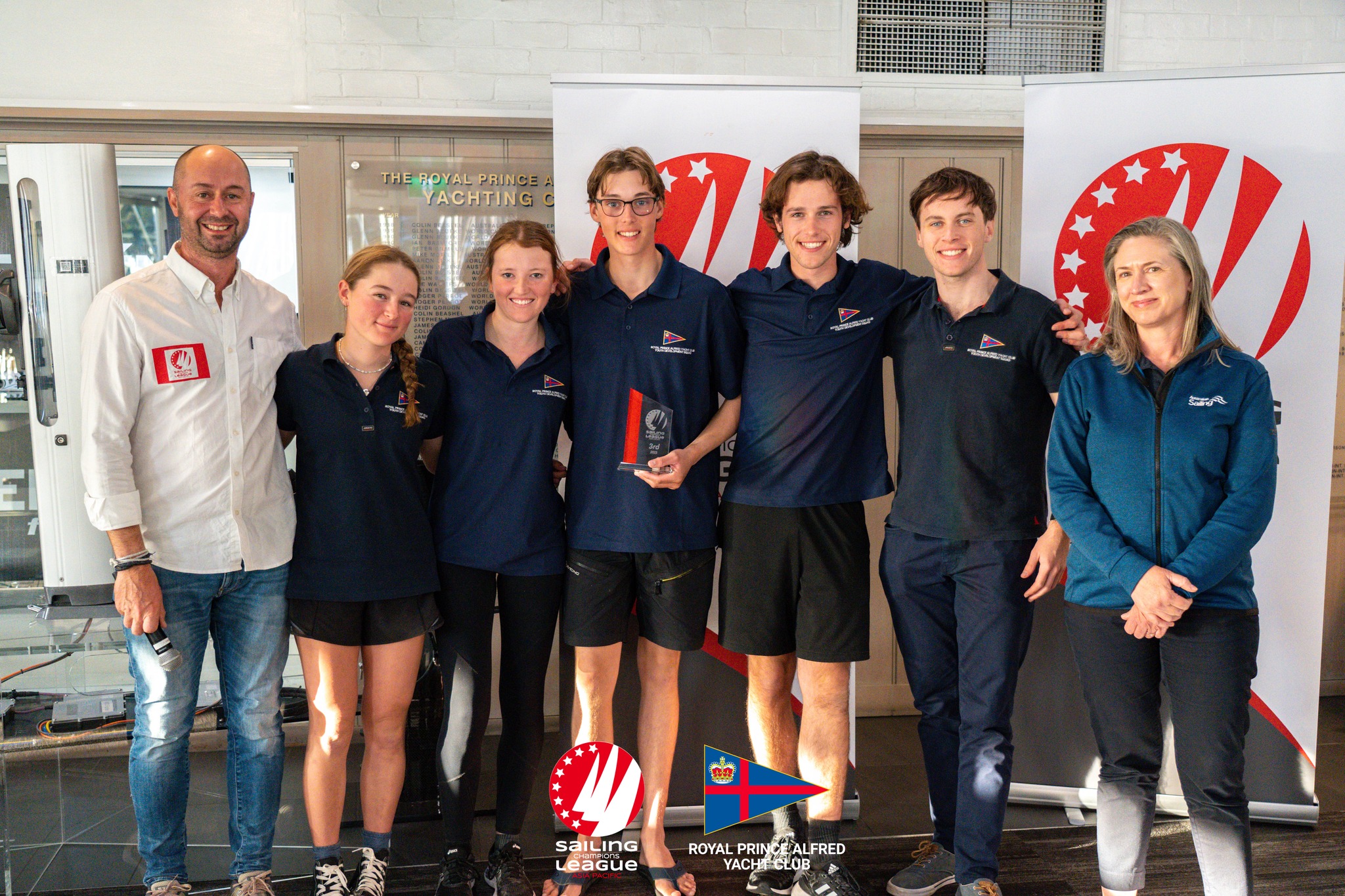

Avalon Beach SLSC Boat Crew Looking For Members
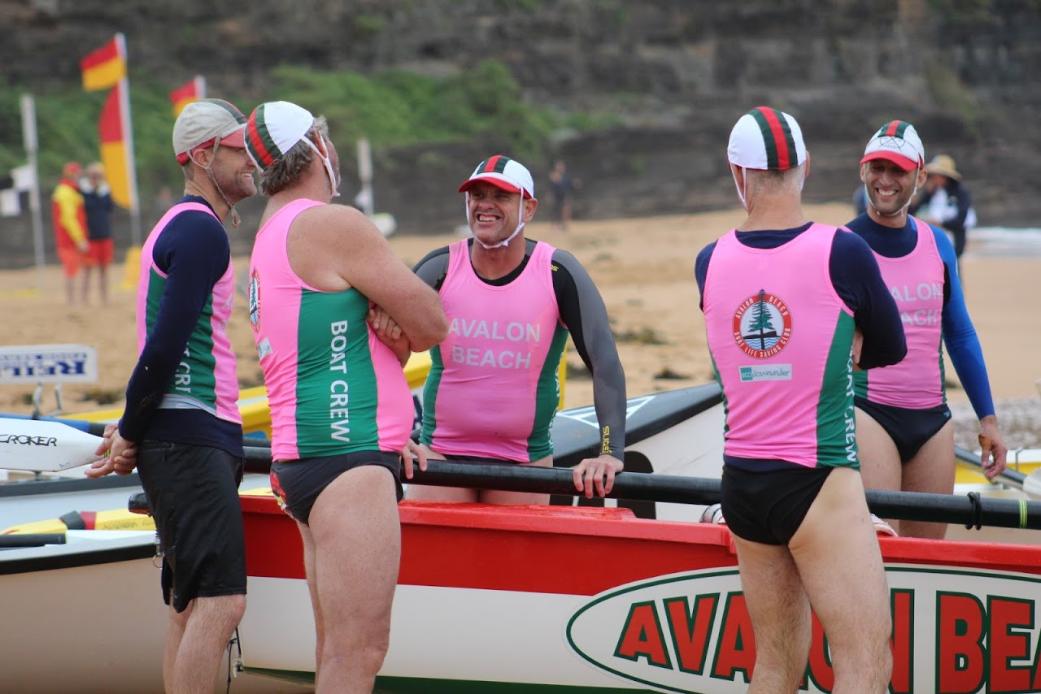


8 Student-Backed Study Tips To Help You Tackle The HSC
By University of Sydney: Last updated 6 July 2023
Our students have been through their fair share of exams and learned a lot of great study tactics along the way. Here they share their top study tips to survive and thrive during exam time.
1. Start your day right
Take care of your wellbeing first thing in the morning so you can dive into your day with a clear mind.
“If you win the morning, you can win the day,” says Juris Doctor student Vee Koloamatangi-Lamipeti.
An active start is a great way to set yourself up for a productive day. Begin your morning with exercise or a gentle walk, squeeze in 10 minutes of meditation and enjoy a healthy breakfast before you settle into study.
2. Schedule your study
“Setting up a schedule will help you organise your time so much better,” says Master of Teaching student Wesley Lai.
Setting a goal or a theme for each study block will help you to stay focused, while devoting time across a variety of subjects will ensure you've covered off as much as possible. Remember to keep your schedule realistic and avoid over-committing your time.
Adds Wesley, “Make sure to schedule in some free time for yourself as well!”
3. Keep it consistent
“Make studying a habit,” recommends Alvin Chung, who is currently undertaking a Bachelor of Arts and Bachelor of Laws.
With enough time and commitment, sitting down to study will start to feel like second nature rather than a chore.
“Do it every day and you’ll be less likely to procrastinate because it’s part of your life’s daily motions,” says Alvin.
4. Maintain motivation
Revising an entire year of learning can seem like an insurmountable task, which is why it’s so important to break down your priorities and set easy-to-achieve goals.
“I like to make a realistic to-do list where I break down big tasks into smaller chunks,” says Bachelor of Arts and Advanced Studies student Dannii Hudec.
“It’s also really important to reward yourself after you complete each task to keep yourself motivated.”
Treat yourself after each study block with something to look forward to, such as a cup of tea, a walk in the park with a friend or an episode of your latest Netflix obsession.
5. Minimise distractions
With so many distractions at our fingertips, it can be hard to focus on the task at hand. If you find yourself easily distracted, an “out of sight, out of mind” approach might do the trick.
“What helps me is to block social media on my laptop. I put my phone outside of my room when I study, or I give it to my sister or a friend to hide,” says Bachelor of Commerce and Bachelor of Laws student Caitlin Douglas.
While parting ways with your phone for a few hours may seem horrifying, it can be an incredibly effective way to stay on task.
“It really helps me to smash out the work and get my tasks done,” affirms Caitlin.
6. Beware of burnout
Think of the HSC period as a marathon rather than a sprint. It might be tempting to cram every single day but pacing out your study time will help to preserve your endurance.
“Don’t do the work for tomorrow if you finish today’s work early,” suggests Daniel Kim, who is currently undertaking a Bachelor of Commerce and Advanced Studies.
“Enjoy the rest of your day and save the energy for tomorrow,” he recommends.
Savouring your downtime will help you to avoid burning out before hitting the finish line.
7. Get a good night's sleep
Sleep is one of your greatest allies during exam season.
“I’ve found that a good night’s sleep always helps with concentration and memory consolidation,” says Bachelor of Science (Medical Science) student Yasodara Puhule-Gamayalage.
We all know we need to be getting around 8 hours of sleep a night to perform at our best, but did you know the quality of sleep also matters? You can help improve the quality of your sleep with some simple tweaks to your bedtime routine.
“Avoid caffeine in the 6 hours leading up to sleep, turn off screens an hour before going to bed, and go to bed at the same time every night,” suggests Yasodara.
8. Be kind to yourself
With exam dates looming and stress levels rising, chances are high that you might have a bad day (or a few!) during the HSC period.
According to Bachelor of Arts and Advanced Studies student Amy Cooper, the best way to handle those bad days is to show yourself some kindness.
“I know that if I’m in a bad state of mind or having a bad day, I’m not going to be able to produce work that I’m proud of,” she says.
For Amy, the remedy for a bad day is to take some time to rest and reset.
“It’s much more productive in the long run for me to go away, do some things I love, and come back with a fresh mind.”
Immerse yourself in a mentally nourishing activity such as going for a bushwalk, cooking your favourite meal, or getting stuck into a craft activity.
If you feel completely overwhelmed, know you're not alone. Reach out to a friend, family member or teacher for a chat when you need support.
There are also HSC Help resources available at: education.nsw.gov.au/student-wellbeing/stay-healthy-hsc
Wednesday 11 October, 2023: HSC written exams start.
School Leavers Support
- Download or explore the SLIK here to help guide Your Career.
- School Leavers Information Kit (PDF 5.2MB).
- School Leavers Information Kit (DOCX 0.9MB).
- The SLIK has also been translated into additional languages.
- Download our information booklets if you are rural, regional and remote, Aboriginal or Torres Strait Islander, or living with disability.
- Support for Regional, Rural and Remote School Leavers (PDF 2MB).
- Support for Regional, Rural and Remote School Leavers (DOCX 0.9MB).
- Support for Aboriginal and/or Torres Strait Islander School Leavers (PDF 2MB).
- Support for Aboriginal and/or Torres Strait Islander School Leavers (DOCX 1.1MB).
- Support for School Leavers with Disability (PDF 2MB).
- Support for School Leavers with Disability (DOCX 0.9MB).
- Download the Parents and Guardian’s Guide for School Leavers, which summarises the resources and information available to help you explore all the education, training, and work options available to your young person.
School Leavers Information Service
- navigate the School Leavers Information Kit (SLIK),
- access and use the Your Career website and tools; and
- find relevant support services if needed.
Word Of The Week: Concert
Noun
1. a musical performance given in public, typically by several performers or of several compositions. 2.FORMAL; agreement or harmony. 3. in concert — acting jointly; arrange (something) by mutual agreement or coordination.
Verb; concert; 3rd person present: concerts; past tense: concerted; past participle: concerted; gerund or present participle: concerting
From: late 16th century (in the sense ‘unite’): from French concerter, from Italian concertare ‘harmonize’. The noun use, dating from the early 17th century (in the sense ‘a combination of voices or sounds’), is from French concert, from Italian concerto, from concertare; "to contend with zealously, contest, dispute, debate" from assimilated form of com "with" (see con-) + certare "to contend, strive," frequentative of certus, variant past participle of cernere "separate, distinguish, decide"
‘So many things to consider’: how to help school leavers decide what to do next

As we pass the half way mark in term 3, many students in Year 12 will be thinking more and more about their future.
Universities and TAFEs are having open days and no doubt, teachers, friends and family will be asking, “what are you going to do next year?”
As educators, parents and carers, we know these are difficult questions. But if anything, they are becoming more difficult for young people in an unpredictable and competitive job market
Our research shows young people are uncertain and worried about next steps after school. So we have also developed a questionnaire to help parents and teachers talk to school leavers and understand their thoughts and feelings about careers and life after school.
Our Research
We recently analysed survey data collected in 2018 from nearly 2,800 Victorian school students in Years 10 to 12. This asked about their career aspirations, decision-making processes and intentions following school.
More than one third (33.8%) “agreed” or “strongly agreed” they “did not know what careers best suited them”. Another 40.5% often felt they “had no career direction”.
Just under half (41.5%) worried their studies would not lead to a “real” career, with 34.3% worried they would not be employable when they had completed their studies. Meanwhile 29% “agreed” or “strongly agreed” they often felt down or worried about selecting a career. This increased to 59.3% of respondents when “not sure” responses were included.
‘Overwhelming’
To further understand these findings, we asked four young people who had recently finished school to explain their decision making around this time.
Riana*, who studied at university before working with a non-government organisation, said thinking about the next step beyond Year 12 “felt overwhelming”. She spoke of indecision about her career choice.
Meanwhile, Candice said she was aware of needing to make a pragmatic decision but also stay true to her interests.
[…] there were so many things to consider. I would like to pick a major I like but at the same time I need to consider whether it is easy to find a job after I graduate or will it lead to a well-paid job.
Andrew said he made a clear goal of getting into two, specific different degrees (and a certain ATAR) to combat his feelings of overwhelm.
I knew I needed to have a goal before beginning Year 12. Otherwise it would be too difficult to maintain momentum and motivation.
Andrew also told us he sought advice from parents, teachers, university open days and student recruitment officers at universities. Riana also spoke of the importance of getting advice, of exploring options and being “curious different career pathways”.
Reaching For The Familiar
But even when goals are in place, students grapple with uncertainty. This leads many students to reach for what is familiar.
After completing Year 12, Yasmin, lacked “a clear vision for my future career” and chose teaching “simply because it was a familiar job to me”.
Yasmin’s experience is echoed in OECD research, which shows teenagers tend to confine their choices to ten occupational fields (law, engineering, psychology, medicine, teaching, veterinary science, physiotherapy, nursing, business management, architecture). This is despite the emergence of new fields in the digital economy, as well as growth in areas such as health services.
Yasmin now said she would have benefited from “having a deeper understanding of what choosing a major and a career path truly means to me”.
How To Have A Supportive Conversation
Having supportive, thorough career conversations is important for young people. This helps them express their true feelings and make sense of all the information and choices.
When young people have these conversations with parents, teachers and career advisers, they have lower levels of career uncertainty and anxiety.
So we have developed the short questionnaire below to stimulate careers conversations and help teenagers become more aware of their feelings around next steps.
This can be the starting point of a conversation covering young people’s awareness of their own interests and strengths, career goals and preferences, knowledge of the requirements of different pathways, as well as their ideas about transitioning from education to work.
These conversations can be challenging. They might exacerbate personal issues, such as existing mental health conditions, that need to be considered.
If you work together with your child or student to create goals and plans, this will allow them to feel as if the conversations are both purposeful and productive.
The aim is for conversations to be safe and positive for young people, where their responses are respected, and they feel heard in the discussions.
*Names have been changed.
If you are a child, teenager or young adult who needs help and support, you can call Kids Helpline on 1800 55 1800.![]()
Lucas Walsh, Professor and Director of the Centre for Youth Policy and Education Practice, Monash University and Joanne Gleeson, Research Fellow in Education, Monash University
This article is republished from The Conversation under a Creative Commons license. Read the original article.
How ‘dad jokes’ may prepare your kids for a lifetime of embarrassment, according to psychology

This Father’s Day you may be rolling out your best “dad jokes” and watching your children laugh (or groan). Maybe you’ll hear your own father, partner or friend crack a dad joke or two. You know the ones:
What is the most condescending animal? A pan-DUH!
Why don’t scientists trust atoms? Because they make up everything!
Yes, dad jokes can be fun. They play an important role in how we interact with our kids. But dad jokes may also help prepare them to handle embarrassment later in life.
What Are Dad Jokes?
Dad jokes are a distinct style of humour consisting of puns that are simple, wholesome and often involve a cheesy delivery.
These jokes usually feature obvious wordplay and a straightforward punchline that leaves listeners either chuckling or emitting an exaggerated groan.
This corny brand of humour is popular. There are hundreds of websites, YouTube videos and TikToks dedicated to them. You can even play around with dad joke generators if you need some inspiration.
Why Are Dad Jokes So Popular?
People seem to love dad jokes, partly because of the puns.
A study published earlier this year found people enjoy puns more than most other types of jokes. The authors also suggested that if you groan in response to a pun, this can be a sign you enjoy the joke, rather than find it displeasing.
Other research shows dad jokes work on at least three levels:
1. As tame puns
Humour typically violates a kind of boundary. At the most basic level, dad jokes only violate a language norm. They require specific knowledge of the language to “get” them, in a way a fart joke does not.
The fact that dad jokes are wholesome and inoffensive means dads can tell them around their children. But this also potentially makes them tame, which other people might call unfunny.
2. As anti-humour
Telling someone a pun that’s too tame to deserve being told out loud is itself a violation of the norms of joke-telling. That violation can in turn make a dad joke funny. In other words, a dad joke can be so unfunny this makes it funny – a type of anti-humour.
3. As weaponised anti-humour
Sometimes, the purpose of a dad joke is not to make people laugh but to make them groan and roll their eyes. When people tell dad jokes to teasingly annoy someone else for fun, dad jokes work as a kind of weaponised anti-humour.
The stereotypical scenario associated with dad jokes is exactly this: a dad telling a pun and then his kids rolling their eyes out of annoyance or cringing from embarrassment.
Dad Jokes Help Dads Be Dads
Dad jokes are part of a father’s toolkit for engaging with his loved ones, a way to connect through laughter. But as children grow older, the way they receive puns change.
Children at around six years old enjoy hearing and telling puns. These are generally innocent ones such as:
Why is six afraid of seven? Because seven ate nine!
As children age and their language and reasoning abilities develop, their understanding of humour becomes more complex.
In adolescence, they may start to view puns as unfunny. This, however, doesn’t stop their fathers from telling them.
Instead, fathers can revel in the embarrassment their dad jokes can produce around their image-conscious and sensitive adolescent children.

In fact, in a study, one of us (Marc) suggests the playful teasing that comes with dad jokes may be partly why they are such a widespread cultural phenomenon.
This playful and safe teasing serves a dual role in father-child bonding in adolescence. Not only is it playful and fun, it can also be used to help educate the young person how to handle feeling embarrassed.
Helping children learn how to deal with embarrassment is no laughing matter. Getting better at this is a very important part of learning how to regulate emotions and develop resilience.
Modelling the use of humour also has benefits. Jokes can be a useful coping strategy during awkward situations – for instance, after someone says something awkward or to make someone laugh who has become upset.
Dad Jokes Are More Than Punchlines
So, the next time you hear your father unleash a cringe-worthy dad joke, remember it’s not just about the punchline. It’s about creating connections and lightening the mood.
So go ahead, let out that groan, and share a smile with the one who proudly delivers the dad jokes. It’s all part of the fun.![]()
Shane Rogers, Lecturer in Psychology, Edith Cowan University and Marc Hye-Knudsen, Cognition and Behavior Lab, Aarhus University
This article is republished from The Conversation under a Creative Commons license. Read the original article.
‘Emu Men’: a new way to recognise and celebrate Indigenous fathers
Bhiamie Williamson, Monash UniversityFather’s Day is an opportunity to celebrate men who have shaped and inspired us.
For many Indigenous peoples, this includes our biological father, adopted fathers, as well as our grandfathers, uncles, brothers, cousins, friends, and more.
Yet Indigenous fatherhood is a contentious topic in white Australia. Even today, mainstream perceptions often frame Indigenous men as dangerous, vagrant and neglectful.
These false representations can be deeply damaging to the psyche of Indigenous men, and potentially erode the fabric of our communities.
Indigenous fathering has emerged as a key priority in my research examining Indigenous men and masculinity. It is a topic of immense personal importance to me as a Euahlayi (Yuwaalaraay) man, a son, brother, uncle, husband and father.
Indigenous Traditions Of Fathering
Stories of fathers are as old as Indigenous societies. Many First Nations in southeastern Australia continue to hold and transmit stories of the Creator, or All-Father, known in different places as Bhiamie, Bunjil or Dharamulan.
Fathering traditions are also evident in some Indigenous languages and kin structures. It is common for some Indigenous children to have not one father but many. This was particularly the case for a child’s patrilineal uncle, who is also known to the child as father.
In the late 1700s, some European explorers observed and recorded the centrality of fathering in Indigenous societies. For example, New South Wales Judge-Advocate David Collins observed Bennelong, a senior Eora man, returning from an outing with his sister’s child on his shoulders before cooking fish while his sisters and their children slept and ate oysters in the sun.
In 1793, Bruny D’Entrecasteaux “witnessed the tokens of tenderness that these simple and kind men displayed towards their children” in Port du Nord, Tasmania.
The evidence of Indigenous fathering in historical accounts can be hard to uncover because it appeared to be so everyday and unremarkable to Europeans and anthropologists. Yet casting an eye over these various recordings of history, from both Indigenous and European records, reveals the existence of strong, consistent and widespread traditions of care, nurture and love between Indigenous fathers and their children.
Breaking The Bonds Of Fatherhood
Colonisation significantly impacted all Indigenous societies. The introduction of foreign diseases, violent frontier conflict, removal of people from Country, and removal of children are well established historical truths.
There were also colonial impacts on Indigenous families. Colonisation caused disruptions to Indigenous fathering in many ways.
Economic conditions meant many Indigenous men were forced to be away from their children for extended periods, such as when working in pastoral or pearling industries.
Legally, Indigenous fathers were replaced as agents of care and responsibility through various protection acts in Australia’s colonies. Discourses of “protection” broke apart Indigenous families, which affected mothers, fathers and extended family and their roles caring for their children.
Introducing rations removed important roles as hunters and providers. Notwithstanding some men who did continue to hunt, these traditional sources of food were supplementary to the rations provided by colonial and religious authorities.
Social And Political Assaults On Indigenous Men As Fathers
Last week, references to Indigenous men as “violent black men” and ‘woman bashers" were heard at the CPAC conference.
The racist cartoon by the late Bill Leake showed that even as recently as 2016, a mainstream media outlet such as The Australian considered it acceptable to ridicule and denigrate Indigenous fathers.
The 2007 Northern Territory Intervention demonstrates how demonising Indigenous men can be used as a political weapon. This was done by portraying Indigenous men as neglectful, violent, unsafe, and in need of heavy-handed government responses. “You’ve got to instil responsiblity,” said the then prime minister John Howard.
Positive Representations Of Indigenous Dads Matter
In response to Leake’s cartoon, #IndigenousDads trended on social media platforms. These intensely personal homages of Indigenous fathers presented an antidote to the tsunami of negativity towards Indigenous fathers.
Other important representation of Indigenous men have been through the publication of the book Dear Son by Thomas Mayo, as well as a range of children’s books by men including Adam Goodes, Meyne Wyatt and Briggs. Indigenous performers such as Luke Carroll and Hunter Page-Lochard now feature regularly on the ABC’s Play School.
It is clear Indigenous fathering carries its own meaning and interpretation. Features such as sharing of fathering roles, transmission of culture, the making of young boys into men, and the public affection and displays of love fathers share with children.
I draw from the gendered patterns of Emus to describe these deep constitutions of fathering. Emus are unique in their gendered patterns. During nesting season female emus lay the eggs, but it is the male emus that sit on the nests to warm the eggs and keep them safe. After the eggs hatch, the male emu rears the chicks, raising them into adulthood.
Emus are especially important to some Indigenous groups across Australia. For many, they are creation beings and an important totem. They offer food and resources such as feathers, eggs, and ointments made from fat.
I suggest a new term – “Emu Man” – as an apt description of these deeply embedded Indigenous male roles. This unique and deeply Indigenous masculinity is highly valued and integral to healthy communities.
This Father’s Day, let’s all acknowledge and honour the unique place of Indigenous fathers, and celebrate their place in our families, and contributions to healthy communities.
Let the land blossom with Emu Men once more.![]()
Bhiamie Williamson, Research Fellow, Monash University
This article is republished from The Conversation under a Creative Commons license. Read the original article.
The curious history of London’s public drinking water fountains

Drinking fountains are a common sight in London today, but they’re a relatively recent addition to the city. Until the mid-19th century, Londoners quenched their thirst by supping beer in pubs rather than guzzling water on the streets. As temperatures heat up, it’s a good time to review the history and politics that lie behind a cooling swig of drinking fountain water in the UK’s capital city.
Our ongoing archival research, part of a project on London’s water history and politics, explores the movement that inspired the construction of public drinking fountains at a remarkable rate in the late 19th century.
Some 40 years after the first fountain was opened in Holborn in 1859, over 500 had been installed across the city. They supplied free drinking water to the masses, and reinvigorated London’s public spaces.
The rapid expansion of water fountains was connected to the limits of London’s privatised water network. Echoing criticism of water companies today, the private firms that supplied London’s drinking water in the 19th century prioritised profits over investment in infrastructure. As a result, the quality and coverage of water services suffered.
From the 1850s, pioneering medical research linked cholera epidemics to polluted water and demonstrated the public health risks of London’s water network.
The expansion of drinking water fountains was one response to these mounting concerns about London’s unequal and, as the cholera research showed, sometimes dangerous water supply. The fountains made it easier to access clean drinking water in the city, especially for the working classes, who often lacked reliable and safe water at home.
The thousands of homeless men, women and children who lived in desperate conditions on London’s streets also benefited.
Quenching London’s Thirst
The Metropolitan Free Drinking Fountains Association was established in 1859 to erect and manage London’s new fountains. Samuel Gurney, a banker and politician, was the driving force behind the association and channelled significant sums of his own money into it. He was joined by a motley crew of politicians, doctors, lawyers and engineers, who helped run and promote the association in the late 19th century.
Funding for individual fountains came from various sources, including wealthy benefactors, local governments and multiple contributions from local residents.
Designs varied but one common, if not universal, feature was the name of the person who provided the bulk of the funding and some form of Biblical messaging. Building fountains thus became a popular way for philanthropists to gain social prestige while also showing religious piety.
The inclusion of religious scriptures and symbols indicates the moralising and evangelising mission of many members of the drinking fountain movement. If pubs were a corrupting force, drinking fountains were a way of purifying the souls of the working class.
The association also catered for animals by including dog troughs in fountains and building standalone structures for horses and cattle. In 1867, the association changed its name to the Metropolitan Drinking Fountain and Cattle Trough Association to reflect its wider remit.
While drinking fountains expanded rapidly in the late 19th century, London was slow off the mark and lagged behind several other UK cities, including Aberdeen, Derby and Chester.
Edward Thomas Wakefield, a barrister and founding member of the association, singled out Liverpool for special attention. In his 1859 essay “A Plea for Free Drinking Fountains in the Metropolis”, he noted that on one “fine hot day” in June 1855, a single fountain was used more than 3,000 times in Liverpool.
Once installed, London’s fountains proved to be even more popular, especially on hot summer days. Take one example: on July 4 and 5 1865, the association recorded 5,603 drinkers using the Royal Exchange fountain. There were more than 500 per hour during the early afternoon, and a steady flow throughout the day and night.
Drinking fountains clearly provided ample opportunities for Londoners to engage in one of their favourite pastimes – queuing.
Nevertheless, drinking fountains were not universally welcomed, perhaps because of their moralising tendencies. The association noted in its 1874 annual report that the structures were “peculiarly exposed to thoughtless or malicious injury”, and security staff were at times employed to prevent theft and vandalism.

Public Water, Private Interests
If the public drinking fountain movement shows what is possible when people mobilise around water, it also points to the limits of philanthropic organisations; limits that became more pronounced at end of the 19th century.
The association lost much of its radical zeal, became more conservative in orientation, and struggled financially as donations dried up. The construction of new fountains slowed and the maintenance of existing fountains deteriorated.

It was not until private water companies were brought under public control in the early 20th century that London’s water crisis began to ease, indicating the need for decisive public interventions alongside more piecemeal social initiatives.
Victorian drinking fountains continue to adorn London’s streets and several have been restored to their former glory. Alongside them, a new generation of drinking fountains have emerged, many of which have been designed to reduce the use of plastic bottles.
Rather than including the names of wealthy benefactors and religious inscriptions, these fountains are often emblazoned with the name and logo of the private water company that helped fund them. Once again, we see how providing public water can also serve private interests.![]()
Geoff Goodwin, Lecturer in Global Political Economy, University of Leeds and Jon Winder, Researcher in History, University of Leeds
This article is republished from The Conversation under a Creative Commons license. Read the original article.
Jewish creators are a fundamental part of comic book history, from Superman to Maus – expert explains

Jewish writers and artists have been a fundamental part of comic book creation since the early days of the industry.
Comic books used to be formatted like books or newspapers, but in 1934 Max Gaines, a Jewish New Yorker, and his colleague Harry Wildenberg, created the first half tabloid-sized comic book – the format that became the standard.
Their Famous Funnies comic book sold 90% of the 200,000 printed copies. This led to numerous imitators, including New Fun Comics from National Allied Publications (later renamed DC Comics), which published its first issue in 1935.
Gaines was a former schoolteacher and channelled this into his work. He named his company Educational Comics, with such titles as Picture Stories from the Bible. However, when his son William took over E.C. Comics in the 1940s it became notorious as a publisher of horror comics and these were banned in the following decade.
In the 1930s, comic books reprinted comic strips that had previously appeared in newspaper humour sections. Famous Funnies, for example, included the popular serial Mutt and Jeff. But by the end of the decade, they featured entirely new content in a variety of genres, including superheroes.
The first, and most famous, of these was Superman. The character was created by Jerry Siegel and Joe Shuster in 1933 in a self-published comic. They tried to find a professional publisher to take on their character and – after Gaines took too long to reply to them – found a home for Superman at National in 1938.
Siegel and Shuster were sons of Jewish European immigrants, leading some modern comic book writers to compare Superman’s alien immigrant identity to other émigrés in America. The International Rescue Committee noted the importance of the character for the antisemitic era of the 1930s: “Superman’s story is the ultimate example of an immigrant who makes his new home better.”
Some researchers believe that Siegel and Shuster were specifically inspired by a famous Polish bodybuilder called “the Jewish Superman”, who toured America in the 1920s. Writer Roy Schwartz also sees elements of Jewish mythology in the character, as noted in his 2021 book Is Superman Circumcised?.

A year later, another iconic DC character, Batman, was created by Bob Kane and Bill Finger. They were also children of immigrants and were half of a quartet of famous Jewish comic creators who went to the same school in the south Bronx, including Will Eisner and Marvel’s Stan Lee.
While Batman doesn’t have any obvious Jewish characteristics, Bruce Wayne’s cousin, Kate Kane (aka Batwoman) was later depicted as a Jewish woman.
Known for working with Stan Lee, another Jewish creator is considered the “greatest storyteller” of superhero comics. Artist Jack Kirby was responsible for co-creating not only some of the most memorable Marvel characters – including The Avengers and The X-Men – but also had an acclaimed run as a solo creator in the 1970s, first on Marvel’s Eternals and then on DC Comics’ Fourth World titles.
Other Genres
Alongside superheroes, Kirby was renowned for his work on comics written by Sandman’s Joe Simon. Together, they brought romance to the medium in 1947 and made memorable monster comics in the 1960s. Another popular genre was mystery comics. Will Eisner’s The Spirit (1940) included elements of superheroes and horror. The main character was an undead private detective who wore a mask.
Eisner was also the child of Jewish immigrants and towards the end of his career, turned his upbringing into semi-autobiographical comics that depicted the downtrodden existence of people in poor Hassidic communities in New York.
Eisner’s works, including A Contract with God (1978) and several follow-ups in the 1980s, not only popularised the term “graphic novel”, but also added to the increasing trend of turning Jewish lives in comics.
In the 1970s, a number of notable female Jewish creators first had their work published in Underground Comix, including Trina Robbins, Diane Noomin and Aline Kominsky-Crumb.
The only graphic novel to win a Pulitzer prize – Maus – tells the story of author Art Spiegelman’s father’s experience in a concentration camp, and started to be serialised in 1980.

Modern Jewish Comics
Today, many Jewish creators are making graphic novels and cartoons. Comics editor Corinne Pearlman drew a popular strip Playing the Jewish Card in the 1990s and now edits graphic novels. She and other creators were featured in the 2011 exhibition and book Graphic Details: Confessional Comics by Jewish Women, curated by graphic novelist Sarah Lightman.
Lightman is one of the editors of a new follow-up anthology, Jewish Women in Comics: Borders and Bodies. Other British female creators include Karrie Fransman, who makes comics about refugees and victims of gender-based violence, and musician and cartoonist Danny Noble who has illustrated children’s books by Adrian Edmondson.
Until September 3, The Jewish Community Centre London in Hampstead has a solo exhibition of caricatures of Jewish celebrities such as Nigella Lawson and Daniel Radcliffe by Zoom Rockman. Rockman started his career as one of the youngest published cartoonists in the UK, with his own self-published comic, before going on to draw strips for The Beano and Private Eye.
Other creators have had their autobiographical comics animated, such as cartoonist and musician Carol Isaacs’ The Wolf of Baghdad and the life of Charlotte Saloman, author of proto-graphic novel Life? or Theatre?.
With attention being brought to the work of numerous Jewish comic creators through film adaptations, books and exhibitions like these, it seems that their contribution to the medium is finally being recognised.
Looking for something good? Cut through the noise with a carefully curated selection of the latest releases, live events and exhibitions, straight to your inbox every fortnight, on Fridays. Sign up here.![]()
Alex Fitch, Lecturer and PhD Candidate in Comics and Architecture, University of Brighton
This article is republished from The Conversation under a Creative Commons license. Read the original article.
What would an ancient Egyptian corpse have smelled like? Pine, balsam and bitumen – if you were nobility
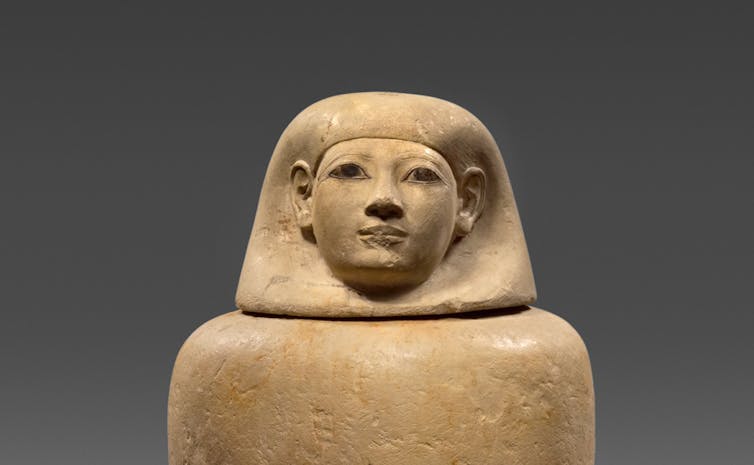
In 1900 – some 22 years before he discovered the tomb of Tutankhamen – British archaeologist Howard Carter opened another tomb in the Valley of the Kings. In tomb KV42, Carter found the remains of a noblewoman called Senetnay, who died around 1450 BCE.
More than a century later, a French perfumer has recreated one of the scents used in Senetnay’s mummification. And the link between these two events is our research, published today in Scientific Reports, which delves into the ingredients of this ancient Egyptian balm recipe.
Recreating The Smells Of A Disappeared World
Our team drew upon cutting-edge technologies in chemistry to reconstruct ancient scents from jars of Senetnay found in the tomb.
We used three variations of chromatographic and mass spectrometric techniques, which work by breaking samples down into individual molecules. Specific substances have different assemblages of molecules. Based on these characteristic compounds and through comparison to known reference materials, we identified the different ingredients.
After the excavation by Carter, two of Senetnay’s jars recovered from the tomb made their way to Germany. So, in 2020, we approached the Museum August Kestner in Hannover about the possibility of analysing the jars with these new methods.
These jars are known as canopic jars. They are made of limestone and were used to store the mummified organs of the ancient Egyptian elite. Somewhere along the way, however, Senetnay’s jars lost their contents. All that remained of the mummified organs were faint residues on the bottom of the jars.
Remarkably, chemical analyses allow scientists to take such trace remains and reconstruct the original contents.
An Ancient Ingredients List
Our analysis revealed the balms used to coat and preserve Senetnay’s organs contained a blend of beeswax, plant oil, fats, bitumen, an unidentified balsamic substance, and resins from trees of the pine family (most likely larch).
One other substance was narrowed down to either a resin called dammar – found in coniferous and hardwood trees in South-East and East Asia – or Pistacia tree resin.
The results were exciting; these were the richest and most complex balms ever identified for this early time period. It was clear a lot of effort had gone into making the balms. This suggests Senetnay, who was the wet nurse of the future Pharaoh Amenhotep II, had been an important figure in her day.
The findings also contribute to growing chemical evidence that the ancient Egyptians went far and wide to source ingredients for mummification balms, drawing on extensive trade networks that stretched into areas beyond their realm.
Since trees of the pine family are not endemic to Egypt, the possible larch resin must have come from somewhere further afield, most likely Central Europe.
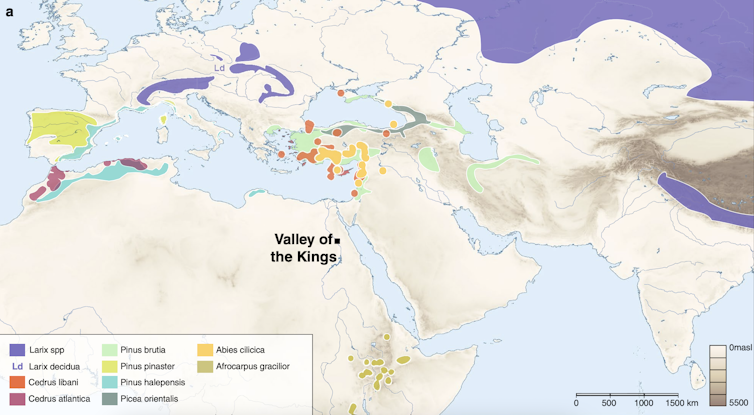
The most puzzling ingredient was the one identified as either Pistacia or dammar resin. If the ingredient was Pistacia – which is derived from the resin of pistachio trees – it likely came from some coastal region of the Mediterranean. But if it was dammar, it would have derived from much farther away in South-East Asia.
Recent analysis of balms from the site of Saqqara identified dammar in a later balm dating to the first millennium BCE. If the presence of dammar resin is confirmed in Senetnay’s case, this would suggest ancient Egyptians had access to this South-East Asian resin via long-distance trade, almost a millennium earlier than previously thought.
A Perfume For The Ages
Senetnay’s balm would not only have scented her remains, but also the workshop in which it was made and the proceedings of her burial rites – perfuming the air with pine, balsam, vanilla and other exotic notes. The vanilla scent comes from a compound called coumarin, and from vanillic acid, and in this case likely reflects the degradation of woody tissue.
Due to the volatile nature of scents, however, Senetnay’s unique scents gradually vanished once her remains were deposited in the Valley of the Kings.
Earlier this year, we began a collaboration with perfumer Carole Calvez and sensory museologist Sofia Collette Ehrich to bring Senetnay’s lost scent back to life.
The results of this effort will go on display at the Moesgaard Museum in Denmark in October, as part of its new exhibition: Egypt – Obsessed with Life.
The new olfactory display will be like a time machine for the nose. It will provide a unique and unparalleled window into the smells of ancient Egypt and the scents used to perfume and preserve elite individuals such as Senetnay.
Such immersive experiences provide new ways of engaging with the past and help broaden participation, particularly for visually impaired people.![]()
Nicole Boivin, Professor, Max Planck Institute of Geoanthropology and Barbara Huber, Doctoral Researcher, Department of Archaeology, Max Planck Institute of Geoanthropology
This article is republished from The Conversation under a Creative Commons license. Read the original article.
Friday essay: traps, rites and kurrajong twine – the incredible ingenuity of Indigenous fishing knowledge
Anna Clark, University of Technology SydneyStanding on a ferry chugging across Sydney Harbour, it’s still possible to imagine the city as it was in 1788 – before the span of the bridge, before the marinas and yachts, before buildings were planted onto that sloping, rocky landscape. Pockets of bush still reach down towards the water, where gums and angophoras curl around sandstone coves carved out by the sea water.
Ferries stop at Mosman, Manly and Milsons Point, where fishers share the wharf with boats and commuters. They perch on folding chairs next to white buckets of bait, or they plonk down on the wooden beams, rod in hand, their legs dangling over the edge as they sit.
Yet these places were also occupied, named and fished, long before “Sydney” appeared on any charts. And it’s at one of these harbour places, at Kay-ye-my, or perhaps Goram Bullagong (present-day Manly Cove and Mosman Bay), that our first story of Indigenous fishing is set. (After all, Kiarabilli or Kiarabily – the site of present-day Milsons Point and Kirribilli – is believed to translate into English as “good fishing spot”.)
Malgun – the amputation of the joint of a young girl’s left little finger – is one of many Aboriginal fishing rites that took place and was practised along much of the east coast of what’s now known as Australia. Across the continent, diverse and adaptable fishing practices, recipes and rituals were a cornerstone of Indigenous life at the time of first contact – and many remain so to this day.
Like keeparra (the knocking out of teeth) and scarification, malgun is a custom rich with significance, an offering to the spirits. In this case, the little girl would be forever linked with the fish she had literally fed. And as these girls grew into women, that connection to the underwater world was thought to offer good fortune and prowess with a fishing line.
It’s thought that malgun was also about the practicalities of fishing, since a shorter left pinky could apparently wind a hand line in more nimbly. The practice was observed among Aboriginal communities along the eastern seaboard of Australia (and featured around the country in various forms). But its meaning was frequently misunderstood in early colonial encounters and is still open for speculation.
To make the line, or currejun/garradjun, Gadigal fisherwomen used the bark or the tender fibres of young kurrajong trees, which they soaked and pounded or sometimes chewed, scraping off the outer layers with a shell. The pliable strands were then worked into fine strong thread. The women cast out their handlines and quickly drew them back in on the strike, hand over hand, before the fish could shake off the hook.
I like to picture the women sitting on a beach or around a fire as they made their string, humming, singing and chatting. They rolled the fibres along their thighs methodically, slowly turning them into lengths of delicate but durable fishing twine. Even the name of this beautiful and distinctive tree provides a valuable historical link to a time when fishing dominated the physical, social and cultural life of coastal Aboriginal peoples. What they sang and nattered about, while swatting mosquitoes and shooing away curious children, we can only guess.
At the end of these lines, elegant fishhooks, or burra, made from carved abalone or turban shells were dropped over the side of their canoes, or nowies. In other parts of Australia, hooks made from a piece of tapered hardwood, bird talon or bone have also been found. These “nowies were nothing more than a large piece of bark tied up at both ends with vines”, described the British officer Watkin Tench in his account of early Sydney.
Despite the nowies’ apparent flimsiness, the fisherwomen were master skippers. They paddled across the bays and out through the Heads, waves slapping at the sides of their precarious little vessels. That mobility was essential for Aboriginal communities around the harbour – such as the Gadigal, Gayamaygal, Wangal, and Darramurragal – who needed to chase shoals and find new grounds if the fishing was quiet at particular times of the year. Small fires were lit in the nowie on a platform of clay and weed before the craft was launched into the water from a snug harbour cove.
Then the fisherwoman perched inside and paddled to a favourite spot or two, often with a baby cradled in her lap and an infant on her shoulders or crouched beside her. Out on the water, she chewed crustaceans and shellfish, spitting some out into the water before jigging her pearlescent hook up and down like a lure.
This sort of berleying was practised all around Australia in the hope of generating a bit more action – thousands of years before punctured tins of cheap cat food dropped off the back of a tinnie to attract fish became the norm. When the fisherwoman threw the line overboard, she waited for that strike and tug from a whiting, dory or snapper, which would be quickly hauled aboard and charred on the waiting fire. And she sang as she fished, as Grace Karskens describes in her wonderful book on colonial Sydney, her voice carrying across the bays and inlets and down through the water to the fish below.
Those fishing songs also captured the attention of colonists, such as the colonial judge advocate David Collins, who described seeing Carangarang and Kurúbarabúla (the sister and wife of Bennelong, respectively) return from a canoe trip “to procure fish” and they “were keeping time with their paddles, responsive to the words of a song, in which they joined with much good humour and harmony”.
Some, like the French explorer Louis de Freycinet, were so transfixed by the songs they overheard bouncing over the water they attempted to write them down in musical notation.
Fishing Archives
While women were the anointed shellfish gatherers in Aboriginal and Torres Strait Islander communities, as well as line fishers in the areas where that was practised, spearfishing was largely the preserve of men – and this continues to be the case today. Hunters stalked the water’s edge or stood in a canoe, looking for the telltale shadow of a dusky flathead or the flash of silver from a darting bream.
When the water was calm and clear enough, Aboriginal men around Warrane-Sydney Harbour and Kamay-Botany Bay were frequently seen lying across their nowies, faces fully submerged, peering through the cool blue with a spear at the ready. “This they do with such certainty, as rarely to miss their aim,” wrote the painter and engraver John Heaviside Clark in 1813.
At night, Aboriginal fishermen took the canoes out onto the water with their flaming hand torches held aloft. The light lured the fish to the boat’s side, where they were speared by a barbed prong whittled out of bone, shell or hardwood. In the muddy mangroves of northern Australia, fires were sometimes lit on creek banks to attract barramundi, which swam towards the light and suffered the same fate.
Beautiful images from the early days of the colony demonstrate the country we can still see traces of today: folds in the landscape as it stretches out across the horizon, the bush reaching right down to the water’s edge, protected sandy coves perfect for camping and fishing. They also show us the centrality of fishing to First Nations communities. These sources depict how Aboriginal people fished and what they caught, like a juicy snapper flailing on the end of a spear, or a fisherwoman managing both an infant and a fishing line in her nowie. The skill of these fishers and the abundance of fish are lasting impressions from these visual records.
While early colonial sketches and paintings give wonderful snapshots of Aboriginal fishers, they do so from a European perspective. Written accounts are similarly revealing, and we can be grateful for the faithful record of fishing practices and winning catches they’ve produced. But we can’t forget that these people viewed First Nations societies through a distinctly colonial lens.
The early colonial view of Australia was mostly curious and enlightened, and colonists were often captivated by the extraordinary skills of Aboriginal fishers, as well as their depth of knowledge about their Country. Yet they were also people of their time, who saw the British expansion in Australia as inevitable, and viewed Country as a resource awaiting exploitation.
Sometimes, vital Indigenous perspectives creep in. Scars on the mighty trunks of river red gums, or canoe trees, along the banks and flood plains of the Murray River reveal an Aboriginal presence long before any European record. Enormous engravings of whales, fish and sharks etched into sandstone platforms around Sydney and into the rugged iron ore of Murujuga-Burrup Peninsula in Western Australia have a provenance thousands of years older than any colonial etching or journal entry. Elaborate fish traps across the continent and the Torres Strait demonstrate intricate knowledge of seasonal and tidal fish aggregations.
Paintings in smoke-stained caves across northern Australia show equally distinctive Aboriginal readings of fishy feats and feasts. And the remnants of literally millions of seafood meals can be seen in middens around the continent that cascade through dirt, sand and mud at the water’s edge.
These Indigenous archives give us a glimpse into fishing before European colonisation. They also reveal the ingenuity of pre-industrial First Nations communities, long before fish finders, weather apps and soft plastics.
Remnants of vast, curving fish traps, or Ngunnhu, made from river stones still lie near Brewarrina in central New South Wales. (There were even more Ngunnhu once, until they were pushed aside to make way for paddle-steamers taking the wool clip down to Adelaide in the late 19th century.)
In the early spring or during a large flow of fresh water after heavy rains, enormous numbers of fish would travel upriver, swelling the eddies and currents with a mass of writhing tails and fins. Aboriginal fishers – men and women from the Ngemba, Wonkamurra, Wailwan and Gomeroi nations – kept watch from grassy embankments above the river and, as soon as enough fish had entered the labyrinth of traps, they rolled large rocks across the openings, ensnaring them for a seasonal fish feast.
These traps and weirs were also an early form of fisheries management – well before government regulations and research organisations – and remnants can be seen right across central and western New South Wales. Juvenile fish were carried in curved wooden coolamons and released behind the barriers on the smaller tributaries as a way of boosting stocks and ensuring fish for seasons to come.
The Budj Bim eel traps at Lake Condah in southwest Victoria were designed, built and maintained by the Gunditjmara people, who operated the series of channels, locks and weirs. Built at least 6,600 years ago, the traps have been redeveloped several times over several centuries, and they demonstrate an ecologically sustainable management of this freshwater eel fishery that was adapted and lasted for thousands of years. What’s more, they can still be seen today.
Other traps were less permanent, but just as effective. When particular waterholes were low in the Baaka-Barwon–Darling river system in New South Wales, Barkindji people living along the river used wooden stakes, logs and sometimes stones to build shallow pens that trapped fish, yabbies and eels for easy pickings.
The ill-fated explorer William John Wills described a similar “arrangement for catching fish” somewhere north of Birdsville around the Georgina River, where he camped with Robert O’Hara Burke and the rest of their party in January 1861. The trap consisted of “a small oval mud paddock about 12 feet by 8 feet, the sides of which were about nine inches above the bottom of the hole,” he wrote. The “top of the fence” was “covered with long grass, so arranged that the ends of the blades overhung scantily by several inches the sides of the hole.”
Periods of drought and seasonal dry weather could change rivers from torrential, turgid flows to the most meagre trickle – a chain of muddy holes through the landscape. Across northern Australia, seasons of wet and dry charged the landscape with weather cycles that pushed water across the floodplains of the northern savanna in great sheets, and then inevitably dried them out again.
But even low water could mean good fishing, since the fish would be forced to aggregate in particular waterholes, where they could be readily trapped and caught. While the grass might be parched and brittle up on the banks, the water below was teeming with life; that was the time when Aboriginal people walked along the creek bottom, muddying the water and forcing the fish to rise and take in air where they were easily speared, clubbed or netted.
In the Kimberley, when the dry season came and the floodwaters finally receded, rolls of spinifex were used to entangle fish that had been trapped in the remaining waterholes.
Fishing Objects And Artefacts
Artefacts such as spears, hooks and nets also help reconstruct some of the changing ways and means of Indigenous fishing that predate European colonisation and continue to be used and modified long after it. These relics are as beautiful as they were effective.
Kangaroo tail tendon was used to bind fishhooks in northern Australia. The prongs of spears (fish gigs or fizgigs) were hardened and polished and then attached to the long shaft using pieces of thread daubed with resin.
Meanwhile, nets made from lengths of finely twisted twine were so carefully knotted together that when Governor Phillip showed them to the white women in the colony, the elegant loops reminded them of English lace. Those nets came in all shapes and sizes and were highly prized possessions. To strengthen the nets’ fishing powers, Aboriginal people sang to them: their music and words, literally singing in the fish, were like charms for the Dreaming that cascaded through the weave.
In the area of what’s now known as Sydney, coastal tribes used small hoop nets to pick up lobsters, which hid in underwater crevasses on the edge of the harbour and along the beachside cliffs. Catch-and-cast nets trapped small numbers of fish in creeks and waterholes near the coast and could also be used to carry a feed of fish as families walked back to their camps along the well-worn walking tracks.
Further inland, Aboriginal people made large woven river nets, which could be held by hand or propped up along the bank. Once fixed in place, groups of people waded through the murky water, loudly beating the surface and driving the startled fish into the mesh.
The nets were usually about four metres long and one metre deep – sizeable enough, considering every strand was gathered, spun and woven by hand. But one extraordinary account from the explorer Charles Sturt described how his exploration party on the Wambuul-Macquarie River in western New South Wales discovered a fishing net some 90 metres long in a Wiradjuri village they came across.
Other fishing methods have been recorded and described in oral histories, or they’ve been passed down and are practised still. These practices are a form of embodied or “living archives”, which is how we know about them today. Stories of women diving deep underwater for shellfish, walking out across the rocks at low tide pulling off abalone, or wading through billabongs to pick up turtles, are common in accounts from the time and these practices are still maintained by many Indigenous communities around Australia and the Torres Strait Islands.
Given such longstanding fishing connections, “sea rights” have been increasingly recognised by governments in legislating fisheries management. Back on the beach or riverbank, a fire is inevitably on the go in anticipation of a fresh catch. The fish is usually chucked on whole and eaten.
Some of the environmental knowledge used by Traditional Owners seems astonishing in today’s context of mass-produced fishing lures and frozen bait from the local servo. One account from northern Australia described a particularly large Golden Orb spider carefully killed to preserve its abdomen, which was then gently squeezed to milk its adhesive goo. Small fish, attracted to the carcass, would then get stuck to the dead spider before being delicately lifted ashore by nimble hands.
Fish poisoning, using various berries, roots, leaves and stems, was also common throughout Australia. In the Kimberley around the Goonoonoorrang-Ord River in Western Australia, Traditional Owners such as the Miriuwung, Kuluwaring, Gajerrabeng used crushed leaves from the freshwater mangrove (malawarn) to poison their prey, sweeping branches through the water until stunned fish started floating belly up.
Along the east coast it was wattle leaves that did the damage. The sunny, fragrant puffballs of two common acacias (Acacia implexa and Acacia longifolia) belie their potency as a fish poison. Once absorbed through the gills, antigens from the bruised leaves were quickly catastrophic for fish in little waterholes and billabongs. There are even accounts of eels gliding out of the water and into the bush along the Clarence River in northern New South Wales (known as Boorimbah to the Bundjalung and Ngunitiji to the Yaygir) in an attempt to escape poisoning from Aboriginal fishers.
Although these poisoning methods apparently had no effect on the edibility of the fish, the trick was to carefully manage the immersion of these toxic branches in the water – giving just enough poison to stun the fish , but not enough to knock out the whole waterhole.
That intimate knowledge and understanding of Country and its seasons wasn’t readily apparent to the early colonists. Watkin Tench was so perplexed by the unpredictability of fishing in Australia that he complained about spending all night out on Sydney Harbour for little result. The “universal voice of all professed fishermen”, he lamented in the 1790s in A Complete Account of the Settlement at Port Jackson, was that they had “never fished in a country where success was so precarious and uncertain”.
It was knowledge that came slowly to the colonists, over several generations. William Scott, the New South Wales colonial astronomer from 1856 to 1862, observed how the Worimi people were able to anticipate fishing seasons around Port Stephens on the New South Wales Mid North Coast. “By some unerring instinct the blacks knew within a day when the first of the great shoals [of sea mullet] would appear through the heads,” he explained.
For the Yolŋu in Arnhem Land, flowering of stringybark trees coincides with the shrinking of waterholes, where fish can be more readily netted and speared, or poisoned. And when the Dharawal people of the Kamay and Shoalhaven region in New South Wales see the golden wattle flowers of the Kai’arrewan (Acacia binervia), they know that the fish will be running in the rivers and prawns will be schooling in estuarine shallows.
In Queensland the movement and population of particular fish species have their own corresponding sign on land. The extent of the annual sea-mullet run in the cool winter months can be predicted by the numbers of rainbow lorikeets in late autumn; if magpies are scarce in winter, numbers of luderick will also be low; and when the bush is ablaze with the fragrant sunny blooms of coastal wattle in early spring, surging schools of tailor can be expected just offshore. Although climate change may shift these fishing markers in the natural world.
This knowledge was acquired by Australia’s Indigenous peoples through generations of observation and practice. What’s more, that deep understanding was as much about the spirit world as the natural. Neither can be properly comprehended without reference to the other – although our own contemporary insights are often sketchy, since the sporadic observations of colonists are frequently the only available historical sources we have of Indigenous fishing practices, which had been developed over millennia.
Practical understanding was intimately entwined with spiritual readings of the land. First Nations Dreamings are systems of cultural values and observations: they created the world and are reflected in day-to-day observations of that life. These “spiritscapes”, as the archaeologist Ian McNiven has called them, infused Country with cosmology. The natural and spirit worlds were one and the same. Country wasn’t inanimate – it could feel and do. And for many Aboriginal people to this day, that knowledge remains a shaping, dynamic belief system.
There are accounts on the South Australian coastline of Aboriginal people ritually singing in dolphins or sharks to herd fish into man-made or natural enclosures on the Eyre and Yorke Peninsulas. In Twofold Bay, on Yuin Country in southern New South Wales, dolphins were similarly used to herd fish, and a totemic bond between killer whales and Aboriginal people was also observed and documented.
Why did Aboriginal communities around Sydney avoid eating sharks and stingrays? The water was full of them, but they were only ever eaten during times of food scarcity. William Bradley, a first lieutenant on the First Fleet, observed Aboriginal people catching “jew fish, snapper, mullet, mackerel, whiting, dory, rock cod and leatherjacket” throughout the summer, but they didn’t keep the sharks or rays. “There are great numbers of the sting ray and shark, both of which I have seen the natives throw away when given to them and often refuse them when offered”, he noted.
In Lutruwita-Tasmania, archaeological excavations of middens suggest Palawa people mysteriously avoided eating finfish altogether for the 3000 years prior to colonisation, hunting mammals and scavenging shellfish instead. Was it spiritual? A response to some sort of poisoning event? Or an economic decision to harvest easier resources (such as seals and abalone)? Did the community lose their knowledge of fishing, as some have argued? Or did they perhaps dispose of the bones somewhere else? No one really knows.
Some forms of Indigenous fishing inevitably became lost as Traditional Owners were dispossessed and disenfranchised of their lands and fisheries following the expansion of the colonial frontier post-1788. Many Indigenous practices were eventually superseded by new technologies. Other Indigenous fishers became active in the establishment of the commercial fishing industry in Australia, maintaining strong links to traditional knowledges, as well as adapting to modern fishing approaches and technologies.
Indigenous peoples have played and continue to play a prominent role in the history of Australian fishing.
Despite the ruptures of colonisation, the cultural and social cleavages wrought by disease, as well as frontier violence and dispossession, they remain a visible and vital part of Australian fishing culture as commercial and recreational fishers, industry partners and Traditional Owners of the vast natural resource that is Australia’s fisheries.
This is an edited extract from The Catch: Australia’s Love Affair with Fishing by Anna Clark (Penguin).![]()
Anna Clark, Professor in Public History, University of Technology Sydney
This article is republished from The Conversation under a Creative Commons license. Read the original article.
Book Of The Month September 2023: Australia Circumnavigated : The Voyage Of Matthew Flinders In HMS Investigator, 1801-1803
by Flinders, Matthew, 1774-1814, author of Volumes I and II
As this is actually two books it will stay up for the first month of Spring 2023 too - enjoy!
This two-volume work provides the first edited publication of Matthew Flinders' journals from the circumnavigation of Australia in 1801-1803 in HMS Investigator, and of the ’Memoir’ he wrote to accompany his journals and charts. These are among the most important primary texts in Australian maritime history and European voyaging in the Pacific. Flinders was the first explorer to circumnavigate Australia. He was also largely responsible for giving Australia its name.
His voyage was supported by the Admiralty, the Navy Board, the East India Company and the patronage of Sir Joseph Banks, President of the Royal Society. Banks ensured that the Investigator expedition included scientific gentlemen to document Australia’s flora, fauna, geology and landscape features. The botanist Robert Brown, botanical painter Ferdinand Bauer, landscape artist William Westall, Pittwater and Broken Bay indigenous man Bungaree and the gardener Peter Good were all members of the voyage.
On this long voyage Bungaree used his knowledge of Aboriginal protocol to negotiate peaceful meetings with local Indigenous people.
Years later, in A Voyage to Terra Australis (1814), Flinders wrote that Bungaree's "good disposition and open and manly conduct had attracted my esteem". Flinders described the affectionate relationship between Bungaree and the cat Trim who sailed on Flinder’s ships: ‘If he [Trim] had occasion to drink, he mewed to Bongaree and leapt up onto the water cask; if to eat he called him down below and went straight to his kid, where there was generally a remnant of a black swan. In short, Bongaree was his great resource, and his kindness was repaid with caresses.’
After landfall at Cape Leeuwin, Flinders sailed anti-clockwise round the whole continent, returning to Port Jackson when the ship became unseaworthy.
After a series of misfortunes, including a shipwreck and a long detention at the Ile de France (now Mauritius), Flinders returned to England in 1810. He devoted the last four years of his life to preparing A Voyage to Terra Australis, published in two volumes, and an atlas. Flinders died on 19 July 1814 at the age of forty. The journals, edited, comprise a daily log with full nautical information and ’remarks’ on the coastal landscape, the achievements of previous navigators in Australian waters, encounters with Aborigines and Macassan trepangers, naval routines, scientific findings, and Flinders' surveying and charting. The journals also include instructions for the voyage and some additional correspondence. The ’Memoir’ explains Flinders’ methodology in compiling his journals and charts and the purpose and content of his surveys.
A Few Extras From The Pages Of The Past
SHIP NEWS.
On Thursday arrived His Majesty's Ship INVESTIGATOR, Captain MATTHEW FLINDERS; she sailed from hence in July last, to continue the survey of the coasts of New Holland. After being entangled among the reefs, and having grounded, owing to Capt. Flinders's anxiety not to leave any material part unexamined: He surveyed the East coast, as far as Cape Palmerston, and found two harbours, which the distance that Capt. Cook passed along that part did not allow him to observe.
The Investigator afterwards found a practicable and expeditious passage through the Strait between New Holland and New Guinea (for an account of which see the preceding Column); and then surveyed the Gulph of Carpentaria very minutely, finding many Islands and good harbours there. The decayed state of the ship obliged the Commander to return to this Port sooner than he otherwise intended; and after an unsuccessful search for the Trial Rocks, he passed on the South side of King's Island, through Bass's Straits, on the 1st instant.
The Officers and Ship's Company have generally been very healthy, until a short time before their arrival, when getting into cold weather, after being so many months in the Torrid Zone, they were generally attacked with a Dysentery, which we are sorry to say carried off Mr. Charles Douglass, Boatswain, a very good Officer; Serjeant James Greenhugh of the Royal Marine Forces, a very valuable Non-Commissioned Officer; W. Hilner and John Draper, Quartermasters; and C. Smith, a seaman; the loss of whom is much lamented by Capt. Flinders. Twelve sick seamen were landed on her arrival, of whose recovery there is every hope.
Capt. Flinders having thus far ascertained the existence of a safe passage for Ships through Torris' Straits, (which he performed in three days), will greatly facilitate and shorten the intercourse between this Colony and our Possessions in India: He is very particular in his cautions respecting the war-like disposition of the inhabitants of the Islands lying in these Straits, which will require vessels going this passage, to be in some measure armed and prepared for any hostile attacks.
We are sorry to add, that the future advantages expected from Capt. Flinders's Perseverance and Activity in his pursuits, are likely to suffer a delay, owing to the state of the Investigator's hull, which will be surveyed as soon as possible. His Excellency having given Captain Flinders Permission to take Eleven Seamen, Prisoners, on a Provisional Emancipation, we are happy to state, from Captain Flinders's authority, that their conduct has given him and his Officers great satisfaction; especially that of Francis Smith, who received a Free Pardon on the ship's anchoring in the Cove.
At day-light yesterday morning sailed His Majesty's armed Tender Lady Nelson, Lieut. Courtoys Commander, for Risdon Cove, Van Diemen's Land. On board that Vessel were embarked, John Bowen, Esq. appointed to command and superintend the settlement in-tended to be formed at that place; also, Mr. Jacob Mountgarrett, appointed Surgeon, with Three Privates, Ten Male, and Six Female Prisoners. The Porpoise was also to sail on the same service, with the remainder of the Soldiers, Settlers, Prison-ers, Provisions, and Stores; but the decayed state of the Investigator requires the Commander of the Porpoise being on the survey of that ship, which, when completed, the Porpoise will sail for the above destination.
SHIP NEWS. (1803, June 12 - Sunday). The Sydney Gazette and New South Wales Advertiser (NSW : 1803 - 1842), p. 4. Retrieved from http://nla.gov.au/nla.news-article625626

HM Sloop Investigator: etching by Geoffrey Ingleton, 1937, courtesy State Library of New South Wales
COPY of a LETTER FROM MATTHEW FLINDERS, ESQ
COMMANDER OF HIS MAJESTY'S SLOOP INVESTIGATOR, TO HIS EXCELLENCY THE GOVERNOR.
" H. M. S. INVESTIGATOR,
June 10, 1803.
" SIR,
"Judging that it may be very useful to Ships bound to India from this Port to know that the TORRES' STRAIT is both practicable, and may be expeditiously made, I have to inform Your EXCELLENCY, that in His Majesty's Sloop under my Command I safely passed from the South Sea to the Indian Ocean by it in Three days, lying at anchor each night, in Tolerable safety. It is not in my power at present to furnish Your Excellency with a Survey, or with so much Information concerning this important Passage as I hope hereafter to do; but judging that such Information as we have collected may be of some immediate advantage, I inclose the heads of it under the form of Directions to a Vessel wishing to try the Passage and I have the honour to be
"Your Excellency's most obedient Servant,
" MATTHEW FLINDERS."
HIS EXCELLENCY GOVERNOR KING, &c. &c,
SOME DIRECTIONS FOR SAILING THROUGH TORRES' STRAITS.
Small reefs having been seen and many others probably lying some distance to the eastward of the Strait, it is necessary to run cautiously from the eastward for a day or two, before making the body of the reefs. Enter them by a Passage in latitude 9° 18' South, and longitude 145° 6' East; and which, according to the Pandora's Chart, is 3 leagues wide. Steer for Murray's Island, which lies in 9° 53' South, and 144° 18' East, and may be seen at from 6 to 10 leagues distance ; but as there is a Reef to the East-ward of the Island, it will be necessary to go round this. The Investigator passed to the North side, approaching the island from the North-East ; but it would be more direct to pass on the south side of the Reef, should it be equally free from danger. Pass on the North side of Murray's Island, and steer as straight for the North-eastern most of the Prince of Wales Islands in 10° 31' South, as the Reefs will allow ; a ship will, however, be obliged to run four or five leagues on a more Westerly course before this can be done, sometimes over strong ripplings of tide, and through Passages of not more than a mile in width. We were at first very cautious of these ripplings, but afterwards paid them little attention when the water was not dis-coloured. On making the Prince of Wales Islands, pass close to their North ends in 10° 31' leaving a Reef which is dry at low water, on the starboard hand ; Booby Isle, which is low and white will then be seen to the W. S. W. ; and except the two Reefs in Captain Cook's Chart, lying to the North-westward, I know of nothing afterwards to prevent a ship from steering directly towards Timor.
During the passage through the Strait, a trusty Officer at the mast-head should direct the ship's course ; the lead should be kept going, and in the first part of the passage a boat should go ahead with sounding signals, the ship following at an easy rate. At least two hours before dark, look out for an Island or Reef, under the lee of which the ship may be each night at anchor ; Murray's Island will usually be one of these, but it is necessary to be guarded against the Natives who appear to be numerous and warlike.
With these precautions I judge that a ship will pass from the South Sea, through Torres' Strait in Two, Three, or Four days, any time between the first of April and the end of October ; and it is likely she might pass the contrary way in as short a time, from the middle of November to the end February; but for this I know of precedent.
MATTHEW FLINDERS.
H.M.S. INVESTIGATOR,
JUNE 10, 1803.
SOME DIRECTIONS FOR SAILING THROUGH TORRES' STRAITS. (1803, June 12). The Sydney Gazette and New South Wales Advertiser (NSW : 1803 - 1842), p. 4. Retrieved from http://nla.gov.au/nla.news-article625625
On Wednesday last His Majesty's Ship Porpoise hauled along-side the Investigator at the New Moorings, when Mr. SCOTT was Superseded at his own Request in the Command of the Porpoise; and Lieut. FOWLER, of the Investigator, was appointed to command her. Captain MATTHEW FLINDERS put the Investigator out of Commission, by discharging most of that Ship's Crew into the Porpoise, for whom room was made by the greater part of the Porpoise's People being Discharged the Service at their own Request ; Seventeen of whom immediately shipped on board the Bridgewater ; and Five of those who come from England in the Porpoise were allowed to become Settlers, on the same Conditions as the Reduced Soldiers of the New South Wales Corps.
The Porpoise is now Fitting for her Voyage to England, and will probably sail about the 5th of next Month.
Dr. BROWN, Naturalist; Mr. BAUER, Natural History Painter; and Mr. ALLEN, Miner to the Voyage of Discovery the Investigator was employed on, remain in the Colony, until it is determined whether another Ship is sent to complete the Object of the Investigator's Voyage. SYDNEY. (1803, July 24). The Sydney Gazette and New South Wales Advertiser (NSW : 1803 - 1842), p. 2. Retrieved from http://nla.gov.au/nla.news-article625689
POSTSCRIPT.
CAPTAIN FLINDERS, late Commander of His Majesty's Sloop Investigator, and Mr. PARK, Commander of the Ship Cato, arrived at Government House at half past 3 in the Afternoon of the 8th Instant, with the following disgreeable Intelligence, as communicated in the following LETTER to His EXCELLENCY.
Sydney, New South Wales,
Sept. 9, 1803.
"SIR,
"I have to inform you of my arrival here yesterday, in a Six-oar'd Cutter belonging to His Majesty's Armed Vessel PORPOISE, commanded by Lieut. FOWLER; which Ship, I am sorry to state to Your Excellency, I left on shore upon a Coral Reef, without any prospect of her being saved, in Latitude 22° 11' South, and Longitude 155° 13' East, being 196 miles to the N. 38° E. from Sandy Cape, and 729 miles from this Port : The Ship CATO, which was in Company, is entirely lost upon the same Reef, and broken to pieces without any thing having been saved from her ; but the crew, with the exception of Three, are with the Whole of the Officers, Crew, and Passengers of the Porpoise, upon a small Sand bank near the Wrecks, with sufficient Provisions and Water saved from the Porpoise to subsist the whole, amounting to 80 Men, for Three Months.
"Accompanied by the Commander of the Cato, Mr. JOHN PARK, and Twelve Men, I left Wreck Reef in the Cutter with Three Weeks' Provisions, on Friday, August 26th, in the morning, and on the 28th in the evening made the Land near Indian Head ; from whence I kept the coast on board to this place.
I cannot state the Extent of Wreck Reef to the Eastward, but a Bank is visible in that direction six or seven miles from the Wrecks. In a West direction we rowed along the Reef twelve miles, but saw no other dangers in the Passage towards Sandy Cape.---There are several Passages through the Reef, and Anchorage in from 15 to 22 fathoms upon a sandy bottom, the Flag-staff upon Wreck-reef Bank bearing South-East to South-South-West, distant from three quarters to one-and-quarter mile.
"After the above Statement it is unnecessary for me to make Application to Your Excellency to furnish me with the means of Relieving the Crews of the two Ships from the precarious situation in which they are placed, since your Humanity and former un-remitting Attention to the Investigator and Porpoise are Sureties that the earliest and most effectual means will be taken, either to bring them back to this Port, or to send them and myself onward towards England.
"I inclose to Your Excellency a Letter from Lieut. Fowler upon the occasion ; and as he refers to me for the Particulars of the Wreck, an Account thereof is also inclosed.
I think it proper to notice to Your Excellency, that the great exertions of Lieut. Fowler and his Officers and Company, as well the Passengers belonging to the Investigator in saving His Majesty's Stores, have been very praiseworthy; and I judge that the precautions that were taken will exonerate the Commander of the Porpoise from the blame that might otherwise be attached to the Loss of His Majesty's Armed Vessel.
I have the honour to be
Your Excellency's Obedient humble Servant,
"MATTHEW FLINDERS."
*** We hope to state the Particulars of this untoward Event in our next Week's Paper.
POSTSCRIPT. (1803, September 11). The Sydney Gazette and New South Wales Advertiser (NSW : 1803 - 1842), p. 4. Retrieved from http://nla.gov.au/nla.news-article625779
Perth - Garden City Shows Its Spring Creations
Cuts To Hospital System A Disaster For NSW Hospitals
- the existing governance and accountability structure of NSW Health;
- the way NSW Health funds health services delivered in public hospitals and community settings; and
- strategies available to address escalating costs, limit wastage and identify areas of improvement in financial management.
New Models Of Nursing Care Will Provide Solutions To The Ageing Population
Maintaining Stable Weight Increases Longevity Among Older Women
Concessions Now Available To Pensioners For Council Rates
Word games, wit and the pleasure of annoying people: a daughter’s memoir sheds new light on the notoriously private John Clarke
Matthew Ricketson, Deakin UniversityNot long after John Clarke died in April 2017, his elder daughter, Lorin, attended a children’s birthday party where she found herself standing alone.
A woman came up to pass on her condolences. Another woman, a stranger, overheard and squealed. Your dad was John Clarke? “Are you serious? I love him!” Trying to go along with it, Lorin replied, “I love him too”.
The woman looked at her sharply and Lorin thought she was about to be admonished for her dark humour. Instead, the woman leaned in and said: “I don’t think you understand. I grew up with him”.
Review: Would that be funny? Growing up with John Clarke – Lorin Clarke (Text)
I know what she means. Along with countless others in Australia and Clarke’s birthplace, New Zealand, I fell in love with his humour, first in the form of Fred Dagg, a gumbooted clodpoll who commented on current affairs in the idiom of the agrarian sector and with a dust-dry, nasal delivery.
In the early 1980s, as part of The Gillies Report, Clarke created the mythical sport of Farnarkeling, featuring the very dextrous but disaster-prone Dave Sorensen who could “arkle from all points of the compass” even while inadvertently backing into a small ice-flattening machine during a lapse in concentration.
He then discovered numerous well-known poets had mythical antipodean counterparts such as Fifteen Bobsworth Longfellow, Sylvia Blath and R.A.C.V. Milne, who he wrote up in The Complete Book of Australian Verse.
Ahead of the 2000 Sydney Olympic Games, Clarke and Ross Stevenson created The Games, a mockumentary about an Olympics organising committee forced to admit it had built a 100 metres track that was not actually 100 metres long.
He was perhaps best known for the mock interviews he did with Bryan Dawe. Begun in print in the late 1980s before running on Channel Nine’s A Current Affair between 1989 and 1996, they aired on ABC television from 2000 until his unexpected death aged 68 while bush-walking with his partner of 44 years, Helen.
Clarke never made any effort to impersonate the politicians and celebrities he satirised. Instead, he fielded questions from Dawe, as himself, while maintaining deadpan that he was someone else. The initial surprise at seeing a middle-aged, balding man wearing no make-up or wig speaking as if he was (then) Prince Charles or actor Meryl Streep was funny itself, especially when the latter engaged the interviewer in chit-chat about the “natural” colour of her/his hair and whether “Meryl” would wear a wig for her role as Lindy Chamberlain in the film, Evil Angels.
More importantly, though, the decision not to impersonate the subjects prompted the audience to focus on what they were actually saying. And that was when the mock interviews transcended pratfalls of the politician-slips-on-banana-peel variety to become a genuine satiric enquiry into the gap between what politicians say and what they do.
Clarke’s work was popular and so was he. His blue eyes and mischievous smile endeared him to many who had never even met him. Patrick Cook, a fellow writer on The Gillies Report, described him in a radio documentary as a living treasure who appeared to have been descended from dolphins.
Into this picture comes Lorin Clarke’s memoir. It’s a tall task to write about someone so beloved and she does it well. Cover blurbs can be puffery but the one provided by Kaz Cooke, a decorated cartoonist/writer herself, is apt: “This beautiful memoir honours love, grief and riotous fun”.
It does indeed. First there is Lorin’s shock at losing a fit, healthy father at such a comparatively young age and the quick realisation just how many people knew and loved him. When she went to pick up letters and periodicals from his post office box, “a drifting tide of Australia Post staff” moved toward her. They all knew him. “Dad knew the names of the woman at the next counter’s kids” and asked about them every time he went in.
Letters And Leckies
John Clarke was notoriously private, shunning the inanities of red-carpet theatre and giving away little in the media interviews he did over the years. Clarke’s memoir offers a portrait of what she acknowledges is an “almost offensively idyllic” childhood in the bush-fringe outer Melbourne suburb of Greensborough for her and her younger sister, Lucia.
They had a father whose work meant he was around a lot and was every bit as funny as you might imagine. Their mother was an art teacher, later a respected, boundary-pushing art historian, and through their house flowed a stream of interesting, creative people who sang and socialised late into the night. This enabled the sisters to talk in their bedroom after they’d been put to bed.
It was a family that loved words and games. Lorin Clarke reprints excerpts from the Clarke/English dictionary. A “leckie” was “the process whereby a (usually male parental) person holds court on a topic for an extended period” while “the Abe” was the ABC. No one in the family ever said the sea was cold, opting instead for James Joyce’s “snotgreen” or “scrotum tightening sea”.
They wrote each other letters deploying a range of argots. John might convert the lyrics of the Beatles song, “All you need is love”, into a news item while Lucia would send a legal letter from a Mr A Garfunkle in which he purported to be acting for his client, Mr Paul Simon.
I understand that you act for Cecilia. I am instructed that your client has broken the heart of my client.
By the time Lorin and Lucia were teenagers and the family had moved to the inner-city suburb of Fitzroy, they self-identified as The Sisterhood and began to notice how irritating it was when their father would launch into a surgically precise demolition of their favourite television program, Party of Five.
For Lorin, torn between wanting to enjoy her show and sensing the critique might have merit, this was infuriating. But Lucia had his number. Knowing that the Bledisloe Cup was an event before which her father genuflected, Lucia would look up from the couch and say, “faux-thoughtfully, ‘I didn’t realise the Bledisloe Cup was an intellectual pursuit’”.
John Clarke hated the “capitalist taste-makers colonising our television screens” while Lorin thought he couldn’t see grey areas or accept the show on its own merits. Later, she discovered he had sometimes listened to her when she overheard him arguing her point to someone on the phone. When she asked him once what he thought of Malcolm Fraser adopting more progressive political views as he got older, John Clarke replied, “Daughters. The man has daughters”.
Over the years several profile-writers have commented on the sparkle in John Clarke’s eyes. The Sisterhood were quick to remind him if was a bit grumpy round the house. “How’s your sparkle this morning, Dad?”
Beneath the sparkling eyes, Clarke railed about the absurdities of anything with a whiff of bureaucracy, an abiding theme in his life as well as his work. Lorin Clarke recalls a flurry of correspondence with the local council over the “final notice” for a parking fine when her father complained he had never received the original notice.
The council explained that since he could not prove that he did not receive the letters, there was nothing the council could do about that. He asked the council to prove they had sent the letters […] Finally, the council received a letter from Dad that included a cheque for the parking fine amount, plus the late fee amount, plus $17.90 ‘so that you can purchase a dictionary, in which I suggest you look up the word “extortion”. Also, please find enclosed my rates’. The council wrote back thanking him but saying they did not receive the amount for the rates. He then wrote back, assuring them he had sent it.
Once, though, Clarke found a bureaucrat with a sense of humour. He engaged in another lengthy bout of correspondence with the local council over its sub-contracted street cleaning company’s inability to actually clean the streets despite raking in plump annual profits.
He complained that he needed to clear the blocked drains in front of his house on numerous occasions and that he might need to request a new garden rake and broom as, “My own, which I have happily supplied along with my labour and time, are showing signs of wear and tear”.
Soon afterwards, the doorbell rang and a man in high-vis handed John Clarke an industrial-strength broom. “From the mayor,” he said cheerfully and left. As Lorin notes, no further correspondence was entered into.
Father And Son
All this is marvellous stuff. What Lorin also sheds light on is the unhappiness her father experienced as a young child after his parents’ acrimonious divorce. John’s father, Ted, appeared for no good reason to blame his elder child (John had a younger sister, Anna) for his unhappy marriage and tormented him psychologically as he grew up.
Ted’s politics were deeply conservative and he presented himself as a “posh British gentleman” even though his son later discovered he was actually “the bastard son of a socialist single mother in Ulster”, Ireland.
It is not clear whether Ted and Neva (John’s mother) were ill-suited or whether, like many, they had been affected by their experiences during the second world war. Ted did not like to talk about it with his granddaughters and only late in life did Neva reveal she had been sexually assaulted by soldiers.
Ted hated the character of Fred Dagg who was the polar opposite of how he presented himself to the world. He refused to attend any of his son’s performances even when the character became prodigiously popular in New Zealand in the 1970s.
“It doesn’t take Freud peering over his glasses to suggest this might not have been an accident,” notes Lorin Clarke. Her “conflict-avoidant” father didn’t think he’d invented the character to annoy his father, but John did admit, once, that he liked annoying certain people, “because if they didn’t like it, it was a sure sign it was working”.
Late in life, though, father and son reconciled. When Ted was incredulous that his son actually earnt a living from his “clowning”, John Clarke took him along to the filming of one of his mock interviews for television after which Ted said, “I get it now. I can see what you do”.
This is a memoir to be grateful for. Lorin Clarke is a talented writer. Well, der, look at her parents, you might say, but being the daughter of an almost universally admired writer is daunting and before this memoir she had already forged her own path. She has numerous credits as a children’s television screenwriter, script-edited a series of the comedy, The Librarians, and wrote an award-winning ABC radio series, The Fitzroy Diaries.
Apart from anything else, Would this be funny? sends you back to John Clarke’s comedy, much of which can still be found here. One of my favourites is a lesser-known series of newspaper articles from the late-1980s entitled “The Resolution of Conflict” about the never-ending negotiations parents engage in with their children.
They are written in the form of a news report, with headlines like “Industrial Unrest Crisis Point”. Here’s a sample:
Wednesday saw the dispute widen when an affiliated body, the Massed Five Year Olds showed their hand by waiting until the temperature had built up and management had about a hundredweight of essential foodstuffs in transit from supermarket to transport and then sitting down on the footpath over a log of claims relating to ice cream. The Federated Under Tens, sensing blood in the water, immediately lodged a similar demand and supported the Massed Five Year Olds by pretending to have a breakdown as a result of cruelty and appalling conditions.
The problem had been further exacerbated by a breakage to one of the food-carrying receptacles and some consequent structural damage to several glass bottles and a quantity of eggs, the contents of which were beginning to impinge on the wellbeing of the public thoroughfare.
Lorin Clarke confirms in her memoir that she was indeed a card-carrying member of the Federated Under Tens. As Fred Dagg would say, I’ll get out of your way now.![]()
Matthew Ricketson, Professor of Communication, Deakin University
This article is republished from The Conversation under a Creative Commons license. Read the original article.
How cartoonist Bruce Petty documented the Vietnam War – and how his great satire keeps finding its moment
Robert Phiddian, Flinders UniversityAfter seven decades as a visual satirist provoking Australia as it is and might be, Bruce Petty passed away at 93 on April 6 this year.
His career as a political cartoonist started with a trip to London in the late 1950s, then a stint at young Rupert Murdoch’s afternoon paper in Sydney, the Mirror.
He had a lead role as The Australian’s political cartoonist during the newspaper’s radical first decade, until it turned right during the Whitlam dismissal and Larry Pickering was promoted to favoured cartoonist.
Petty then moved to The Age in its glory days, where he was the acknowledged godfather of the troupe of brilliant cartoonists there at the time. He stayed until 2016, with Malcolm Turnbull his last prime minister, by which time the collapse of the broadsheet model was well advanced.
Throughout the decades, he moonlighted as an animator and author of books we might now call graphic essays or even novels, always at the cutting edge of thought and technology.
Inevitably, profiles stress he won an Academy Award for animation with Leisure (1976), but his deepest cultural intervention in the story of post-Menzies Australia came during the Vietnam War years. Australia changed and he was one of the major prophets of change.
With a handful of others like Les Tanner and George Molnar, he woke editorial cartooning from a sleepy period telling fairly anodyne jokes and turned it into a mode of serious – if also often hilarious – satirical commentary on politics and society.
In The Vanguard
Flinders University Museum of Art has a remarkable collection of 73 cartoon originals and sketches from Petty’s most formative period. They were a characteristically generous gift by the artist, for a university then only three years old, and solicited by inaugural fine arts lecturer Robert Smith.
Among them are these five particularly vivid cartoons published in The Australian between May 1966 and September 1967.
These fragile objects, sometimes stuck together with glue when he changed a line of thought, take us straight into the maelstrom of the Vietnam War before the moratorium marches, when Prime Minister Harold Holt won the 1966 election in a landslide.
Petty was in the vanguard of a small but vocal opposition, drawing the war as a deep tragedy for the Vietnamese and a reckless farce perpetrated by the West.
One cartoon, Getting there is half the fun, about President Lyndon B. Johnson’s imperial triumph of a visit to Australia, marks the contrast.
The jagged black blob, which covers about half of the box, colours the movement from farce to tragedy arrestingly black.
Petty’s busy line attracted more than its fair share of the “my grandchild could draw better than that” sort of criticism, but it was entirely deliberate and brilliantly expressive. He doesn’t aim to please visually. He wants to stop readers with a shock of the unfamiliar and make them think. He is also a humane but stern critic of fools and villains.
Look at Hospitals – regrettable, but in the name of democracy, don’t hit a polling booth.
Are Johnson and his adipose generals conscious villains, or merely fools being driven by murderous ideas and scarcely sublimated self-interest?
I think Petty gives them the benefit of the doubt, just. But then he drives home the fact that being venal fools does not excuse them from the crime of bombing innocent people.
Intimate Sympathy
Something similar happens with the privileged women under the hairdryers in the cartoon, Who says we women aren’t interested in politics?
Is this the moral fecklessness of consumer society projected onto women, or is it the dawn of concern for the people ravaged by a needless imperial war? As so often for Petty, it is both.
A large part of the power of these cartoons comes from Petty’s deep engagement with people forced to live with the war. His first book, Australian Artist in South East Asia (1962), is a graphic account of his journey through seven countries. He went to Vietnam again during the war as a cartoonist-correspondent.
He is drawing the Other – how could it be otherwise for a still White Australian audience? – but he is doing it with an intimate sympathy born of real knowledge.
I must say, I’ve found the first day of democracy a little disappointing is a wry and ironic cartoon about the debauched South Vietnamese election then under way, but it takes you to the people actually affected.
Finally, Peace Feeler, published in 1967.
Johnson talked peace with South Vietnamese generals in Honolulu, even while continuing to bomb the Viet Cong with huge and brutal firepower.
Publish this cartoon unchanged today, and everyone would see it as about the war in Ukraine. Sadly, great satire like Petty’s keeps finding its moment.![]()
Robert Phiddian, Professor of English, Flinders University
This article is republished from The Conversation under a Creative Commons license. Read the original article.
Wanderers Walking Monthly Walk - September: Warriewood Valley
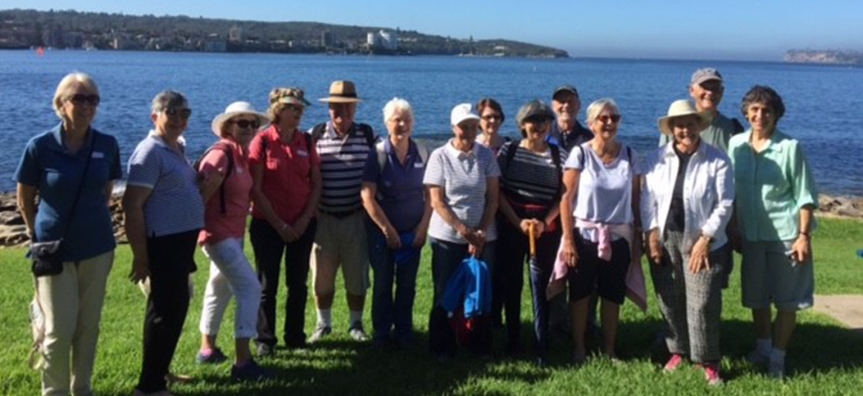
Pittwater-Narrabeen Parkinson’s Support Group
Over 75s Are Being Urged To Get Another Covid Booster Dose
- All adults aged 65 to 74 years, and/or
- Adults aged 18 to 64 years with severe immunocompromise.
- Within the above groups, an additional 2023 COVID-19 vaccine is likely to be of most benefit for people who:
- Have no known history of SARS-CoV-2 infection (and therefore are unlikely to have protection from hybrid immunity),
- Have medical comorbidities that increase their risk of severe COVID-19, or disability with significant or complex health needs, or
- Reside in a residential aged care facility.
Big Tobacco & Social Media Receive Dirty Ashtray & Exploding Vape Awards
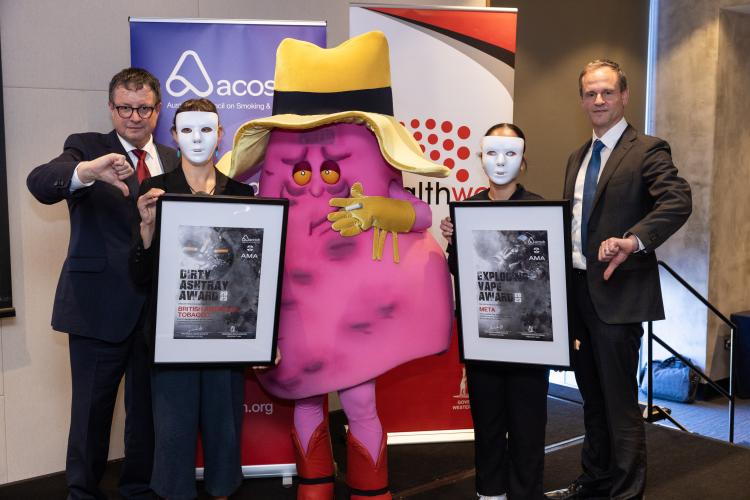
Older People And Work: Stop The Intergenerational Wars And Start Improving Systems For Australians Of All Ages
Act Now For A Dementia-Friendly Future This Dementia Action Week
Here’s what new 60-day prescriptions mean for you and your hip pocket

From today, there are significant changes to how some common medicines are prescribed and dispensed in Australia. This means you could walk away from the pharmacy with 60-days’ worth of your usual medicine from a single prescription.
Until now, most long-term medicines were only available for 30 days at a time. So the price of these medicines for some patients may effectively halve.
You would also need fewer trips to the GP for a prescription and fewer visits to the pharmacy to have your medicine dispensed.
But not all medicines are yet eligible for 60-day scripts and not everyone is prescribed 60-days’ worth of medicine at a time. Here’s what the changes mean for you.
Can I Get A 60-Day Script Today?
If you have a current prescription, you need to use this prescription first before you get a new one. To be eligible for a prescription that provides medicine for 60 days your medication needs to be on the approved list.
Your doctor also needs to assess if you are stable on it. This is to avoid wastage. We know new treatments can result in frequent changes to medication regimens, which would result in wasted medicines if they don’t end up being used.
Your doctor may also give you “repeat” prescriptions for 60-days’ worth of medicines at a time. Under the new rules, this could mean up to 12 months’ supply of medicine (the initial script plus five “repeats”). You would have to pay for each of these repeat scripts when your medicine is dispensed every 60 days.
Is My Medicine On The List?
The roll-out of 60-day scripts will be in three stages. The first stage, which begins today, includes medicines for cardiovascular disease (such as heart disease and stroke), heart failure, high cholesterol, gout, osteoporosis, and the gut conditions Crohn’s disease and ulcerative colitis.
This includes some of the most common medicines prescribed in Australia, such as atorvastatin for lowering cholesterol, and perindopril for lowering blood pressure.

The following stages, set to be rolled out over the coming 12 months, include medicines for diabetes, epilepsy, glaucoma, asthma and Parkinson’s disease.
When fully implemented, these changes will affect more than 300 prescription medicines available on the Pharmaceutical Benefits Scheme (PBS).
These medicines have been chosen because they are appropriate treatments for people living with stable, chronic health conditions, they meet clinical safety criteria, and are considered cost-effective.
Medicines not available for 60-day dispensing are those only for short-term use and medicines known to be at risk of overuse. These include pain medicines and some medicines for mental health conditions.
Will I Save Money?
The government has brought in these changes mainly to try to make medicines more affordable. We know people do not seek medical care or fill prescriptions due to cost.
The maximum price you pay at the pharmacy for a PBS script (known as the co-payment) is not changing. It’s still A$7.30 for concession card holders and $30 for non-concession card holders. But by having 60-day dispensing, you’ll only be charged this every two months instead of every month.
But not everyone will save money from a 60-day prescription because in some cases your pharmacy may already be discounting your medicine. If the price for 60-days’ supply would not take the price over $30, you may not be getting two scripts for the price of one.
For example, a commonly discounted medicine is atorvastatin. In Australia, a non-concession patient generally pays between $8 and $22 for 30-days’ supply. But it’s likely that a 60-day supply would cost between $15 and $30.
The amount you or your family need to pay to reach the PBS safety net is also not changing. This is the threshold you need to reach before medicines become free (for concession card holders) or discounted (non-concession card holders) for the rest of the calendar year. In some instances, 60-day dispensing may result in you or your family reaching the safety net threshold later, or not at all.

How Should I Store My Medicine?
If you don’t store your medicines correctly at home they can become degraded and not work so well. With a 60-day supply, correct storage is even more important.
As a general rule of thumb, never store your medicines in hot rooms or your car (even in winter) and don’t store them in direct sunlight. If your medicine needs to be stored in the fridge, your pharmacist will let you know.
One example is latanoprost, which are drops for the eye condition glaucoma. You can keep the bottle you are using in the cupboard but you need to store the unopened, second bottle in the fridge.
In A Nutshell
Remember, 60-day dispensing is only available for new prescriptions. When you next see your doctor, if your condition is stable and your medicine is suitable, you will be provided a 60-day script. Your pharmacist will then dispense a 60-day supply.
If you have any questions about the new rules, ask your local pharmacist. Information is also available from the Commonwealth health department and the Consumers Health Forum.![]()
Andrew Bartlett, Associate Lecturer Pharmacy Practice, University of Sydney and Nial Wheate, Associate Professor of the Sydney Pharmacy School, University of Sydney
This article is republished from The Conversation under a Creative Commons license. Read the original article.
The Mother and Son reboot has fresh things to say about adult children and their ageing parents

Mother and Son has long been regarded as one of Australia’s greatest sitcoms. First airing in 1984, the tale of the ageing Maggie Beare and her hapless son, Arthur, was not only very funny, but revealed the pain, frustration and love that underpinned their relationship.
For anyone who has cared for an ageing parent – or faced the diminution of their autonomy as they have aged – Mother and Son still strikes a nerve.
As Australia’s population ages, and more of us grapple with the challenges of caring for ageing relatives, it is unsurprising that Mother and Son has been revived by the ABC. As our media and entertainment industries churn out remakes, franchises and revivals, refashioning a beloved program like Mother and Son makes some sense: a large portion of the ABC’s ageing audience will tune in, if only to complain that the remake can’t hold a candle to the original.
However, the revival has some fresh things to say about the fraught but loving bonds between adult children and their ageing parents in the 21st century.
The Original Mother And Son
Mother and Son premiered on the ABC in 1984 and ran for six seasons until 1994. Both critically acclaimed and widely loved by viewers, the series made Ruth Cracknell a beloved national treasure and allowed Garry McDonald, who became famous as Norman Gunston in the 1970s, to show a different set of comic skills.
The show’s premise was simple: 35-year-old journalist Arthur moves in with his mum, Maggie, who is showing signs of cognitive decline – or is she? Maggie’s absent-mindedness frustrates Arthur and generates much of the comedy, but her ability to emotionally blackmail her son and get her own way balances the power in their dynamic.
At the time Mother and Son was first broadcast, Australian sitcoms were thin on the ground. Australian television had long succeeded in the realm of topical, satirical sketch comedy, from The Mavis Bramston Show to The Gillies Report and Fast Forward. Mother and Son represented a significant departure from the sketch comedies, soaps and serial dramas that featured on 1980s television.
In many ways it resembled the British sitcoms that were a staple part of the ABC’s viewing schedule, with live audiences, a single set and multiple cameras.
Ageing Parents And Adult Children
Re-watching Mother and Son, (currently available on iView), I was struck by how well it captures the complex emotions of both ageing parents and their adult children.
The series never shied away from Arthur’s guilt and frustration, or Maggie’s loneliness and feelings of loss. It is a resonant depiction of the often-messy emotions that come with being a carer, while not losing sight of the feelings of the person being cared for.
In spite of everything, Maggie and Arthur still love each other. In an early episode, after a fight, Maggie is caught shoplifting a bottle of oysters – one of Arthur’s favourite foods. She’s arrested and when Arthur arrives at the police station to take her home, he asks her why she stole the oysters. Maggie replies simply: “because I thought it would make you like me again”.
Cracknell’s subtle, dignified performance gave moments like these a genuine pathos. The series showcased both a complex portrayal of an older woman (a rare thing on television) and also a male carer. In a society where care of children and the elderly was (and still is) typically regarded as “women’s work”, this was significant.
A New Mother And Son
Where the original series featured a baby boomer looking after his mother, in the new series, it’s a millennial looking after his boomer mum – a story being played out in homes across the nation.
In the 2023 Mother and Son, Maggie (Denise Scott) is a free-spirited eccentric who almost burned down the family home while cooking dinner for her grandchildren. Childless, unmarried Arthur (Daniel Okine), meanwhile, is attempting to start a web business.
In both series, Arthur’s return to the family home is seen as a product of his failure to establish his own family. In the revival, Arthur wants a wife and family but has neither, and spends much of his day playing computer games. This Arthur is caught in perpetual adolescence, unlike McDonald’s original character. His mercenary sister, Robbie (a gender flip from the original) wants to move their mother into aged care so they can sell her home: a very 2020s tale.
Scott’s Maggie has a more anarchic energy than Cracknell’s character. She is uninhibited (making her first appearance on the show naked) and rebellious: when Arthur takes her on a tour of an assisted living facility, a resident waves at her and she flips the bird in response.
Scott conveys the frustration experienced by older people who can no longer live independently – she is resentful about not seeing her grandchildren and angry about the ways her life is “shrinking”. Her spiky portrayal gives Maggie more agency and a likely point of connection with an older viewing audience.
The new Mother and Son is likeable, gentle comedy. It has a diverse, multicultural cast and the writing is largely well-observed. Yet in remaking a much-loved classic comedy, the creators have set themselves an impossibly high bar: Scott and Okine, while charming, are no match for Cracknell and McDonald.
While it can’t hope to match the brilliance of the original, this reimagined Mother and Son offers an sympathetic, honest portrayal of ageing parents and their harried adult children – something we don’t see enough of on our television screens.![]()
Michelle Arrow, Professor of History, Macquarie University
This article is republished from The Conversation under a Creative Commons license. Read the original article.
A 'Mini-Brain' Traces The Link Between Concussion And Alzheimer's Disease
Drug That Targets Scar-Like Tissue In Tumours Shows Promise For Aggressive Pancreatic Cancer: Garvan Institute
Vaping: The Health Effects And Harms
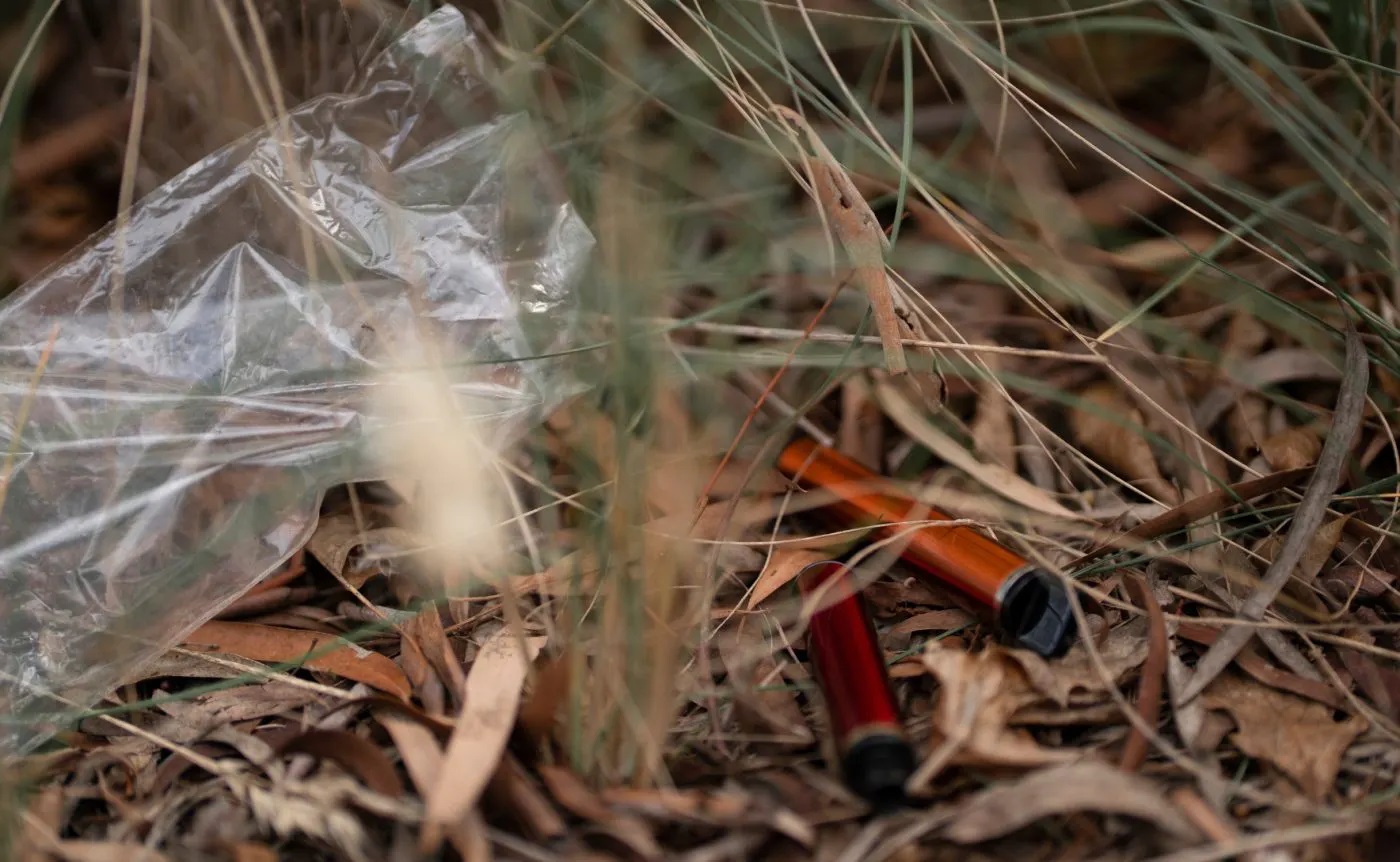
Australian Woman Found With Parasitic Roundworm In Her Brain Caught From Carpet Python
Flying under the radar: Australia’s silent and growing competition crisis

Australia has long had far less competition in consumer markets than the US.
New research from the e61 Institute finds that in all but one of 17 broad industry divisions identified by the Australian Bureau of Statistics, Australian industries are on average more concentrated than their counterparts in the United States.
The measure used is “CR4” – the market share of the top four firms.
In 2017, the most recent year for which we could obtain comparable figures, Australia was far more prone to high levels of market concentration, with the top four firms accounting for 80% of some markets and averaging more than 60% across some industry categories.
Average concentration across industry groups, Australia versus United States
Market share of the top four firms, per cent
Importantly, we find market concentration in Australia increasing over time.
Between 2006 and 2020 Australia’s average CR4 measure of concentration increased 3 percentage points, with notable increases in industries that initially had a moderate level of concentration, such as retail and transport.
Concentrated Industries Don’t Welcome New Entrants
To be sure, concentrated does not always mean that competition is lacking, especially if there is credible threat of being displaced by dynamic upstarts.
But we found that in highly concentrated industries the four largest firms rarely got dislodged from their top positions over the 14 years between 2007 and 2021.
And those industries that experienced a rise in concentration over the seven years to 2014 recorded a decline in new firm entry over the following seven years.
This might mean we have as many as 6,300 fewer employing firms than we would have, giving Australian workers fewer employment options and suppressing real wage growth. And given that young firms are more innovative, it might mean lower productivity growth.
Concentrated Industries Break Rules More Often
Ranking Australian industries by their average concentration, we found the most concentrated had the most infringement notices and enforceable undertakings issued by the Australian Competition and Consumer Commission.
The airline industry, which is famously concentrated, has been hit with 12 such notices and enforceable undertakings over the past 30 years compared to only four for the accommodation industry.
ACCC infringement notices and undertakings versus industry concentration
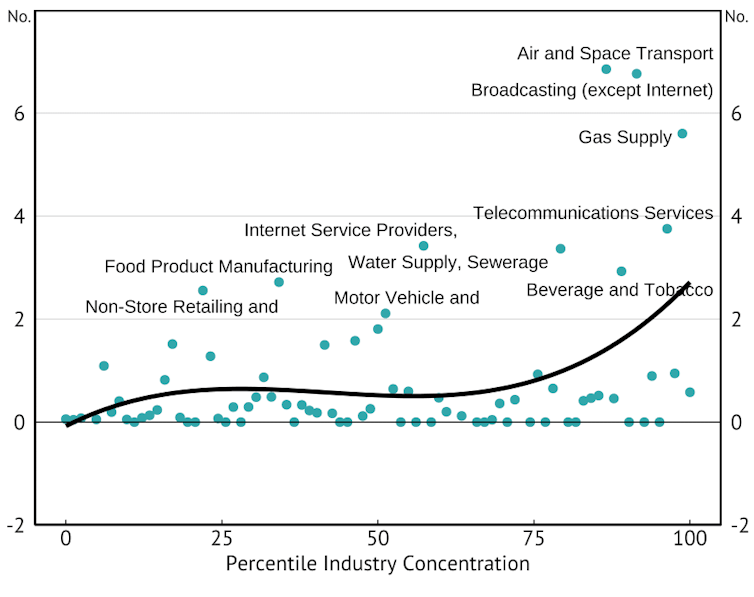
Concentration Means Higher Prices
To explore the impact of market concentration on prices, we examined margins between retail and wholesale petrol prices in Brisbane and the Gold Coast and their relationship to the number of competing petrol stations within three kilometres.
We found that where petrol stations faced less competition they tended to charge higher margins, and that when wholesale prices rose, they appeared to be quicker in passing on this cost to consumers to maintain margins.
Competitors within 3 kilometres versus average petrol margins
Concentration Is Happening More Quietly
Whereas in the US large mergers have to be reported to regulators, in Australia mergers are more like marriages.
Just as you don’t have to tell your family you are getting married, you don’t have to notify the Australian Competition and Consumer Commission you are about to merge with a competitor.
Companies are encouraged to notify the ACCC if the merged parties make either substitutes or complements and the merged firm will have a market share of more than 20%, but that is a guideline rather than a requirement, and the guidance was relaxed in 2008.
If you are high-profile enough to be listed on the Australian Securities Exchange, the ACCC is going to find out anyway through the media (ASX companies have to disclose significant acquisitions), so in practice most companies planning large mergers ask for the ACCC’s blessing ahead of time to avoid embarrassment.
That means while voluntary notification works well enough for bringing royal-wedding-style mergers to the ACCC’s attention, Vegas-style elopements can go undetected.
Although these small transactions can seem innocuous, their collective impact can be significant. In the US, it is estimated transactions too small to be reported account for 28–47% of the increase in concentration between 2022 and 2016.
In Australia, there is a risk that many of these transactions are going undetected.
e61 has found the number of private mergers (not reported to public financial markets) reviewed by the ACCC has plummeted since the ACCC relaxed the reporting guidelines, from 55 in 2006 to just 12 in 2022
Number of private mergers reviewed by the ACCC per year
The head of the Competition and Consumer Commission Gina Cass-Gottlieb told the National Press Club this year she wanted Australia to move away from voluntary notifications to formal clearances of the kind required overseas where there was
a mandatory requirement to notify the ACCC of mergers above specified thresholds
a requirement for transactions to be suspended from completion prior to ACCC clearance
Parties proposing a non-contentious merger could apply for a notification waiver that, if granted, would mean they wouldn’t need to make a full formal application and the proposal could be dealt with quickly.
Cass-Gottlieb said businesses were increasingly pushing the boundaries of the informal system, giving the ACCC late, incomplete, or incorrect information, and threatening to complete their transactions before it completed its reviews.
At times overseas authorities knew about proposed transactions involving Australian companies before the Australian authorities.
Our research finds that not only are Australian industries concentrated and becoming more so, but mergers might be increasingly flying under the radar.
The government has announced a review of competition policy that will include a review of merger laws as well as non-compete clauses. Our research suggests there’s a strong economic case for taking action on both fronts.![]()
Dan Andrews, Visiting Fellow and Director – Micro heterogeneity and Macroeconomic Performance program, Crawford School of Public Policy, Australian National University and Elyse Dwyer, Researcher, Department of Economics, Macquarie University
This article is republished from The Conversation under a Creative Commons license. Read the original article.
With one exception, the Intergenerational Report is far less scary than you’ve heard
Peter Martin, Crawford School of Public Policy, Australian National UniversityWhat if nearly everything that’s been written about this month’s Intergenerational Report is wrong?
I’ll explain. But first, here’s a sample of the headlines: “Young Australians at risk of a poorer future”, “Fewer workers to shoulder soaring income tax”, “Ageing population driving $140 billion blowout in spending”, and so on.
On radio it was worse. One ABC presenter referred to a “ticking tax bomb”.
The picture painted is one of a future in which (old) dependants have far fewer people of working age to care for them, in which tax climbs dramatically to pay for the care of the elderly, and in which the next generation is poorer than this one is.
And to be fair to the people who’ve said these things, some of the language in the Intergenerational Report is like that, but not the numbers.
Each Report Less Scary Than The One Before
Let’s start with the most fundamental problem identified in the report: that in 40 years’ time (each Intergenerational Report looks forward 40 years) there will be many fewer Australians of traditional working age for each Australian aged 65 and over – what the report calls the “old-age dependency ratio”.
Back in 2002 the government’s first intergenerational report found that whereas there were 5.3 Australians of working age for each Australian aged 65 and over at the time, by 2042 there would be only half as many – just 2.5.
This latest report finds that whereas there are now 3.7 Australians of such age for each of us aged 65 and over, by 2063 there will be 2.6. While not quite as dramatic as the fall projected in first report, and happening two decades later, this is still a big stepdown.
Except that ratio is not a useful guide to the ratio of people of working age to the people they’ll need to support. That’s because young people need support too.
Australia Will Be Older, But Also Less Young
Whereas old people need aged care workers, young people need child care workers; and they both need workers to make the goods and services they use. What matters is the total dependency ratio: old and young combined.
Examining only half the ratio (the half that look worse as the population ages) without also examining the other half (the half that looks better as the population ages) is hard to justify – unless the argument is that the Commonwealth is responsible for aged care and the states for schools.
But that ought not be relevant when talking about the supply of workers.

Australia will need more aged care workers as a proportion of the population in 40 years’ time, but it is also going to need fewer teachers.
What will matter is the ratio of potential workers to all people aged (say) under 15 as well as aged 65 and older, both old and young.
That total dependency ratio also told a dramatic story in the first report. The number of Australians of traditional working age to those aged either under 15 or 65 and older was set to slide from 2 to 1.55.
But the slide isn’t big as this time. The ratio is set to slip from 1.82 (which we are finding manageable) to 1.57, but over 40 years.
Old People Will Find It Easier To Find Jobs
One of the reasons why the “fewer workers to dependents” story has much less sting than it was going to is we have had many more migrants than we were going to, and the migrants and students we have let in are nearly all aged 15 to 64.
Another, and this would have happened regardless of migration, is that as people of traditional working age become more scarce, people of non-traditional age (65 and over) are taking up and staying in paid work. Back at the time of the first report, only 5% of Australians aged 65 and older were employed. Now it’s 11.5%.
Partly this is because of a rule change (the pension age is now 67), partly it is because work is less physically demanding (an awful lot of us have office jobs) and partly it is because employers are no longer as prejudiced – they’ve had to accept applications from older workers and have discovered they are not too bad.
On Present Projections We Will Be Much, Much Richer
As for the idea that young Australians face a poorer future, that’s unlikely to be the case if we do indeed run short of workers (and have to pay them more) and it certainly isn’t what’s projected in the Intergenerational Report.
The report has living standards, as measured by real GDP per person, an extraordinary 57% higher in 2042, even with lower-than-previously-assumed productivity growth.
That’s right, although things won’t be the same for everyone, on average the report has future generations better off materially than present generations, just as they are better off materially than generations 40 years earlier.
It ought to be noted that the first intergenerational report in 2002 predicted an even bigger growth in living standards, and this one says climate change could trim its projections, although the numbers in the report are woolly and the Treasury is still building up the capacity to properly model climate change.
But 57% – or even 50% or 40% – is still an enormous increase in living standards.
On the numbers in the report, intergenerational inequity will be the opposite of what’s usually claimed: the next generation will be so much better off financially it will be easily able to stump up a few more dollars in tax.
We Will Easily Be Able To Stump Up Extra Tax
And the extra tax the next generation is asked to stump up won’t be “soaring”, despite what the headlines say.
The projections in the report suggest we might have to pay an extra 3.9% of GDP in tax to fund the things we will need, but not all at once, and not the full amount until 2063. By that time (as mentioned) GDP per person will be much higher.
Most of the extra projected government spending (60%) is unrelated to ageing. A lot of it is to fund the cost of new and better health treatments, of the kind we’re pretty certain to want given our higher living standards.
I’ve read the 300-odd pages of the report pretty carefully, and (with the exception of the section on climate change) I’m yet to find anything particularly alarming.![]()
Peter Martin, Visiting Fellow, Crawford School of Public Policy, Australian National University
This article is republished from The Conversation under a Creative Commons license. Read the original article.
New study highlights the brain trauma risks for young athletes

The Boston University CTE Center today reported the results of the largest-ever study of chronic traumatic encephalopathy (CTE) in young athletes.
The study, examining autopsied tissue, found signs of CTE in 63 out of 152 young athlete brains. The subjects of the study competed in youth, high school and college competitions, and all died before the age of 30.
This case series includes the first American woman athlete diagnosed with the disease, just months after the Australian Sports Brain Bank reported the world’s first case of CTE in a female athlete.
The results of this study have major implications for sporting leagues around the globe. Like other dementias, CTE is often assumed to be a disease that develops later in life, but as neuropathologist and Boston University CTE Centre Professor Ann McKee says, “this study clearly shows that the pathology of CTE starts early”.
These latest findings come as Australia’s Senate is due to report the findings of its inquiry into concussions and repeated head trauma in contact sport.
This should push sporting organisations to do more to protect the brains of all athletes, especially in junior and recreational competitions.
CTE And Young Athletes
CTE is a devastating and currently incurable form of dementia which causes neurodegeneration of the brain. The disease has long been associated with contact sport participation.
Dementias like CTE are often thought of as diseases of the elderly. However, some high-profile cases of CTE have been identified among younger athletes.
In Australia, much-loved NRL player and coach Paul Green was 49 when he died and was later found to have CTE. Former AFL star Shane Tuck was 38 when he died with the disease. Former AFLW player Heather Anderson was only 28. A recent study in the United States also found CTE in the brain of an 18-year-old athlete.
The disease is known to cause mood disorders and behaviour changes. People with CTE may be at higher risk of suicide.
These cases and the latest Boston University study indicate the risk of developing CTE is not restricted to those in their middle or older years. Although there is some evidence developing brains are more vulnerable to trauma – it creates a chronic inflammatory response affecting brain development – the pathology of CTE is still being studied.
The risk factors for young athletes are complex and multifaceted but it is likely that playing junior contact sport heightens an athlete’s risk of developing neurodegenerative diseases as an adult.
The strongest predictor for developing CTE is cumulative exposure to repeated brain trauma, rather than the number of diagnosable concussions. Prolonged exposure to repeated low-level impacts appears to produce a greater lifetime volume of brain trauma when compared with athletes who sustain a small number of more forceful injuries.
Again, the reasons for this dynamic require further study. One potential explanation is that low-level impacts, which often do not reach the clinical threshold for a concussion diagnosis, are easier to ignore and play through.
For the athletes in the Boston University study to develop CTE before the age of 30, it is likely they were exposed to repeated brain trauma from an early age through youth sport.
Are Contact Sports Safe For Kids?
Public health advocates in North America, Australia, New Zealand Aotearoa and the United Kingdom have long expressed concerns about the risks of contact sport for children.
Improved oversight would go some way toward reducing the serious health risks of mild traumatic brain injury (concussion). These include post-concussion syndrome (where symptoms do not resolve within the expected time period of about one month) and second impact syndrome (where a young athlete who has previously been concussed receives a second impact either on the same day or up to a week later, resulting in catastrophic outcomes).
Although professional athletes are increasingly subject to monitoring for brain injuries, these practices are not consistently in place for participants in semi-professional, club or junior competitions. It is essential that sports bodies implement the same reporting, monitoring and exclusion protocols all the way through their competitions, especially in junior sport.

First Steps
Existing concussion guidelines are not designed to account for the types of sub-concussive injuries (where an impact does not result in observable symptoms) most strongly associated with CTE. To protect them from the disease, contact sporting bodies must reduce young athletes’ lifetime exposure to brain trauma. One way to do this would be to restrict contact in training and games for juniors.
Some sporting bodies have already taken the initial steps. Australian Rules football players are restricted to modified tackling until the age of 12. The National Rugby League will soon implement a ban on tackling until midway through under-7s competitions.
The US Soccer Federation prohibits children under 11 from heading the ball. The UK Football Association will trial a ban on deliberate heading before age 12 – a clear acknowledgement of the dangers of repetitive low-grade brain trauma.
The prevalence of CTE in this study from the US, where athletes routinely wear helmets to play football and ice hockey, is further evidence helmets do not protect young players from concussions or the risk of CTE.
Changes to tackling rules were met with resistance by those who fear they would “soften” the games. Further measures to protect athletes will require courage from contact sports administrators.
This new study shows CTE can develop in young brains and builds off previous research suggesting the origins of this pathology may lie in junior contact sport. To protect players from neurodegenerative diseases like CTE, sports must reduce cumulative exposure to brain trauma for all athletes, beginning with the junior leagues. In Australia, where children have at least four football codes to choose from, this message must be received with particular urgency.
If this article has raised issues for you, or if you’re concerned about someone you know, call Lifeline on 13 11 14. The National Dementia Helpline number is 1800 100 500.![]()
Stephen Townsend, Lecturer, School of Human Movement and Nutrition Sciences, The University of Queensland; Alan Pearce, Professor, College of Science, Health, Engineering, La Trobe University, and Kathleen Bachynski, Assistant Professor, Public Health, Muhlenberg College
This article is republished from The Conversation under a Creative Commons license. Read the original article.
Sahara space rock 4.5 billion years old upends assumptions about the early Solar System
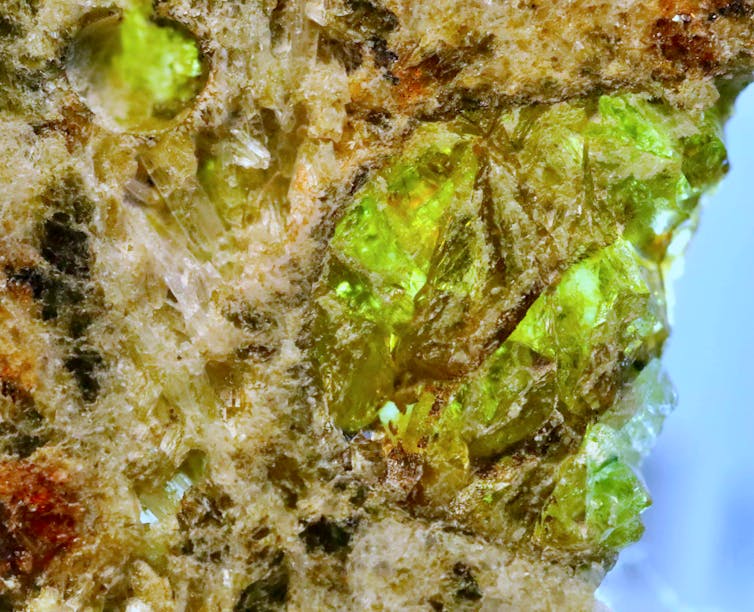
In May 2020, some unusual rocks containing distinctive greenish crystals were found in the Erg Chech sand sea, a dune-filled region of the Sahara Desert in southern Algeria.
On close inspection, the rocks turned out to be from outer space: lumps of rubble billions of years old, left over from the dawn of the Solar System.
They were all pieces of a meteorite known as Erg Chech 002, which is the oldest volcanic rock ever found, having melted long ago in the fires of some now-vanished ancient protoplanet.
In new research published in Nature Communications, we analysed lead and uranium isotopes in Erg Chech 002 and calculated it is some 4.56556 billion years old, give or take 120,000 years. This is one of the most precise ages ever calculated for an object from space – and our results also cast doubt on some common assumptions about the early Solar System.
The Secret Life Of Aluminium
Around 4.567 billion years ago, our Solar System formed from a vast cloud of gas and dust. Among the many elements in this cloud was aluminium, which came in two forms.
First is the stable form, aluminium-27. Second is aluminium-26, a radioactive isotope mainly produced by exploding stars, which decays over time into magnesium-26.
Aluminium-26 is very useful stuff for scientists who want to understand how the Solar System formed and developed. Because it decays over time, we can use it to date events – particularly within the first four or five million years of the Solar System’s life.
The decay of aluminium-26 is also important for another reason: we think it was the main source of heat in the early Solar System. This decay influenced the melting of the small, primitive rocks that later clumped together to form the planets.
Uranium, Lead And Age
However, to use aluminium-26 to understand the past, we need to know whether it was spread around evenly or clumped together more densely in some places than in others.
To figure that out, we will need to calculate the absolute ages of some ancient space rocks more precisely.
Looking at aluminium-26 alone won’t let us do that, because it decays relatively quickly (after around 705,000 years, half of a sample of aluminium-26 will have decayed into magnesium-26). It’s useful for determining the relative ages of different objects, but not their absolute age in years.
But if we combine aluminium-26 data with data about uranium and lead, we can make some headway.
There are two important isotopes of uranium (uranium-235 and uranium-238), which decay into different isotopes of lead (lead-207 and lead-206, respectively).
The uranium isotopes have much longer half-lives (710 million years and 4.47 billion years, respectively), which means we can use them to directly figure out how long ago an event happened.
Meteorite Groups
Erg Chech 002 is what is known as an “ungrouped achondrite”.
Achondrites are rocks formed from melted planetesimals, which is what we call solid lumps in the cloud of gas and debris that formed the Solar System. The sources of many achondrites found on Earth have been identified.
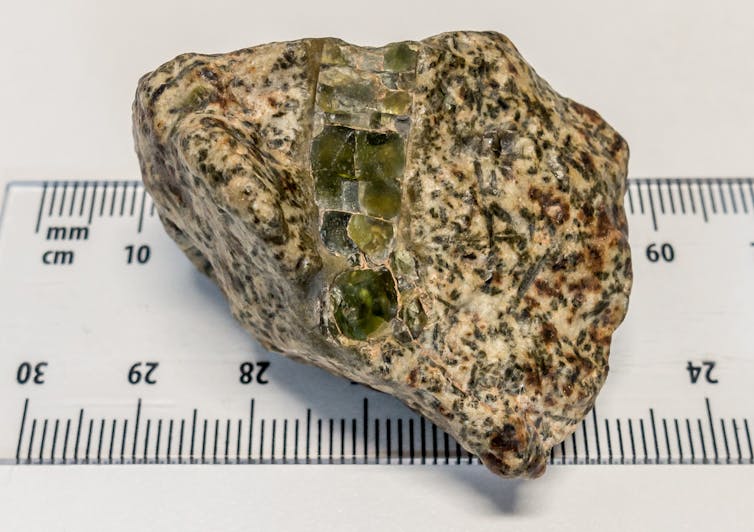
Most belong to the so-called Howardite-Eucrite-Diogenite clan, which are believed to have originated from Vesta 4, one of the largest asteroids in the Solar System. Another group of achondrites is called angrites, which all share an unidentified parent body.
Still other achondrites, including Erg Chech 002, are “ungrouped”: their parent bodies and family relationships are unknown.
A Clumpy Spread Of Aluminium
In our study of Erg Chech 002, we found it contains a high abundance of lead-206 and lead-207, as well as relatively large amounts of undecayed uranium-238 and uranium-235.
Measuring the ratios of all the lead and uranium isotopes was what helped us to estimate the age of the rock with such unprecedented accuracy.
We also compared our calculated age with previously published aluminium-26 data for Erg Chech 002, as well as data for various other achondrites.
The comparison with a group of achondrites called volcanic angrites was particularly interesting. We found that the parent body of Erg Chech 002 must have formed from material containing three or four times as much aluminium-26 as the source of the angrites’ parent body.
This shows aluminium-26 was indeed distributed quite unevenly throughout the cloud of dust and gas which formed the solar system.
Our results contribute to a better understanding of the Solar System’s earliest developmental stages, and the geological history of burgeoning planets. Further studies of diverse achondrite groups will undoubtedly continue to refine our understanding and enhance our ability to reconstruct the early history of our Solar System.![]()
Evgenii Krestianinov, PhD candidate, Research School of Earth Sciences, Australian National University
This article is republished from The Conversation under a Creative Commons license. Read the original article.
Does private health insurance cut public hospital waiting lists? We found it barely makes a dent

The more people take up private health insurance, the less pressure on the public hospital system, including shorter waiting lists for surgery. That’s one of the key messages we’ve been hearing from government and the private health insurance industry in recent years.
Governments encourage us to buy private hospital cover. They tempt us with carrots – for instance, with subsidised premiums. With higher-income earners, the government uses sticks – buy private cover or pay the Medicare Levy Surcharge. These are just some of the billion-dollar strategies aimed to shift more of us who can afford it into the private system.
But what if private health insurance doesn’t have any meaningful impact on public hospital waiting lists after all?
That’s what we found in our recent research. Our analysis suggests if an extra 65,000 people buy private health insurance, public hospital waiting lists barely shift from the average 69 days. Waiting lists are an average just eight hours shorter.
In other words, we’ve used hospital admission and waiting-list data to show private health insurance doesn’t make much difference.
What We Did
Our work looked at data from 2014-2018 on hospital admissions and waiting lists for elective surgery in Victoria.
The data covered all Victorians who were admitted as an inpatient in all hospitals in the state (both public and private) and those registered on the waiting list for elective surgeries in the state’s public hospitals.
That included waiting times for surgeries where people are admitted to public hospitals (as an inpatient). We didn’t include people waiting to see specialist doctors as an outpatient.
The data was linked at the patient level, meaning we could track what happened to individuals on the waiting list.
We then examined the impact of more people buying private health insurance on waiting times for surgeries in the state’s public hospitals.
We did this by looking at the uptake of private health insurance in different areas of Victoria, according to socioeconomic status. After adjusting for patient characteristics that may affect waiting times, these differences in insurance uptake allowed us to identify how this changed waiting times.

What We Found
In our sample, on average 44% of people in Victoria had private health insurance. This is close to the national average of 45%.
We found that increasing the average private health insurance take-up from 44% to 45% in Victoria would reduce waiting times in public hospitals by an average 0.34 days (or about eight hours).
This increase of one percentage point is equivalent to 65,000 more people in Victoria (based on 2018 population data) taking up (and using) private health insurance.
The effects vary slightly by surgical specialty. For instance, private health insurance made a bigger reduction to waiting times for knee replacements, than for cancer surgery, compared to the average. But again, the difference only came down to a few hours.
Someone’s age also made a slight difference, but again by only a few hours compared to the average wait.
Given the common situation facing public and private hospitals across all states and territories, and similar private health insurance take-up in many states, our findings are likely to apply outside Victoria.
Why Doesn’t It Reduce Waiting Lists?
While our research did not address this directly, there may be several reasons why private health insurance does not free up resources in the public system to reduce waiting lists:
people might buy health insurance and not use it, preferring to have free treatment in the public system rather than risk out-of-pocket costs in the private system
specialists may not be willing to spend more time in the public system, instead favouring working in private hospitals
there’s a growing need for public hospital services that may not be available in the private system, such as complex neurosurgery and some forms of cancer treatment.
Why Is This Important?
Government policies designed to get more of us to buy private health insurance involve a significant sum of public spending.
Each year, the Australian government spends about $A6.7 billion in private health insurance rebates to reduce premiums.
In the 2020-21 financial year, Medicare combined with state and territory government expenditure provided almost $6.1 billion to fund services provided in private hospitals.
There might be an argument for this public spending if the end result was to substantially take pressure off public hospitals and thereby reduce waiting times for treatment in public hospitals.
But the considerable effort it takes to encourage more people to sign up for private health insurance, coupled with the small effect on waiting lists we’ve shown, means this strategy is neither practical nor effective.
Given the substantial costs of subsidising private health insurance and private hospitals, public money might be better directed to public hospitals and primary care.
In addition, people buying private health insurance can skip the waiting times for elective surgery to receive speedier care. These people are often financially well off, implying unequal access to health care.
What’s Next?
The Australian government is currently reviewing private health insurance.
So now is a good time for reforms to optimise the overall efficiency of the health-care system (both public and private) and improve population health while saving taxpayer money. We also need policies to ensure equitable access to care as a priority.
When it comes to reducing hospital waiting lists, we’ve shown we cannot rely on increased rates of private health insurance coverage to do the heavy lifting.![]()
Yuting Zhang, Professor of Health Economics, The University of Melbourne; Jongsay Yong, Associate Professor of Economics, The University of Melbourne, and Ou Yang, Senior Research Fellow, The University of Melbourne
This article is republished from The Conversation under a Creative Commons license. Read the original article.
More than a ‘disability person’. What finishing school is like for youth with intellectual disability

Leaving school and figuring out what’s next is challenging for young people. For those with disability, it is even harder. It is often a time when supports are withdrawn as they leave the heavily structured school environment.
We asked young people with intellectual disability about their experiences of transitioning from school and starting adult life. Our newly published research suggests pre-transition planning for school leavers with disability is inconsistent or lacking. Most participants felt excluded from making decisions for life after school and needed support to access and navigate the National Disability Insurance Scheme (NDIS).
After school, most participants longed to find a paid job, friends, and a life partner but felt they were missing out on these typical adult milestones. They told us it was difficult to find service providers to help them reach their goals. Many felt isolated and in a perpetual state of transition.
The Promise Of ‘Choice And Control’
Transition-from-school policies and guidelines exist in all states of Australia.
Shared characteristics between these guidelines include early planning, being person-centred, and ensuring collaboration between the family, school and services.
A decade ago, Australia changed from a social welfare model of disability support to a consumer-focused, market-based system. The NDIS promised to be the cornerstone of this, offering participants increased “choice and control” over new skills, jobs, greater independence, quality of life and improved social participation.
We wanted to understand the lived experiences of today’s young Australians with intellectual disability in planning to leave school and transition into adult life.
Through individual and group interviews, 27 young people with intellectual disability (15 female and 12 male participants, aged 19 to 33) told us their views and experiences of leaving school in New South Wales, Queensland and Victoria.
Their stories highlight how much more work should be done to empower young people with intellectual disability.
What They Told Us
Firstly, many young people told us they felt left out of transition planning at school, with most decisions being made for them. There were limited, if any, opportunities for them to explore post-school options. As one participant said,
I don’t want people that are, like, like, you know, just making choices for me.
Secondly, all participants found accessing NDIS funding complicated. They relied on parents or other advocates to navigate the process, to ask the right questions, and help with difficult jargon – or, as stated by one young person, knowing how to “bark the right way”.
After leaving school, many felt lonely, lost and uncertain about their adult role and identity. Some felt “left behind” by friends and siblings without disability who had jobs and life partners, intimate relationships and were raising families of their own.
It’s hard to find a partner […] or to know someone and be with someone.
There was a shared sense among participants that most disability services did not prioritise activities to support reaching their goals. A young woman explained how finding a service with a good fit had been very difficult. She talked about how her first service provider had “tried to like take us for money” without providing a service.
Other participants felt “stuck” with a life in disability services locked into the role of “disability person”, while wanting to do and be more.
you know […] I want to do some more in life and […] I want to be out there. Know what I mean?
Participants felt they needed better support with finding and keeping employment, even from agencies that had been contracted to do so. Getting help with finding a paid job seemed especially frustrating and out of reach. One young man called it a “total nightmare” explaining,
So they’re basically, you know, not very well, um, structured […] you’re just waiting here for that lottery ticket to draw your name out.
The Same Goals As Young People Without Disability
This study shows transition planning processes remain inconsistent and there is insufficient collaboration between school systems, adult disability services and the workforce.
Participants in our study had the same goals as young people without disability for meaningful work, independence and social connection – but need better support to contributing meaningfully to their communities.
The sense of “feeling stuck” with life in disability services or in “perpetual transition” may be caused by conflicting beliefs and values between service providers and consumers.
Young people expect to take on adult roles after leaving school. But disability service providers often see these young people merely as service receivers. Standardised processes and procedures may create “institutionalised identities”.
The highly standardised nature of the NDIS leaves it inaccessible for people with intellectual disability, so the promise of choice and control in adult life is far from reality.

How It Should Be
Australia needs nationally consistent policies backed by systematic actions and oversight that truly supports the transition from school into meaningful adult lives for young people with intellectual disability.
People with disability must be actively involved in developing transition and service plans, with goals for growth and for moving between or beyond disability services once milestones are met.
Strategies must include steps for fostering social identities through friendships, casual to ongoing employment, intimate relationships, parenting or caring for others.
Further shifts in the NDIS model are also needed to foster individualised and supported planning for people with intellectual disability.![]()
Lise Ludwig Mogensen, Associate professor, Medical Education, Research and Evaluation, School of Medicine, Western Sydney University
This article is republished from The Conversation under a Creative Commons license. Read the original article.
A battlefield for ants? New study on ant warfare shows we could manipulate their fights
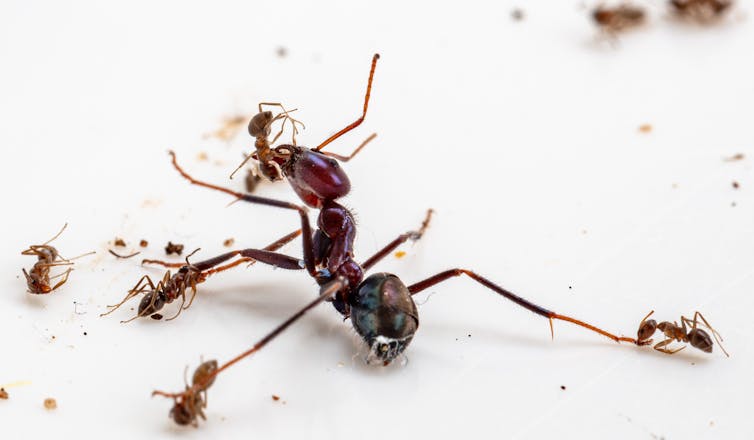
Humans are not the only animals that go to war. Ants do so too, and on a similarly catastrophic scale.
Battles play out daily – in human conflicts, among animals in nature, and across the virtual worlds of video games. How these battles progress depends on the combatants involved and what their battlefields are like.
In a new study published in PNAS today, we used mathematical models on video game simulations to test how battlefield dynamics change warfare outcomes. We then confirmed these concepts in the real world – using ant battles.
The Mathematics Of A Battle
Despite the horror of war, it occupies a prominent place in public imagination. In the early 1900s, English engineer Frederick William Lanchester developed a mathematical model that described the outcome of battles as dependent on the individual strength of each soldier in opposing armies, and on the size of each army.
To this day, Lanchester’s laws remain valuable tools for evaluating battles. Investing in a few strong soldiers should be more effective when battles resemble a series of one-on-one duels. On the other hand, investing in large armies should be more effective when they can surround their enemies and concentrate their attacks.
Later research by evolutionary biologists Nigel Franks and Lucas Partridge revealed it’s not just the soldiers. The complexity of the battlefield itself can also tip the balance in favour of one strategy over another.
When fighting in tunnels, alleyways, or difficult terrain, it’s harder for large armies to surround their opponents, so small forces of strong or savvy soldiers can succeed. Such tactics are the basis for the story of Spartans holding off hundreds of thousands of Persian soldiers at the Battle of Thermopylae in 480 BCE.
Age Of Empires II Versus Ants
In our study, we first used the video game Age of Empires II to assess the importance of battlefield complexity.
This game allows players to arrange different soldier types, build maps and fight against computer-driven enemies. In featureless battlefields, small armies of strong infantry units (Teutonic Knights) could defeat up to 50 weaker units (Two-Handed Swordsmen), but no more.

However, in complex battlefields, nine Knights could slay up to 70 Swordsmen. We found that video game wars, even though not explicitly programmed to do so, clearly followed Lanchester’s laws. But how relevant are these laws to real-world battles?

Most animals do not engage in warfare on the same scale as humans. This is because there’s no evolutionary incentive in risking their lives for a cause in which they don’t necessarily have a direct stake.
Social insects such as ants are an exception, because through warfare, the evolutionary future of the sterile worker ants who do the fighting is invested in the greater good of the colony.
Testing Lanchester’s laws required two ant species that clearly differed in their fighting prowess. Our first combatant was the Australian meat ant, Iridomyrmex purpureus. These large and beautiful ants, with their conspicuous gravelly nests, are familiar to many people in regional Australia as they are dominant in undisturbed or remnant bushland habitats.
As their enemies, we selected the notorious Argentine ant, Linepithema humile. These aggressive invasive ants are comparatively tiny but live in extremely large, hyper-cooperative colonies.
Because of the size difference, meat ants always defeat Argentine ants in one-on-one duels. We formed small armies of 20 meat ants, and opposed them in the lab to increasingly large armies of up to 200 Argentine ants.
These battles took place either in simple arenas (featureless plastic containers) or complex arenas (the same containers with narrow wooden strips glued to the floor).
As predicted by Lanchester’s laws and by our video gaming, fewer large meat ants died in battle in complex arenas compared to simple ones.
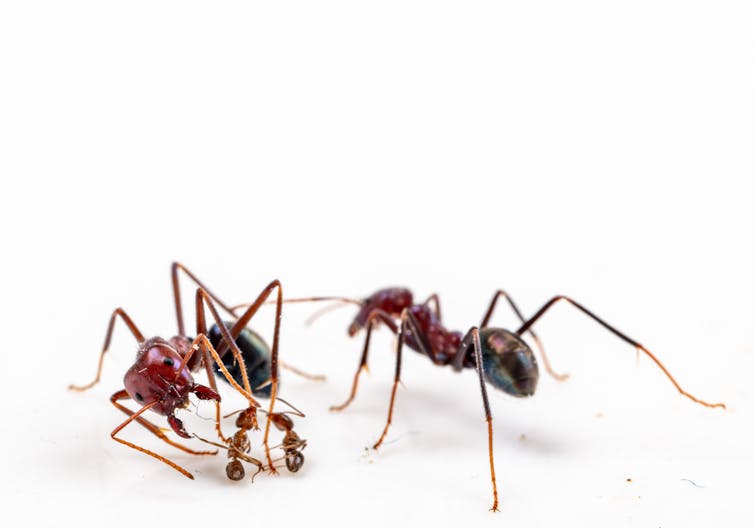
Understanding Ant Invasions
Experiments like this can inform us about the dynamics between native and non-native invasive ants. Non-native invasive ants are some of the worst pests on the planet, costing the global economy tens of billions of dollars per year. Ecosystem managers are keenly interested in new ways to manipulate the competitive success of these invaders.
One of the unifying features of non-native invasive ants is that, like our Argentine ants, they are generally individually smaller than non-invasive species in the areas they invade, while living in extremely large colonies. It has also been observed that non-native invasives are particularly dominant in disturbed environments.
While there are many possible reasons for this, disturbed environments are often simplified at ground level, with the removal of undergrowth and natural debris creating open battlefields.
The fact that small but numerous non-native invasive ants are more successful against their large native competitors in simplified environments makes sense, in light of our experimental study of ant warfare.
It also suggests that adding ground-level complexity, such as natural debris, may tip the balance in favour of larger native species. Just like for humans (and in computer games), the outcome of ant wars depends on the nature of the battlefield.![]()
Samuel Lymbery, Postdoctoral Fellow in Biosecurity, Murdoch University; Bruce Webber, Principal Research Scientist, CSIRO, and Raphael Didham, Professor of Ecology, The University of Western Australia
This article is republished from The Conversation under a Creative Commons license. Read the original article.
Disclaimer: These articles are not intended to provide medical advice, diagnosis or treatment. Views expressed here do not necessarily reflect those of Pittwater Online News or its staff.